Travels with Erica
A Solo Traveller's Guide to the World

What I Wish I Knew Before Taking a Solo Trip to Japan
This post may contain affiliate links. If you click on my affiliate link and purchase something (at no additional cost to you!), I may earn a small commission that helps me keep the blog running. Thank you so much for your support!
Japan is one of the most popular tourist destinations in the world. Most people dream of going to Japan, but there are a few important things you need to know before planning a solo trip to Japan.
Compared to lots of other Asian countries, Japan is super easy to travel in and great for people who are new to travelling alone .
Don’t get too confident yet though because there are tons and tons and tons of mistakes I made when I was in Japan solo, and I’ve been travelling alone since 2015.
Japan is unique. Things that typically hold true for travel in other parts of the world don’t always hold true in Japan. Even things that work in Japan’s neighbour South Korea don’t necessarily work in Japan.
So, I’m going to share everything I learned on my solo trip to Japan with you to hopefully save you some mistakes.
Actually, at this point, I’ve been to Japan three times and feel like I definitely know what mistakes not to make. I’ve made nearly every mistake you can.
Let’s get into the nitty gritty of solo travel in Japan! Hopefully by the end of this article you’ll feel confident and prepared and be able to travel in Japan solo like a pro.
Table of Contents
Stay Near the Main Train Station
The biggest mistake I made on my first solo trip to Japan was not staying near a major train station.
I know when you travel to most countries around the world, you don’t really have to stay near a major train station. As long as you’re near some sort of public transportation, you’re good to go.
That isn’t the case in Japan.
If there is only one thing you take away from this post, it is that you need to stay near a major train station. Ideally, about a ten minute walk away. That way you’ll be super close to the train station but far enough away that it’s quiet.
Most Japanese cities have one major train station. It’ll typically be the name of the city followed by the word station. Like Osaka Station or Kyoto Station of Fukushima Station. You get the point.
Tokyo is a huge city. Huge doesn’t even describe it. Since it’s so large, there are many major train stations.
The two I recommend staying near are either Tokyo Station or Shinjuku Station . They’re pretty central and have access to lots of different metro and JR lines.

Why is it Important to Stay Near a Major Train Station?
There are two main reasons it’s important to stay near a major train station:
- Access to lots of different metro and JR lines so getting around is quick and easy
- Lugging luggage around on Japanese metros is a hassle. Even if you only have a carryon bag, the trains are often crowded and have lots of stairs. Staying near a major train station means you can just leave the train station and easily walk to your hotel or Aibnb and avoid having to transfer to the metro, JR, or bus to get to your hotel.
Trust me. It’s 100% worth it to stay near a major train station even if it means you have to pay a little bit more for your accommodation.
It is the one tip I give everybody when they’re planning a trip to Japan. Whether it’s a solo trip to Japan or a group trip to Japan.
My Favourite Hotels Near Train Stations
- Tokyo Station: Via Inn Prime Nihonbashi Ningyocho
- Shinjuku Station : Hotel Sunroute Plaza Shinjuku
- Kyoto Station : Hotel Kanra Kyoto (definitely a splurge but worth it!)
- Osaka Station : Hotel Monterey Le Frere Osaka
- Kanazawa Station : Hotel Resol Trinity Kanazawa
Get Outside Tokyo and Kyoto
On my first solo trip to Japan, I only went to Tokyo , and that was a big mistake. Tokyo is nothing like anywhere else in Japan. It’s extremely busy, hectic, and overwhelming.
Kyoto is the next most popular city in Japan for tourists, and I honestly found it a big overrated. Please don’t crucify me for that!
I think that one of the best things you can do when in Japan solo is get outside these two major tourists hubs and see a little bit more of what Japan has to offer.
Osaka is super close to Kyoto, and it has a totally different vibe to Tokyo and Kyoto. It is way more relaxed and laid back and has a lot of interesting tourist attractions. Including Universal Studios Japan !
The food in Osaka is also top notch, and it’s known as the foodie capital of Japan.
If you visiting Kyoto is your dream because it looks beautiful and full of ancient temples and things to do, I recommend visiting Kanazawa.
It’s everything I thought Kyoto would be and more. Kanazawa is my favourite city in Japan and one I wish more tourists visited. Plus it’s way more affordable than Kyoto, which is a huge plus for solo travellers on a budget.
I don’t really care where you go, but I do highly encourage you to get outside of Tokyo and Kyoto and see a little bit more of Japan.
You won’t regret it. There are so many interesting things to do in Japan that most tourists don’t know about because most people only go to Tokyo.
And trust me when I say that I don’t know a single traveller who says Tokyo is their favourite city in Japan.
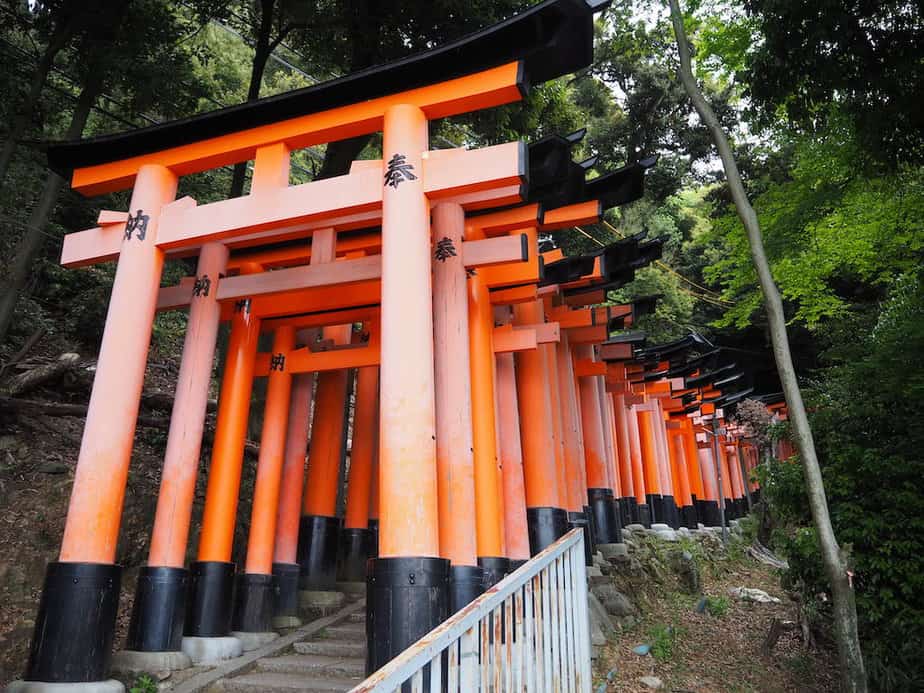
Install an Esim on Your Phone
Having access to the internet with data on your phone is an essential part of your solo trip to Japan. It’ll make your life so much easier.
To easily travel around Japan, you need access to the internet. To get around, to figure out what train to take, find tourist attractions, and make sure you pick the perfect place to eat.
Luckily, there is an easy solution on how you can have data on your phone everywhere in Japan.
That’s by installing an esim on your phone. An esim allows you to purchase local data for whatever country you’re visiting. In this case, Japan. You buy an esim, and you can use your phone’s data just like you do at home but without any high roaming fees.
All you have to do is purchase an esim either online or through the app , install it on your phone, and make your esim your main source of data. The entire process takes less than five minutes and is very intuitive and easy. You can even install an esim on your phone before you arrive in Japan, and it’ll automatically activate when you turn on your data in Japan, and you phone connects to a Japanese network.
I like to purchase my esim online because it gives you a QR code. You just scan the QR code on your phone, and your esim is set up in a few easy clicks.
Esims allow you easy access to phone data without having to rent a wifi egg , purchase a local sim card, or incur high roaming fees with your local carrier.
I recommend esims to all my friends and family when they travel, and they all love it as much as I do.
Install an esim on your phone to make getting around Japan easier and stress free.
My Favourite Esim
Since esims are a relatively new technology, there aren’t a lot of reliable companies offering them yet. And you do not want to purchase an esim from an unreliable company and be stuck stranded without phone data.
I love Airalo . It’s my go-to esim provider, and I purchase all my esims through them.
They have the most esims available for the most countries compared to competitors. They also offer incredibly good prices and always have reliable data. You purchase a certain amount of data up front. If you’re close to running out of data, you can purchase more data to be added to your esim with one quick click in the app.
Another option you can look into is Drimsim . Unlike Airalo, Drimsim charges you per MB used rather than charging you for a certain amount of data up front.
If you don’t plan on using much data, Drimsim may be the better option. I highly recommend if you choose Drimsim to turn off your data whenever you’re not using it. This will prevent data accidentally being used in the background and running up your bill.
I tend to use a fair amount of data when I travel between Google Maps, texting, and scrolling social media while eating alone, so Airalo is my esim of choice.
I’m normally in a country for three to four weeks at a time and purchase the 5GB plan. I’ve never gone over before, but there have been a few times when I’ve been close. If you’re only in Japan for a week or two, you should be fine purchasing a 1GB or 3GB plan.
The 3GB plan is probably your best choice. It’s only a dollar or two more than the 1GB plan and gives you the peace of mind that you won’t accidentally run out of data while out and about exploring one day.
Plus it’s likely more expensive to purchase a 1GB top up if you run out of your pre-purchased 1GB data than it is to purchase a 3GB plan.
Anyways, whatever amount of data you choose to purchase is up to you. The important thing is that you install an esim on your phone, so you can easily access the internet when out exploring. This is especially important as a solo traveller !
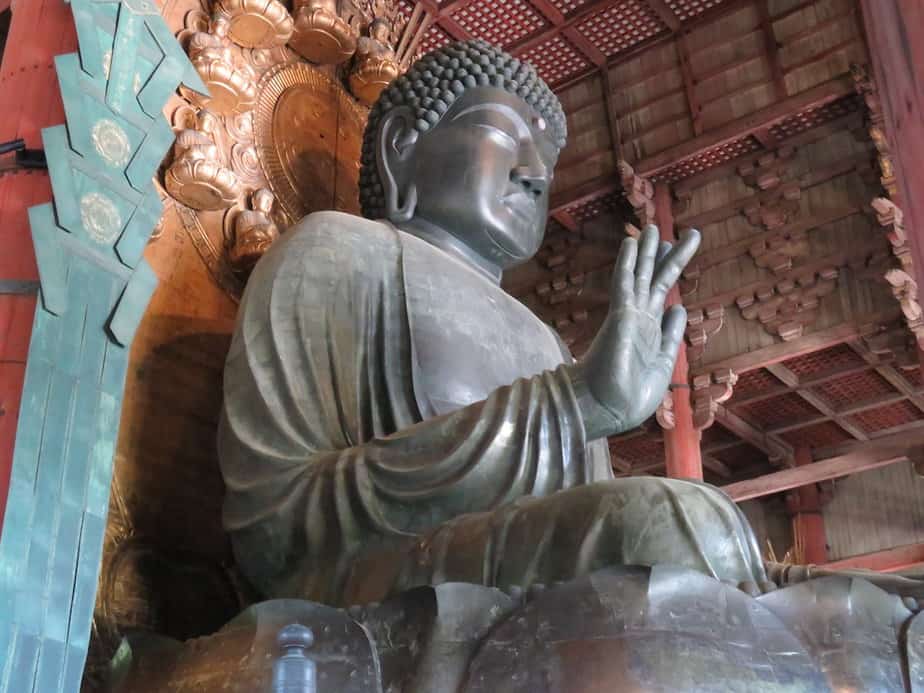
Google Maps is Your Best Friend
You’re probably already acquainted with Google Maps, but it’s going to become your best friend when you’re travelling Japan solo.
Google Maps in Japan has some of the most comprehensive information of any country I’ve visited.
Especially when it comes to public transportation, which some people find overwhelming and confusing the first time they come to Japan.
Here is some of the information Google Maps tells you when riding the metro in Japan:
- What entrance to take to get to the metro
- What exit to take when leaving the metro. This is very important information. Please don’t ignore it!
- The exact train car number you should get on for the quickest transfer or exit
- What platform your train is departing from. This is very helpful in major train stations where there can be over 20 platforms
- How busy the train is, is the train has AC or not, and whether or not there are delays on the route
Google Maps can also navigate indoors in Japan. This is super useful when trying to find a store in a massive shopping mall. It’ll guide you to the nearest escalator to the store you’re looking for and take you right to the entrance.
It’s fabulous. Google Maps may be your most used app while on your solo trip to Japan!
Major Train Stations are Difficult to Manage
Major train stations are extremely difficult to manage. You 100% need to use Google Maps if you’re trying to find what exit to use or something inside a train station.
Before you start thinking I’m dramatic and how hard could a train station possibly be, Shinjuku Station has 200 different exits.
So, yeah, complicated. You can easily get lost and spend an hour or two wandering around trying to find what you’re looking for.
Trust me. I once spent half an hour looking for a tempura restaurant in Tokyo Station and ended up giving up and leaving.
Whenever you have to exit a major train station, be sure you know what exit you want and watch the signs carefully.
Some major train stations like Kyoto Station and Kanazawa Station are easier to manage. Some like Tokyo Station and Osaka Station are more complicated.
Be prepared. Be patient. And if all else fails, find your way to an information booth, and someone will be happy to help you find what you’re looking for.
Be Prepared to Queue
I hate waiting in lines and avoid waiting in them at all costs. The Japanese don’t seem to have the same aversion to lines that I do. There are lines everywhere, and people don’t mind waiting for them.
There are lines for food (these are often the longest lines at popular restaurants). Lines for tourist attractions. Lines for no apparent reason.
It’s just something that comes with a solo trip to Japan.
Hopefully you don’t have to wait in too many lines but bring your patience just in case. If you know you’ll be waiting in a line on a particular day, consider bringing a book (or audiobook) or something to entertain yourself with.

Avoid Golden Week at All Costs
Golden Week is a national holiday in Japan where people get an entire week off of work. Japanese people use this as an opportunity to travel, and a lot of people travel within Japan rather than going abroad.
This means three things:
- The most popular cities like Tokyo, Osaka, and Kyoto are very, very, very busy
- If you’re visiting a less popular tourist destination, things like restaurants may be closed
- It will be difficult to find an affordable hotel even if you’re booking months in advance. I wanted to go be in Sendai durning Golden Week and couldn’t find an affordable hotel even though I was looking 5 months in advance.
I was in Japan during Golden Week in 2023 and experienced both those things. I spent the majority of Golden Week in Fukushima. Not the most popular tourist destination. A lot and I mean a lot of the restaurants were closed. Some were open until 2pm, but many were closed all day. Not great.
Then I was in Tokyo for the last two days of Golden Week. It was madness. I’ve never seen a city so busy in my entire life. I cannot imagine how busy it was during the height of Golden Week because I assume some people already went home to get ready for work in a couple of days.
Moral of the story is to avoid Japan during Golden Week at all costs. Don’t think to yourself that it won’t be too bad because it will be. Trust me.
On the flip side, going to Japan right after Golden Week is probably the best time of the entire year to be in Japan. I was at Tokyo Disney Resort the four days following the end of Golden Week, and I’ve never seen it so quiet before. It was magical.
Golden Week changes dates every year and is sometime in either April or May. Just do a quick Google search before planning your solo trip to Japan and make sure you aren’t planning it during Golden Week.
Avoid Golden Week at all costs. Ideally visit Japan right after Golden Week for the lowest crowds.
The JR Pass Probably Isn’t Worth it
You’ve probably heard a lot about the JR Pass and how it is essential when travelling in Japan. How you’ll save so much money with the JR Pass.
But, honestly, that isn’t the case for most people.
If you’re only travelling between Tokyo and Kyoto, you likely won’t get your money’s worth out of the JR Pass.
If you’re in Japan for two or three weeks and spending more than a day or two in each city, you probably won’t get much value out of the JR Pass.
You need to be using the JR a lot in a short period of time to get value out of the JR Pass. Especially now that the price is increasing by about double!
I spent 3 weeks in Japan in 2023 and took the JR or Shinkansen between each city I visited. I used JR trains to travel within each city. Even though I would have used the JR Pass a lot, it still didn’t make financial sense for me to get one.
That’s because I wasn’t using the JR enough or on expensive enough lines that purchasing a JR Pass made sense.
Be sure to do the math and use a JR fare calculator before purchasing a JR Pass to make sure you’re getting enough bang for your buck by buying the pass.
The benefit of the JR Pass is that you can pre-reserve seats on the train, which is a huge plus if you have luggage and have to reserve luggage space.
Although, when I was in Japan, I never had to reserve luggage because you only have to reserve it on the most popular and busiest routes like Tokyo to Kyoto or Tokyo to Osaka.
You don’t have to reserve luggage space on most Shinkansen trains.
And if you’re going from Osaka to Kyoto without a JR Pass, just get on the slower JR train rather than the Shinkansen. It’s a third of the price and only takes 10 or so minutes longer if you get on a super rapid train.
JR Fare Calculator (see if the JR Pass saves you money)
Be Internet Safe
Even if you get an esim for your phone, you’ll still be relying on public wifi during your solo trip to Japan. Even if it’s only while at your hotel.
Please don’t waste your esim data and use it at the hotel rather than the complimentary hotel wifi!
And since you’re going to be using public wifi at least part of your trip, I’m going to lecture you about the importance of using public wifi safely.
Public wifi networks are just that. Public. That means anybody with the code can access the wifi. From my experience, a lot of hotels in Japan don’t have a password on their wifi. Anybody can access the wifi even if they aren’t staying at the hotel.
This means that there are countless people using the same unprotected wifi network as you. That puts you personal online information (like you’re banking information) at risk of being stolen.
All it takes is one person with bad intentions, and you’re dealing with the headache of cancelling bank cards while abroad. Trust me when I say that’s no fun.
The only way to protect yourself when using public wifi networks is by installing a VPN on your devices. A VPN essentially puts an invisible forcefield around your devices that makes it impossible for prying eyes to access your personal online information.
A VPN makes using public wifi networks just as safe as using your home wifi where you’re the only person who knows the password.
One of the most important things you should so when preparing for your Japan solo trip is install a VPN. It’s the simplest safety precaution you can take.
The cost per month for a VPN subscription on a two-year plan costs less than a latte and cake pop at Starbucks. You have no excuse not to protect your online information.
I always say that if you can afford to travel, you can afford to protect your online information with a VPN.

My Favourite VPN
I’ve used a lot of VPNs over my many years of travel. Most of them, frankly, suck. VPNs are notorious for slowing your devices down, and you really feel the different in internet speed when using a VPN.
That’s not the case for NordVPN . It’s consistently ranked the fasted VPN on the market and the only VPN I’ve ever consistently used. You don’t feel like your internet speed is slowed down at all when using NordVPN.
You can install a single NordVPN subscription on up to six devices. That makes it super easy to protect all your devices for one low price.
One of my favourite feature of VPNs is being able to cloak my location. That allows me to watch Netflix from different countries and watch Canadian sporting events while abroad.
There are really no downsides to installing a VPN on your devices. It’s an extremely small price to pay for the peace of mind you get by knowing your private information is safe and sound while you’re abroad.

Get the fastest and most reliable VPN on the market for an extremely low price.
One of the first things you’ll notice on your solo trip to Japan is how quiet it is. In terms of volume. Not in terms of people. There are always tons of people in Japan.
It’s a widely known rule that people are quiet and respectful while out in public. This means no talking on the metro and no loud conversations at restaurants.
And please, please never answer a phone call while on public transit. It’s considered quite rude to speak on the phone in nearly every indoor public setting in Japan. But if you talk on the phone on the metro, you will definitely be getting dirty looks.
Just be sure to be quiet, reserved, and respectful while in public in Japan. I know you’re on a solo trip to Japan, but I also know a lot of you like to make friends while travelling alone. So, if you go out with a group (or while you’re alone), please be quiet.
There is a time and place for loud conversations, and in public is not it.
Oh, and small talk isn’t really a thing in Japan. I know my American friends love starting small talk with strangers, but you’ll be getting weird looks if you try that in Japan.
Taxis are Extremely Expensive
Taxis are never the most affordable way to get around, but in a lot of places they’ve not super expensive. They’re affordable enough that you can justify taking a taxi if it’s going to be super convenient or save you a lot of time.
Japan is not one of those places.
Japan has the most expensive taxis I’ve ever seen in my life.
There is no circumstance I could ever see justifying me using a taxi instead of the metro other than being physically injured and needing to get to a hostpial.
And even in that circumstance, I may still take the metro because the taxi fees are so high.
If you normally take taxis when you travel, you’ll need to get used to the idea of using public transportation or walking.
See point one about staying near a train station if you need a refresher. 😉
The good news is that Japan has one of the best public transportation systems in the world. It’s so easy to get around. You won’t even miss taking a taxi.
Most major cities have large metro systems. Tokyo, Osaka, and Kyoto all have metros where you can easily get around. Smaller cities in Kanazawa rely on buses. But they’re smaller cities, so it’s easy to walk everywhere if you’re staying in a central location.
Just be prepared to use public transportation and walk a lot while in Japan. Taxis are a luxury not a normal thing to use.
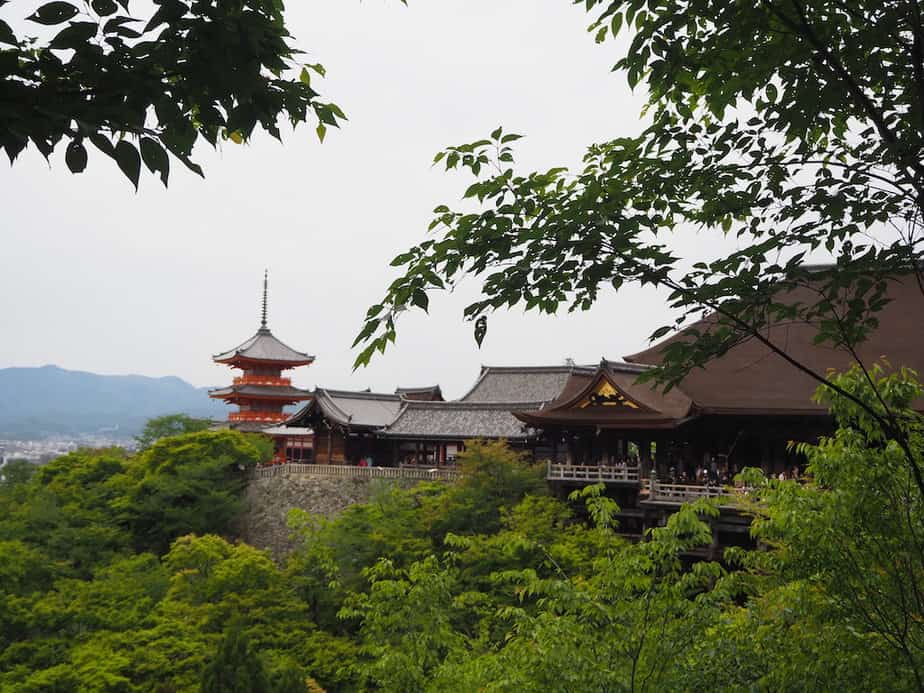
Purchase Popular Tickets Online in Advance
As we’ve talked about in this article, Japan is busy, and there are often queues. To cut down on your time waiting in line, there are two things you can/should do:
- Get to attractions earlier in the day to avoid crowds
- Purchase tickets online in advance if you can
These two things will save you heaps of time on your solo trip to Japan. You’ve got a lot to see and do while in Japan alone, and you don’t want to be stuck waiting in a line if you don’t have to.
There are also some things you need to pre-purchase tickets for. As in you can’t get them at the door or they’re likely to be sold out. Those two main things are Universal Studios Japan in Osaka and Tokyo Disney Resort .
This is especially true for Tokyo Disney. You have to purchase your tickets in advance. You can’t buy them at the gate. Universal recently reintroduced buying tickets at the gate, but it’s a super small park and sold out in advance more days than not.
Other Tickets You Should Consider Buying in Advance
- Tokyo Skytree
Shibuya Sky
- Tokyo Tower Observation Deck
- TeamLab Planets (hugely popular and likely to sell out)
- Sanrio Puroland
- HARUKAS 300 Observatory
- T eamLab Botanical Garden (Osaka’s version of TeamLab Planets)
- Osaka Museum of Housing and Living
Narita is Very Far Away from Central Tokyo
Narita is very, very far away from central Tokyo. Haneda is closer to central Tokyo, but the majority of international flights fly in and out of Narita.
This means you need to have a solid plan on how you’re getting from the airport to your hotel. Sometimes it can take up to two hours depending on where you’re staying.
You can either take the metro or a limousine bus. I prefer the bus. You’re guaranteed to get a seat, probably drops you off closer to your hotel, there is no need to transfer, and you don’t have to deal with your luggage. It just sits nicely under the bus.
Taxis aren’t an option unless you’re rich because they’re so expensive. A taxi from Narita to central Tokyo will cost you a few hundred dollars!
And the last thing you want to do on a solo trip to Japan is break the bank taking a taxi just because you didn’t plan properly!
The fact that Narita is so far away from central Tokyo also means that you need to be strategic about when you book your flight.
If you land late in the evening or depart early in the morning, you might have an issue. Maybe the buses aren’t running early or late enough or maybe you don’t want to drag your butt out of bed super early or be trying to find your hotel in the dark.
If you’re arriving late or departing early, I highly recommend staying at a hotel near the airport for a night. It’s so much more convenient. I’ve done it before for a flight departing at 11am and would do it again in a heartbeat.
Plus the hotels near Narita are surprisingly affordable. I loved my stay at the Hilton Narita . It was super nice and seemed like it should have costed more than it did.
Most airport hotels offer a bus to and from the hotel, which is super convenient. The hotels say it takes about half an hour to get to the airport. From my experience, it takes about 15, but it’s better to be early than late!
Go to Tokyo Disney on a Tuesday or Wednesday
Tokyo Disney is a must do for any theme park or Disney fan. Heck the theme parks are so well done that even people who hate Disney enjoy them.
Tokyo Disney Resort has two theme parks: Disneyland and DisneySea. DisneySea is the more unique one of the two, but they both have rides you don’t want to miss.
TDR is hugely popular. Not only with tourists but also with Japanese people. This means that it’s always busy. The most popular rides often have wait times between 90 and 180 minutes.
That’s just on a normal day. Not even during the busiest times of year.
So, you definitely need a strategy when going to Tokyo Disney. It may be your only trip, and you want to get the most out of it.
There are way too many tips and tricks about Tokyo Disney to put into this short(ish) blog post. You’ll have to do a deep dive on that on your own. TDR Explorer is a great place to start!
One important tip I will give you is to visit Tokyo Disney on either a Tuesday or Wednesday.
This is when the parks will be the least busy. You’ll be able to get a lot more done on a Tuesday or Wednesday than on the weekend.
Mondays and Thursdays are normally medium busy. I’ve noticed that a lot of the times school groups are filling up the parks on Thursdays leading up to the weekend, and they’re a lot busier than Wednesdays.
Mondays have carryover from people visiting over the weekend. They’re not as busy as a Friday, Saturday, or Sunday but are still quite busy.
So, if you have flexibility in your schedule, try to arrange your trip to Tokyo Disney for the middle of the week. This will give you the best chance at having lower crowds.

Make Sure You Have Health Insurance
Health insurance is an essential part of travel, and you need to make sure you have health insurance that covers your solo trip to Japan.
You may have travel coverage through your work plan. If you do, you just need to make sure it covers the entire duration of your trip. Most policies only cover the first 21 or 30 days of your trip.
If you’re like me and don’t have insurance through your employer, you have two options.
First Option
The first option is perfect for people who are only going abroad for a shorter period of time. This is buying travel insurance from a major company in your home country.
You can normally get insurance through a bank, company that sells house or life insurance, your local healthcare insurer (like Blue Cross), or through a company like AAA or AMA or CAA.
All these places will let you purchase a travel health insurance policy to cover the duration of your trip.
These are normally reasonably affordable. Especially if you’re only gone for a week or two. They offer decent coverage, but they often make it a headache to make a claim.
You can also get a multi-trip policy that covers you for every trip you take abroad in a year as long as the trip is under a certain amount of days. You get to choose the amount of days when you purchase the policy, and they range anywhere from 7 to 60 days.
This is what my retired parents use, what I used when I was a student, and what most casual travellers use.
Second Option
The second option is for long-term travellers and digital nomads. That’s purchasing health insurance through a specialized company that solely provides insurance to travellers.
There are a couple of companies you can get this type of insurance through. I personally use Safety Wing and think they’re the best option you there.
They’re very affordable, have a low deductible, make it easy to make a claim, and even provide you coverage in your home country for 30 days as long as you’ve been abroad for 90 days.
I love the flexibility of Safety Wing and being able to cancel anytime I want. If I’m going to be in Canada for a few months, I can cancel my policy and then reinstate it when I start travelling again. They even let you purchase your insurance while you’re abroad and already on your trip, which is quite rare.
Again, this option is best for people travelling for a long period of time. It’s much cheaper in the long run than the first option and provides better coverage.

Bonus: Try the Melon Fanta (Trust Me)
This may sound like a weird thing to throw into this article but hear me out. The Melon Fanta in Japan is the best soda I’ve ever had. And I’m a soda girlie.
I know. I know. It isn’t healthy, but it just tastes so good!
Melon Fanta is incredible . It’s a bit hard to find in convenience stores, so you may have to order it at a restaurant, but it’s so worth it.
I tell all my friends who go to Japan to try it, and they all love it.
I know it sounds like an odd flavour of soda, but please trust me and try it!
My Favourite Things to do in Japan Alone
Tokyo Disney Resort
Shinjuku Gyoen
Todaiji Temple
Fushimi Inari Shrine
Kiyomizu Temple
Museum of Housing and Living
Universal Studios Japan
Osaka Castle
This article ended up being way longer than I thought it would! I guess I just have a lot to say about taking a solo trip to Japan and being in Japan solo.
Japan is a super unique country and requires a bit more planning and understanding than a lot of other countries. It’s so easy to accidentally offend someone because you don’t know the social norms.
But I hope this article helps you better understand what a solo trip to Japan will be like and how to best prepare for being in Japan solo.
It’s an amazing country, and I have no doubt you’ll love it. Basically everybody does. That’s why it’s so popular!

Related Posts
- 9 Key Things to Know Before Your Solo Trip to Ireland
- 9 Tips to Know Before Taking a Solo Trip to Copenhagen
Solo Travel in Japan
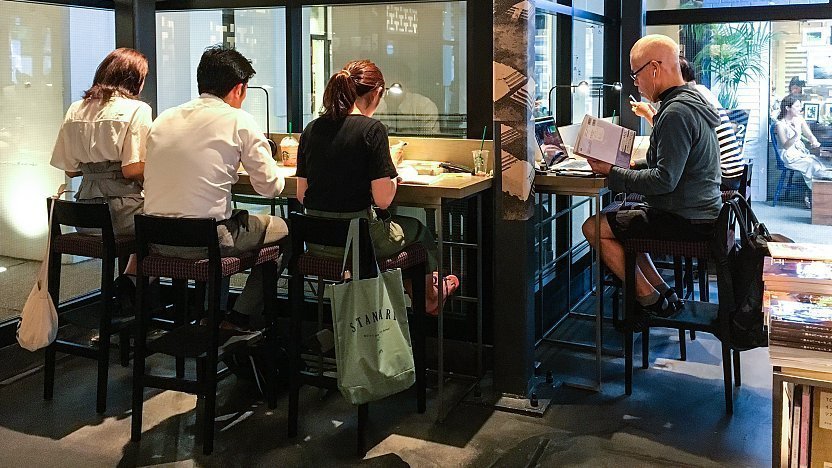
In past decades, most solo traveler in Japan used to be the ubiquitous salarymen (office workers) on business trips. These days, however, many locals, especially the younger generations, are increasingly traveling alone or doing things by themselves, creating a unique market aimed at singles.
If it is your first time traveling alone or visiting Japan, it might be simpler to base yourself in one place and make multiple day trips out or mix in an overnight trip or two. Sticking mainly to the city may make it easier and cheaper, but venturing out into the countryside allows for different experiences.
As much as you may want to see everything in a limited space of time, it is advisable to incorporate some flexibility into your daily itinerary. This is to allow for things to go wrong and to have some extra time to rest or enjoy beautiful things. Below are some basic points to note for those who travel in Japan alone.
Safety issues
Japan has a reputation for being a safe country, a place where locals leave their belongings at the table unattended, where lost belongings get returned with their contents intact, where it is generally safe for women to walk alone at night, even down dark alleys and where children typically commute to school with minimal adult supervision.
But the low crime rate does not mean that you should let your guard down. It is imperative to always be aware of your surroundings, especially when walking along dark streets. A good gauge is: if you would not consider doing something alone in your home country, you should not do it in Japan either. Just because a majority of the people tend to be friendly and helpful towards visitors does not make the minority less dangerous.
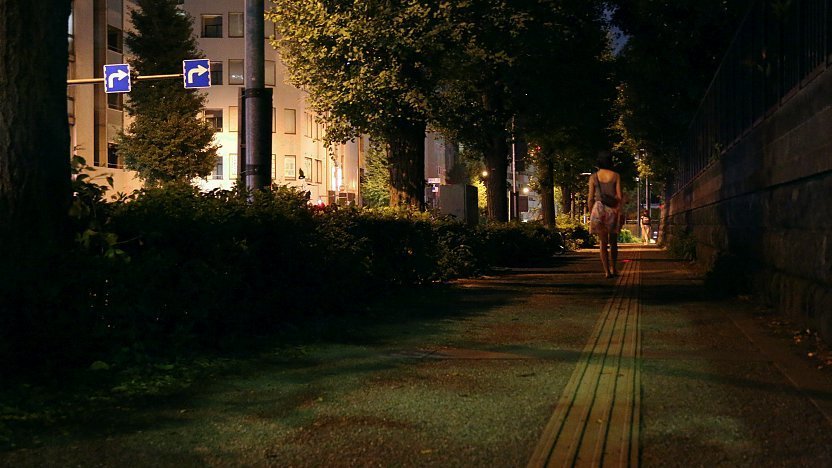
Visitors should be vigilant. Avoid providing potential perpetrators with opportunities, be aware of your surroundings and listen to your gut instinct. Remember that offenders come in all shapes and sizes and can be Japanese or not.
Police boxes, or koban as they are known in Japanese, can be found in all neighborhoods. Police officers stationed there are usually the first to react to a distress call in the neighborhood, and the koban is also a safe place to run to in case of emergencies.
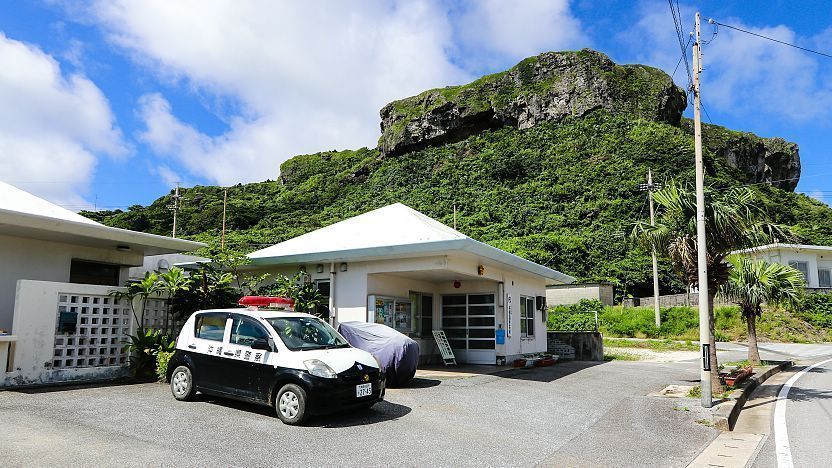
Accommodation
Business hotels and hostels are the best options for single travelers looking for economical and no-frills accommodation , short of staying in a capsule hotel . These lodgings are readily found in most cities across Japan and offer basic sleeping furnishings.
Ryokan let staying guests experience traditional culture and hospitality, as well as local cuisine and hot springs . Ryokan have traditionally not been catering to single travelers, and many still adhere to this tradition. However, things are changing, and the number of ryokan that offer plans for single travelers has increased a lot over recent years.
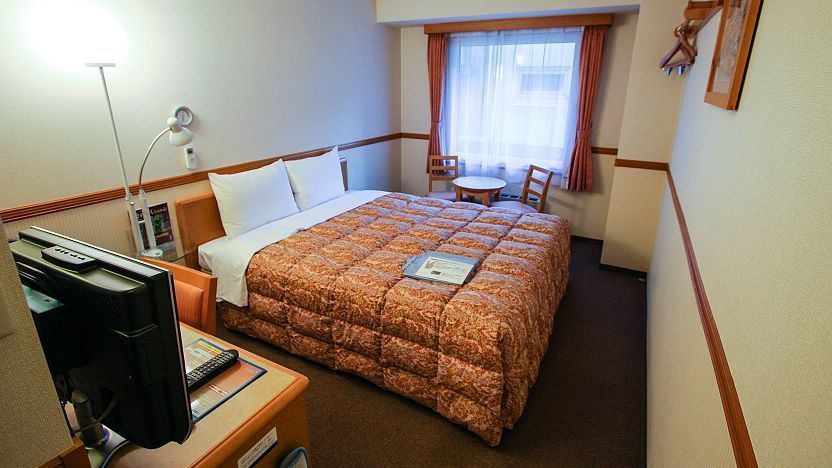
Dining alone has never been easier in Japan, and many places are well equipped to serve the solo diner. Restaurants have come to acknowledge the increasing trend and will typically accept reservations for a single diner. Casual dining establishments, like some ramen -ya even offer individual cubicles, and coffee shops and fast food restaurants are often filled with single customers. Some restaurants and izakaya may seat single diners at a counter in order to keep tables available for groups.
Nervous solo diners note that staff and fellow customers are used to single travelers, especially in the big cities where solo diners abound, and will not cast curious or pity looks. Staff tend to be patient with non-Japanese speaking customers who attempt to navigate the menu and order in a foreign language. That said, it also pays to do a bit of menu research before entering a restaurant , in particular those that utilize ticket vending machines for orders , to avoid the added stress of holding up those behind while you decide what to get.
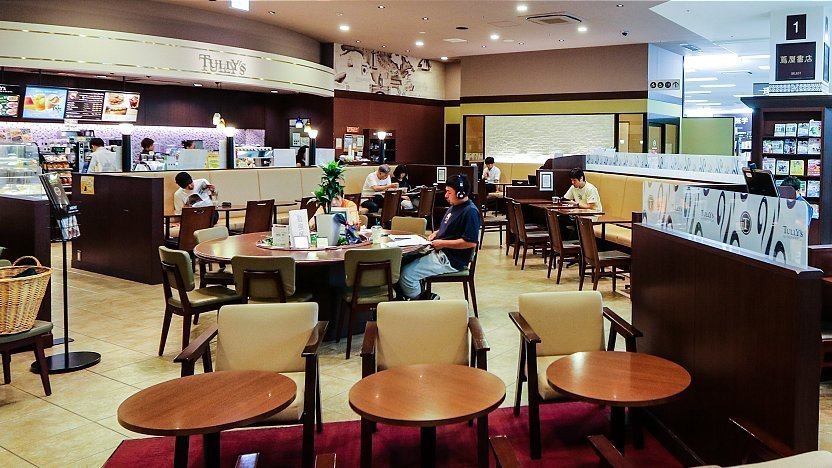
Meeting people
Joining a day tour or staying at a hostel are some easy ways to meet like-minded travelers. Signing up for a tour with a local volunteer guide or participating in a home visit could add a different element to your solo travel and allow you to meet local Japanese.
Saving your seat
Leaving your seat and your personal belongings unattended is a big no-no in many countries, but in Japan it is not uncommon to see customers leave expensive phones and bags at their restaurant table or shinkansen seat unattended. Nevertheless, it is not advisable to leave personal items unattended if you have to leave temporarily. Take at least your most important items like wallet and passport with you and use an item that you wouldn't mind losing to save your space instead.
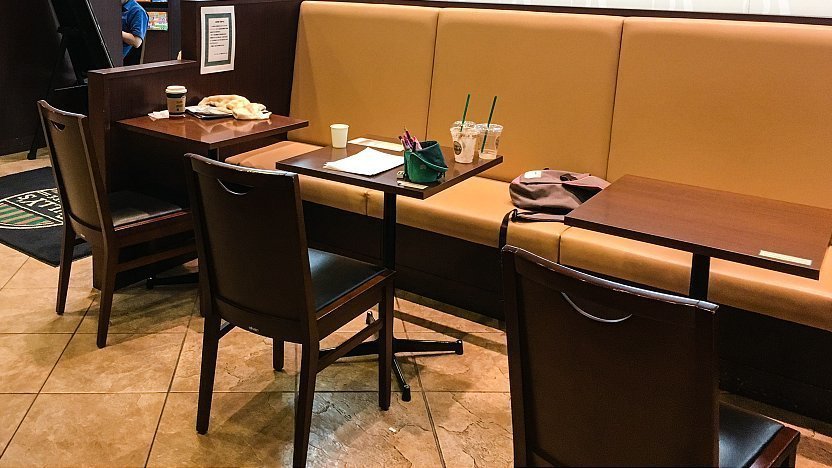
Outdoor activities
Outdoor activities like hiking can easily be completed by solo travelers. Even if you are a seasoned mountaineer, it is always prudent to inform someone of your hiking itinerary and to register your hike before starting on the trail. Having a working phone on your person is recommended in case of emergencies while having a bear bell can be a useful addition in some parts of Japan. Of course, if you have never hiked or are not a regular hiker, it is best to stick to short, easy routes or join a tour .
Water sports can be split into those you can do on your own and those that require joining a tour. Swimming at beaches is a typical water activity that can be done on your own, but make sure to pay attention to the tides and water currents so as to not endanger your life or others. Guided tours may require a minimum number of participants. Otherwise, be prepared to pay additional for a private tour.
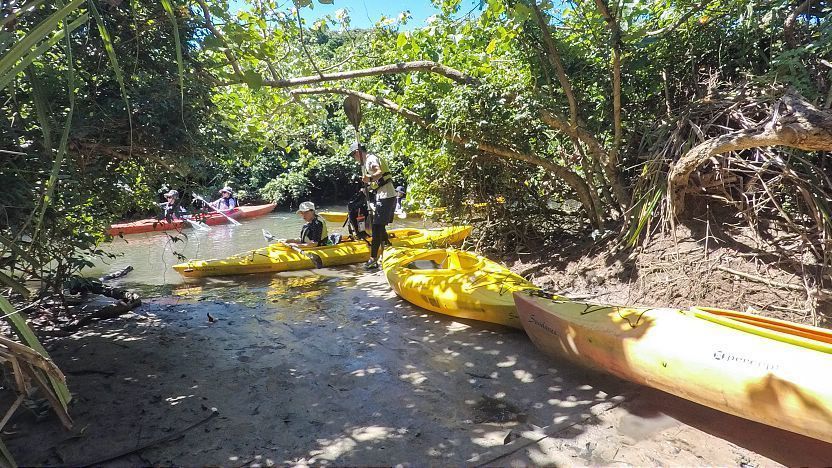
Tips for solo female travelers
Japan is admittedly one of the safest places to attempt as a first-time female solo traveler, and the probability of being harassed by locals is quite low. A steadily shrinking number of locals - mainly in the remote countryside - may stare at those who look and talk differently out of curiosity. Below are some tips for the solo female traveler.
Traveling alone
Targeted at the solo female traveler, our Solo Female Travel series introduces travel itineraries that have been put to the test by the author to answer the questions "Can a girl do this alone?", "Is it safe to visit alone?" and "Would the pace be too demanding?" amongst many others. Introduced destinations tend to be slightly off the beaten track, but still manageable by the average female.
Despite the popular images of Japanese youth using fashion as a creative expression, the general fashion for the average Japanese tends to lean towards the conservative side. A typical female outfit is usually quite modest with shoulders covered and a relatively high neckline even during the warmer seasons. The coverage protects the skin from getting tanned and avoids bringing attention to the body shapes. Hemlines tend to be shorter for the younger generation but typically fall around the knees for most, and socks or stockings are commonplace.
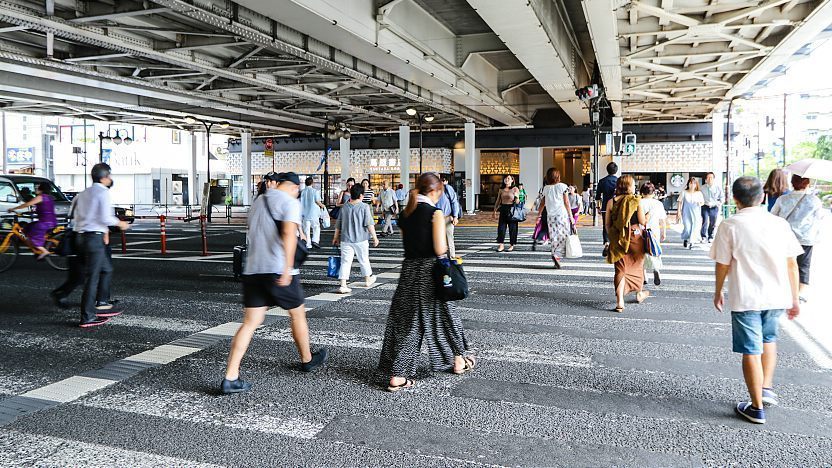
Sleeping on public transport
Traveling can get tiring, and it is common to see people sleeping on buses , trains and even on the train platforms. Theft on sleeping passengers remains relatively low, but as a solo female traveler there are a few additional things to look out for. If you are asleep, you will not know what is happening around you, and more often than not, fellow passengers will remain silent even if there are creepy people around you. Make sure that you do not expose yourself accidentally or invite intrusive gazes with your choice of clothes in addition to making sure that your belongings are secure. You cannot go wrong by erring on the conservative side when it comes to packing your travel wardrobe.
Sexual Offenses
Despite the seemingly low rate of provocation against women, there are certain areas where that ratio is skewed. Groping - inappropriate touching - and taking pictures from under a skirt or shorts (upskirting) are not uncommon occurrences especially on crowded trains.
Chikan is the Japanese term for groping and can refer to both the act of groping and the culprit. Sexual offenses on public transit have become prevalent enough that train companies especially in the bigger cities have introduced female-only train carriages to combat the issue (often during rush hours only). As a general rule of thumb, if you are worried about unwanted advances, it is best to avoid peak hours as a tourist and stick to the female-only carriage.
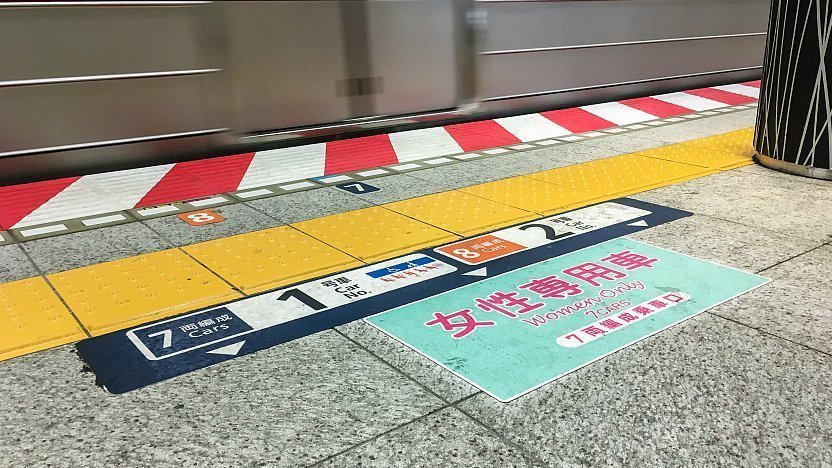
- Say "Stop!" or "Chikan!" to the culprit as keeping silent may escalate the situation and encourage the culprit to carry on
- If you are unable to identify the culprit, leave your spot and move somewhere else
- Grab the offender if possible or take note of any distinguishing marks or accessories on their person for future identification purposes
- Report the crime immediately to the train station staff or police
Questions? Ask in our forum .

We’re on the road right now – join in on the fun and follow @thebrokebackpacker on IG!
- Meet the Team
- Work with Us
- Czech Republic
- Netherlands
- Switzerland
- Scandinavia
- Philippines
- South Korea
- New Zealand
- South Africa
- Budget Travel
- Work & Travel
- The Broke Backpacker Manifesto
- Travel Resources
- How to Travel on $10/day
Home » Asia » Japan » ULTIMATE Guide to Solo Travel in Japan | Destinations & Tips for 2023
ULTIMATE Guide to Solo Travel in Japan | Destinations & Tips for 2023
Japan is the DREAM for many curious travelers. Manga, anime, sushi, cherry blossoms, Nintendo, Toyota, hot spring pools, Buddhist temples; the thought of these lit a fire in me! But with no one willing to tag along for the ride, I had to start planning a Japan solo travel trip.
There’s nothing like relaxing in hot spring pools, listening to Japanese patrons, eating real Japanese sushi under Tokyo Tower. And believe me, visiting Japan is even better solo .
You can take your time. You’ll get to know the locals and test your language skills. Japan is also extremely friendly and safe.
It’s perfect for lone wolf adventures through her many islands. You can experience it all by taking in the beauty of her rural landscapes or venturing into her busy cities at the forefront of high tech.
With all the excitement of traveling to Japan, I’m here to jump-start this new endeavor as you plan this journey to experience the beauty of Nihon and Nippon for yourself. So, let’s start with how to make the most of your solo traveling in Japan, the best places to stay, where to go, and how to survive in this unique country.

7 Things to Do in Japan When Traveling Solo
5 best solo destinations in japan, the best travel apps for solo travel in japan, safety tips for solo travelers in japan, tips for solo traveling in japan, how to meet people when solo traveling in japan, final words for solo travelers in japan.
Backpacking Japan is EPIC. Can’t find a buddy to go with? Go alone!
I’m here to show you that traveling solo in Japan is a breeze . However, there are seven things that you should consider when traveling around the country. These can be things to do alone, taking full advantage of your solo experience, or activities you could do with your new travel friends.

Unlock Our GREATEST Travel Secrets!
Sign up for our newsletter and get the best travel tips delivered right to your inbox.
Hangout in Hostels
One of the best solo travel tips is to stay in one of the amazing hostels in Japan !
You can meet fellow travelers while staying in a great place on a reasonable budget. You can save money and rely only on your bedroom to sleep, with the option to socialize with others in shared lunging areas or use those extra funds to see more of Japan. Hostels also have various accommodation options, so even a solo female traveler is well cared for.
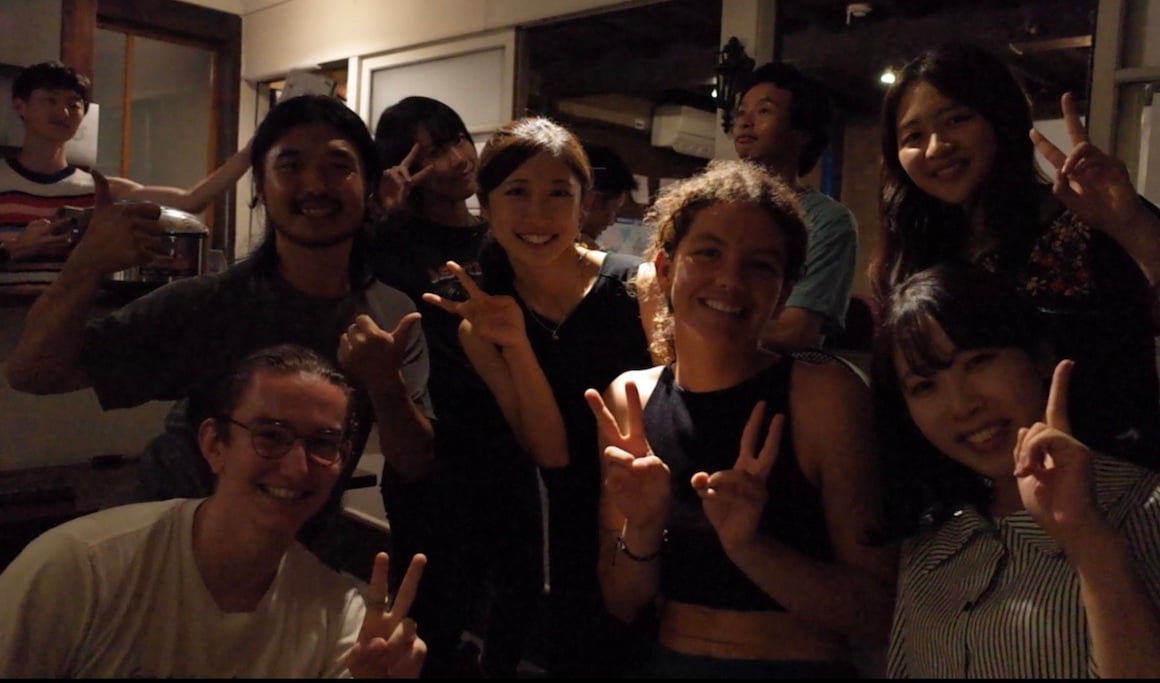
Take a Group Tour
Even if you ride solo in Japan, taking a group tour is a great way to break up the experience and keep yourself sane with socializing. Sometimes it’s nice to relax and let a tour guide take you to some unique attractions as you lay back and have a yarn with a fellow traveler.
I loved the bus tour of Tokyo because I could sit and chat to all my new buddies while escaping the rain.
Stay as a Home Stay With a Japanese Family
If you want to test your Japanese and get a taste of traditional life in Japan, the best way to do this is to organize a homestay with a Japanese family. Despite it being more common for younger adults and teenagers, there is no age limit for homestays. There are many brilliant companies like Go! Go! Nihon that makes it easy.
Spend a Relaxing Day at an Onsen Hot Pool
One of Japan’s most famous past times is relaxing in an Onsen Hot pool, and considering this is often a solo experience, it is one of the best ways to relax on holiday. There are many places in Japan that host hot pools. However, the most famous is Kurokawa Onsen, found in Minamioguni.
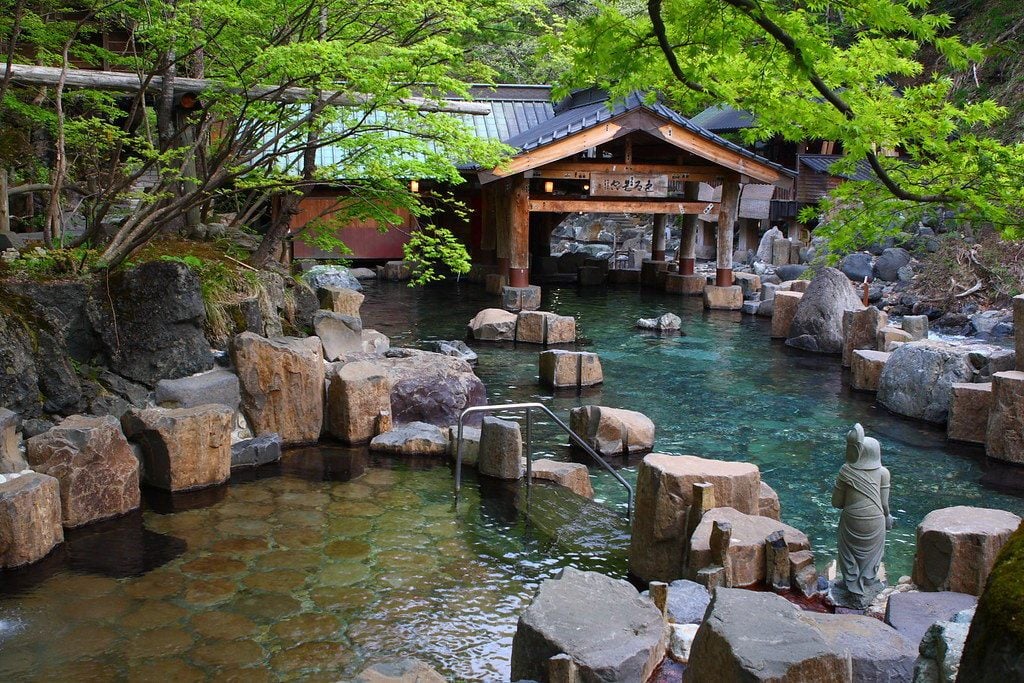
Have a Quiet Trip to a Traditional Japanese Shrine
Wherever you find yourself in Japan, you are likely to encounter a traditional Japanese shrine, and what better way to learn about the cultural heritage of its people and spend some quiet alone time than a trip to these places! In Tokyo, a popular shrine is Ise Jingu, a beautiful 4 th -century BC shrine dedicated to public happiness.
Relax With a Traditional Tea Ceremony
Experience the ancient tradition of ‘way of the tea’ as you taste one of Japan’s most sacred ceremonies. This quiet Japan solo travel experience allows you to witness first-hand the ceremony and the delicious taste of tea. Kyoto and Uji have various places for tourists to experience this tea ceremony.
Attend a Japanese Language Class
If your language skills could do a little more work, attending a Japanese language class is a great solo adventure in Japan. You can meet others trying to learn the craft and practice at your own pace, then test what you’ve learned in your solo ventures around Japan.

We’ve tested countless backpacks over the years, but there’s one that has always been the best and remains the best buy for adventurers: the broke backpacker-approved Osprey Aether and Ariel series.
Want more deetz on why these packs are so damn perfect? Then read our comprehensive review for the inside scoop!
Japan is like nothing else. But why? It’s a place I found where you’ll find something magical, futuristic, and unexpected around every corner.
The people and their culture will make you understand why Japan is a special place to so many people (including ourselves). I have hand-picked five of the best solo destinations in Japan to ensure you still have a brilliant time on holiday without feeling like you are missing out on a complete experience—and to make the most of riding alone.
Staying in Tokyo is the best option for solo travelers in Japan because, as you may already know, it is the capital city. Here you will find an ultramodern megacity intermixed with traditional Japanese cultural heritage, world-class hospitality, attractions, and public transport. I also love that it’s super visitor-friendly and safe for solo travel.
I can guarantee it’s a breeze to get around, but that is not all! It is the place to be to see the famous Japanese tech industry, be served by a robot waitress in a mall, or gaze at the headquarters of the big tech and gaming giants.
However, to experience a slice of their older attractions, I recommend the many Buddhist temples, such as Senso-ji. Oh, and you cannot beat the high city views from Tokyo Tower and Mount Fuji.
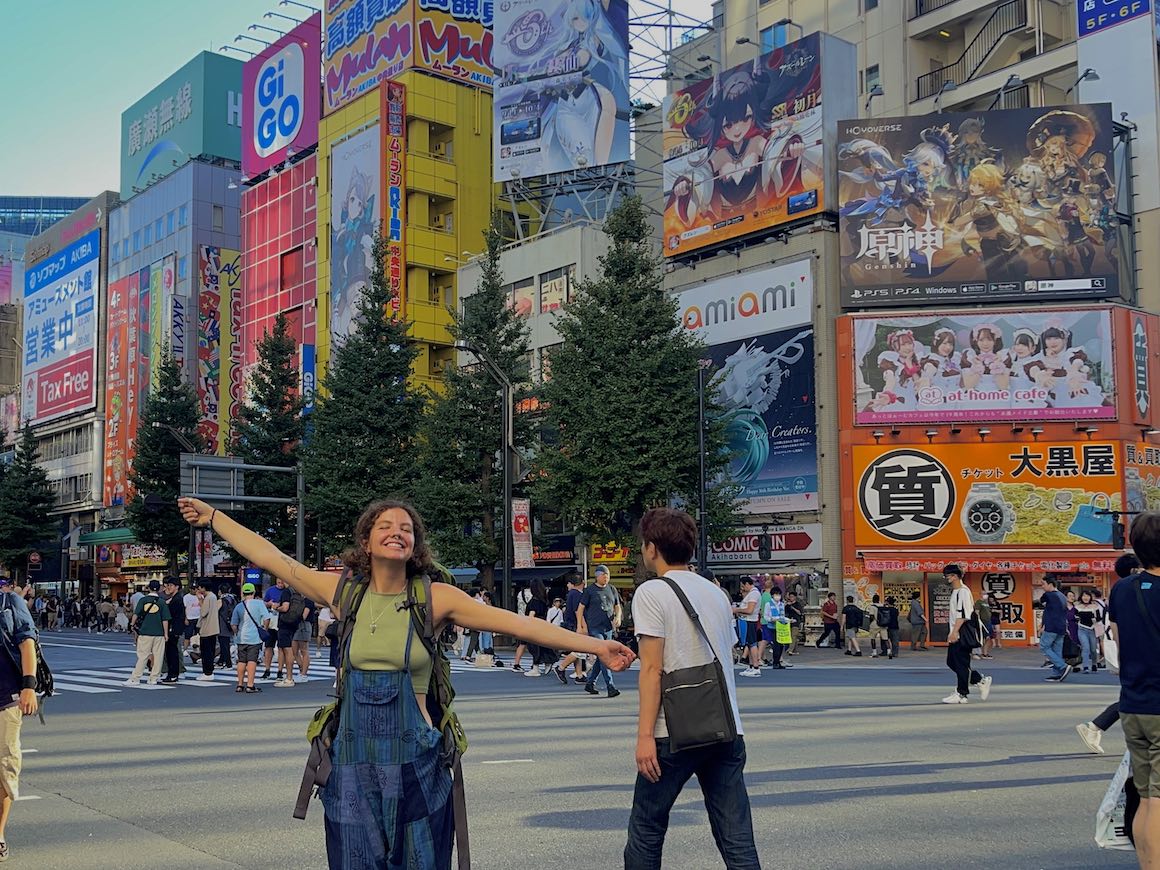
When staying in Tokyo, one of the best hostels for Japan solo travel I found was the Tokyo Guesthouse Oji music lounge . Not only was this two-star hostel easy on my budget, but it was also perfect for meeting fellow travelers while playing the lone wolf.
Heading to the former capital of Japan, Kyoto is another brilliant place for solo travelers to experience Japan. I can tell you that its famous Buddhist temples, Shinto shrines, palaces, and gardens help the city live up to its UNESCO World Heritage Site, without a doubt! My must-see attractions for visitors include Kyoto Imperial Palace, Kiyomizu-Dera, and Kyoto Tower (you can compare notes with a visit to its Tokyo sister).
Another reason why I adore Kyoto so much is its entirely visitor-friendly, with excellent public transport and friendly locals who are happy and willing to interact with a mixture of miming and simple Japanese. All these things make it an easy solo traveling experience.
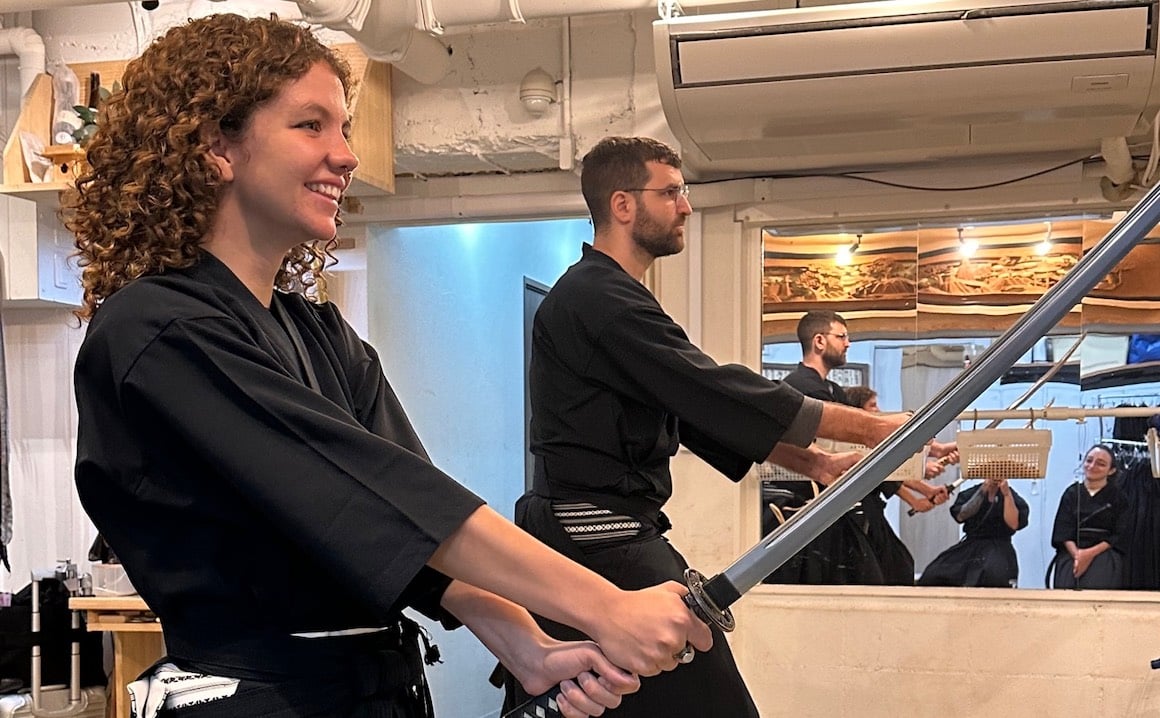
So where should you stay in Kyoto ? You will be ecstatic to learn they have MANY solo travel-friendly hostels where you can relax.
The Kyoto Hana Hostel is my top pick; this hotel isn’t just a budget-friendly choice, with a five-minute walk from Kyoto Station Central. I love the opportunities to meet others in their range of shared bunk rooms, with the option for female-only! They even have a Japanese sleeping experience if you pick a private room with a shared bathroom.
Visiting Japan’s second-largest city Osaka, you will find a wonderful Japan solo travel experience that is hard to beat! All the while being treated to an affordable travel experience with excellent public transport and an endless list of things to do and see!
During my visit, I adored learning about Osaka’s origins dating back to the 3rd Century AD and how it quickly established itself as a significant port. Today this old-timer still holds a strong sense of modernity. However, it isn’t all about its industry when you come here.
Osaka offers SOOO many things for solo travelers, including its mouth-watering food and the iconic Osaka Castle. I particularly recommend a stop by the Osaka Museum of Natural History , its numerous parks, and Buddhist temples.
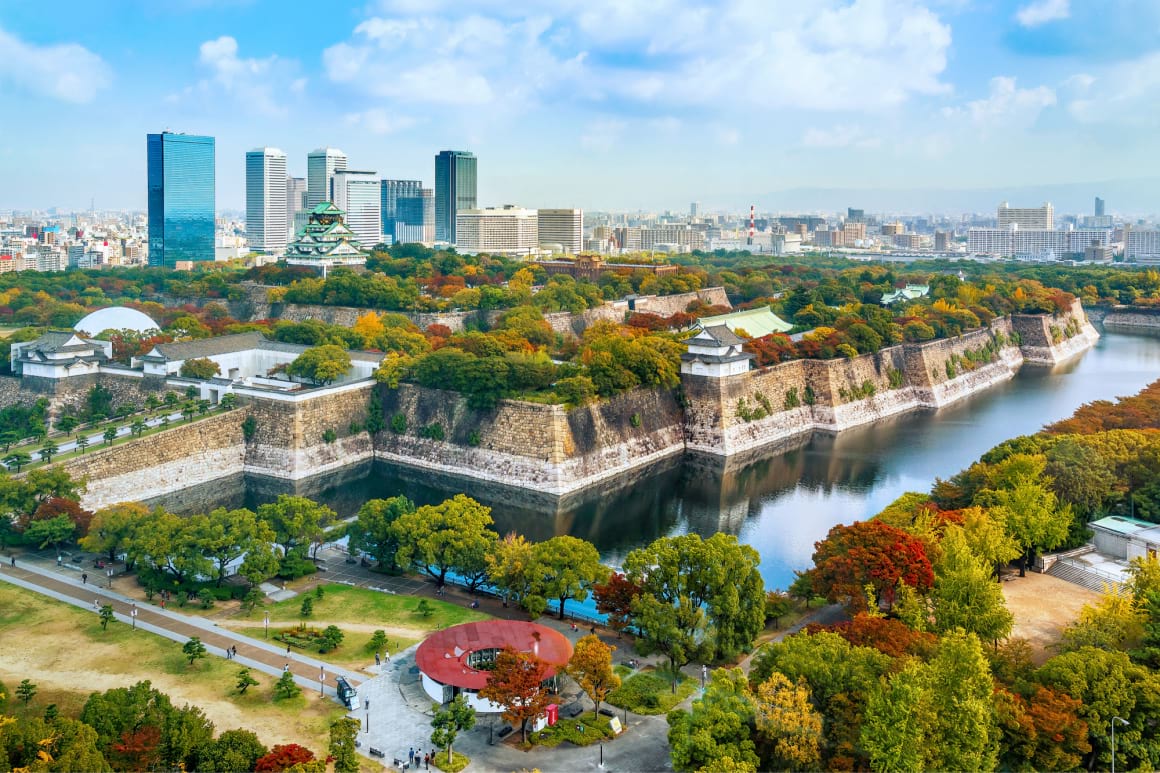
When you stay in Osaka as a solo traveler, I can rest your worries with their range of hostels waiting to welcome you to this iconic city. Notably, The Stay hostel is my favorite, as a great budget-friendly choice, all while being treated to shared bunkrooms, a rooftop terrace, a shared kitchen, and dining and lounging areas.
My favorite place to go on a solo mission through the rural parts of Japan is Hakone.
The best thing about this place is, of course, it’s… HOT SPRINGS! This little 1892 village may have this as its main tourist drive, but it’s certainly not the only thing. You will adore its location in the Fuji-Hakone-Izu National Park just west of Tokyo with gorgeous lakes and mountain forests.
It is a perfect solo destination! You can make the most of its tranquility, take a solitary walk, and relax in the hot springs at the end of a sweaty hike. Adding to this, it’s just a short stop outside of Tokyo.
In my mind, it makes it even better as you could take a day out of city life to taste rural Japan. So if you take the dive to Hakone you need to check out Lake Ashinoko, Hakone Shrine, the Botanical Garden, and of course, Hakone Onsen (the to-die-for hot spring).
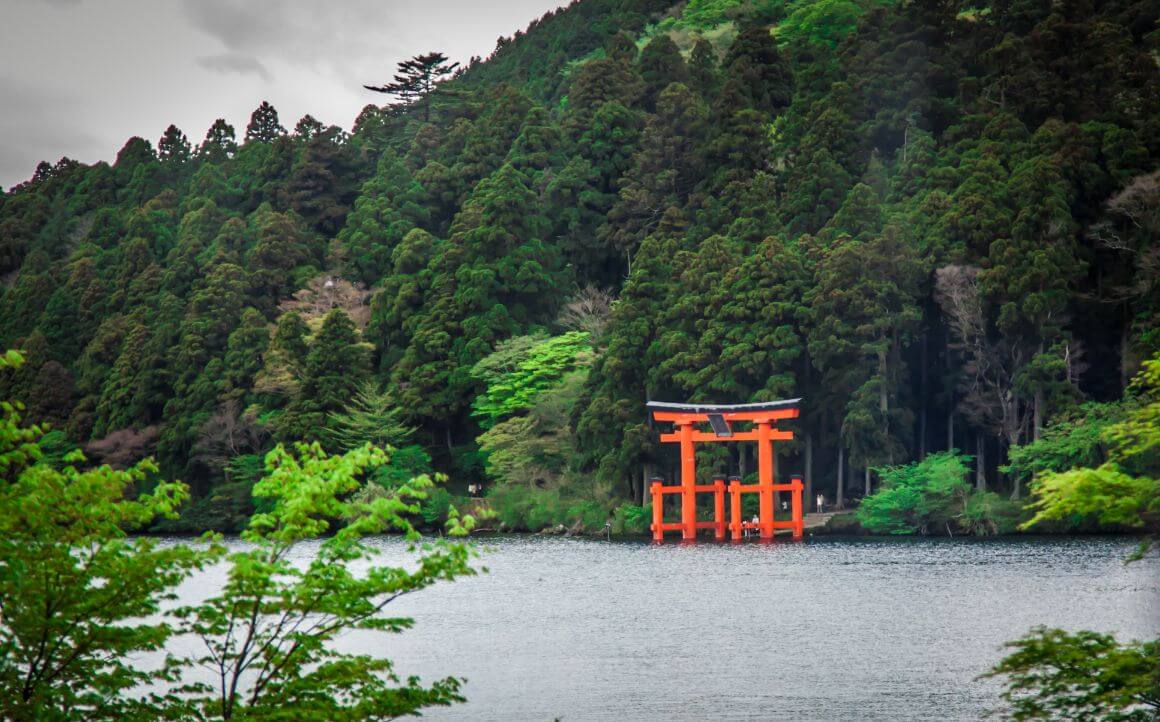
If you decide to stay in Hakone, I recommend the Guest House Azito is in the heart of the town. Here you can choose several sizes of shared dormitories, traditional Japanese beds, and even a little apartment for those wanting that complete Japan solo traveling experience.
Hokkaido is a real treat for solo travelers in Japan. This isn’t just because it’s the second largest, most northern island of the Japanese archipelago; it’s a poorly kept secret that we tourists are taking advantage of every year come winter!
Why is it so desirable? All solo travelers can admire this wild haven for nature lovers and ski enthusiasts with over seven national parks and numerous ski fields.
In my opinion, the best place to see it all is the largest national park Daisetsuzan. Here, you will be gifted with stunning views at their peak season in Autumn. In Daisteuzan, you MUST visit Mount Niseko (the largest mountain), with its brilliant views as you venture out into the untouched wild landscapes.
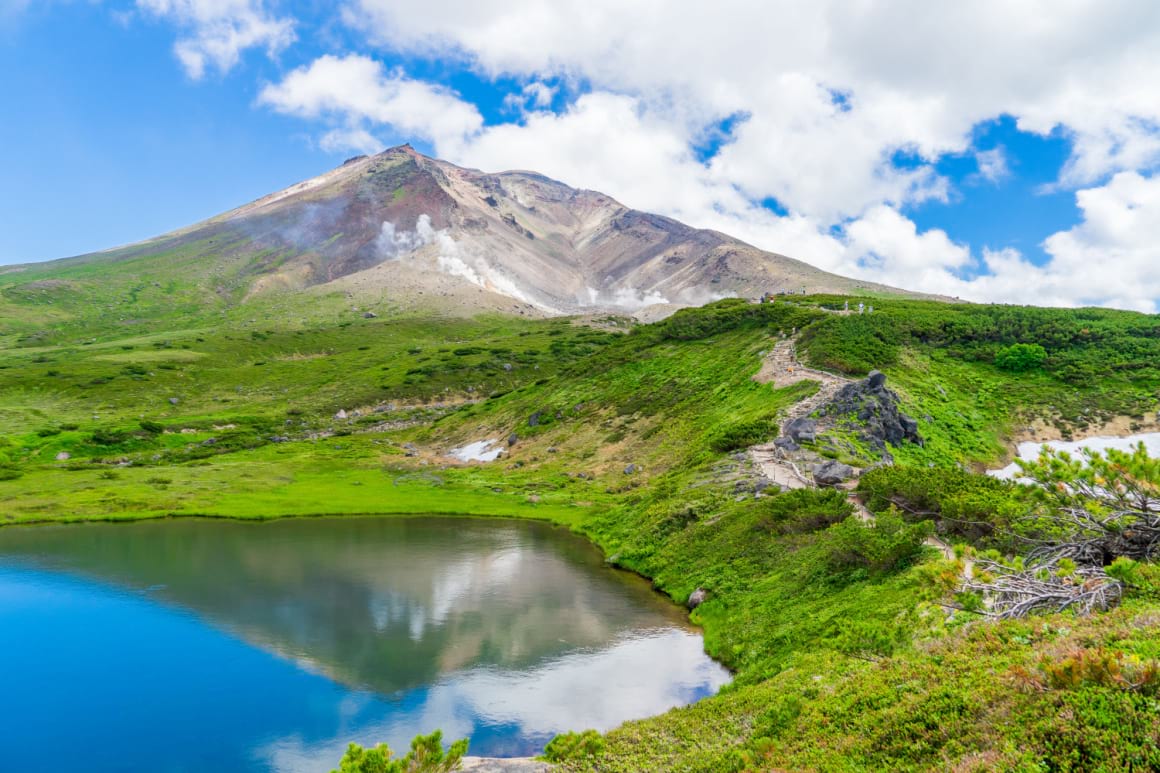
Although say you want something more ‘chill’? For those wanting a slice of busy city living, I recommend visiting the largest city in Hokkaido, Sapporo. Not only is this a great place to make your base while exploring the island’s wonders, but it also has many fun things to do inside its walls.
Sapporo is a mountainous city famous for its beer, skiing, and the annual Sapporo Snow Festival, so to say there is a lot to do here would be an UNDERSTATEMENT. Learn about the rich brewing history or dive deeper into the snowy attractions that make the region so famous.
During a stay in Hokkaido one of the best hostels to stay when traveling solo is Ten to Ten , found Sapporo. They have shared bunk rooms with an option to pick female-only or private rooms, so this is appreciated! They also have a laidback and friendly attitude which is perfect for a solo traveler in Japan which makes it a highlight of a trip to Hokkaido.
Having the right travel apps on hand when traveling solo in Japan will make the whole experience a blast. But what are the best travel apps for going solo?
- Japan Official Travel App. The perfect tool on hand to give you a must-see travel inspiration.
- Jorudan. The official Japan travel app for getting around Japan.
- Hostelworld . The best place for finding hotels at a moment’s notice.
- Japan Wireless. A place to get pocket Wi-Fi or a mobile SIM.
- Couchsurfing . Find a couch to sleep on for a cheap way of travel.
- Dating Apps. Apps like Tinder, Grindr, and Bumble allow you to make friends and date while traveling.
- Ho lafly . An e-SIM application that allows you to download a data-only SIM card without installing a physical card.
If meeting like-minded travellers is your goal, check out the current popular Facebook groups for travelers in Japan. Or, just do it the old-fashioned way and head to a hostel bar and introduce yourself!

Stop stressing about your phone service when you travel abroad.
Holafly is a digital SIM card that works smoothly like an app — you simply pick your plan, download it, and voilà!
Roam around Europe, but leave the roaming charges for the n00bies.
When traveling anyway, it’s important to know how to travel safely . Being solo in Japan is no exception, although it is known that this country is a very safe place to visit with a low crime rate. Travelers shouldn’t get complacent.
I want to share several tips to ensure that your dream trip doesn’t turn into a nightmare. Let’s go.
• When traveling solo in Japan, don’t travel alone at night ; if you must, keep to well-lit and populated areas. This is particularly true if you don’t know where you are or are unfamiliar with the area.
• Japan still has its handful of bag snatchers, so keep your bags tightly closed and buttoned u p, and never let it out of your sight! The same goes for cash; make sure you don’t keep it all on your person at any one time and keep it locked up securely at your hostel or hotel.
• Speaking of cash, it’s also a great idea to have cash on you in case your phone breaks, your card stops working, or you find a shop that only accepts money.
• Female solo travelers in Japan can opt to stay in hostels with female-only dorm rooms or pay a little extra for a private room if they feel unsafe being in shared spaces. However, don’t let these worries ruin the experience of staying in a hostel.
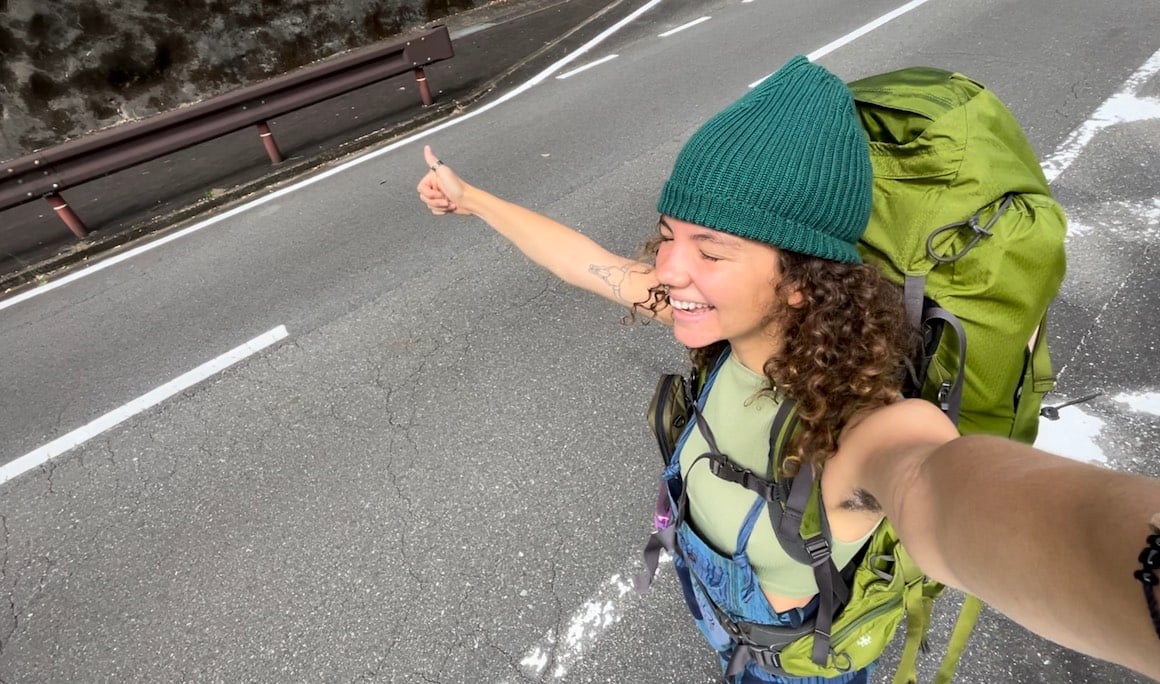
• The public performers of the geisha and maiko don’t like their photos being taken, so don’t even ask for a selfie! Also, as extra respect for their culture, don’t misuse your chopsticks and try to learn the art before you go. Plus, learning Japanese will make the locals love you!
• When you go out, watch your drinks and don’t accept food or drinks from strangers.
The final Japan solo travel tip I can offer is much more general…. Make sure you assign a safety person back home that you tell them where you are going regularly, so if something were to go wrong, they could ring alarm bells.
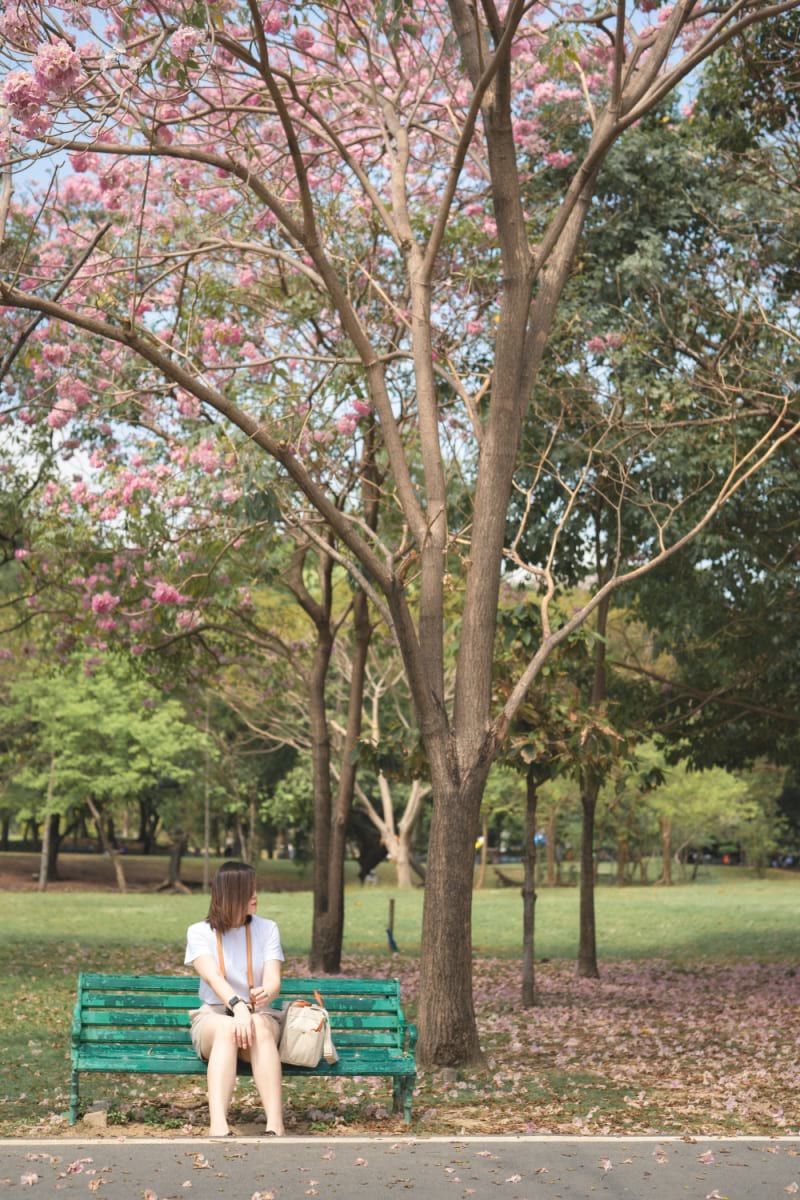
- Get an IC card ASAP. You will quickly find (as have I) our golden ticket to galavanting around
- Japan’s public transport with this prepaid card!
- Buy Yourself a SIM (I particularly love the air sim) or something less finicky like a portable pocket Wi-Fi. I believe that a SIM or portable Wi-Fi is a must when traveling solo in Japan. TRUST ME! You will save a lot on roaming fees and never get lost.
- Get a JR rail pass. I found this pass was a lifesaver. It allows you to see ALOT of cities by train, all for one fee, that will take you all over Japan.
- Polish up your Japanese . Knowing basic phrases in Japanese is a must. I can assure you making the effort to talk with locals in their mother lounge will go a long way!
- Don’t let someone else plan your trip. I find the most fun you have when traveling is when you forge your own path. It allows you to make the most of your solo trip to Japan and see it all!
- Become the lion of your own adventure. Don’t be afraid to get a little crazy and throw aside those set plans if something even more enticing rears its head from behind the tall grass!
- Crime may not prowl in Japan as much as in other places, but… Be aware of what is around you, and don’t do anything too crazy!
- Travel insurance is a MUST. Trust me, it can save your trip. Would you want to be stuck in an airport without a plan B?
ALWAYS sort out your backpacker insurance before your trip. There’s plenty to choose from in that department, but a good place to start is Safety Wing .
They offer month-to-month payments, no lock-in contracts, and require absolutely no itineraries: that’s the exact kind of insurance long-term travellers and digital nomads need.

SafetyWing is cheap, easy, and admin-free: just sign up lickety-split so you can get back to it!
Click the button below to learn more about SafetyWing’s setup or read our insider review for the full tasty scoop.
Meeting like-minded people is one of the best things about solo travel. Here are some of my favourite ways to meet others on the road.
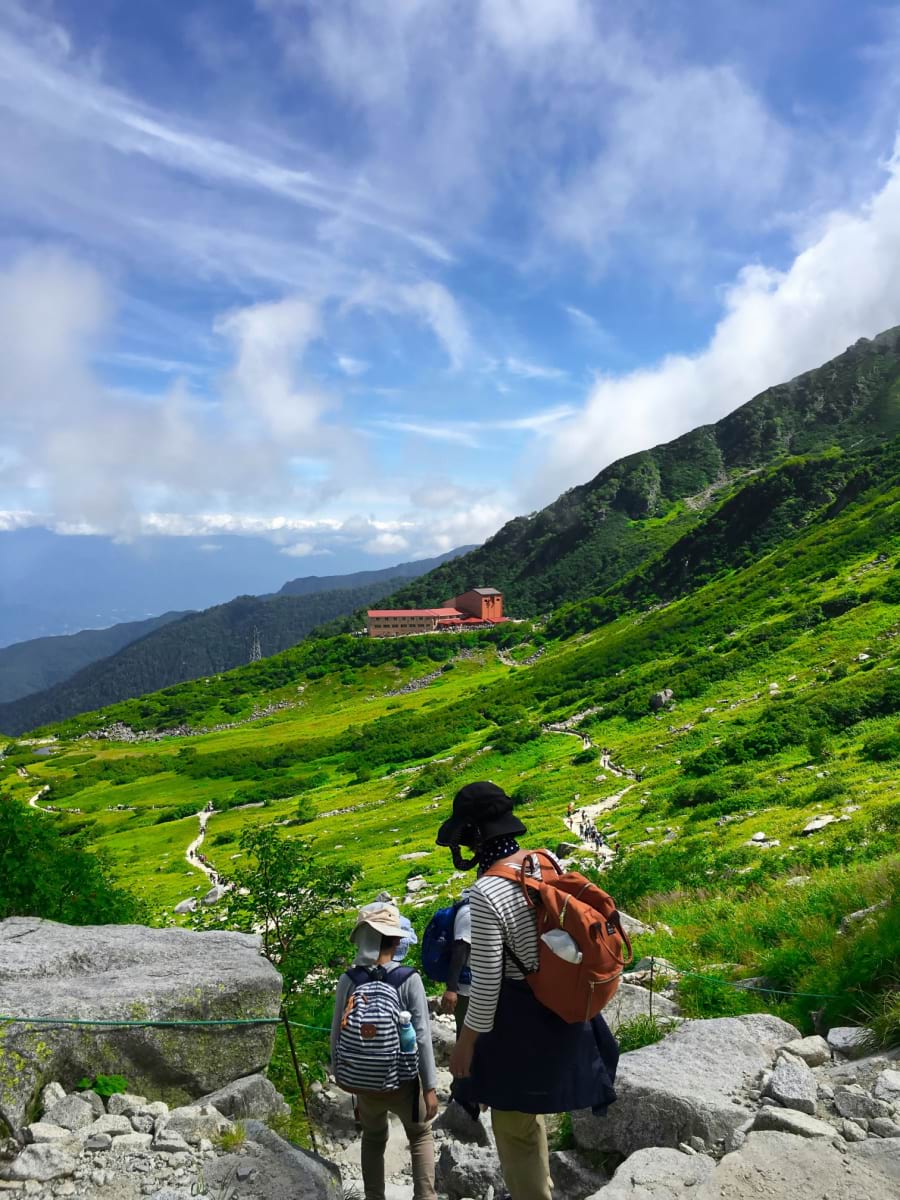
- Keep your eyes peeled for events . I find events a great way to meet people even if solo traveling Japan. You never know what might be going down when you’re in town!
- Make social connections through apps. Whether you are looking for a fun hook-up or are a solo female traveler , I find these offer endless ways to satisfy your social juices. So even you internet lurkers have no excuse!
- Take advantage of short-term memberships. Sure, even if you are JUST in Japan for a few days, there are countless reasons I say why you’d benefit from these. You can work out at a gym or sports club and meet others while getting toned.
- Check out the brilliant Facebook groups. You can bet Japan has many Facebook groups to forge tight networks between foreigners. But what ones? These particular ones are nifty: Japan Travel , Friendly Discussion Group , Destination Japan , Japan Travel Community ?? , and For Foreigners Living in Japan .
- Be open to making friends! The number one thing I would say that will keep you from meeting people in Japan is being shut away. The best advice is to be present, friendly and say yes to every opportunity! You will soon find making friends while traveling solo will be a thing of the past!
Japan is a great solo travel destination with many fun things to do and a rich cultural heritage, making it one of the best places to go on holiday. There are not many terrible things to say about it as a place to go when you are visiting by yourself; however, with these tips we have offered, the small downsides can easily be avoided with a little planning.
Japan highlights the best things about traveling solo as you forge your path and make your own choices. If you want a lazy hot pool, you can do it! If you want to use this trip to improve your language skills and have meaningful discussions with locals in Japanese, you can also do that.
It does live up to its reputation, and if you get the chance, you won’t regret visiting Japan for a solo experience.
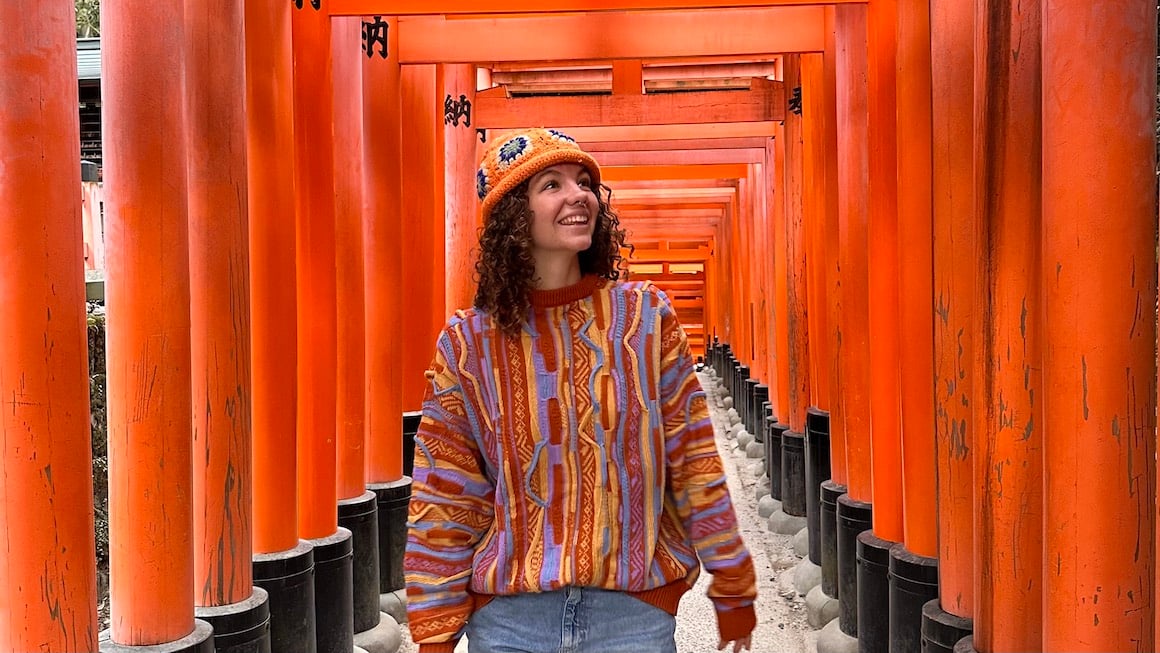
And for transparency’s sake, please know that some of the links in our content are affiliate links . That means that if you book your accommodation, buy your gear, or sort your insurance through our link, we earn a small commission (at no extra cost to you). That said, we only link to the gear we trust and never recommend services we don’t believe are up to scratch. Again, thank you!

Share or save this post

Leave a Reply Cancel reply
Your email address will not be published. Required fields are marked *
Save my name, email, and website in this browser for the next time I comment.
Notify me of followup comments via e-mail.
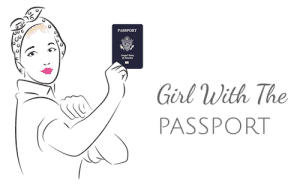
The ULTIMATE Guide to Solo Travel Japan
By: Author Girl with the Passport
Posted on Last updated: February 3, 2024
Categories Asia , Solo Female Travel
HEEY-YOO! And welcome to the whimsical world of solo travel in Japan!
Are you SUPER stoked?
And, BTW, the only correct answer to that question is an emphatic yes since Japan is ALL things wonderful!
You’ve got hedgehog cafes, ramen, sushi, kimonos, REAL LIVE MARIO KART, arcade games, beyond quirky fashion, ancient Buddhist temples, ethereal mountain ranges, capsule hotels , and SO MUCH MORE. Just be sure to learn exactly how to take solo travel photos before you go.
This way you have ample photographic evidence of the wicked awesome time you had.
But to REALLY seal the deal:
You’ll be beyond delighted to know that yes, Japan really does have it’s very own, Wizarding World of Harry Potter!
All my fellow Potterheads out there, feel free to rejoice, and give praise to all things Japanese.
Let’s slowly move away from my slightly random obsession with all things Harry Potter, and towards something slightly more helpful.
Like this SUPER awesome guide to all things Japan solo travel, which you can use to help you plan the perfect Japan 2 week itinerary and introduce you to some of the best places to visit in Japan .
Because in this post, not only will you find a ton of tips on how to stay safe in Japan, but you’ll also learn how to use public transportation in Japan, discover the best time to visit Japan, find out where to go in Japan, and even get a TOTALLY FREE, 7 day Japan itinerary!
Because yes, I too love all things free (Minus diseases, those are never lovely).
So, let’s make like a piece of sushi and ROLL our way into this post about all things Japan solo travel.
Sorry, but for me, wickedly lame puns never go out of style.
This post may contain affiliate links. Please see my disclosure for more information. As an Amazon Associate, I earn a small commission from qualifying purchases.
Solo Travel Japan 101: How to Stay Safe During Your Solo Trip to Japan
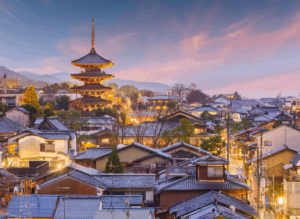
Learn how to stay safe as you solo travel Japan!
Thinking of embarking on some Japan solo travel and planning a 2 week Japan itinerary in Autumn ? Excellent! Because Japan really is one of the safest countries in the world for solo travel (#winning).
BUT it’s not 100% perfect….
Sure, Japan is known for its low crime rates, its next level organization (at the bureaucratic level since nothing is late here…EVER) and polite, friendly people,
That doesn’t mean that you shouldn’t remain vigilant as you solo travel Japan.
Use all of that awesome common sense that I know you have and take the same precautions that you would in any country.
Continue to do super obvious things like avoid walking down dark alleyways alone late at night, keep an eye on your personal belongings, don’t get too intoxicated, etc.
You know, all the usual stuff.
Because like basically every other country on the planet, Japan definitely isn’t immune to organized crime.
Yeah, I had no idea either. But apparently:
The ‘Yakuza’ is well known in Japan and is involved in murder, corruption, petty crime, and overall, high levels of not-so-nice mayhem.
And while it is unlikely that they’ll ever target a group of selfie stick-wielding tourists, it’s still a good idea to be aware of their presence, especially as you do some Japan solo travel in big cities, like Tokyo.
1) Be Prepared…You Won’t Be Able to Read Anything
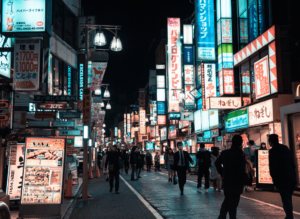
As you solo travel Japan, you’ll quickly see that there is a distinct lack of English signage.
‘It’s cool I’ll just follow the signs’… said no one in Japan.
Well, unless of course, you can actually read Japanese. OBVS.
In general though:
English is NOT universally used throughout Japan, a fact that can make getting around more than a little bit tricky.
Have your Google maps app handy and be prepared to get lost, more than once, during your solo trip to Japan.
Always have the address of your hotel handy (in both English and Japanese), just in case you get lost and need to share this information with a super helpful local.
This should help with that awkward language ‘what the hell are they saying’ barrier.
Always take the directions you are given with a pinch of salt.
Traditional, Japanese culture dictates that it’s better to give wrong directions than admit you are unable to help.
To avoid this mildly annoying possibility, try and ask for directions at a nearby hotel, where it’s highly likely that staff members speak English fluently.
And remember:
In Japan, hotel curfews are actually a THING.
That’s why:
Smaller, family-run accommodations may lockup between 10:00 pm and midnight.
Definitely research those policies BEFORE enjoying a wild night out on the town (Excuse me while I trade in my granny panties for a pair of ultra-rad glow sticks and a Monster energy drink. Because yes, staying up past 10:00 pm really isn’t my “thing”).
When traveling solo at night, always have your route back “home” planned out BEFORE you down some Sake and sing your heart out at a Japanese karaoke joint.
You really don’t want to be doing any serious travel planning when you’re inebriated AF in a foreign country.
And if you do decide to drink:
Never leave your drink unattended since it could easily be spiked while you’re not looking; a trend that is, sadly, becoming all too common in the Tokyo and Kyoto bar scene.
2) Cash is King
Well, you might expect a tech hub like Japan to be card crazy, Am I right?
Surprising though, that is actually NOT the case.
It’s actually quite the opposite.
Do yourself a solid favor and grab some cash before you head out for the day, at least if you wanna avoid being penniless and having to frantically search for an ATM that accepts foreign cards.
Thankfully though:
Most hotels, 7-Elevens, and restaurants all accept cards.
A lot of smaller places won’t.
Be prepared and ALWAYS have a bit of cash handy.
3) You WILL Experience Culture Shock
Because if you’re not, then you better be.
See, things in Japan are done a whole lot differently then they are in the Western world.
From toilets (Take my word on this one, because you will see what I mean) to local taboos like answering a phone call while riding public transportation (Yeah, don’t do this), there are a lot of things about Japan solo travel that you’ll need to get used to.
Don’t freak yourself out about these taboos since Japanese people are really considerate and will take the fact that you’re a visitor into account.
It’s still a good idea to brush up on your Japanese customs/etiquette BEFORE your visit, just so that you don’t cause unnecessary offense.
And if you can:
Always try and avoid doing anything that will draw too much attention to yourself since this is a big no-no in Japan.
4) Unwanted Male Attention
Oh, h ell to the no!
Don’t panic though because it’s really not that bad.
Because thankfully:
Catcalling is not a thing here. Thank f*cking God.
That being said:
And Ladies out there should try and avoid using public transportation during peak hours since instances of sexual harassment and groping are quite common on crowded trains.
To resolve this issue, some cities have started using ladies-only carriages during rush hour, which can be found by following signage along various train platforms.
5) Avoid Common Scams
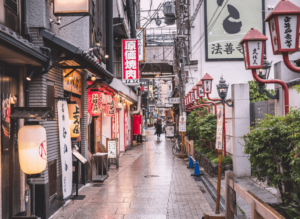
Japan is an incredibly safe country for solo travelers. However, there are some common scams that you’ll need to watch out for.
Well, the main one to watch out for is the ‘Japanese nightclub scam’, especially when visiting well-known nightlife hotspots, like Tokyo’s Kabukicho.
What happens is, a street tout will invite you into a club and shower you with attention and drinks…before swiftly presenting you with a not-so-awesome bill for a few thousand yen.
You will be expected to foot the bill for all those drinks (and for your “new found friend’s” precious time).
And if you refuse to pay?
Well, then things could get a bit dangerous and threats could be made.
To avoid this scam, just walk away. Don’t even respond to anyone who invites you into a club.
Because even the most well-trained touts will take the hint and leave you alone.
You also don’t have to be rude either. Just politely decline and move on.
And when in doubt:
Always remember the age-old adage that if it seems too good to be true, then it definitely is.
6) Watch the Weather
And I’m not talking about the rain.
See, unfortunately, Japan can be prone to freak weather conditions, like typhoons and earthquakes.
Before doing any solo Japan travel, it’s always a good idea to be aware of the seasons and know what to expect from the weather.
So, just a little FYI for you.
Typhoon season usually falls between May and October and peaks in either August or September.
Because earthquakes are quite common in Japan, it’ s a good idea to prepare yourself for an earthquake emergency.
And no, not by practicing hiding under tables (lol).
Just try and familiarize yourself with your hotel’s evacuation policy and always follow locals to designated safe areas if the worst should happen (Because yes, you guessed it. All public safety announcements will be in…Japanese.)
And the rain?
Well, it’s slightly less catastrophic, but sudden downpours are fairly common.
Grab a cheap umbrella from the nearest konbini to keep yourself dry and avoid wandering around like a drowned street rat (Anyone else reminded of Aladdin right now? No? Just me? Right, swiftly moving on).
SOLO TRAVEL JAPAN: EVERYTHING YOU NEED TO KNOW ABOUT PUBLIC TRANSPORTATION!
Japanese trains are known for being some of the most efficient in the world. Yup, just one of many things to look forward to when planning your Japan itinerary .
They can also resemble an unsolvable puzzle if you’re from out of town.
Here are some general transportation tips to help you make the most out of your time in Japan.
1) Getting to the Center of Tokyo from the Airport
Whatever you do:
Do NOT take a taxi from the airport to your hotel.
Not only are they very UN-cheap:
But many taxi drivers actually can’t speak or read English, making communication more than a little difficult (Hello? Google Translate?).
Whenever possible, try and use the city’s monorail system, which connects directly to the subway.
You can quickly, easily, and somewhat cheaply get anywhere in the city that you need to go (You can also take the Keikyu Line directly to central Tokyo).
But, what if I wanna catch an Uber?
Well, Japan has technically had Uber since May 2018.
I still wouldn’t use it as your “go-to” mode of public transportation since it’s not really widely used by locals.
Things may be changing!
Because In 2020:
Tokyo will be hosting the summer Olympics.
And to ensure that spectators can easily move throughout the city, both Uber and Didi (A Chinese rideshare app) will be providing Tokyo with extra transportation services.
As a result:
Uber may become a viable transportation option when traveling to and from the airport.
I wouldn’t bother using it for inter-city travel since the Tokyo metro is WAY cheaper.
But, until Uber becomes more popular:
You can always just download the ‘Japan Taxi app” before you go to Japan.
It has over 60,000 taxis that cover all 47 prefectures of Japan.
You should definitely be able to find a decently priced taxi, no matter where you are in the country!
Standard taxis in Japan really aren’t THAT bad, especially when traveling within cities since using a taxi over short distances is pretty affordable.
And added bonus?
Not only are they EVERYWHERE, but most of them also accept credit cards as a form of payment.
Which is great since I for one am all about minimizing my cash withdrawals and the foreign transaction fees associated with them.
***When traveling in Tokyo, be sure to download the ‘Takkun Tokyo Taxi’ app since most Tokyo-based cabs are on here. However, when using this app, you will be charged a small pickup fee.***
2) Platform Trickery
Just to amp up your level of Japan solo travel confusion:
Transportation services with similar-sounding names tend to be grouped together on the same platform.
Many platforms will have several different categories of trains (e.g. local and rapid trains) arriving within a minute or two of each other.
Which can be insanely confusing since the names of all these trains SOUND EXACTLY THE SAME!!
You should definitely do your research BEFORE you arrive and know the difference between various train services.
Because while informational displays DO indicate the category of the next arriving train, they aren’t always in English!
Making them slightly impossible to read if you don’t speak Japanese.
If you can, try and identify different services using their Japanese names to avoid getting on the wrong train and ending up in some beyond random part of town.
3) The Great JR Rail-Pass Debate
Well, it’s not actually that great, but still.
Because a question that I often get is, “Should I get a JR rail-pass?”
And the not so straightforward answer is that, well, it depends.
JR passes are great for Japan solo travel since they allow you to be flexible with your itinerary.
If you’re not sure where you’re headed or when, then the JR pass is your new best friend, especially if you wanna take a ride on a bullet train.
If you purchase a JR rail-pass , what do you actually get?
- Unlimited use of all JR trains from Kagoshima in the south to Hokkaido in the north.
- This includes the Shinkansen (bullet train) but not the Nozomi or Mizuho bullet trains. And while these trains are technically faster than the Shinkansen, I doubt you’ll actually notice the difference.
- You can also use local JR commuter trains, JR buses, and JR ferries.
- The JR rail pass is also valid on all five of Tokyo’s main railway lines!
The JR Pass is costly, so definitely make sure that you plan on doing at least a few long-distance train journeys, on premium trains, if you want to get the most out of the money that you spent on this pass.
But wait, how much does a JR Pass actually cost? Well, as of winter 2019:
A 7- Day pass costs $273.83
A 14- Day pass costs $436.37
A 21-Day pass costs $558.29
And this is all PER PERSON. So yeah, NOT cheap.
For many travelers though:
Riding on a long-distance bullet train (Shinkansen) is kind of like a right of passage.
So, if this sounds like you:
Then plan on taking at least two different trains per week.
It would actually be cheaper for you to buy individual tickets and not a 7-day JR pass.
Some other JR-Pass tips:
- If you are just staying in Tokyo, then this isn’t the pass for you since local trains in Tokyo are pretty cheap (around $1 per journey).
- You can pay more for a ‘Green pass’ (a first-class pass), but it’s not really necessary since the standard trains in Japan are immaculate.
- Don’t be late!! In fact, be EARLY since Japan takes time management VERY seriously.
If you do decide to get a JR rail-pass, then save yourself some time and buy it in advance ( GET YOUR JR PASS RIGHT HERE, RIGHT NOW! )
You actually HAVE to get your Japan Rail Pass BEFORE you arrive in Japan (AGAIN, to be SUPER CLEAR. You CANNOT get a Japan Rail Pass within Japan!!)
Definitely order it online, prior to the start of your trip, and then just have it delivered to an address outside of Japan.
And once you finally arrive in the country:
You can easily get it validated at any local ticket office.
Tell me more about this ticket validation process.
Before you board a train, you will first need to trade in the voucher that you received in the mail for your actual JR Pass.
And once you have your JR Pass:
Do try and reserve your JR pass train tickets in advance, especially on busy days/peak seasons/weekends since no one wants to get to the station, only to find out that their train is completely sold out!
To do this:
Just write down all the trains that you want to take (or bring a Hyperdia print out with you) and then bring this info to the JR Office at the station.
To make life easy:
Just make your train reservations when you exchange your online voucher for an actual JR pass.
If you don’t have it all figured out, not to worry.
Because the official JR pass website ONLY recommends reservations when traveling between April 27th- May 6th, August 11th- 20th, and December 28th- January 6th.
And the rest of the time?
Well, you can easily board a train without a reserved seat since the designated, JR Pass seats will be clearly marked on the train.
And if you’re still not sure whether the JR rail-pass is right for you, then just run your route through hyperdia.com and compare the cost of one-way tickets with the cost of a JR Pass.
And just go with whichever option is cheaper.
Bonus tip #1!
Most Japanese trains have limited storage space. Therefore, travel light and DO NOT pack everything except the kitchen sink.
Bonus tip #2!
Looking for that Insta-perfect shot of Mount Fuji?
Yeah, I feel you.
If so, then when traveling from Tokyo to Kyoto, ask for a seat on the right-hand side of the train.
Sit here and you are guaranteed to have the best seats for maximum camera snapping action.
And yes, feel free to thank me later.
Other Ways to Get Around as you Solo Travel JAPAN
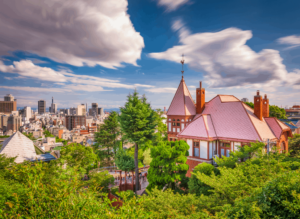
Japan is an amazing country. But sometimes using its transportation system can be more than just a little tricky.
1. TOKYO METRO (THE BEST WAY TO GET AROUND TOKYO)
The Tokyo subway system consists of two interconnected networks, the Tokyo Metro and Toei Subway .
Trains and subways in Tokyo also run between 5:00 am and 1:00 am daily, are religiously on time, and arrive every 3 mins during peak hours (Peak hours are on weekdays between 8:00 am and 9:00 am and shortly after 5:00 pm. Morning rush hours also tend to be more concentrated and heavier than evening rush hours).
Oh, and girl, (and guys) don’t forget…
- Swipe your passcards both on the way in AND on the way out. The digital screen is awesome and will display the remaining balance on your card.
- Most train stations have multiple exits- so remember to take the right one!
- Consider the “Tokyo Subway Ticket“ which provides unlimited use of all subway lines. Pick it up at either Narita Airport or Haneda Airport for the ultimate freedom during your Japan solo travels.
- Queuing is an art form here and you will be expected to do so on the platform. Just be prepared because there will be a mad dash to nab a seat during rush hour.
- The most useful line in Tokyo is the JR Yamanote Line, which is commonly referred to as the “Tokyo Loop Line” or just the “Loop Line.” You can use your Japan Rail Pass on this line.
- Another great way to pay for trains and subways in Tokyo is with a prepaid Pasmo or Suica card since it is WAY cheaper than buying individual tickets.
Thought trains were complicated?
Well, think again!
Because Japanese buses are a little bonkers!
- You need to board the bus from the middle and not the front
- You will collect a plain, slip of paper as you board the bus. This piece of paper will have a number on it. And…TADA, this is your bus ticket
- The electronic board displaying ever-changing numbers at the front of the bus may confuse you! But, please use it before you hop off the bus since the cost of your bus fare will be displayed under your seat number, AKA the number that is printed on your ticket
- The driver will expect you to deposit both your bus fare and your ticket, into a designated collection box BEFORE you leave the bus.
You could always just skip all this confusion and get a Pasmo card instead.
Remember though:
This card is only valid in the Tokyo/Yokohama region and is sort of like a Metro/Travelcard/Oystercard for Tokyo’s metro/buses.
Now, if you do purchase one:
Try and put at least $30 on the card since this will cover quite a few journies.
All you need to do is tap your card when you board a bus (or metro), and then again when you get off.
See! Super simple!
And while buses are great to use in small cities and in the countryside, I would avoid using them in major cities, like Tokyo, since there’s a lot of traffic and it will take you forever to get anywhere.
I would also avoid using buses over long distances.
EXCEPT IN KYOTO!
Yeah, don’t ask me why but it’s actually cheaper to use the bus than the train in Kyoto.
Some of the different types of buses that you’ll find in Japan are:
- Route buses (which operate within cities and towns),
- Highway buses (which operate between large cities),
- Limousine bus (which operate between the airport and a major bus station)
And out of all of these different types of buses, you’ll probably end up using route buses the most.
But, are they really worth using?
Well, like with all forms of public transportation, they have their own set of pros and cons!
A major pro is cost.
Because you can definitely use buses as a low-cost alternative to the train.
For example:
You can catch a bus from Tokyo to Kyoto, for just 1,599 JYP ($15) which is WAY cheaper than the train.
Buses are also insanely comfortable and come with wicked awesome, reclining seats (Some ever have full-on SALONS!!).
However, one GIANT con is time!
Because the above journey will take you over 7 hours by bus and just 2 hours and 15 minutes by train.
A lot of long-distance bus journeys also take place overnight, which is great for saving money, at least if you’re comfortable doing this alone.
If you wanna save money, take the bus.
If you wanna save time, take the train.
Because it really just depends on which one of those things is more important to you.
***PSST: Don’t discount sightseeing buses since The Chuo Bus from Sapporo to Shikotsu and the Toya Lakes is a great way to see some of Japan’s most amazing scenery.***
3) Plane Travel
Thinking of cutting down on your travel time by flying across Japan?
While it is doable, it’s definitely not the most cost-effective way of traveling through Japan.
When traveling between cities, I’d still recommend the train.
For longer journeys, like the one between Fukuoka and Sapporo, I’d consider flying since it’s the fastest way to travel.
And if you do decide to fly:
Try using smaller, domestic airlines, like Skymark and Jetstar Japan, which usually have cheaper fares.
You can also check with the airline operator of your international flight (BEFORE you arrive in Japan) and see if they offer discounted domestic fares to passengers who fly on their international routes to Japan.
Yup, something that is definitely worth checking out.
We all know that Japan is an archipelago.
And as such:
Ferries are a constant form of transportation between islands.
- Some smaller islands, like Naoshima can only be reached by ferry
- Ferries can be useful for traveling among Japan’s four major islands. But, information on ferry routes (including schedules and fares) is almost always in Japanese ONLY!
- If you ‘re interested in traveling by ferry, instead of train, then the ‘Japan Ferry Pass 21’ is the sea equivalent of the JR Rail pass. Covering 14 routes over 21 days, it’s about a third of the cost of the rail pass is just $192 per person.
But is it right for me?
Well, if your route/time schedule allows for ferry travel, then this can be a viable transportation option.
Just plan on making at least two trips to some of Japan’s other islands if you want the Japan Ferry Pass 21 to be cost-effective.
I would ONLY recommend this option if you’re looking for a slower form of transportation.
Because if getting to your final destination QUICKLY is more important than the journey itself, then this isn’t the option for you.
***Another added benefit of traveling by ferry is that you can save money on overnight accommodations, something that is never cheap in Japan! Plus, ferry cabins are usually relatively comfortable, modern, and clean.***
WHEN IS THE BEST TIME OF YEAR TO SOLO TRAVEL JAPAN?
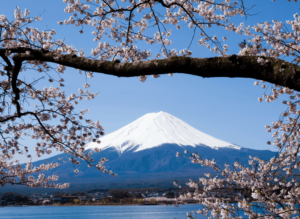
Any time between March and May (minus Cherry Blossom season) or between September and November is probably the best time to solo travel Japan.
It’s never really a bad time to do a bit of Japan solo travel.
You will definitely get a very different vibe from the country, depending on when you visit.
If at all possible, try and plan your visit between March and May (Minus cherry blossom season, which varies depending on where you are in the country) or between September and November, when weather is mild, prices are at their lowest, and when crowds are not as crushingly huge.
If you do decide to visit during the spring, psych yourself up for it because this is THE most famous (and busiest) time to visit Japan.
Why?
Two words. Cherry blossoms. Obvs.
Travel to Japan during this time of year and expect to be bombarded by hordes of tourists and locals who are all out celebrating the beautiful blossoms during hanami (blossom viewing) picnics.
If you’re not fazed by epic levels of heat and humidity, then summer is a great time to visit Japan.
That’s because:
There are a ton of festivities that take place during this time of year.
From dazzling fireworks displays to al fresco munching on street food, summer is definitely a fun time to visit Japan.
Can’t deal with the crushing crowds of spring but still want to experience some of Japan’s insane, natural beauty?
Then considering visiting during autumn, AKA the season of red and gold leaves.
Japan’s countryside will come alive with vibrant colors, making it the perfect time to get outside and do a bit of hiking.
What if you’re really a snow bunny at heart?
Then Japan totally has you covered!
Just head up to Hokkaido in the North and enjoy some beyond epic mountain ranges that will make any snow-loving traveler drool.
Because yes my friends.
Hokkaido really is known as the ‘Swiss Alps of Asia’ for a reason and is the perfect place for any solo traveler who is desperately searching for ALL the Christmas feels (which are sometimes lacking in other parts of Asia TBH).
WHAT TO SEE IN JAPAN: 10 AMAZING PLACES TO VISIT
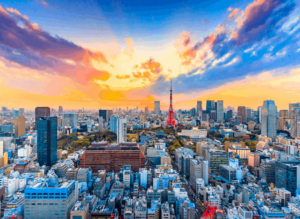
Tokyo Tower and the iconic skyline of Japan’s amazing, capital city.
You know those images that you have in your head of futuristic skyscrapers, neon lights, quirky fashionistas, video-game obsessed individuals, and over-the-top, one-of-kind activities?
I’m 100% referring to owl, goat, and hedgehog cafes, as well as a real-life version of Mario Kart (FYI: You can also do this in Osaka AND Kyoto).
You’ll find all that and more in Tokyo since this modern AF city really does sit at the beating heart of contemporary Japan
That being said though:
There are also a ton of surprisingly traditional aspects of this city too, like sumo wrestling in Tokyo .
Tokyo really is a place full of contradictions.
When you visit Tokyo, be prepared to battle your way through crazy busy pedestrian crossings, to be overwhelmed by the sheer size of this place (Tokyo is truly MASSIVE), and fall in love with the city’s beyond divine 7-Eleven egg sandwiches (strange but true).
If you swan dive headfirst into Tokyo’s fast-paced lifestyle, all this awesomeness can result in total sensory overload.
From robot restaurants to amazing, panoramic city views atop the Tokyo Metropolitan Government Building in Shinjuku (free and deffo worth it!), this crazy busy city really does have it all.
Try and take it easy while enjoying all the sights, sounds, and flavors that this vibrant metropolis has to offer.
You are forbidden (do you hear me? LOL) from leaving this city without doing the following.
- Visit the Akihabara district for arcade games, ‘cute’ cafes, and delicious ramen.
- Walk across the famous Shibuya Crossing- if you dare!
- Wear some of the city’s fashions in Takeshita Street, Harajuku (Gwen Stefani eat your heart out)
- Try the soup dumplings and espresso tonic in Yokohama Chinatown (SO GOOD!!)
- Visit the CupNoodle Museum and make your own.
- Get your real-life Mario Kart on while driving through the crazy streets of Tokyo, in a go-cart, and dressed as your favorite Mario character. Slightly mental but hilarious. You also will need an international driver’s license for this so plan accordingly because they are strict about this.
- Explore the colorful Digital Arts Museum TeamLab Borderless.
Tokyo also gets extra brownie points from me since eating alone here is easy and uber-tasty too!
Solo diners can happily, and not-so-awkwardly, eat at the bar of any Sushi, Tempura, and ramen joint in the city.
Yes, my friends, we call this living the dream.
And if you really want to live it up, you could even take an amazing Mt. Fuji tour from Tokyo .
Nine Hours Woman Kanda (Budget) – The Shinjuku and Ginza neighborhoods are perfect areas for solo travelers to stay. However, If you’re not careful, accommodations here can be pricey. And that’s where Nine Hours Woman Kanda comes in. With quirky, fun, and totally bonkers rooms, that start at $55 per night, this capsule hotel is the perfect place to stay in Tokyo. And while these establishments are traditionally for men only, many capsule hotels are now opening their doors to women (sorry but no men allowed), making this a fantastic, extra-safe, budget hotel option for any of my fellow, solo female travelers out there. I also love that this place has a cozy, minimalist vibe about it and is conveniently located near both Tokyo Station and the popular, Akihabara area.
Shibuya Granbell Hotel (Mid-range) – Want a stylish, boutique hotel that is also affordable? Then check out Shibuya Granbell Hotel near Shibuya station. Rooms here start at $110 per night and have this incredible, pop-art, minimalist design that is beyond cool. All rooms here also include free WIFI, flat-screen TVs, complimentary breakfast, and bike rentals, for an additional fee.
Want your Japan solo travel to be served to you with a side of geishas, temples, zen gardens, and cobblestone streets?
If so t hen Kyoto is for you!
Sure, Kyoto has its fair share of ugly high rise buildings, like any other major city.
It won’t take long for an intrepid solo traveler like yourself to venture past those less than stellar buildings and discover vast mountain ranges, as well as various aspects of traditional Japanese culture.
While you’re here, you cannot miss out on:
- Temples. Kyoto is brimming over with temples!! So, choose the temples that you visit wisely. Also, try and visit first thing in the morning to avoid large crowds. My personal faves include Kinkaku-ji (Golden Temple), where you can actually get your fortune from a vending machine (SO Japan), and Kiyomizu-Dera Temple .
- Visit the iconic red torii gates of the Fushimi Inari Shrine.
- Take a morning stroll through the Arashiyama Bamboo Grove .
- Visit the home of a geisha in Gion and partake in a traditional tea ceremony/learn how to make matcha tea.
- Explore the beauty of Yasaka-jinja at night.
And if you’re hungry (because we all know that I always am):
Then be sure to try some of Kyoto’s famous ‘ okonomiyaki’, a crispy, made-to-order pancake that is served to you with your choice of fillings.
Simple, yet oh so tasty!
And if you really want to get your foodie swerve on, then stop by Menya Gokkei (Northern district) for some authentic, beyond delicious, Japanese-style ramen.
You can also hit up any I chrian (AKA 24 hour booths where you can consume ramen totally by yourself) in town since this is basically any ramen loving, introverted traveler’s dream.
Slurp away my friend because you totally deserve it!
Now, for the best gyozas in town, visit the one and only Sukemasa . Not only is the food here delicious, but you can get a couple of gyozas, miso soup, rice, and pickles for less than $7.
Talk about an epic steal!
Tanaka-ya (budget) – With rooms that start at $52 per night, T anaka-ya is a cute, budget-friendly, traditional, Japanese-style homestay that features tatami-mat flooring, paper sliding doors, and Japanese futon bedding. It is also conveniently located in Gion Miyagawa-Cho, making this the perfect home base for which to explore Kyoto’s iconic old town.
The Sekura Terrace (Mid-range) – Conveniently located near Kyoto Station, Sakura Terrace is an awesome place for any solo female travelers out there to stay. I mean, not only do they offer a comprehensive ‘ladies plan’ that includes meals, but rooms here are bright, start at just $84 per night, and feature floor-to-ceiling windows, flat-screen TVs, and free WIFI. There’s also an on-site, coin-operated laundry facility, just in case your clothes are starting to look a bit dingy.
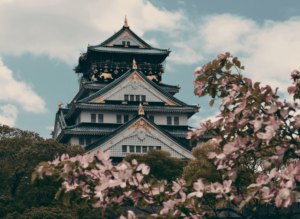
The old-world charm of Osaka Castle, one of the best places to solo travel Japan.
Another sprawling neon city:
Osaka is a mass of bright lights, amazing food, and affordable prices, at least when compared to its big brother. Tokyo.
So where to begin?
Well, food is ALWAYS a good place to start. Especially since I like eating just as much as I like breathing.
Osaka is home to some SERIOUSLY amazing vegetarian cuisine.
It was so good that I basically wept tears of joy.
If you’re looking to get your foodie swerve on, then devour some udon noodles at Azuma Udon, the city’s oldest udon restaurant.
If you’re total veg like me, then hit up Green Earth, a delicious vegan-friendly eatery with a set lunch menu, that features rice, a main dish, salad, a vegetable side dish, and soup, for just $8.
If you actually wanna do something other than eat ALL of your feelings, then definitely:
- Ride the Ferris wheel on top of the Don Quixote store in central Osaka/. Trust me on this, it is the very definition of a one of a kind experience!
- Check out the bright lights of Namba. In particular, Dōtonbori is the most popular street in Osaka for viewing neon lights and animated signs, with the Glico Running Man being an Instagram fan fave (#justsayin’).
- Discover the quirkier side of the city in Shinsekai District, which is filled with arcade games and food halls. You can also enjoy some epic, panoramic city views from the top of Tsutenkaku Tower .
- Visit Osaka-jo castle . Nestled inside the city walls, this building is one of the oldest structures in the area and sits within a picturesque park (It’s also an extra stunning place to visit during cherry blossom season).
Toyoko Inn Osaka Umeda Higashi (budget) – If you’re on a budget, then business hotels can be a great option for you while you solo travel Japan. And one of the best in the area is Toyoko Inn Osaka Umeda Higash i . Now, while luxury it most certainly ain’t, it’s still clean, well equipped, and centrally located (It’s literally a 4-minute walk to the subway). Rooms here also start at just $30 per night and feature super snazzy things like WIFI, flat-screen TVs, mini-fridges, and tea/coffeemakers (Talk about the posh life! LOL). Complimentary breakfast is also available, as is access to a coin-operated laundry facility since, I mean, well, who doesn’t like clean clothes?
Hotel Monterey La Soeur Osaka (Mid-range) – Perched atop a high-rise building that overlooks the O River, this contemporary hotel has an American, art deco style to it. Yet, it somehow retains a distinctly Japanese vibe with warm rooms that start at $89 per night. This hotel is also just a 7-minute walk from the train station, and features an on-site French restaurant, tea room, bar, and gorgeous, next level divine, spa!
So, why should Nara be on every solo traveler’s bucket list?
Because of the local deer that bow for food!
In truth though, Nara definitely has way more to offer visitors than a chance to feed cute little deer.
Nara is full of historic, Japanese treasures, making it the perfect place from which to indulge your inner culture vulture.
Because, believe it or not:
Nara was actually Japan’s first capital city and is home to a wealth of charming, ancient buildings that stand as a remnant of the city’s high profile past.
This also includes a variety of different UNESCO world heritage sites like the Hall of the Great Buddha (But, more on him later.).
This historic city is easily accessible from both Kyoto and Osaka and makes the perfect day trip from either city since both places are just an hour away from Nara by train.
While you’re in this ultra-fab metropolis, do not miss out on:
- The Daibutsu-den (Hall of the Great Buddha) at Todaiji. It’s arguably one of Nara’s most famous sights (besides the deer of course.) and features a 15-meter tall, golden Buddha that sits inside the world’s largest wooden building. Impressive much? I think so!
- Feeding some local deer in Nara deer park. Yeah, they are pretty friendly and will wait until the food is offered to them. So don’t worry about them stealing your lunch (The monkeys of Asia should take note!)!
- Eating some ‘Nakatanidou’, a famous Japanese rice cake. And while the ‘yomogi-mochi’ may sound gross, it’s flavored with mugwort plant and is actually super tasty.
- The Kofuku-ji Temple, which was established in 669 AD and has a great deal of cultural significance due to its links to the Fujiwara family.
Guest House Oku (budget) – For the ultimate trip down nostalgia lane, book a stay at the small, but cute, Guest House Oku. This charming little boutique hotel has spotless rooms, which start at $30 per night. And while bathrooms here are shared, the real appeal of this place lies with the friendliness of the hostess, Yoko, who goes out of her way to make guests feel truly at home and like they are having an authentic, Japanese experience. This hotel also serves amazing food, is incredibly safe, and is conveniently located near the center of the city.
Centurion Hotel Classic Nara Station (Mid-range) – Hallelujah! Finally, a hotel with a reasonably sized room that doesn’t inadvertently feel like a tomb. Because let’s be honest, spacious hotel rooms are a rarity in Japan. But, somehow, Centurion manages to deliver spacious, warmly decorated, comfortable rooms that are all still just a 5-minute walk from the nearest train station. Rooms here also start at $97 per night and include sofas (feel free to “oh” and “ah” at will), flat-screen TVs, tea makers, mini-fridges, WIFI, and air purifiers. And for an added dose of Japanese quirkiness, try using their coin-operated laundromat to freshen up your clothes before you leave the city.
PSST: Kyoto and Osaka are both a short distance from Nara and have WAY more options when is comes to accommodations. So, if you’re struggling to find what you’re looking for, then you can always book a stay in either city and just visit Nara as part of a day trip.
5. Takayama
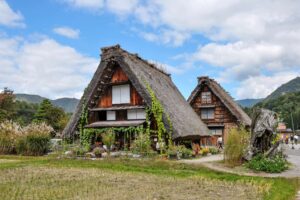
Some of the quaint, Japanese-style architecture that you’ll find in Takayama, Japan, at the base of the Japanese Alps.
Takayama might just win my award for the prettiest place EVER and is easily one of the best hidden gems in Japan .
Because no doubt:
This city if flippin’ gorgeous!
Well, it’s located on the edge of the Japanese Alps and is far less touristy than many other places in Japan.
And you know what I say to that?
Crowd free is the way to be! Because Takayama is basically THIS introverted traveler’s idea of a total dream!
Throw in some exquisite, traditional wooden houses, signature red bridges, and brightly colored shrines, and you may never wanna leave!
Other things that you MUST do while you’re here include:
- Go for a morning stroll around Sanmachi Stree t. It’s located at the center of Takayama Old Town and is where you’ll find many of the city’s lovely, traditional wooden buildings (perfect for the insta feed of awesome).
- Explore local, morning markets like Jinya-Mae ( a small market that is located in front of the Takayama Jinya building ) and Miyagawa ( a market that sits alongside the Miyagawa River).
- Eat some ‘mitarashi-dango’ , or rice balls grilled in soy.
- Cycle through Shiroyama Park , a part of the Japanese countryside that sits just five minutes outside the city. Also, be sure to hike to the Takayama Castle Ruins and admire the incredible mountain top views from here.
- Visit Cafe DON for Coffee and Cake!
The Country Hotel (Budget) – At just $35 per night, this hotel is definitely no-frills. But, The Country Hotel still has everything you need for a comfortable stay (Think comfy beds, WIFI, air conditioning, etc.). They’ll even provide you with complimentary green tea and cozy slippers, both of which are clearly essential items for any wicked awesome hotel stay. This place also gets bonus points for its primo location since it sits right across the street from JR Takayama Train Station .
Takayama Olan Hotel (Mid-range) – This modern meets traditional, Japanese-style hotel has a fantastic, central location (Just three minutes from Takayama train station) and offers guests comfortably designed rooms that start at $123 per night (think luxe seating areas, posh dark wood furniture, free WIFI, tatami floors, futons, etc.). There’s also a buffet-style, onsite, restaurant where you can enjoy a delicious breakfast, for a small fee. However, the real highlight of any stay at the Takayama Olan Hotel is their stunning, open-air, roof-top, hot spring, which provides you awe-inspiring, panoramic views of the nearby, Hida Mountains.
So, you’ve probably seen all of those amazing photos of a beyond colorful ship that is gently gliding past Japan’s immortal, Mount Fuji.
And if not:
Well then, feel free to look it up on Insta right now. I mean, I can wait…not-so-patiently since a climb up Mt. Fuji Japan is the stuff that travel dreams are made of.
The mountainous town of Hakone actually overlooks this picture-perfect lake, which is locally known as Lake Ashi.
This town is also located inside the Fuji-Hakone-Izu National Park and is just a short (ish), 1.5-hour bullet train ride away from Tokyo.
Additionally:
This place is known, the world over, for its picturesque, hot springs resorts (AKA onsens in Japanese).
In addition to its wealth of onsens, Hakone is also home to various world-class art museums, historic Shinto shrines (like the aptly named, Hakone Shrine), and expansive mountain ranges.
This tiny town makes for the perfect, weekend escape from the chaos of Tokyo.
You CANNOT leave this place without trying the black eggs!
They’re black because they’ve been infected with some rare strain of Bubonic Plague.
This local delicacy, kuro tamago (black eggs), is created by cooking chicken eggs in the sulphuric hot springs of Owakudani – a volcanic crater that was formed over 3,000 years ago.
Apparently:
Legend says that eating just one black egg will extend your life by more than seven years.
To procure these little fountains of youth for yourself, just stop by Kurotama Shop , in Owakudani, for some of the best black eggs around!
***While many people tend to visit Hakone as part of a day trip from Tokyo, I would advise against this. I mean, it’s doable but it just makes for a really LONG, really RUSHED day. So, if you have the time, definitely stay overnight in Hakone and enjoy your visit at a more relaxed pace.***
Hakone Tent (Budget) – If you’re looking for a unique hostel that is both reasonably priced and cozy, then this rustic guest house is for you. Once a Japanese ryokan in its former life, this building has long since been transformed into a comfortable, light, airy, and modern hostel that is just a stone’s throw away from Gora Station. Beds here sit inside six-person, single-sex dormitories, start at $30 per night and include tatami mats and futons. Private rooms with wood floors are also available here, as is WIFI, towels/sheets (for a fee), and access to an onsite cafe/bar. While staying at Hakone Tent, you’ll also get full access to their on-site, gender-segregated, hot spring facilities (Can I get a whoop, whoop? No? Okay, swiftly moving on).
Hakone Honbako (Mid-range) – Set along a quiet, tree-lined street is Honbako Honbako, the hotel of your literary loving dreams. See, ’honbako’ literally means ‘bookcase’ in Japanese. Which is a perfect name for this boutique hotel since It is brimming over with books, books, and, oh yeah, more books! I mean, the library here is outfitted with floor-to-ceiling bookcases that contain more than 12,000 different titles. Add in comfortable, modern rooms (which start at $173 per night) with hardwood floors, spacious beds, private outdoor baths (with geothermal water), minifridges, and tea/coffee makers, and you have the perfect place to stay in Hakone. Breakfast is also included with the price of your stay, as is access to an on-site cinema and the hotel’s gender-segregated hot springs.
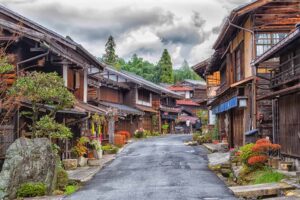
Some of the historic, Edo period houses that line the Nakasendo trail between Magome and Tsumago in Japan.
Why do I love Tsumago with my whole heart?
Because it’s basically like this perfect little, tiny AF village (it’s so small that you can literally walk from one end of town to the other, in about fifteen minutes flat), that feels like a total blast from the past.
And I mean that in the BEST possible way.
Because while you’re here, you’ll find no cars during the day, no phone lines, and no power cables.
You’ll discover a charming, Edo Era village that is overflowing with historic ambiance from the area’s wealth of traditional, dark-wood, lattice-front homes. All of which are particularly amazing at either dusk or dawn.
While you’re here though:
Also, be sure to visit the Tsumago Castle grounds for some amazing views of the city.
The castle itself was actually demolished hundreds of years ago, but the panoramas remain and are truly spectacular to behold.
And while the scenery here is truly next-level amazing:
You just cannot leave without visiting the Kotoku Temple , a traditional Buddhist temple built in 1500, and Wakihonjin, a charming history museum that showcases various artifacts from the area.
But enough about Tsumago’s ambiance already!
Because we need to talk about the REALLY important things in life…like FOOD (glorious food)!,
While I myself am not a meat eater, Tsumago is actually known for a traditional, local delicacy, that is supposedly a “must try” if you’re a real carnivore at heart.
Head on over to Ryokan Fujioto and enjoy some local beef, which is served inside a magnolia leaf and cooked right in front of you, on a table-side, hibachi grill.
Shimosagaya (Budget) – Nestled in the mountains, small, private rooms at this charming Minshuku (AKA family-owned guest house) all start at $63 per night. And while it’s a simple building, accommodations here are comfortable, quiet, and basically all things zen. Guests here can also enjoy some made to order, home-style, Japanese cuisine, as well as access to private, on-site hot springs, making this the perfect retreat for any weary solo traveler.
Hotel Green Plaza Karuizawa (mid-range) – Unlike the budget option above, this hotel has a more contemporary feel about it. It also sits adjacent to a trendy shopping mall and is just a short walk away from Karuizawa Toy Kingdom (A perfect place to visit if you’re missing the distinctly Western vibes of home). Rooms here also have casual decor and include wood-framed beds, as well as a traditional, Japanese-style dining area with tatami mats and short-legged tables. Breakfast and dinner are also included with the price of your room (they start at $168 per night), as is access to the hotel’s free train shuttle, indoor/outdoor bathhouses, a chapel, a tea room, and various on-site restaurants.
8. Hiroshima
Ask nine out of ten people about Hiroshima, and they will immediately think of August 6, 1945; that horrific day when this Japanese city became the site of the world’s very first atomic bomb attack.
In spite of this city’s devastatingly sad past, it has become a vibrant, cosmopolitan place that is brimming over with wonderfully beautiful messages of hope and peace.
As a solo traveler, you should definitely spend at least a few nights here, wandering through the area’s many idyllic, tree-lined boulevards and chatting with some of Hiroshima’s friendly, laid back locals.
No trip to Hiroshima would be complete without a visit to Hiroshima Peace Memorial Park.
It’s a hauntingly beautiful, sprawling green space that is filled with various fountains, statues, memorials, and ruins, all of which stand in memoriam of the 146,000 people who tragically lost their lives on that fateful day.
And of particular note here is Genbaku Dome.
Once the Hiroshima Prefectural Industrial Promotional Hall (originally built in 1914), this abandoned building is now all that remains of the site where the first atomic bomb was dropped.
This edifice stands, exactly as it did after the bombing, as a powerful reminder of the devastating effects of nuclear weapons, and as a symbol of hope for a future that is free of this type of technology.
Hiroshima is also home to several other, slightly less, incredibly heartbreaking attractions, like the Shukkei-en Japanese garden, and Hiroshima Castle , a beautiful, historic fortress that was built in 1590 and that is surrounded by a moat.
And for some of the best eats in the city:
Head down to Hiroshima Station and explore downtown Hiroshima, where you can try everything from okonomiyaki (PSST: Okonomi-mura is the best place in the COUNTRY to try this s avory, Japanese-style pancake) to oysters (Yakigaki-no-hayashi is a great, local seafood restaurant where you enjoy some great udon sets as well as raw oysters) to Gelato (Okay, I know this isn’t a traditional Japanese food, but Polar Bear really is the best place to go for gloriously fresh and delicious gelato).
Hotel S-Plus Hiroshima Peace Park (Budget) – Sitting near the Hiroshima Peace Park, (the clue’s in the name guys!), this well-located hotel has functional, single rooms that come fully equipped with WIFI, a TV, a mini-fridge, and a tea/coffeemaker. Starting at just $31 per night stays here also include a complimentary, continental breakfast, as well as access to, YOU GUESSED IT, a coin-operated laundry facility.
Top Hiroshima Condominium 2 (Mid-Range) – This super snazzy hotel is less than three years old and is a mere 20-minute walk away from Hiroshima Peace Memorial Park (Which is good because the more you walk, the more calories you burn, and then the more you can eat! HOORAY!). Rooms here also start at $130 per night and include a private balcony (For prime city views here people), a queen-sized bed, a sofa, a TV, and a full kitchen, as well as an ensuite bathroom with free toiletries! Yup, nothing but the sweet, sweet, luxe life for me.
9. Kanazawa
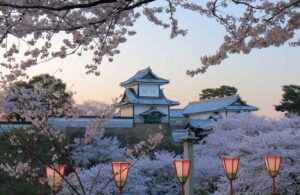
Beautiful Kanazawa Castle in Japan, amidst a sea of cherry blossoms.
Often nicknamed “ little Kyoto” (and for all the right reasons):
Kanazawa is jam-packed full of fun things to do, activities that you can easily add to any, Japan solo travel itinerary.
But, don’t just take my word for it.
I mean, Kanazawa Castle and Kenroku-en Garden alone are considered to be some of the country’s top attractions!
Kanazawa isn’t JUST about iconic castles and ethereal green spaces.
Walk through this city’s various Edo-era districts (like the Higashi Chaya district, which is where you’ll find many historic teahouses with geisha performances) and you’ll discover a multitude of fascinating museums (like the 21st Century Contemporary Art Museum ), ancient Japanese buildings (like Seisenkaku Villa), charming local markets (check out Omicho Ichiba Market , which is just as good as the one in Tokyo, only A LOT less crowded), historic temples (like Ninjadera with all its secret doors and hidden traps), and quaint little handicraft shops.
And while we’re on the subject of markets:
Just around the corner from Omicho is Curio Espresso & Vintage Design , a great little coffee shop that sells fab espresso and delicious sandwiches.
A trip here is absolutely ESSENTIAL to your overall wellbeing and happiness while in Kanazawa.
The owners here are SUPER friendly, and just an overall great source of local information about the city.
Sharin (Budget) – Complete with vintage bicycles out front, Sharin is just a 10-minute walk from Kanazawa Railway Station and offers guests easy access to the 21st Century Museum of Contemporary Art. And while this hotel does have several dormitories for you to stay in, there’s really no need. Because f or a mere $23 per night, you can have your very own, private room, complete with an uber-spacious double bed (Can you say bargain, party of one?). See, dreams really do come true!
Libre Hosai Kanazawa (mid-range) – You want space? Then I’ll give you space! 42m² of space to be exact! Because believe it or not, Libre Hosai Stay Kanazawa lets you rent out an entire apartment for just $132 per night. So, think private shower, a spacious bathtub, and a snazzy AF little kitchenette where you can pretend like you “cook”. Now THAT’S what I call the LUXE life indeed. This place also conveniently located just 800 meters away from Omi-cho Market and Oyama Shrine.
10. Koyasan
Tucked away, to the south of Osaka, is Koyasan, a huge Buddhist temple settlement that lies (both figuratively and literally) at the very heart of Japanese Buddhism.
More commonly known as Mount Kōya:
This small, secluded, temple town was first developed around the Shingon Buddhism headquarters here.
And lest you think I’ve started speaking in tongues:
Shingon Buddhism is actually an important sect of the religion that was first brought to Japan in 805 AD, by Kobo Daish.
You’ll find a wealth of Buddhist temples within this tranquil, heavily forested, mountain town, as well as the site of Kobo Daishi’s mausoleum and the start/endpoint for the Shikoku 88 Temple Pilgrimage.
To really get the most out of your visit, I’d HIGHLY recommend doing an overnight stay in a local, Japanese Temple.
Known in Japan as Shukubo, which literally translates to ‘sleeping with the monks’, this is a fantastic way for any solo traveler out there to really engage with Japanese culture and get an authentic, Japanese Buddhist experience.
Live the dream and feel free to eat, pray, and love your way through the day, just like a local monk.
And if you get a sudden attack of the late-night munchies:
Then stroll on over to Kameya for some udon noodles and seaweed in vinegar.
I pinkie promise, both of these dishes are absolutely TO DIE FOR!
Guesthouse Fuki Juku (Budget) – Honestly, the location of Guesthouse Fuki Juki could not be any better since this place is literally SURROUNDED by local temples! There’s also a traditional Japanese garden on-site, as well as comfortable rooms that include both free Wifi and a delicious, complimentary, American-style breakfast. And while rooms here are a bit sparse (You’ll also have to use a shared bathroom, which I hate), it’s all good when you’re spending just $51 per night.
Yochi-in (Mid-range) – Yochi-in is the perfect place for visitors to engage in various, temple-related activities like meditation, morning prayers, sutra copying, and tracing of Buddhist deities. All Japanese-style rooms here also start at $143 per night and feature tatami (woven-straw) floors, futon bedding, a TV, fan, and heater. And while bathrooms are shared with other guests, the hotel’s central location more than makes up for this fact since this place is within easy walking distance of both Koyasan Reihokan Museum and Koyasan Choishimichi ( two must-see attractions while you’re in the area). Plus, their on-site restaurant really is the very definition of amazing.
A 7 Day, Japan Solo Travel Itinerary!
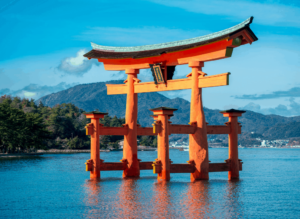
Use this 7 day Japan itinerary to explore some of Japan’s top attractions, like the Itsukushima Shrine pictured here.
So, per usual, I’m just gonna start by being totally honest here.
And honestly:
There is just no way in HELL that you’ll be able to see all of Japan in 7 days.
Yeah. Sorry, but it’s just not possible.
At least, not without totally burning yourself out or getting approximately NO sleep.
But, t hat being said:
Thanks to Japan’s nifty railway system/JR pass, there are still LOADS of different places that you can see during a 7 day Japan itinerary.
If you’re down and r eady to get started, then let’s start with the bustling city life of Japan’s one and only…Tokyo!
Toyko (3 Nights)
Day 1 – west tokyo.
I would recommend spending at least 4 nights in Tokyo, just so that you can really experience everything this city has to offer.
Remember before when I said that Tokyo was HUGE?
Well, I was NOT lying.
Which is why 4 days in Tokyo is definitely ideal.
But, if you’re short on time:
Then two days is still a decent amount of time to spend in this city and it will help you get a feel for this amazing place.
To start your whirlwind trip through Tokyo, head to the famous Shibuya district.
Because once you’re here:
You’ll be able to cross the street, just outside of Shibuya Station, at one of the busiest intersections in the WORLD!
It’s beyond chaotic and crazy, but it’s also definitely all things Tokyo.
While you’re here, do try and visit some of the insanely quirky shops that can be found in this area.
A trip to the vibrant Harajuku neighborhood, which is brimming over with colorful street art, quirky vintage clothing stores, young people who are wearing only the FUNKIEST of fashions, and fun cosplay shops along Takeshita Street .
And while there are a ton of different things to see and do here:
No trip to Harajuku would be complete without stopping for a giant cotton candy at Totti Candy Factory and visiting the world-famous, Meiji Shrine.
Don’t forget to do as the locals do and snap some pics in a local ‘Purikura. AKA, a popular Japanese-style photo booth where you can take photos, decorate them as you like, and then print them off on sticker paper.
You should also probably stop by Kawaii Monster Café while you’re here, which is a wonderfully weird, themed cafe that features colorful, themed rooms, casual eats, fun cocktails, and regular, live performances.
Head back to the Metropolitan Government Building for an amazing FREE view of the city, but not before stopping at Ramen Road for a quick dinner.
Then finally:
Finish your evening off with a trip to Park Hyatt Tokyo, where you can create your very own ‘Lost in Translation’ moment.
You can always skip the serenity of the park and just straight up, live la vida loca at ’ Timeout ’ instead; a jazz/blues bar where the music never really stops.
Because once the live music ends, that’s when the karaoke begins…
Day 2 – East Tokyo
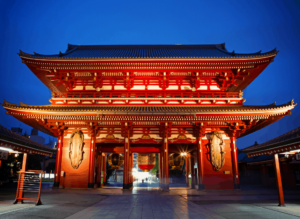
On day two, you’ll see the more traditional side of Tokyo and visit Sensoji Temple, an ancient Buddhist temple in Asakusa.
We want ultra-modern yesterday.
Let’s switch things up and go a bit more traditional today.
And the best place to do that?
Why East Tokyo of course! It’s a bit more historic and slightly less chaotic than the other side of the city.
Once you’re here, feel free to explore top, Tokyo attractions like Sensoji Temple (it’s the super famous, ancient Buddhist temple in Asakusa), Tsukiji (there’s even a viewing area here for the popular tuna auction. LOL) and Toyosu Fish Markets and Ueno Park ’ s Museum District.
Now, once you’ve done ALL OF THAT:
Finish the day off on a more modern note in Akihabara, a Tokyo neighborhood that is known for its plethora of awesome arcade games.
You can also get some rather delicious ramen here, and enjoy some gorgeous, panoramic views from atop Tokyo Sky Tree (and sorry, but the views here are VERY un-free).
Day 3- Tokyo Day Trip To Mount Fuji or DisneySea
Today there are two different options available to you, depending on what you’re into.
Take a train from Tokyo Station to Hakone, for some beyond STELLAR views of Mount Fiji (The awesomeness of the views largely depends on the weather, so make sure that you visit on a nice, clear day).
Along the way:
You should also visit the exquisite floating torii gate at Hakone shrine, explore the many walking trails here, and indulge your inner Jack Sparrow with a boat ride across the lake.
You could always go for option two and check out the iconic, DisneySea theme park ,
BEFORE you start violently screaming at me and throwing your laptop across the room in disgust, hear me out.
Because in truth:
DisneySea isn’t just ANY theme park. It’s actually one of the most lavish theme parks in the entire world.
Which is why it’s a super fun, super safe place for solo travelers to go.
It’s also strangely Japanese, making it at least a mildly cultural experience.
Locals adore it. Like, it’s a national treasure level adore it.
A day spent here will not only elevate your inner child to near euphoric states of happiness, but you’ll also get to experience a more modern side of Japanese culture.
Which is a total win-win, at least in my humble opinion.
***For the love of God and all that is HOLY, if you do decide to visit DisneySea, then do yourself a favor and PLEASE BUY YOUR TICKETS IN ADVANCE ! LIKE RIGHT NOW! Trust me on this. You do not want to get there, just to spend hours waiting in line for a ticket. This is a very un-fun way to solo travel Japan.***
Kyoto (3 Nights)
Day 4 – kyoto.
Is riding in a bullet train on your Japan bucket list?
Then prepare to tick that item right off your list. Because you’re about to jump aboard the Shinkansen and travel all the way to Kyoto.
If you can:
Try and catch an early morning train since the trip will take around two hours.
AND REMEMBER:
Be sure to sit on the right side of the train so that you can get that iconic shot of Mount Fiji!
While you may be tempted to rest after your early morning train ride, let’s be honest here.
You really DON’T have time for that.
So, embrace the mildly exhausted explorer within and get out there!
If you’re not exactly sure where to start, then you can always try a walking tour , which is a great way to quickly and easily experience all that Kyoto has to offer..
If walking tours are SOOO NOT your thing, then you can always visit Nijo Castle and Kyoto Imperial Palace instead, both of which are incredibly impressive attractions(to say the very least).
And if you’re hungry:
Be sure to stop by both Nishiki Market and Pontocho Alley for some of the best food in the city.
Whatever you do though:
Do not leave without devouring an uber-yummy, ‘okonomiyaki’ pancake!
NOM, NOM, NOM.
Day 5 – East Kyoto
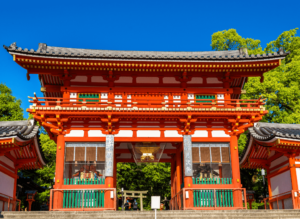
Beautiful Yasaka Shrine in Kyoto, Japan.
Like with Tokyo:
You could easily spend more than 3 days in Kyoto as you solo travel Japan.
With this Japan 7 day itinerary, you’ll easily be able to see most of Kyoto’s top attractions.
Start your day off right, with a visit to some of the city’s most spectacular shrines.
And while Yasaka Shrine and Maruyama Park are ALWAYS beautiful, they are exceptionally stunning during cherry blossom season and autumn, when you have the vibrant, fall foliage in the background.
You can always embrace your inner tourist instead (make sure to have those selfie sticks and fanny packs handy) and follow the popular “temple route” through Kyoto.
This path starts at Kiyomizudera Templ e , follows a GIANT, straight-line through the foothills of Kyoto’s Higashiyama Mountains, and takes you to some of the most stunning temples in the area .
And once you’re totally templed out:
Head to Kyoto’s Gion district for some evening Geisha spotting (PSST: Kyoto also has a seriously awesome night walk through picturesque Gion, Kyoto’s geisha district. But the best part? This tour costs only $12 per person! Yup, money well spent as you learn all about kimonos and the unique history of geishas)!
You could even p artake in a traditional tea ceremony or have dinner at Sukemasa, which is known for serving some of the BEST gyozas in Japan!
Day 6 – Kyoto West
It’s time to head west and visit the city’s famous Arashiyama and Sagano districts.
And I know it sounds totally weird:
But, you MUST start your day with a 7-Eleven egg breakfast sandwich.
Because yes:
They really are THAT good!
Once the HANGRY beast within is properly satiated:
Head to the Arashiyama Monkey Forest.
You REALLY will want to get here EXTRA early, just to avoid the crowds.
Because this ultra-famous bamboo grove really is a total tourist hotspot.
But, if you’re someone who is prone to crowd phobia:
Then you can always visit Okochi Sanso Villa and Jojakkoji Temple instead, both of which are great off-the-beaten-path attractions.
If this is your first solo trip to Japan, then you may want to stick with some of the area’s more well-known attractions.
End your day at Fushimi Inari Shrine, which features over 4 kilometers of winding walking paths that are filled with quaint AF torii gates.
This is definitely one of Japan’s most popular attractions (AKA crowded as hell), but so beautiful and totally worth a visit.
Try and arrive around dusk so that you can experience the beautiful sunset amidst slightly less enormous hordes of tourists.
Day 7 – Leave Kyoto and Head Home
I f you can afford it:
Save yourself some time and fly home from Kansai International Airport in Osaka and not Narita or Haneda in Tokyo.
This airport is infinitely closer to you and will help you maximize your short time in Japan.
If this option isn’t cost-effective, then you can always explore the local food and shopping scene right around Osaka Station, before boarding your train to Tokyo
The train ride takes AT LEAST two and a half hours.
And once you do arrive in Tokyo:
You’ll want to give yourself plenty of time since it will take you about an hour to get from the train station to Narita Airport when using the Narita Express (tickets also cost about $36 per person).
Conversely:
If you’re flying out of Haneda Airport, you could always take the Keihin-Tōhoku Line of the subway, towards Kamata, and then transfer to the Airport Monorail at Hamamatsuchō Station.
It should take you about thirty minutes to get from Tokyo Station to Haneda Airport.
And there you have it!
You have just concluded your awesome, chaotic, whirlwind, once-in-a-lifetime trip to Japan.
BRAVO (insert copious amounts of jazz hands here)!
AND NOW…SOME FINAL THOUGHTS ON SOLO TRAVEL IN JAPAN (JERRY SPRINGER, EAT YOUR HEART OUT!)
So while this Japan solo travel guide is basically OVER, there are just a few more things I want to remind you of, before we say a fond farewell.
First rule of Japan solo travel? Always book your hotels WELL IN ADVANCE since accommodations tend to fill up CRAZY QUICKLY!
Do NOT, I repeat, DO NOT wait until the last minute to book all of your hotels.I know you may think that you’ll score some wicked awesome, last-minute hotel deals.
But I promise you won’t. In fact:
Do this and you’ll have a hard time finding ANYWHERE to stay. Like at all. Especially during peak travel seasons.
Okay, now it’s time for some good news!
Because SURPRISE! The power outlets in Japan are EXACTLY the same as the ones in North America.
No need to add any annoying power adapters to your Japan packing list!
Oh, and if you’re a theme park addict, you’ll definitely want to book your tickets to Disneyland Tokyo and Universal Studios (featuring the Wizarding World of Harry Potter, for all my fellow Potterheads out there!), WELL in advance.
You’ll also want to do a bit of research and look at some crowd calendars on Google, just to figure out what time and day to visit (And since you’re alone, feel free to skip all of those ridiculously long lines and just hop on the single rider line instead).
Alright cool kids:
That’s enough from me! I am so blowing this popsicle stand of solo travel awesome.
In all seriousness, that really is all she wrote!
So, until next time:
Continue to live the solo travel dream like the TOTAL rockstar that I know you are!
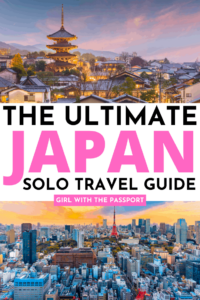
Micamyx|Senyorita
Saturday 11th of January 2020
Solo Travelers who will come across this post are lucky! So comprehensive!
I've been to Japan twice - Tokyo in 2014 to visit my best friend who was based there at that time and Nagoya side in 2015. I plan to go back this year to do a bit of solo backpacking. This is a good guide. Cheers!
girlwiththepassport
Monday 13th of January 2020
Thanks so much for reading Mica and have an AMAZING trip!
Just waiting for the Olympics year to end so I can visit Japan! Super handy and detailed post and as always I love your small details! Super curious to try out these black eggs for which I had never heard anything!!
YES! When you get to Hakone give them a try and let me know what you think. Thanks for reading!
This was so helpful + informative! I’m planning to visit Japan solo soon so this was amazing to read!
So happy to hear that and thank you so much for reading!
Privacy Overview
Solo Travel to Japan (Tips and Etiquette)
By: Author Guest author
Posted on Last updated: November 24, 2023
Natoya from the travel website Her Lifestyle Travel is guest author with her advice and tips on traveling to Japan alone. Afraid to travel to Japan by yourself? Fear no more! Natoya’s got you covered with this handy Japan solo travel guide that will give you the knowledge and confidence you need to tour around Japan on your own.

Solo Traveler’s Guide to Japan
I’ve had my share of meltdowns while solo traveling around the world, but one of my memorable meltdowns was less than an hour after getting off my flight to Tokyo, when I stopped at a convenience store to buy a bottle of water.
Like any other country, there were a variety of drinks to choose from: You got your mineral water, flavored water, and energy water, etc.
But it was all in Japanese (I know, duh, right?). Which one was the right one?! I just needed some spring water!
The thing is, I didn’t have this massive freak out over the fact that I couldn’t choose the right drink, I freaked out because I was wondering: how the heck was I going to travel around Japan solo if I can’t buy a bottle of water?!
I’ve had more freakouts like that than I can count (I lived in Japan for two years), and this is why I’m writing this guide. I don’t want you to freak out over something as simple as a bottle of water!
This is a list of tips from one gaijin (foreigner) to another on what you need to know about solo traveling in Japan.
I’ve visited about a dozen prefectures, and it doesn’t matter if you’re partying it up on a karaoke binge in Tokyo or getting sun-kissed in Okinawa, these tips will help you survive your first solo trip to Japan and have an awesome time.

In Japan cash is king
Although Japan is known for its futuristic gadgets and seen as technologically forward throughout the world, most restaurants only accept cash. Instead of going to a currency exchange kiosk, I recommend you open a checking account with no foreign transaction fees, like Capital One 360. Then when you arrive in Japan, you can withdraw money from a 711 ATM. The fee is around $3-$4.
These three phrases will save you
These three Japanese phrases will help you in many different situations so please memorize it:
Sumimasen: Excuse me. It’s used the same way we would use excuse me in English. You will most likely use this one the most. When in doubt…use sumimasen!
Arigatou Gozaimasu: a formal way of saying thank you.
Gomenasai: I’m sorry.
You should learn as much Japanese as you can before arriving in Japan, but seriously, these three phrases will get you far.
Don’t underestimate the Japanese public transportation system
Using public transportation in Japan is the best way to get around any prefecture, as it’s cheap and reliable. Don’t be smug like I was and underestimate the complexity of the metro! It’s confusing even for someone like me that lived in Japan for two years.
There’s the rail that runs long distances outside the city, and the metro that runs within the city. The rail is more expensive than the metro since it goes further.
Please watch this video from the Youtube channel Tokiyuyu about using Japanese public transportation, it’s a lifesaver! Download the Hyperdia app to help you get around Japan. You can use it for free for 30 days.
And FYI, trains do not run 24-hours a day in Japan. There’s the last train called “shuden”, which stops running a little before 12 am.

Getting around Tokyo Japan is easy when you know how!
Flying domestically is more affordable than the shinkansen
I know you probably want to try out the famous Shinkansen but that sucker is expensive! The Shinkansen is meant for Japanese businessmen, not for budget travelin’ solo travelers like you and I!
Use domestic budget airlines like Peach, Jetstar or Vanilla Air if you plan on traveling around Japan. Also, make sure you read your baggage allowance.
Just like budget airlines in Europe, you will have to pay for just about everything (seat selection, meals, baggage).
Get used to Mottainai
Mottainai which roughly translates to ‘what a waste’ or ‘how wasteful’, sums up the Japanese views of environmental conservation and overall respect for the environment. Respecting the environment by not wasting, destroying or abusing, but reusing and recycling.
You might hear someone exclaim mottainai! In response to someone that’s wasting food by throwing it away. When you understand this aspect of Japanese culture you will understand how to interact with Japanese culture.

Think of the group: ‘wa’
Another aspect that you need to know to survive Japan, is understanding ‘wa’, which roughly translates to harmony.
Creating harmony within the group and conforming with the group you are a part of. Japanese people strive to make things work for the group.
Understanding ‘wa’ and ‘mottainai’ will help you make sense of things when navigating throughout Japan and help you make smart decisions.
Keep the volume down in public
While you will most likely see women putting on a full face of makeup or someone drinking a cold one, in Japan it’s inappropriate to have a conversation in certain public places — in particular on public transportation.
This is where ‘wa’ will come in for you as a solo traveler.
You can’t talk on the phone, and if you do need to speak to someone, you should whisper.
And I know this seems harsh, but it’s quite nice that the trains are always silent, a perfect time to take a cat nap!

Take a solo trip to Japan and visit the Sensoji Temple located in Asakusa Tokyo
Taking taxis is a luxury experience and you’ll pay for it
Taking a taxi in Japan is like no other taxi experience because it is a fancy-schmancy experience. The taxi drivers wear white gloves, and they can open and shut the passenger doors right from their front seat!
It’s an interesting experience, however, you’ll pay with your right kidney for that ride. Unless you miss the last train, I’d skip using a taxi in Japan.
Get used to bowing
Get ready to start bowing for the first time in Japan! Even if you are a foreigner you are expected to bow.
The length of the bow and the degree of your bow depends on the importance of the person you are bowing to. 90-degree bows are for officials like medical doctors, police officer, or your boss.
But for the average joe you encounter while solo traveling in Japan, a 30-degree bow will do.

Tokyo Gion Matsuri festival lasts the whole month of July. An annual event since the year 869
Call Japanese people by their last names
This one surprised me when I moved to Japan, because other than Ghana, Japan is the only country that I’ve visited where it’s rude to call someone by their first name.
When you are addressing both Japanese men and women, put san after the person’s last name. For example, Yamaguchi San.
Proper etiquette when dining in Japan
Here are few etiquette rules that are a must follow when dining in Japan.
Say cheers: Never drink first, wait for everyone to get their drink. After everyone in your group has their drink then you can cheer by saying kampai.
Wait for everyone to be served: this is pretty much in every culture but it’s just so important in Japan. And if you’re up for it, before eating say: itadakimasu (let’s eat!).
No need to tip: There is no tipping in Japan.
You might need to take your shoes off: I’m sure you’ve heard that you should take your shoes off before entering a Japanese person’s home but you might have to do it in some restaurant too.
You will be given an indoor pair of shoes to wear in the restaurant. There is usually a shoe cubby space in the restaurant.
A few chopstick dos and don’ts: Never stick your chopsticks in your food standing straight up, never lick your chopsticks, and never use your chopsticks to take food out of a common dish.
If you have a common dish use a clean pair of chopsticks, or you can turn your chopsticks around and use the opposite end to take out food.
Slurp away!: Slurping your noodles is not rude in Japan. Slurping not only helps you to easily eat your bowl of steaming hot noodles, but it also lets the cook know that you are lovin’ it! So prepare to hear people slurping when dining in Japan.
Don’t be alarmed at the noise in the bathroom
Don’t be alarmed by the white noise you will hear when using the bathroom. No, it’s not a toilet monster coming to get you!
The white noise you will hear is used to cover up the sounds of people using the bathroom if you know what I mean…Every bathroom stall has a button that you can press to start the white noise.
Get used to people wearing medical face masks
Don’t be alarmed if you’re walking through the streets of Tokyo and see people wearing medical masks.
When Japanese people are sick and don’t want others to get sick they wear the masks (remember ‘wa’). They even wear a medical mask if they want to avoid getting sick.
Bring a small towel
While you’ll find that most restrooms in Japan to be spotless, you’ll find that many public restrooms don’t have paper towels or a hand dryer.
That’s why you will see Japanese people pulling out a small towel to wipe their hands, or even to wipe away sweat.
Japanese sizes might not fit
If you are over a size 8 in shoes (Euro size 38), and above a size 12/L in clothes, you have to make sure you pack everything you need for your solo trip to Japan.
As Japanese people tend to be smaller in overall size, there just isn’t a market for larger sizes. When I lived in Japan, I had to buy all my shoes online!

Imagine seeing Mt Fuji from your airplane seat – Fuji-san is Japan’s tallest mountain and an active volcano
Things that are hard to come by in Japan
Fluoride toothpaste, tampons, and strong deodorant are hard to come by in Japan.
I usually recommend that solo travelers pack light and buy what you need when you run out, but it’s hard to find these unless you go to an international store.
What not to wear in Japan
While it’s okay for women to wear super short skirts, wearing sleeveless shirts will get you stares. For some reason, it’s a faux pas to show you’re arms as a woman.
Honestly, I don’t get it, and it’s not fun during the steaming hot summers, but I just follow this cultural norm.
Don’t hand Japanese people money directly
When you are making a purchase, don’t hand the money directly to the cashier. You place the money on a small container and the cashier will pick it up.
The cashier will place your change and receipt there as well.
Make sure you stand on the correct side
I get this one confused when I have not been to Japan for a while.
When you are standing on an escalator or walking up a staircase in Osaka you should stand to the right, giving people room to pass by if they need to.
While in the rest of Japan you should stand on the left. No one really knows why it’s different in Osaka, but it’s this unspoken rule everyone follows.
When you’re on time, you’re late
Finally, the one thing that will make you lose friends in Japan quickly, is being late. If you make friends while solo traveling in Japan, and plan on meeting them at a certain time, arrive 15 minutes earlier.
I promise you that if you arrive 15 minutes earlier you will see the person you are meeting waiting for you. When you are on time, you are already late.
These are the most important things you need to know to have a stress-free solo trip to Japan.
As a solo traveler, it’s difficult navigating through a new culture on your own because you have to figure everything out by yourself, and sometimes, you don’t know — what you don’t know.
Use these tips to have a fabulous time in Japan, make friends, and enjoy all aspects of Japanese culture.
You may also enjoy reading 13 Best Places in Southeast Asia for Solo Travelers or 2-Days in Melaka Malaysia Itinerary
Save it on Pinterest!

About the author: I’m Natoya – a Brooklyn girl here to help newbie solo travelers take their very first solo trip abroad. I created my travel blog, Her Lifestyle Travel to help travelers learn the skills they need to affordably travel, and to gain the confidence to keep traveling solo…whenever and wherever the heck they want!
Tuesday 4th of October 2022
Thanks for this valuable information. I wish I had it when I was traveling for work. Now I want to go back to Japan and travel like an informed guest!
Monday 19th of October 2020
Really interesting insights - the more I hear about Japan the more intrigued I get - it's certainly somewhere I'd like to visit in the future. Thanks for sharing this 🤗 the 'no tipping' will make a nice change!!
Susan Moore
Hi Cherryl, Thanks for your comment, and happy to know you found the info helpful. There are so many great reasons to visit Japan! Hope you do get to visit in the future. Cheers, Susan
Ryan K Biddulph
Saturday 23rd of March 2019
Super interesting how cash is king there. I would see credit cards being popular, such a fast exchange of dough. But I reckon debt is frowned on in Japan.
Totally surprised me too! I didn't think about the debt factor, maybe so. But I guess they are trying to move towards cashless payments before the 2020 Olympics in Tokyo. Maybe I should visit Japan now to see how it's going :)
The Solo Female Traveler’s Guide to Japan
08/25/2023 by Kristin Addis Leave a Comment
Japan has long intrigued travelers with its unique culture, delicious and healthy food, beautiful countryside, and fascinating capital city, full of technological wonders. It’s easy to see why people adore it.
For the solo traveler, Japan may not immediately come to mind as a great choice. It’s true that the country’s language and cultural differences may take a little getting used to, but after traveling to Japan, I feel that it’s perfect for solo female travelers. Here’s why:
Table of Contents
Solo Travel Safety
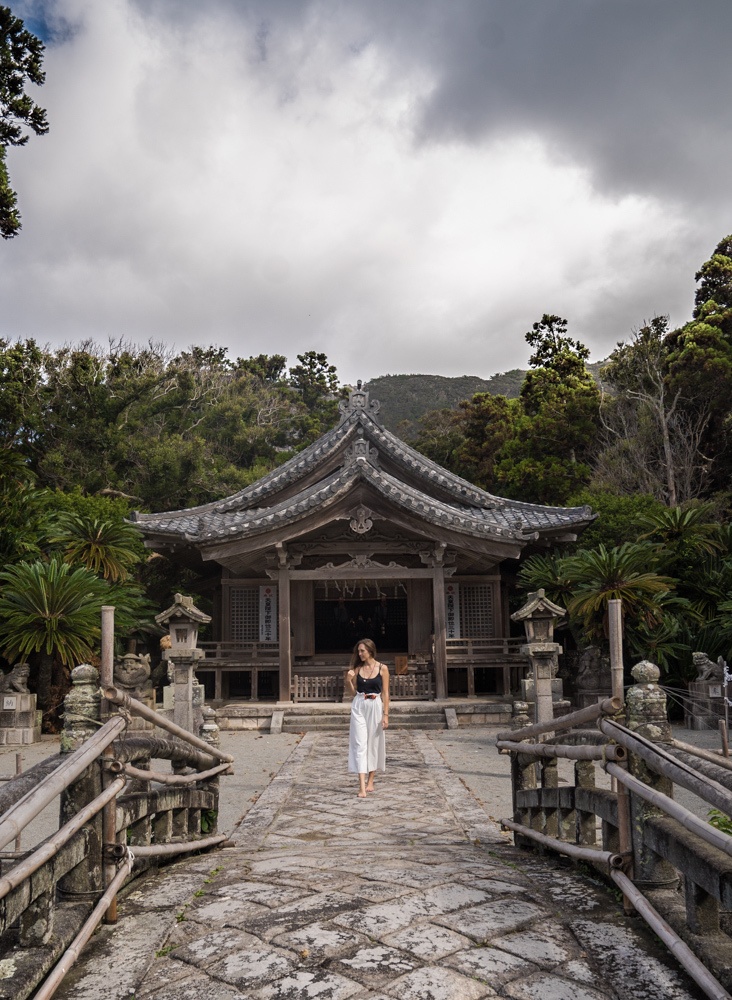
Japan is safe according to the Global Peace Index, which ranked Japan as the ninth most peaceful country in the world based on violent crime, safety and security, and other peace factors. You may even notice Japanese people saving seats at restaurants by placing their wallets on the table. Talk about trust!
That said, solo travelers should be aware of sexual harassment in Japan. While I haven’t had any issues, it’s worth noting that some big cities offer women-only subway cars as a result. Although this may not be the perfect solution, it gives you the option to be on the cautionary side.
Solo Traveler Friendliness
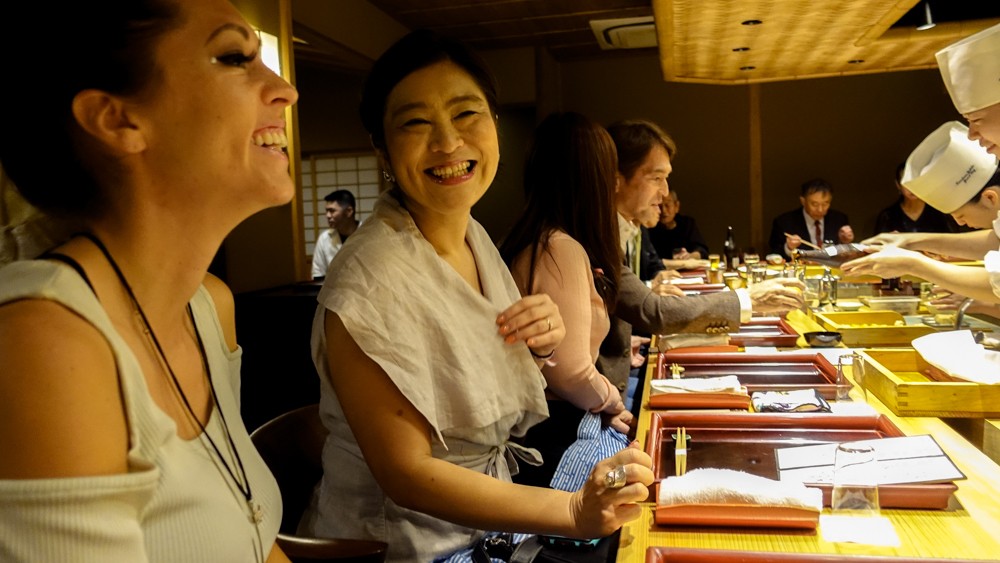
Hospitality in Japan is so strong that they even have a term for it: omotenashi . Even when I had trouble navigating big cities like Tokyo, people were helpful and kind. That said, there are language barriers.
While learning a few words in the local language always go a long way, I find that Google Translate is often my friend. There’s also so much that context can lend to a situation. Thankfully, many accommodation options in Japan offer Mi-Fis so that you can navigate more easily, though it might also be a good idea to grab a business card for your hotel in case you get lost.
Without a good grasp of the language, you can still find friends through different meetup groups and tours. If you want to get a glimpse of the local lifestyle, the Couchsurfing app is popular throughout the country and a great way to get to know locals.
Finally, Japanese society understands that many people go through their day alone. One of the best things about traveling to Japan was their acceptance of solo life as the norm. Restaurants with single-style seating are common throughout most cities. Solo travelers can even take advantage of “capsule hotels”, which offer a private bed for those wanting a more budget option. Japan’s acceptance of solo life was a refreshing break from its stigma in the United States.
Things to Do

Japan is an island country with countless things to experience as a solo female traveler. To give you a mental image, Japan is divided into 47 areas called prefectures, which belong to one of eight regions. Although the country brings in over 30 million tourists each year, cities are still your best bet as a solo traveler if you want to meet others. They’re convenient transportation points and make a great base if you want to venture into the more rural parts of the prefecture.
Here are a few cities where solo travelers can especially find a ton of things to do:
Let’s start with the main event: Tokyo. You could spend your whole trip in the country’s capital if you want to, though it can be a little overwhelming to visit without a plan; I wrote a post with 28 different things to do in the city if you need help getting started. Be sure to stop by teamLab Planets while there – it’s the perfect solo activity!
Tokyo is full of smaller neighborhoods, one of my favorites being Harajuku :
Head a little more west and you’ll get to Kyoto Prefecture. Its capital, Kyoto City, was actually the capital of Japan for more than a thousand years. Safe to say, there are tons of historic and cultural experiences here. Be sure to take part in a Japanese tea ceremony if you can while you’re here. Kyoto has its fair share of tourists, so it’s a great stepping stone for solo travel after Tokyo. The Kyoto government even created a multilingual smartphone app called KYOTO Trip+ to let travelers and locals know of any events or disasters.
For the ultimate foodie experience, take a 15-minute bullet train ride from Kyoto to Osaka. Osaka is relatively close to Kyoto but has a more easygoing pace compared to the bigger cities. Osaka has a strong food culture, filled with distinct street food. Be sure to try savory dishes such as okonomiyaki and takoyaki if you stop by. For a vibrant nightlife scene check out the Shinsekai and Dotonbori, which are districts full of small restaurants and neon lights. Osaka Castle is another historical stop that’s popular to visit. The sixteenth century castle reconstruction features a picnic-worthy park, which attracts a ton of tourists when the cherry blossoms bloom in the spring.
You’ll find the northernmost part of Japan on a separate island – a prefecture called Hokkaido. Its capital city, Sapporo, is perfect for a more off-the-beaten-path experience. The area is great for winter activities—it even hosted the 1972 Winter Olympics! But besides the typical skiing and snowboarding options, Sapporo hosts an annual snow festival around February. Don’t miss their international snow sculpture competition!
These cities are only a few of the places that make solo travel in Japan so enjoyable. The country is also well connected, as you’re usually only a train or bus ride away from your next place. Click here for a full 2-week itinerary to get started with planning!
When to Go and What to Bring
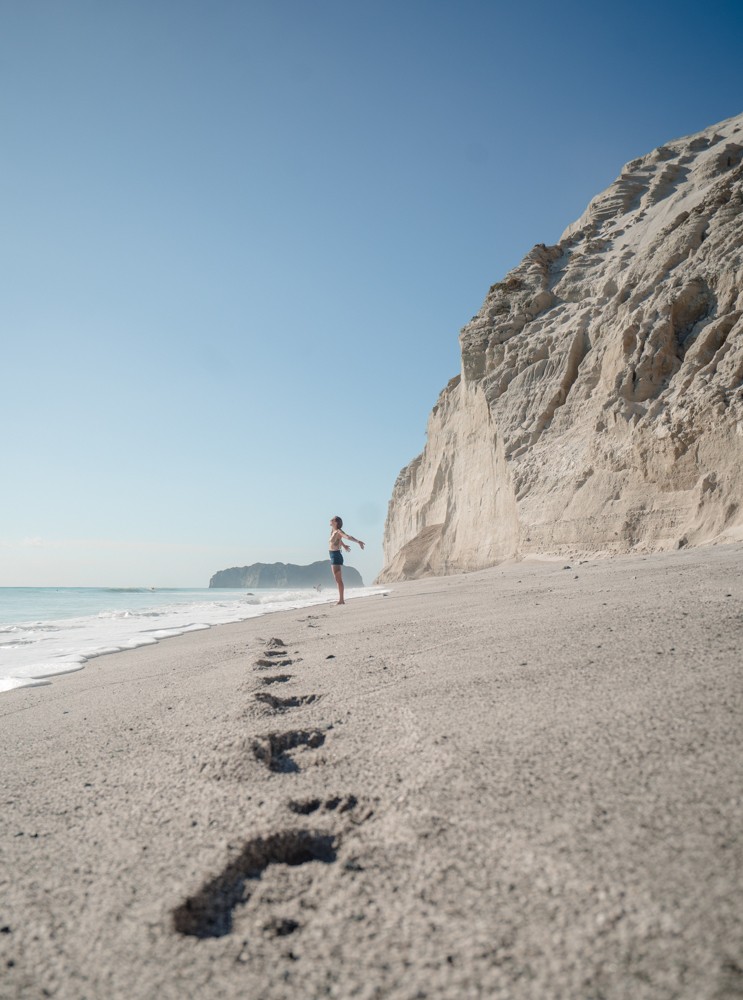
Once you’ve committed to your trip itinerary, next is planning what to bring. In a country as convenient as Japan, you can buy most small things that you forget at a Daiso store. But there are a few things to keep in mind while touring the country—one of them being cash. Japan heavily operates as a cash-based country, and many places don’t accept credit cards.
The clothes you fit into your backpack (I HIGHLY recommend a backpack for Japan) will vary depending on the season you go. I’ve written a complete outfit guide for a trip to Japan, but here are some things to keep in mind about travel in Japan during each season:
When springtime comes around, so will the tourists who want to see Japan’s famous cherry blossoms. While they’re certainly beautiful, it may be hard to appreciate them with the constant crowds. I would also avoid going during “Golden Week”, a Japanese holiday from the last week of April to the first week of May. This week will add to the crowd with groups of locals getting their vacation time in. Summertime (June to August) is a mixture of both dry and hot, which will make outdoor adventures exhausting. I wouldn’t come during this season either unless you want to go to explore beachier places like Okinawa.
Instead, you can opt for the fall (September – November) if there isn’t a specific seasonal activity you’re interested in. The season’s mild weather and beautiful change in scenery are amazing to see throughout Japan’s parks. The winter season is also a great time to hit the slopes in Japan’s north (see Hokkaido above), but visiting will be pricier due to its popularity during the colder months.

First Name:
Japan has much that a solo traveler could want: safety, historic sites, great food, and kind people. The cultural differences may catch you off guard at first, but traveling despite language barriers will build your confidence as a solo traveler. If you come with an open mind and an empty stomach, you’ll find that the country has a lot to offer.
Is there a place you’d like to visit in Japan? Let me know in the comments!
About Kristin Addis
Kristin Addis is the founder and CEO of Be My Travel Muse, a resource for female travelers all around the world since 2012. She's traveled solo to over 65 countries and has brought over 150 women on her all-female adventure tours from Botswana to the Alaskan tundra.
Leave a Reply Cancel reply
Your email address will not be published. Required fields are marked *
Save my name, email, and website in this browser for the next time I comment.
subscribe to our newsletter
This site uses Akismet to reduce spam. Learn how your comment data is processed .
Solo Traveler
Solo travel tips, destinations, stories... the source for those who travel alone.
Solo Travel Japan: 32 Tips You Need to Know
April 2, 2018 by Janice Waugh
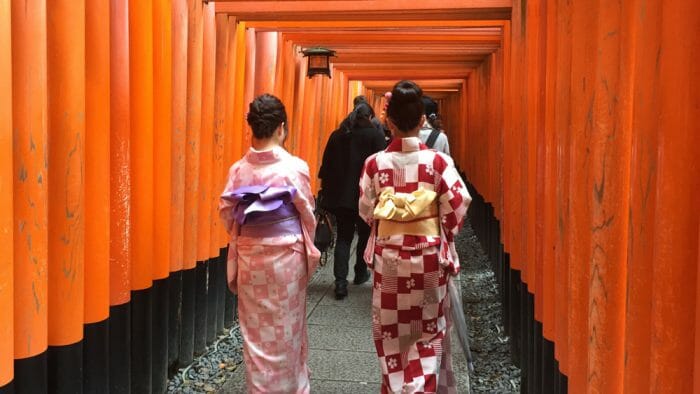
Walking through the vermillion Fushimi Inari-taisha shrine is considered purifying to Buddhists.
Japan is a beautiful, welcoming, friendly country. It's also quite different from any country I've visited. Before I start sharing the tales of my 10-day trip there, I want to give you my top tips for traveling solo to Japan.
Japan is actually quite an easy country for travelers. People line up for things. Trains run on time. And there is just enough English on signs and in announcements to help you get by.
But that doesn't mean that navigation is easy or that what the Japanese consider to be good manners are obvious to the traveler from abroad. That's why I've put together this information on traveling in Japan.
With just 10 days experience, I cannot say that this post is comprehensive. I'm sure that many readers, in their Japan travels, have noticed differences from other countries that could be shared in the form of more tips for travelers who are yet to go.
Please leave your tips in the comments.
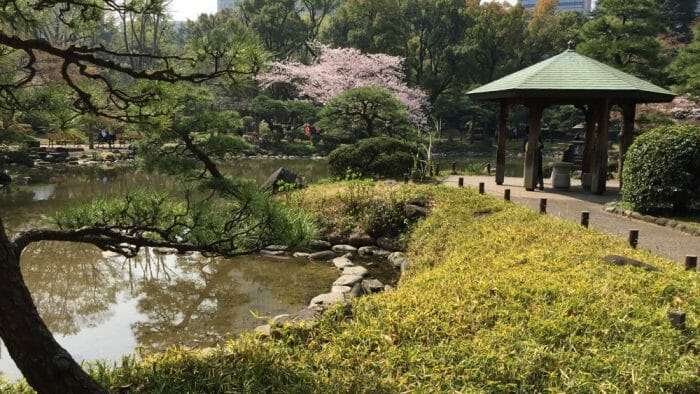
Inokashira Park in Kichijoji, Tokyo.
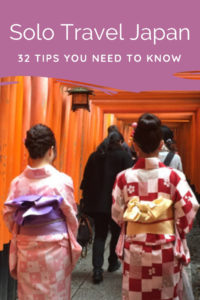
Pin it on Pinterest!
Table of Contents
Tips for Traveling Solo in Japan
- Have cash . Everything I had read said that Japan is a cash society. I found that many places take credit cards including the hostels and ryokans where I stayed, 7-Elevens that are everywhere and many restaurants. While I used my credit card a lot, having cash was an imperative. In 10 days I spent about US$300 in cash.
- Watch on your right when crossing . Cars drive on the left in Japan. However, foot traffic is sometimes on the left and other times on the right. Escalators were consistently on the left and then, I found an exception in Tokyo when it was on the right. Default to the left but be prepared to be wrong.
- Shoes are for the street . If you see slippers at the entrance of a building you are expected to take your shoes off and put slippers on. At every point along the way, should you see slippers you repeat the process. For example, when you go to a Ryokan you will leave your shoes at the door change into the slippers provided and go to your room. You'll leave these slippers at the entrance of your room and use socks or bare feet in the room. When you go to the bathroom, you'll find another pair of bathroom slippers that are only used there. If the bathroom is down the hall you will put the house slippers on as you leave your room, walk to the bathroom and change to the bathroom slippers, then change back to the house slippers as you leave and then leave the house slippers at the entrance to your room.
- Toilets are interesting in Japan . Yes, enter a cubicle and the sound of a gentle waterfall and birds will typically start playing. Sit down and you'll often find the seat to be heated. A control panel will let you turn off the sound and, in women’s washrooms, give you a variety of bidet options. You'll have two or three spray options and often be able to control the intensity of the spray. There is also toilet paper. Many public toilets do not have paper towels or blow dryers for you hands. People often carry a small facecloth with them for this purpose.
- A culture of public baths. There are thousands of natural hot springs all over Japan. These are called onsens and are used as public baths. When you arrive at one, you strip down (everyone is naked in an onsen) soap up and wash down completely and only then enter the pool (or pools). I’ll be giving you a more detailed article on onsens soon. They are a Japanese experience not to be missed. Read How to Onsen: The Naked Truth About Japan’s Best Cultural Experience
- Juicing up . Power outlets are the same as in North America so if that's where you're from you don't need an adapter.
- Don't assume that a taxi driver or anyone will speak English. Whenever possible, get your logistical information, hotel name, address and telephone number, written in Japanese for you.
- There’s more English than I expected. Train station names are written in Japanese and English scripts. The essential announcements on trains and subways are also made in English.
- Chain hotels can be a huge help . If in doubt, go to a large hotel for assistance where there will most certainly be English spoken. I went to the Shangi-La in Tokyo when I first arrived to get help finding my hostel. I was carrying a backpack and yet this high-end hotel treated me very well. They wrote the coordinates for my hotel on a card in Japanese and got me a taxi.
- Miss your pet? If you miss your pet or simply want some quiet time, try a cat cafe. There are also owl cafes (with real owls on hand) and dog cafes. Pay approximately 1300 yen per hour for a drink and the pleasure of sitting with the animals.
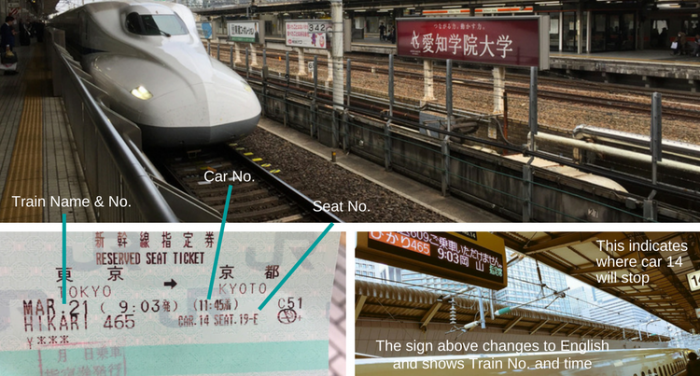
The Shinkansen, also known as the bullet train, takes you from Tokyo to Kyoto in under 3 hours. If you're going in that direction, sit on the right side of the train for a view of Mount Fuji on a clear day.
Solo Travel Japan: How to Get Around by Train and Metro
Traveling solo in Japan, with just enough English on the signs, takes patience. Here's what you need to know.
- The Monorail connects to the subway system to take you anywhere in the city.
- The Keikyu Line goes into central Tokyo. Get off at Takaracho Station and you're close to Imano Tokyo Ginza Hostel where I stayed.
- Bus to Tokyo Station and other points . At arrivals there is a very obvious bus ticket counter on the left. I bought my ticket to Tokyo Station for 1,000 yen. Cdn$12.
- Taxis . Taxis are available but expensive. It seemed to me that 20 minutes in a taxi cost about ¥2,000 in both Tokyo and Kyoto. You can use Google maps to estimate the length of your trip. Make sure that you have your destination written in Japanese on a piece of paper, as drivers will not necessarily speak English or read western script.
- Buy your JR Rail Pass voucher before you go . Rule of thumb is that if you are taking more than one train trip it is worth it.
- Trade your voucher for your JR Rail Pass . Go to ticket office at train station. There will be a wicket specifically for getting your JR voucher turned into a pass.
- Get your train ticket. Once you have the pass you need to go to a regular wicket to get a ticket for your train. Note: If you're taking the train from Tokyo to Kyoto, ask for seat on right side of train for view of Mount Fuji. On left in opposite direction.
- Plan ahead. When you arrive at your destination, go to the ticket office to get your next train ticket so that you get a reserved seat and don't miss out should you want to travel on a particularly busy day. This is important on weekends.
- The information on your ticket . Your ticket indicates your train number, car number and seat number.
- Matching your ticket with the platform . Find the platform for your train number by looking at the digital signs or asking an agent of which there are many. Be mindful that the next train to your platform may not be your train. Look for the electronic signs indicating the number of the next train to come so you'll know when your train has arrived. Once your train is next, look for where you should stand on the platform for your car number. They also have signs indicating where your car number will stop along the platform. Wait at the entrance for your car number. When it's arrives, enter and you'll easily find your seat.
- Listen to the announcements . Announcements on the train are in English as well so you don't need to worry about missing your stop. They also tell you what side of the train you'll disembark on.
- Smoking permitted in designated areas . The Shinkansen train has smoking rooms on certain cars and food trolleys. Not all regional trains have either.
- Your JR Pass and city travel . There are times when you'll transfer to a JR Train to get to your destination outside a city. You can usually use your JR Pass for this and save on your metro costs.
- A transit card . You can get a transit card in just about any city. The ICOCA card for Kyoto costs ¥2,000 or about Cdn$12/US$10. You can buy it from a ticket machine. ¥500 is a deposit on the card which you can get back from a kiosk along with any balance before leaving the city. My research says that you can use it in Tokyo as well however you cannot cash in the card in that city.
- A day pass . Depending on your plans a 24-hour day pass can be a good idea. In Tokyo be careful as there are two Metro companies. A day pass for the Tokyo Metro is 600 yen. For the Tokyo and Toei subways the price is 900 yen.
- Pay per trip . Buy your ticket at every station based on your destination. The farther you go, the more you'll pay.
- Ticket machines offer English . There is a button in the upper right corner of the display that will turn the information into English. There is an image of the metro near the ticket machines. Look for your destination station and the price of your ticket will be marked in a circle. Buy your ticket for that amount.
- Using the transit card. Because you pay for your ride based on distance you need to tap in at your starting point and tap out when you leave the subway. The balance remaining on your card will show every time you tap.
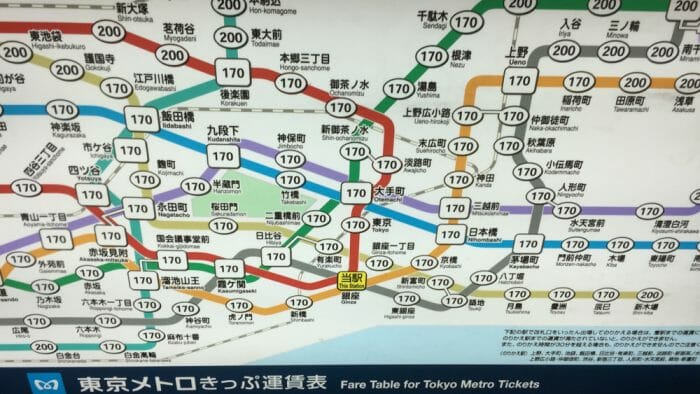
If you're buying a single-fare ticket, look on the map for your destination station and the map will indicate the value of the ticket you need to buy. 170 means you buy a ticket worth 170 yen.
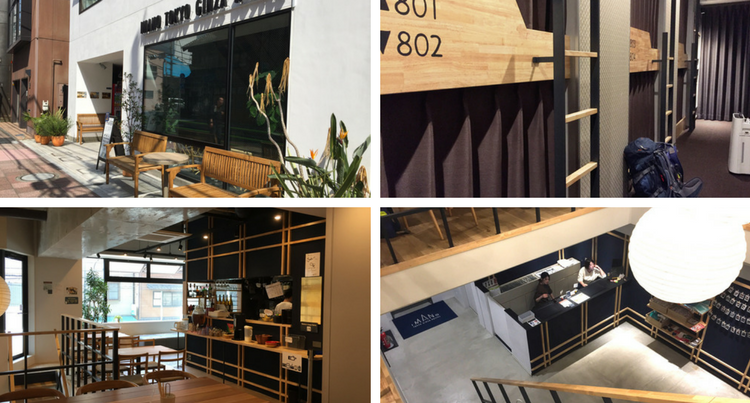
I was really happy with the Imano Tokyo Ginza Hostel as well as its location.
Accommodation for Solo Travelers: Japanese Ryokan and Hostels
Naturally, all the major hotel chains in the world are present in Japan. However, there are many more local accommodation experiences that are well worth it.
- the “agari-kamachi” (after opening the door guests step into this small area and take off their shoes)
- “shoji” (sliding paper doors) which separates the agari-kamachi from the room
- “tatami” mat flooring (reed floor matting)
- low wooden tables
- “zabuton” (sitting cushions)
- futon (sleeping quilts)
- a “tokonoma” (an ornamental alcove built into the wall used for placing flower vases and hanging scrolls)
- an “oshiire” (a closet for futon sleeping quilts)
- an “engawa” (a glass enclosed sitting area separated from the room by a shoji)
- Hostels . I also stayed in two hostels, Hostel Niniroom in Kyoto and Imano Tokyo Ginza Hostel in Tokyo. Both were less that six months old which I chose just by chance. Both were beautifully designed with very private bunks with blackout curtains. Security is fine with both requiring codes to enter the rooms. In each case the cost was about Cdn$50. I was very happy with my choice. Excellent value!
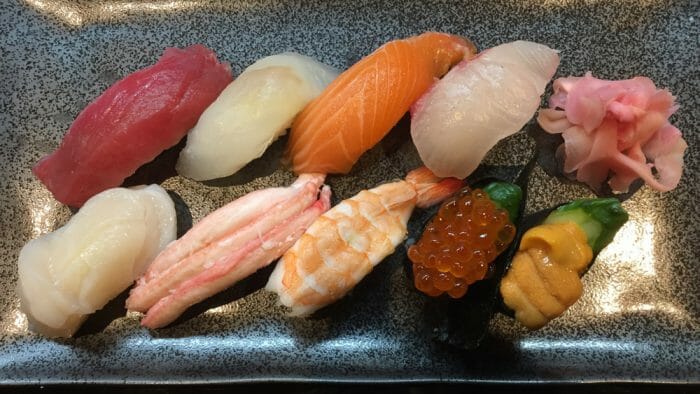
Sushi is an option in most places but it is not in every restaurant. It's not as common as I expected.
Tips on How and What to Eat in Japan
I expected to love Japanese food and discovered that, for me, eating was a challenge. First, I eat fish but not meat and, despite being an island, the Japanese eat a lot of meat. If you eat meat, especially beef, you'll be in heaven.
- Sushi is available . I expected to eat so much great sushi but I only had it twice. It was wonderful but sushi restaurants aren’t found everywhere as I expected they would be.
- Picture your meal . Pictures are available outside restaurants and on menus as well, so if you are without a food allergy or a preference like vegetarianism, it's easy to choose and to order.
- Buddah bowls . You'll often find restaurants serve rice bowls with any variety of vegetables and protein on top whether that be meat, seafood or tofu.
- There is a coffee culture . I found cafes everywhere and the coffee was quite good.
- Grocery stores. The fruit and vegetables in stores were, for me, unfamiliar, large, very brightly colored and frequently vacuum-packed in a liquid. It was strange and worried me a bit. With all information written in Japanese and no one who could explain things to me, I found myself paralyzed in the grocery stores. I'm embarrassed to say that on one occasion I walked out with a small jar of peanut butter and bananas for dinner.
- Looking for something special. Just like at home, you'll find restaurant reviews online.
- A wet towel will be provided to wash your hands before your meal. Use it then fold it neatly and leave it beside your place.
- Take food from the serving bowl and add to your own bowl.
- Sushi is eaten in one bit. Don't use too much soy sauce or wasabi as it might insult the sushi chef.
- Hold bowls in one hand, chopsticks in the other.
- It is good manners to eat everything on your plate to the last grain of rice.
- When you've finished return all dishes to how you received them with lids on, etc. Place your chopsticks back on the chopstick rest.
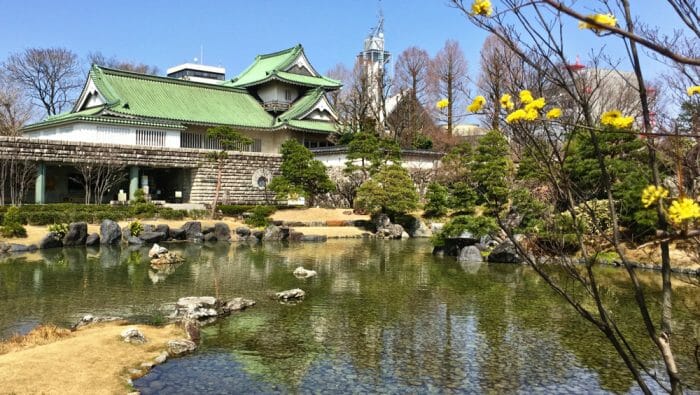
Toyama City Sato Memorial Museum in Toyama Castle Park. This was my destination for a day trip I took from Takayama.
For more on Solo Travel in Japan travel read:
- Omotenashi: Japan is Welcoming for Solo Travelers
- Japan Solo: Trip Planning Resources, Itinerary and Budget
- Solo Travel Destination: Nara, Japan
- Solo Travel Destination: Kyoto, Japan
- Solo Travel Destination: Furano & Nakafurano, Japan
Sharing is caring!
Publisher Janice: info @ solotravelerworld.com
Editor Tracey: tracey @ solotravelerworld.com
Sales Simon: simon @ solotravelerworld.com
Get Solo Travel News & Deals
- Create Your Advertiser Account
- Login to Your Advertiser Account
- Solo Travel Statistics
- Media & Speaking
- Privacy Policy & Disclosure

The content of Solo Traveler and any resources published by Solo Traveler are meant for entertainment and inspiration only. Please note that while we have advertising clients promoting destinations, products, services, trips and tours on Solo Traveler and that we endeavour to only work with companies in which we have confidence, we are not responsible for the delivery or quality of their products or services. Every person and every travel situation is different. Your safety, satisfaction and fun traveling solo are your responsibility alone and not that of Solo Traveler, its publisher, editor and/or writers.
PRIVACY POLICY & DISCLOSURE: In accordance with FTC guidelines, I disclose that I may be compensated if consumers choose to utilize links located throughout the content on this site. Additionally, some posts might be sponsored to support this site. Please do the appropriate research before participating in any third party offers. All opinions are my own. Please read our full Privacy Policy here.

- Privacy Policy
- Galapagos Islands
- Philippines
- New Zealand
- Solo Travel
- Itineraries
Japan , Solo Travel
Solo travel in japan: 16 helpful things to know.
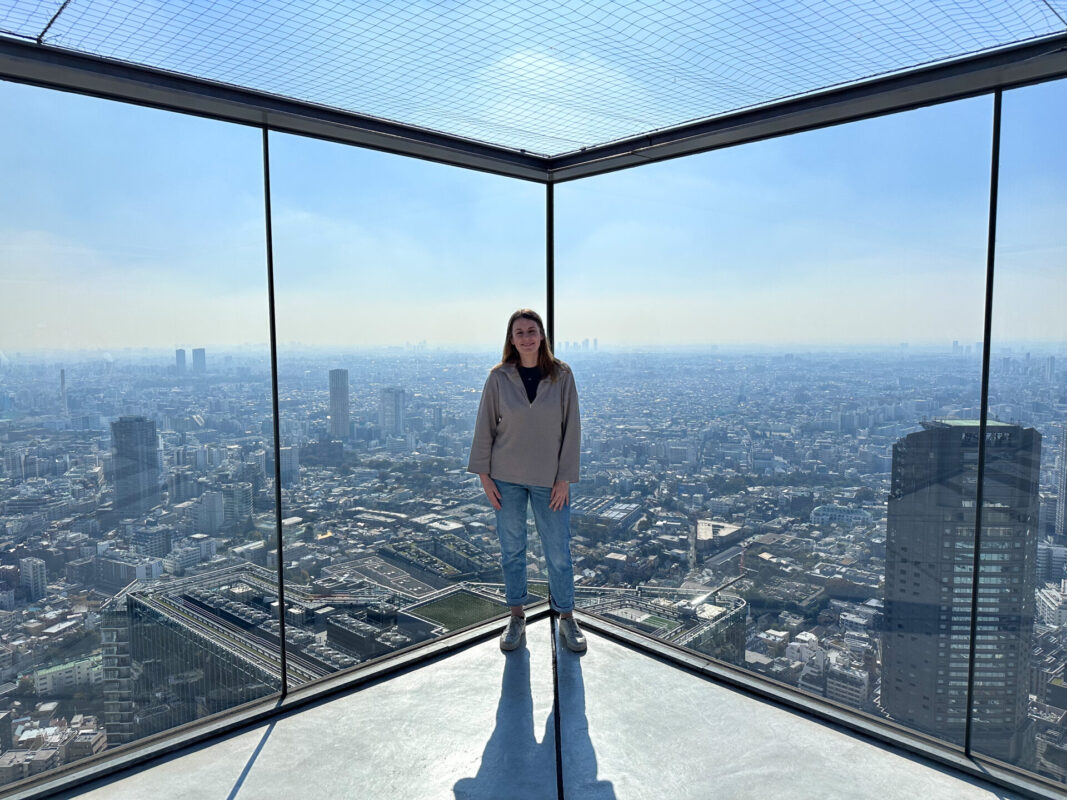
Japan is like no other country in the world. It’s full of unique wonders, unforgettable experiences, and has a fascinating culture. Japan is often named one of the best countries in the world for solo travel. This makes it a popular destination for solo travellers, especially solo female travellers.
I spent almost four weeks solo travelling in Japan. I absolutely loved it. But I’d be lying if I said it wasn’t challenging at times.
In this post, I’ve shared all you need to know about solo travel in Japan. I’ve also attempted to answer the question: ‘Is Japan good for solo travel?’. While many blogs online say it is, I do think it’s important to also look at the negatives. Yes, Japan is an amazing country for solo travel. It’s safe and full of incredible sights. However, with many cultural and language barriers, it can be an isolating experience.

Despite the challenges of travelling solo in Japan, I do believe it’s a fantastic solo travel destination. I can’t wait to return one day and would happily go back as a solo traveller.
If you’re questioning whether travelling alone in Japan is right for you, I hope you find the below post useful. I’ve tried to be as honest as I can, sharing some of the disadvantages of solo travel in Japan as well as the many positives.
Table of Contents
Japan is safe for solo travel
When it comes to the safest countries for solo travel, it doesn’t get much better than Japan. According to the Global Peace Index , Japan is the 9 th safest country in the world.
Serious crimes and petty crimes are infrequent occurrences in Japan. Many tourists happily walk around at night with no problems whatsoever. It’s even common for locals to leave their phones and laptops out in coffee shops while they go to the bathroom. Theft is that uncommon!
Of course, crime is always a possibility wherever you are in the world. While Japan might be on the safer side, it’s still important to be aware of your surroundings and not take any risks. This is especially true for solo female travellers.
The best time of year to visit Japan
Deciding when to visit Japan is a big decision. Each season offers something unique and special. Whenever you visit Japan, it promises to be an epic destination.
If you’re struggling to decide when to visit, here are some things to consider:
Spring (March to May) – spring in Japan marks the famous Cherry Blossom season (Sakura). As the weather warms and the days grow longer, Japan’s landscape is filled with beautiful cherry blossoms. This is the busiest time of year in Japan. Unless you’re desperate to see the famous cherry blossoms, I’d avoid visiting during this time. It can be very crowded and accommodation prices are much higher.
Summer (June to August) – the summer months in Japan can be hot and humid, especially in Tokyo. If you can cope with the heat, the summer is a great time to visit Japan. The Typhoon season in Japan is from May to October. This can sometimes have an impact on transport and activities, but it’s not an everyday occurrence by any means.
Autumn (September to November) – Autumn is the best time of year to visit Japan. The weather is cooler, the crowds are fewer and Japan lights up with red, orange and gold as the fall colours put on a show. Autumn in Japan is also the best time of year to see Mount Fuji. While the weather can never be guaranteed, the month of November boasts regular clear skies and sunny days.

Winter (December to February) – the winter months are a unique time to visit Japan. In areas such as Hokkaido, there is often heavy snowfall making it the perfect ski destination. Major cities such as Tokyo and Kyoto are also no strangers to snow. While the snow doesn’t tend to settle, it’s still a pretty sight. Winter is the quietest time to visit Japan, just remember to wrap up warm.
As you can see, Japan is a year-round destination. Depending on what you want to see and do, there’s not a bad time to visit as such.
How to get around Japan as a solo traveller
The best way to get around Japan is by using its fantastic train system. Japan is renowned for having one of the best rail networks in the entire world. It can take a bit of getting used to, but once you’re familiar with it, it’s a great way to get around Japan.
Most of the major Japanese cities have extensive public transit systems. Tokyo alone has one of the world’s biggest Metro systems. There are train and bus connections all around the city making it easy to get around. I didn’t use a taxi once while in Japan.
Japan Rail Pass
Many visitors to Japan opt to purchase a Japan Rail Pass. Depending on which pass you buy, the JR Pass allows unlimited use of its rail network. This includes the famous Shinkansen (bullet train).
Explaining the ins and outs of a JR pass is an article (or three) in itself, but there’s a helpful guide here . I’m working on a guide to answer the question ‘Is a JR pass worth it?’, but here are a few things to consider:
- The JR Pass can only be used on the JR Network. Many train connections in major cities and between cities aren’t operated by JR Rail. For example, it’s not going to be the most useful for getting around Tokyo.
- Other rail operators offer similar services between cities. These are often cheaper and depending on the route, don’t take that much longer.
- Consider looking at regional JR Passes rather than one that covers everywhere. I only bought a JR Pass that covered the Kansai area and this worked perfectly for me.
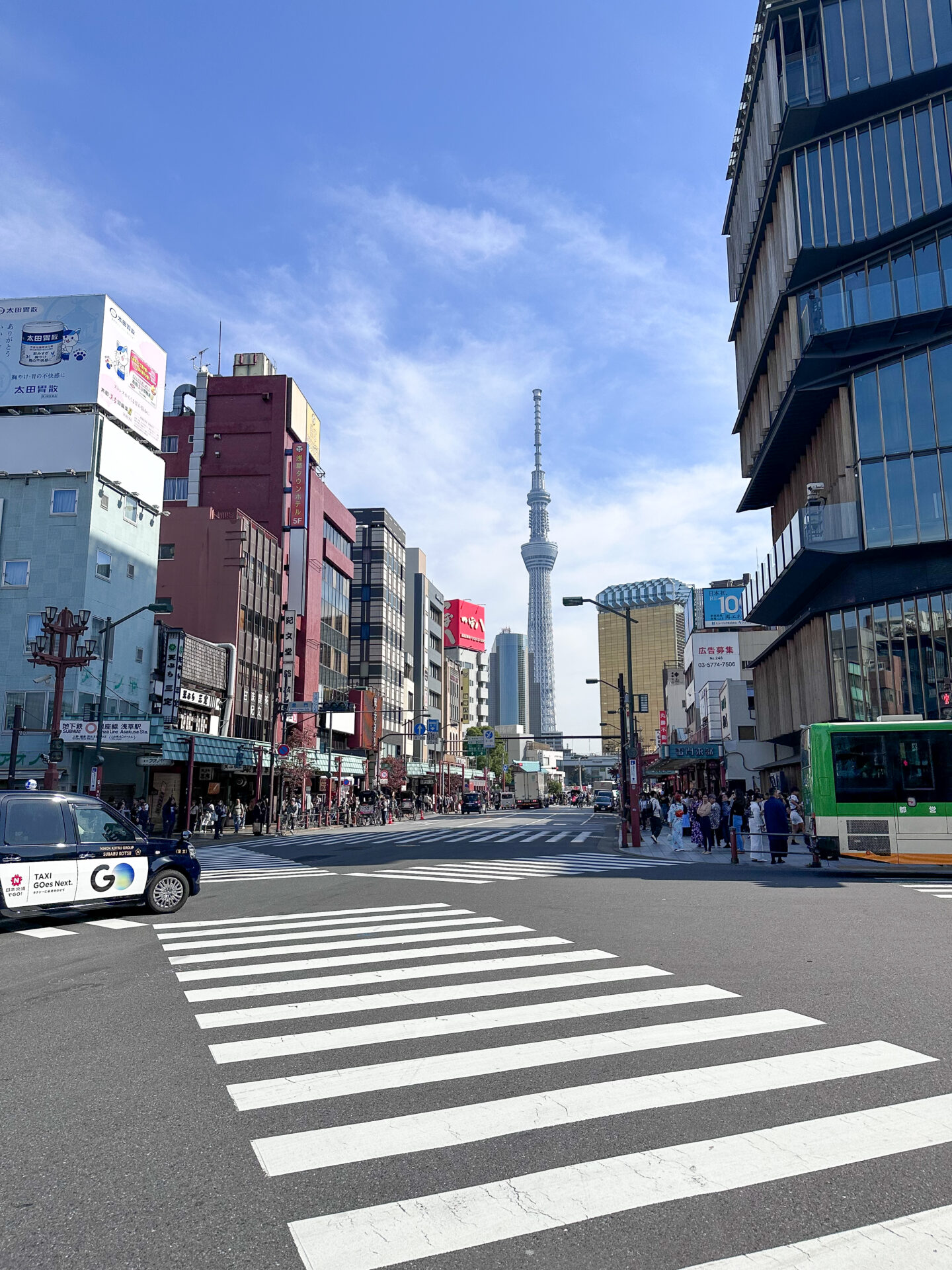
Pasmo or Suica Card
The Pasmo and Suica cards are both pre-paid travel cards. Think of them a little bit like an Oyster card in London. However, they can be used in many tourist destinations in Japan.
I only got a Suica Card on the last week of my trip and wish I had bought one sooner! You simply add money using a vending machine at a station, then tap in and tap out on your train and bus journeys. You can also use the cards to pay for lockers at stations and even in some shops such as 7-11.
Pasmo and Suica are generally interchangeable. I’d recommend waiting until you get to Japan to buy one. I found them to be a lot more expensive on the likes of Klook compared to buying one at the stations.
Tips for getting around Japan as a solo traveller
Download the J apan Travel App by NaviTime . This was a lifesaver on my trip.
Metro passes can save you money . All the major cities such as Tokyo and Kyoto offer 24-hour & 72-hour passes.
The trains in Japan are very punctual, don’t be late .
The train stations in Japan are HUGE and can be very overwhelming, especially the likes of Shinjuku and Tokyo Station. Arrive in plenty of time to find your platform .
Avoid travelling in rush hour , the trains can be very crowded.
The station staff are very friendly and helpful. Don’t be afraid to ask for directions or help .
The best places for solo travel in Japan
Building an itinerary for Japan is no easy task. I spent days and days (if not weeks) trying to figure out where I wanted to go in Japan and how long to stay in each place.
The truth is, it’s impossible to see Japan in one trip (unless you have months and months). You could spend a week in Tokyo alone and only scratch the surface of what the city has to offer.
Each of Japan’s cities has its own distinct charm with hidden gems waiting to be discovered.
Here are some of the best places to visit on a solo trip to Japan.
Tokyo is the capital city of Japan. It’s also the most populated city in the entire world!
There are mixed opinions on whether Tokyo is worth spending much time in. I personally love Tokyo! It’s a vibrant city with so many amazing and unique things to see and do . If it’s your first time in Japan, I highly recommend spending a few days here.
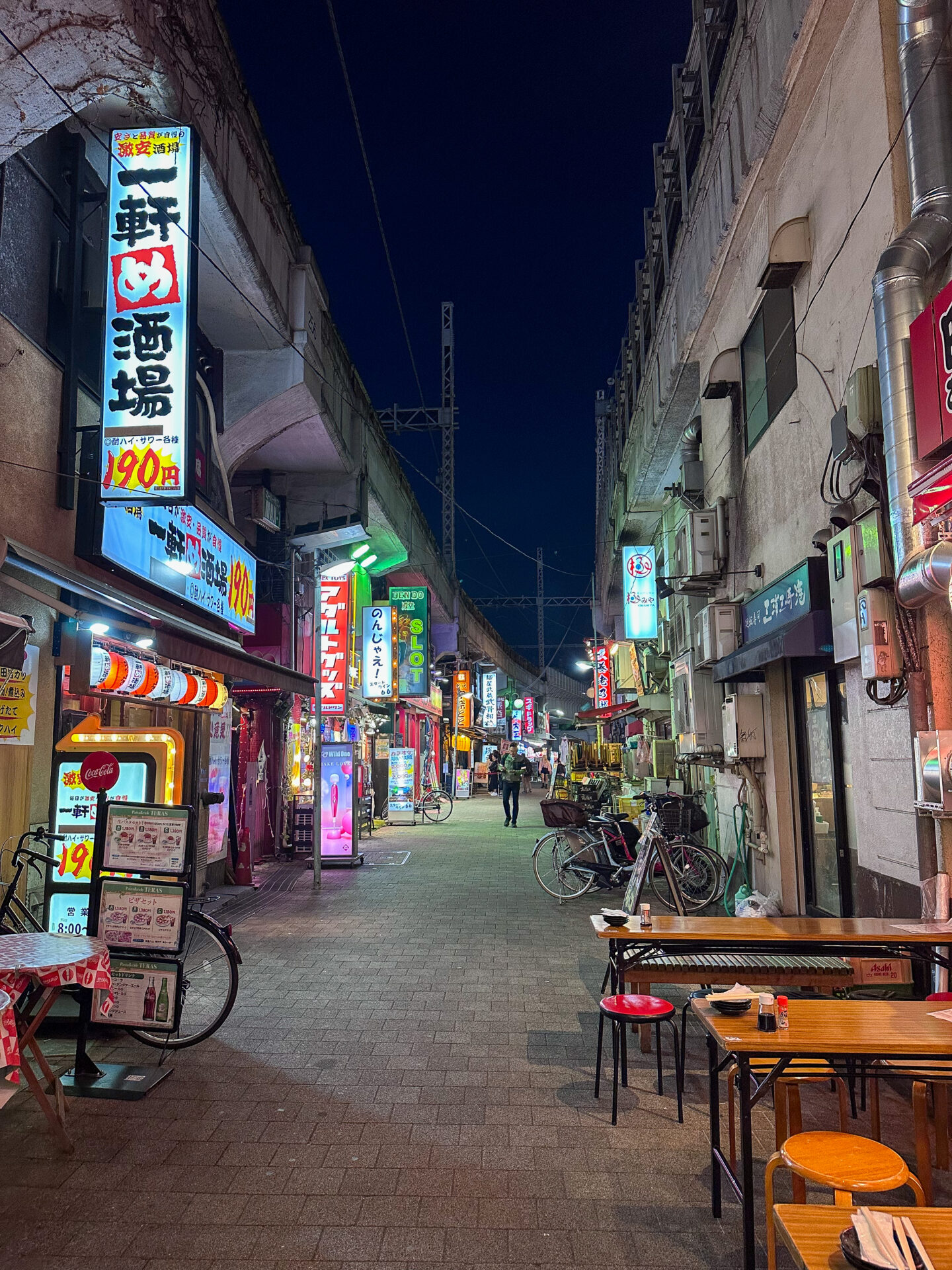
There’s an endless list of things to do in Tokyo, but don’t miss some of the highlights including Asakusa , Tokyo Skytree , Shibuya , Akihabara , Harajuku or Yanaka Ginza .
Suggested time to spend in Tokyo : four days
Best place to stay in Tokyo for solo travellers : I recommend staying at either Wise Owl Hostel in Shibuya or Nui Hostel in Asakusa.
Hakone
Hakone is my favourite place I visited on my solo trip to Japan. This beautiful area is nestled in the mountains and boasts some incredible scenery. Hakone is known for its relaxing hot springs (Onsen), traditional culture and epic views of Mount Fuji .
The area feels completely different to anywhere else in Japan (that’s on the tourist trail at least). It’s serene, laid-back and shows off an entirely different side to the country.
Hakone is the perfect day trip from Tokyo , but I’d recommend spending at least one night there to fully experience the area. There’s so much to do in the Hakone area and it would be impossible to see it all in one day. It’s also the perfect place to relax for a couple of days.

I have to say Hakone wasn’t the most social of areas. If you’re a solo traveller looking for nightlife and to meet other people, Hakone isn’t the place. But it’s beautiful nonetheless and a must-visit in my opinion.
Highlights in Hakone include the Lake Ashi Sightseeing Cruise, views of Mount Fuji , the Owakudani Volcanic Valley and the Mishima Skywalk .
Suggested time to spend in Hakone : 2 days
Best place to stay in Hakone for solo travellers : the Azito Guesthouse is the best hostel in Hakone
Related read: check out my suggested itinerary for Hakone
Kyoto is one of Japan’s most famous cities and an absolute must for anyone visiting Japan. If you’re interested in Japan’s history, Kyoto should be at the top of your list. There are 17 UNESCO World Heritage Sites in Kyoto, each offering a unique insight into Japanese culture and history.
Kyoto is home to many must-see attractions. From the famous orange Torii Gates of the Fushimi Inari Shrine to the Bamboo Forest of Arashiyama, Kyoto has a range of incredible sights. The Southern Higashiyama area of Kyoto is one of the best places to immerse yourself in Japan’s history. The area is known for its ancient temples, small boutiques and wooden tea houses. It’s also where you can sometimes see a Geisha.
While in Kyoto, don’t miss a trip to the Kiyomizu-dera Temple , a UNESCO World Heritage Site. This was one of my favourite temples I visited in Japan. It can get VERY crowded though, so go as early in the day as possible.
Suggested time to spend in Kyoto : 2 to 3 days.
Best hostels in Kyoto : Piece Hostel is one of the best hostels in Osaka. Len Kyoto is another good option.
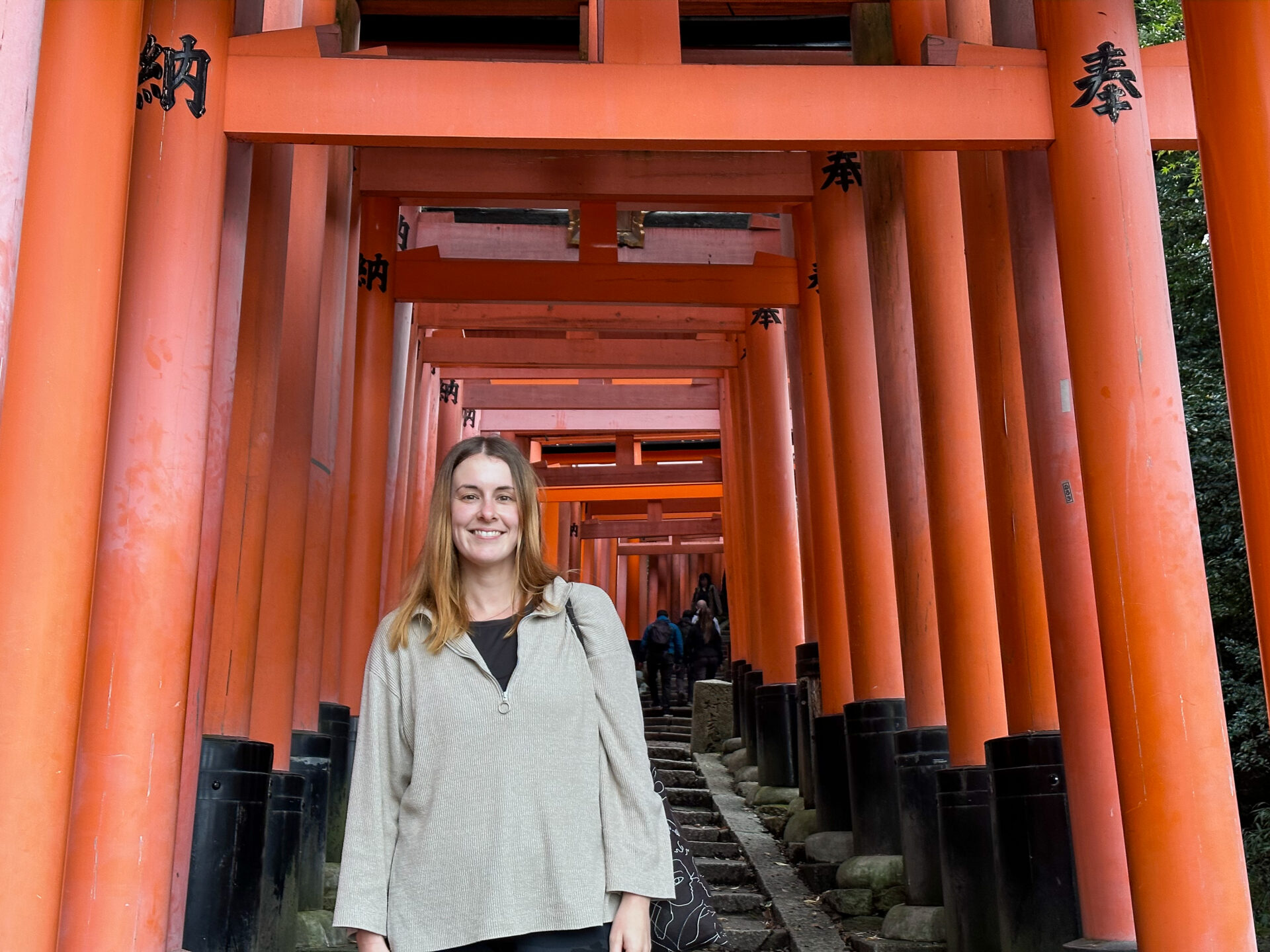
Osaka
Osaka is the perfect place to base yourself for a few days. It’s one of the biggest cities in Japan and has a completely different feel to it than Kyoto. The city is modern and vibrant but still has plenty of history attached to it. It also has some of the best food in Japan.
Osaka is a great base for day trips. There are so many epic day trips from Osaka including Nara , Kyoto , Hiroshima , Himeji and Kobe . While in Osaka, don’t miss a trip to the stunning Minoo Park . It’s a great escape from the crowds of Osaka.
Highlights in Osaka itself include Osaka Castle , the Umeda Sky Building , and the amazing street food .
Suggested time to spend in Osaka : at least 3 days
Best hostels in Osaka : I recommend staying in The Pax or Imano .
Hiroshima
A trip to Hiroshima offers a unique insight into Japan’s past. The city was the victim of a nuclear bomb back in 1945. Despite being destroyed, the city rebuilt itself.
One of the best things to do in Hiroshima is visit the Hiroshima Peace Museum . It educates visitors about the devastating incident, but also shows the resilience of the Japanese.
While in Hiroshima, a trip to Miyajima is a must. This beautiful island is home to the Itsukushima Shrine, one of the most beautiful shrines in all of Japan.
Suggested time to spend in Hiroshima : 2 days (or a day trip from Osaka, but you’ll struggle to see everything).
Best hostels in Hiroshima : I stayed at Akicafe Inn , it’s one of my all-time favourite hostels.
Related read: Plan your trip to Hiroshima and Miyajima with this 2-day itinerary suggestion

Okinawa is a great place to relax for a few days. This stunning area of Japan is home to white sand beaches and crystal clear water. It offers an entirely different experience for your trip to Japan.
There’s not a huge amount of things to do in the area, but if you want to relax on the beach and snorkel in the ocean, Okinawa is the perfect destination.
Suggested time to spend in Okinawa: 3 days
Best hostel in Okinawa : MyPlace Guest House
There are lots of hostels in Japan
Staying in hostels is a fantastic way to meet other travellers when on a solo trip to Japan. The Japanese hostels are some of the nicest hostels I’ve ever stayed in. They are clean, modern, and often have privacy curtains on the beds. For solo female travellers, many also have female-only dorm rooms as well as private rooms.
Staying in hostels is a great way to meet new friends and fellow travellers who share similar interests. However, I have to say I didn’t find the hostels in Japan the most social of places.
This might have just been my experience, but I found it harder to meet people in hostels here than in other countries. I think this was due to a combination of things.
Japanese hostels very much cater to Japanese locals as well as tourists from Western countries. I spent nearly four weeks staying in Japanese hostels. There were only a handful of nights when other Westerners were in my dorm room. Of course, this isn’t an issue, but there was a big language barrier which made it hard to be social.
Japan also isn’t the most popular destination for backpacking. I assume this is due to the cost and being out of the way of the traditional Southeast Asia backpacking route. Yes, there are solo travellers in Japan. But nothing like the amount you’ll find in countries such as Thailand, Vietnam and Australia.
As I said, this was just my experience. I know some people who have travelled solo in Japan and met lots of other people. I also know many people who had the same experience as me. They found it harder to make friends than in other countries.
Another great accommodation option in Japan is the capsule hotels. These tend to offer a little more privacy than dorm rooms. They’re very popular with the locals and much cheaper than a hotel room.
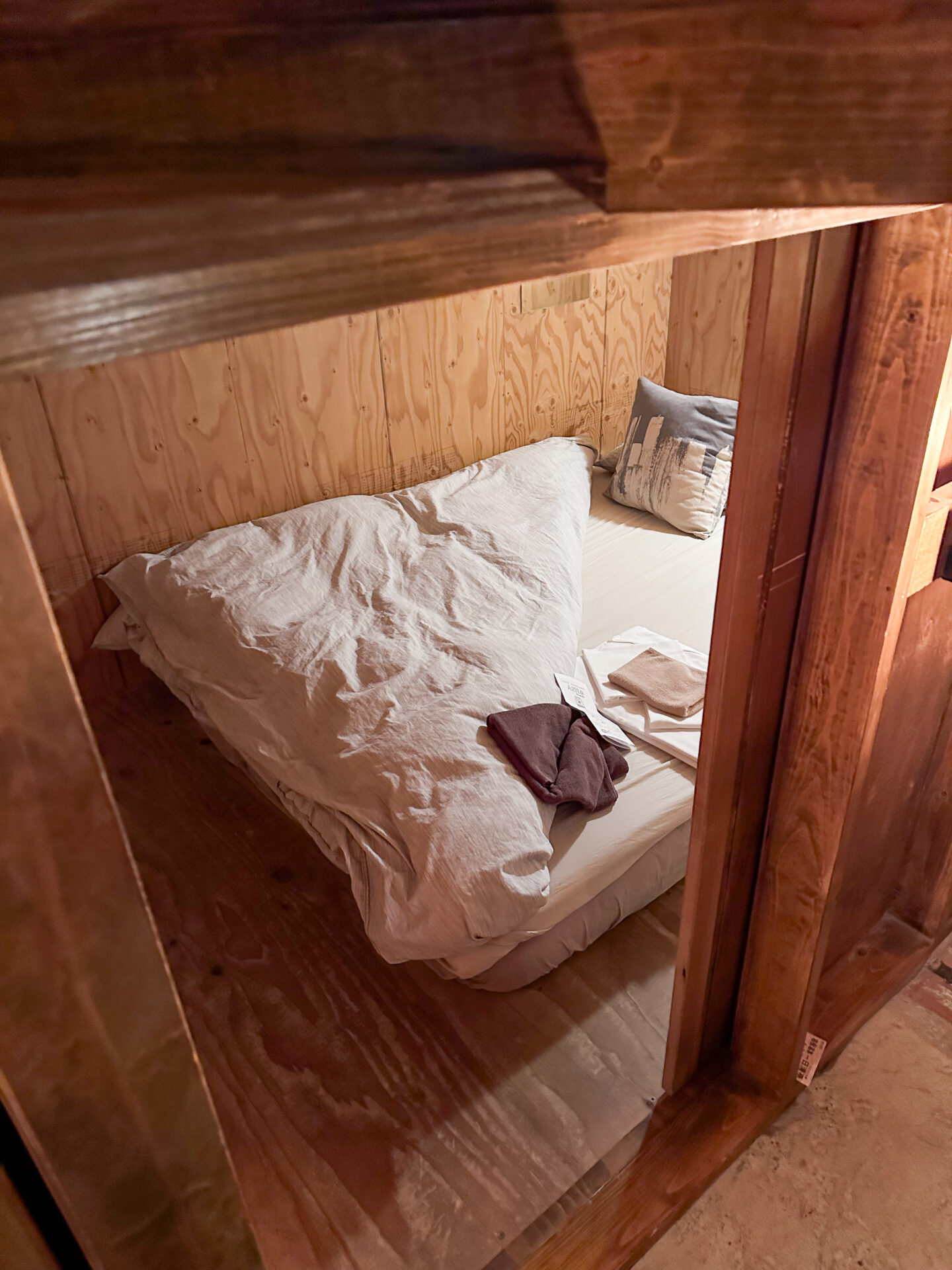
It’s important to do some research beforehand
Visiting Japan can be an overwhelming experience. I don’t think it’s the type of place where you can turn up and ‘wing it’ without doing any prior research. This is especially true when it comes to solo travel in Japan.
Even if you want to keep your itinerary open for some flexibility, here are some things I believe it’s important to research before your trip to Japan:
- Where to stay in each city : Japan’s cities are HUGE and there are many different areas to choose from. Do some research to make sure you choose the right spot.
- The cheapest way to get around Japan : many people assume a JR Pass will save them money. This wasn’t my experience. Spend some time calculating the cheapest method to get around for your itinerary.
- Social norms and rules: Japan has a unique set of social norms. Spend some time researching this beforehand. For example, did you know it’s considered rude to eat food in the street while walking?
- Top things to do in each city : there is an endless list of things to see and do in Japan and some of the activities require some planning or booking ahead. Don’t miss out on experiencing something because you researched it too late.
Have an open mind
Travelling solo in Japan can push even the most confident of solo travellers out of their comfort zone a little bit. The country has a unique set of social and societal norms and it’s important to keep an open mind.
Try the unusual foods, ask the locals questions and immerse yourself in their culture.
One of the best ways to experience Japanese culture is to stay in a Ryokan. These traditional Japanese accommodations often include tatami-matted rooms and communal baths. Staying in a Ryokan is an absolute must while in Japan.
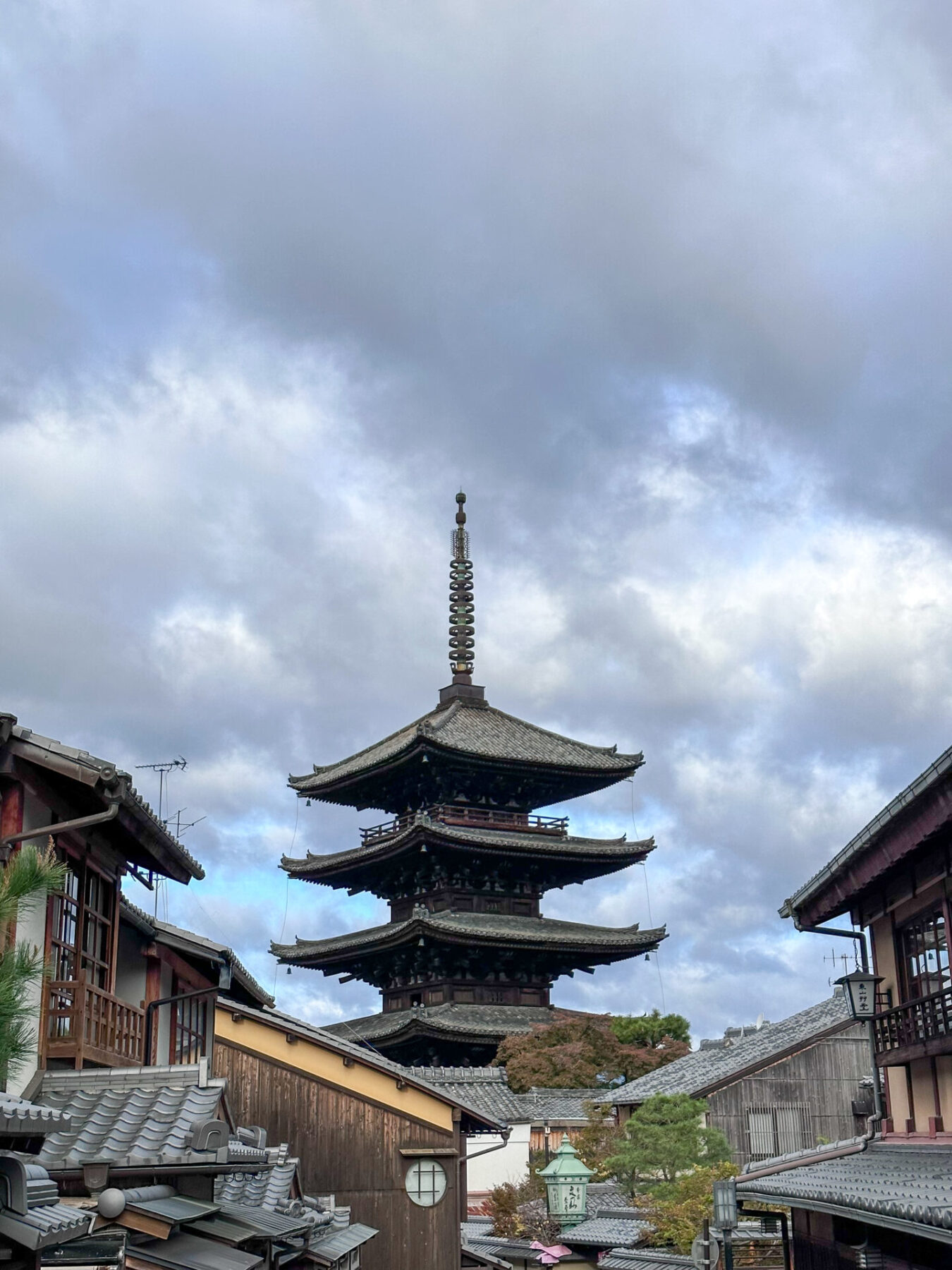
It can feel isolating
Solo travel in Japan can be isolating and challenging. When planning my solo trip to Japan, many blogs only stated the benefits, so I want to talk about the negatives too.
If you’ve never travelled solo before or you’re a bit nervous about travelling solo , I don’t believe Japan is the best place to start. The country has a very unique culture and while this is fascinating and wonderful, it can feel isolating.
As I discussed above, the hostels in Japan aren’t always the most social of places and it can be difficult to make friends. There’s also a big language barrier with many of the locals not speaking English.
While solo travel is perfectly normal and accepted by Japanese society, I did sometimes feel a little on the “outside”. Even little things like working out how the restaurant vending machines worked or buying a train ticket can be difficult.
I don’t want to put anyone off from travelling alone in Japan. It can be an incredibly liberating experience. Most solo travellers love their time in Japan.
There are so many benefits to solo travel and Japan is no exception to this. However, I think it’s important to share the challenging side of solo travel in Japan as well.
The food is amazing
The food in Japan is some of the BEST in the entire WORLD. If I had to eat one cuisine for the rest of my life, it would be Japanese food! A big part of your solo adventure in Japan is experiencing this incredible food.
Contrary to popular belief, there is so much more to Japanese cuisine than fish. I don’t eat fish but this didn’t affect my experience in Japan at all. Many people also assume Japanese food is expensive. If you’re going to go to fancy restaurants every night and eat Kobe beef or fresh sushi then yes, it’s expensive. Likewise, the restaurants catering to Western tourists also have a hefty price tag.
However, there are *so* many hidden and affordable food gems in Japan. Some of my favourite meals were in tiny restaurants with only a few reviews on Google.
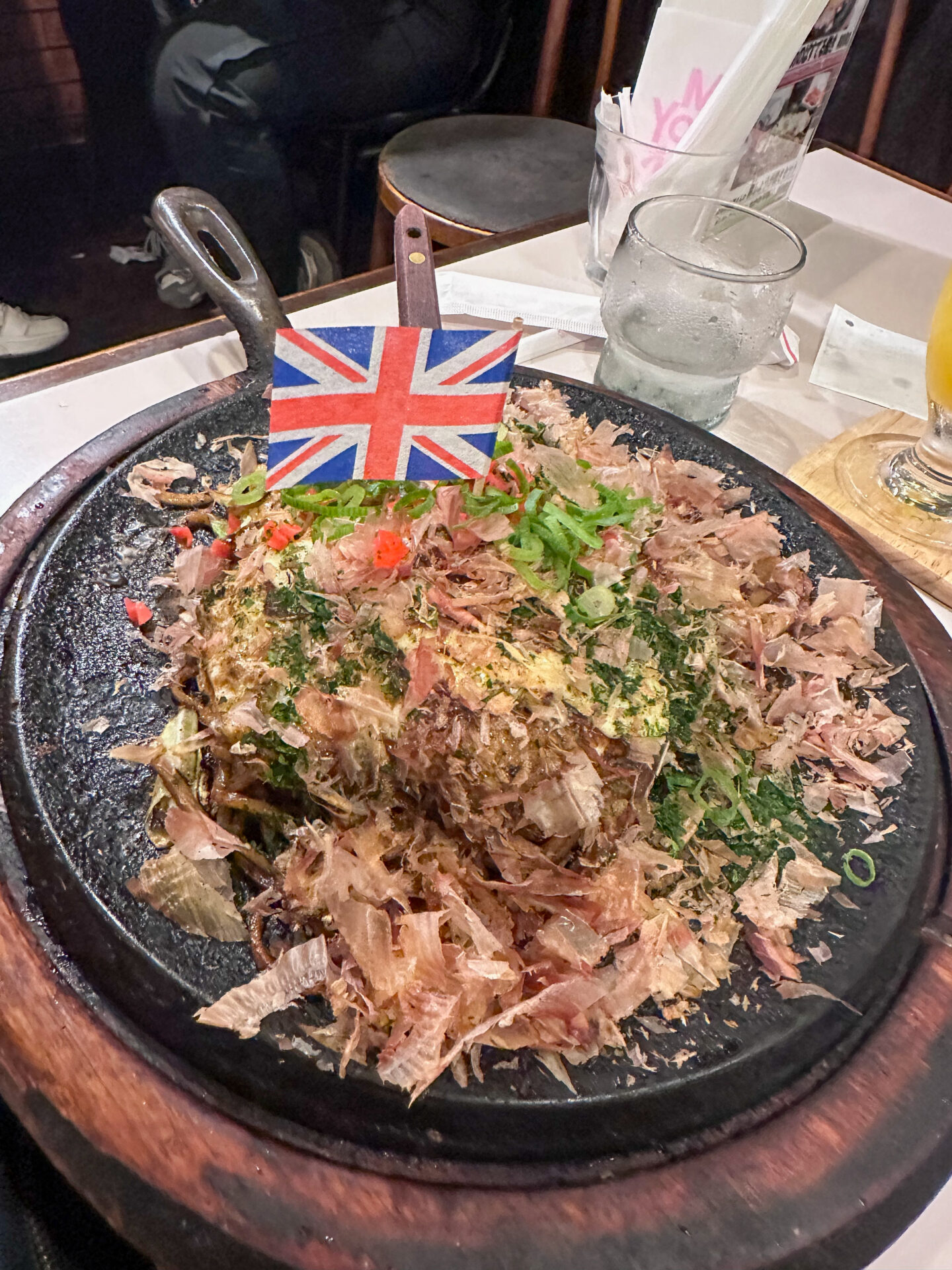
My best advice is to avoid the tourist spots and look for where the locals are. Most of the meals I bought were around the $7 mark.
Tip : TikTok raves about Gyukatsu, but this was one of my least favourite meals in all of Japan.
Street food in Japan is another good way to eat on a budget. Each area of Japan has its unique foods and style of cooking. This means the street food never gets old and there’s always something new to try.
My favourite budget food spots in Japan
- Curry bread from Tokyo Curry Pan in Asakusa (this was amazing)
- Gyoza from Nishiki Market in Kyoto .
- Beef and cheese croquettes from Kuroge in Asakusa
- Taiyaki (fish-shaped pastry stuffed with red beans or cheese). This can be found all over Japan
- Okonomiyaki (savoury pancake) from Doraju in Osak a
- Yakisoba from Mr Young Men in Kyoto
- Japanese Curry from Cocoro in Hakone .
- Curry Udon Tachibana in Osaka .
If you’re on a tight budget, the convenience stores in Japan are a great option. They have a range of delicious and high-quality sandwiches, sushi, salads, bento boxes, smoothies… the list goes on. It’s all very affordable. The 7-11 in Japan is unreal and you’ll find one on every corner. I also recommend trying Family Mart (who I think do the better coffee).
Tip : when planning a solo trip to Japan, it’s fair to question if it’s normal to eat out alone. Luckily, eating out by yourself is almost completely normal in Japan. Ironically, the only places I felt a little uneasy were the Western restaurants full of tourists. It’s completely normal for Japanese people to eat dinner by themselves. Many restaurants even cater to solo diners by having solo booths or tables with one seat.
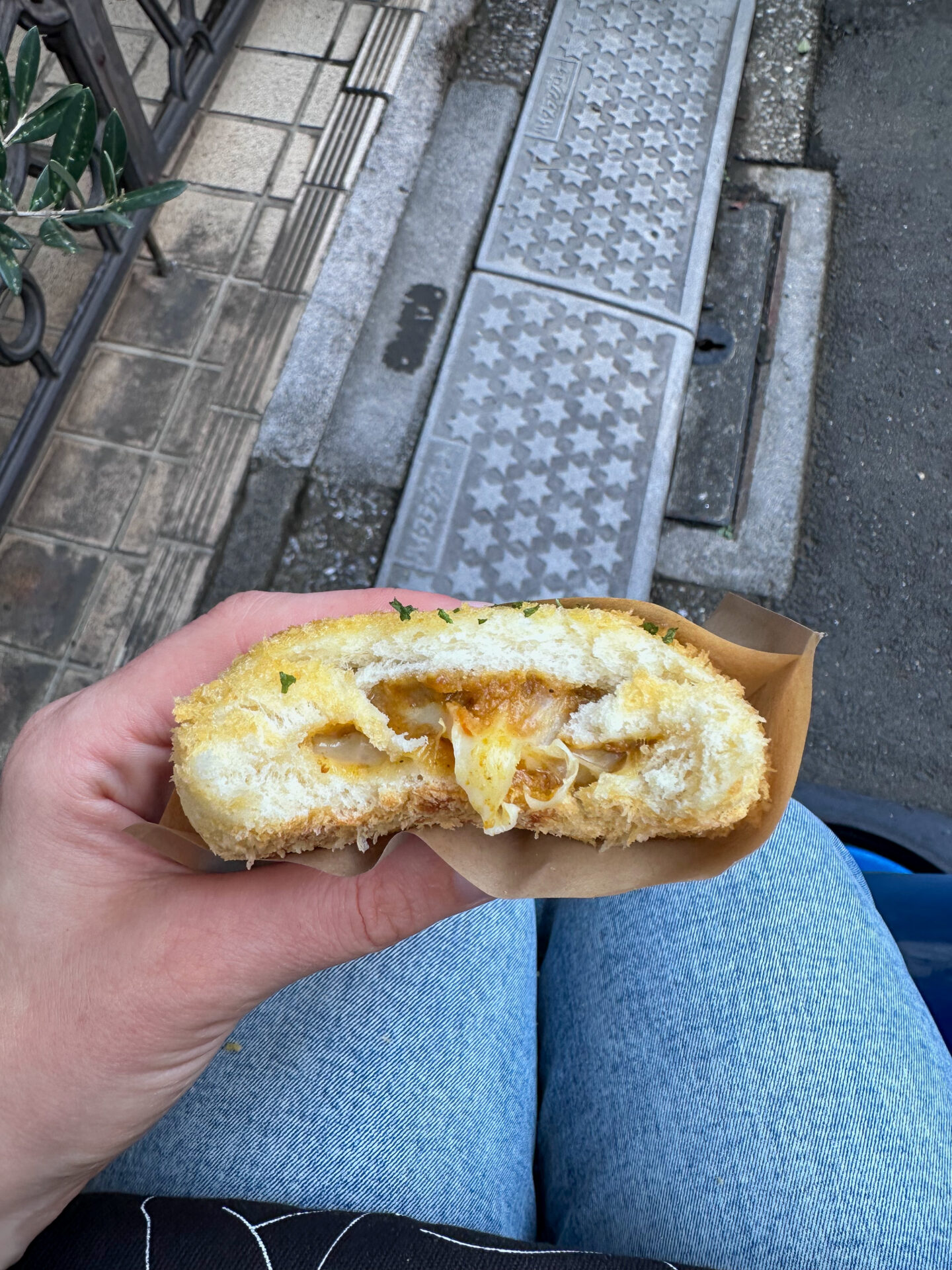
There are several helpful apps to download
Before embarking on your solo trip to Japan, there are a few helpful apps to download.
Japan Travel by Navitime
If I could only use one app in Japan it would be this one. The Japan Travel app is incredibly useful. It’s similar to Google Maps in that it will tell you how to get somewhere, but I found it to be a lot more accurate. It tells you the best place to sit on the train and which exit to use to get to your destination. I’d have been lost without this app.
The best part about the Japan Travel app is you’re able to say which rail pass you have. Whether it’s a JR pass or a regular Metro pass, it will tell you if the route is included on the ticket or not.
It makes travelling in Japan so much easier and less stressful.
Google Maps
While the Japan Travel app is useful for bus and train journeys, I’d still recommend downloading Google Maps for navigating the cities on foot. Download the maps offline in advance first so you can get around Japan without the internet.
Google Translate
This is another app I could not have lived without while in Japan. There are a couple of major language barriers in Japan. The locals don’t speak much English, but you’ll also find many menus or shopping items are only in Japanese. The Google Translate app is a great solution for this. You can type in what you want to say and show it to the locals. It’s also possible to take photos of writing and the app will translate it for you.
Many Japanese locals also use a translation app when communicating with tourists.
The tap water in Japan is clean and safe to drink. However, I found it tricky to fill up my reusable bottle during the day. Thankfully, the Mizu app is here to solve that problem.
The app shows you the nearest place to fill up your reusable bottle. This is sometimes water refill stations or cafes that will happily do it for you even if you’re not a customer.
Always carry cash
Despite being home to many major cities and modern inventions, Japan is still very much a cash-first country. Many local restaurants and cafes only accept cash.
It’s important to always carry cash with you in Japan. Some places will accept debit or credit cards, but I had a few issues so would recommend sticking to cash as much as you can.
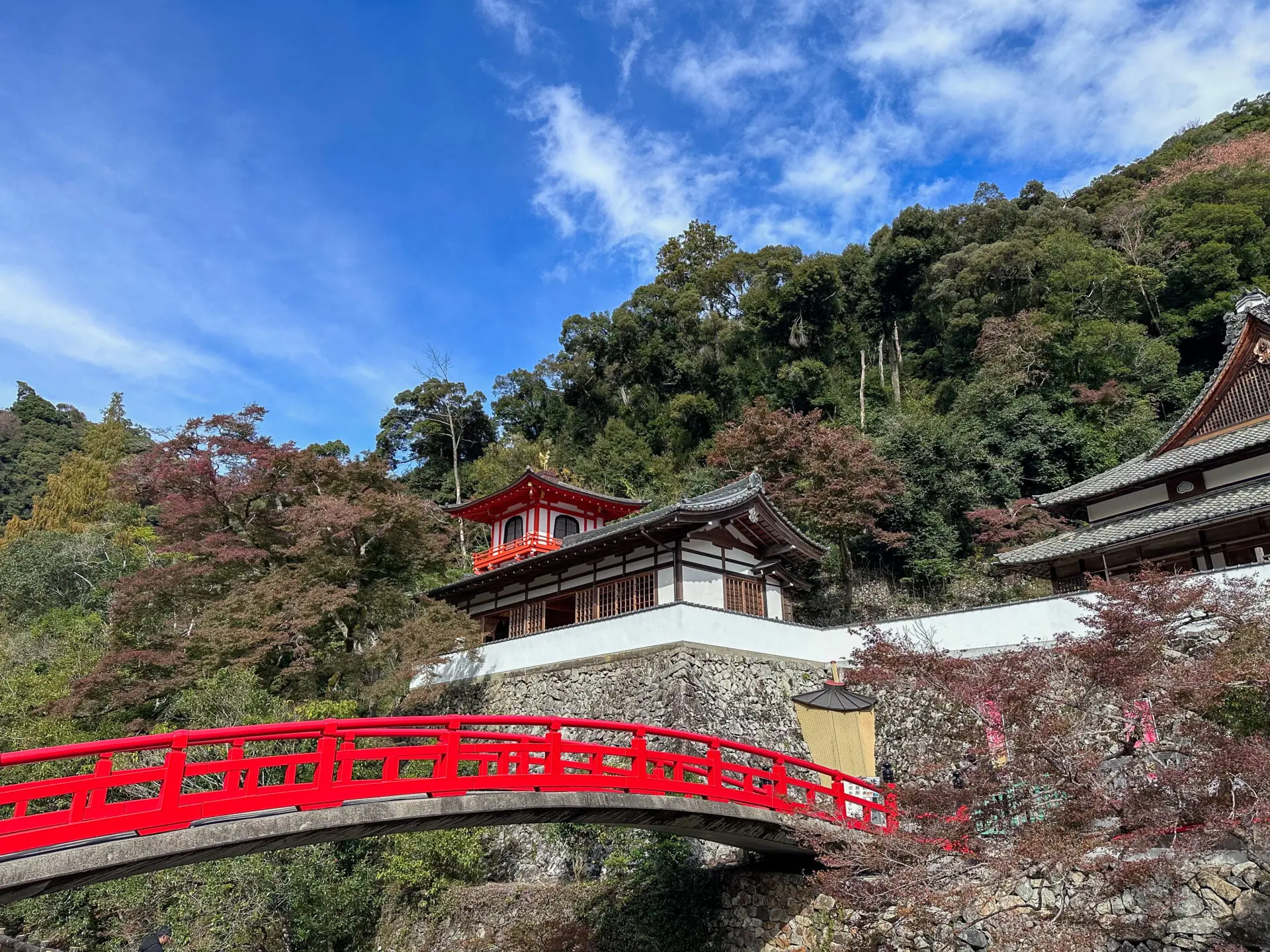
Be aware of scams and crime
Japan is a very safe country, but crimes and scams do occur, especially in the big cities. When travelling solo in Japan, it’s important to exercise some caution.
One of the most common types of scams in Japan is nightclub scams. This is when tourists are lured into bars and clubs. The staff keep the drinks coming and then charge an excessive amount on the bill. The receipts are nearly always in Japanese which means many victims fail to notice until it’s too late. They often add random charges such as charging for seats or charging for being there on a weekend. If you’re invited into a bar, the best thing is to say no.
If you’re a female solo traveller, it’s always important to follow some basic safety guidelines wherever you are in the world. Yes, Japan is very safe and the chances of something happening are low. But that doesn’t mean it’s a good idea to go walking down dark alleys alone at 3 am.
You might need to book ahead of time
One of the best things about solo travel is having the freedom to do what you want and change your plans. However, this isn’t always the case in Japan.
Each year, millions and millions of people head to Japan to explore this amazing country. If you’re visiting Japan during the peak season, you may need to book your accommodation, transport and activities ahead of time. The busiest months in Japan are March, April and May. The summer holidays and autumn months can also see a spike in visitors.
I booked my accommodation about six weeks before my November trip. I found many of the budget hostels with a good rating had almost sold out (and some had completely sold out). Activities such as TeamLab Tokyo and the Harry Potter Studio Tour had also almost sold out.
Solo travellers without a fixed timeframe might not need to worry about booking ahead. However, if you have a set amount of time and there are specific things you want to see and do, I’d advise booking ahead.
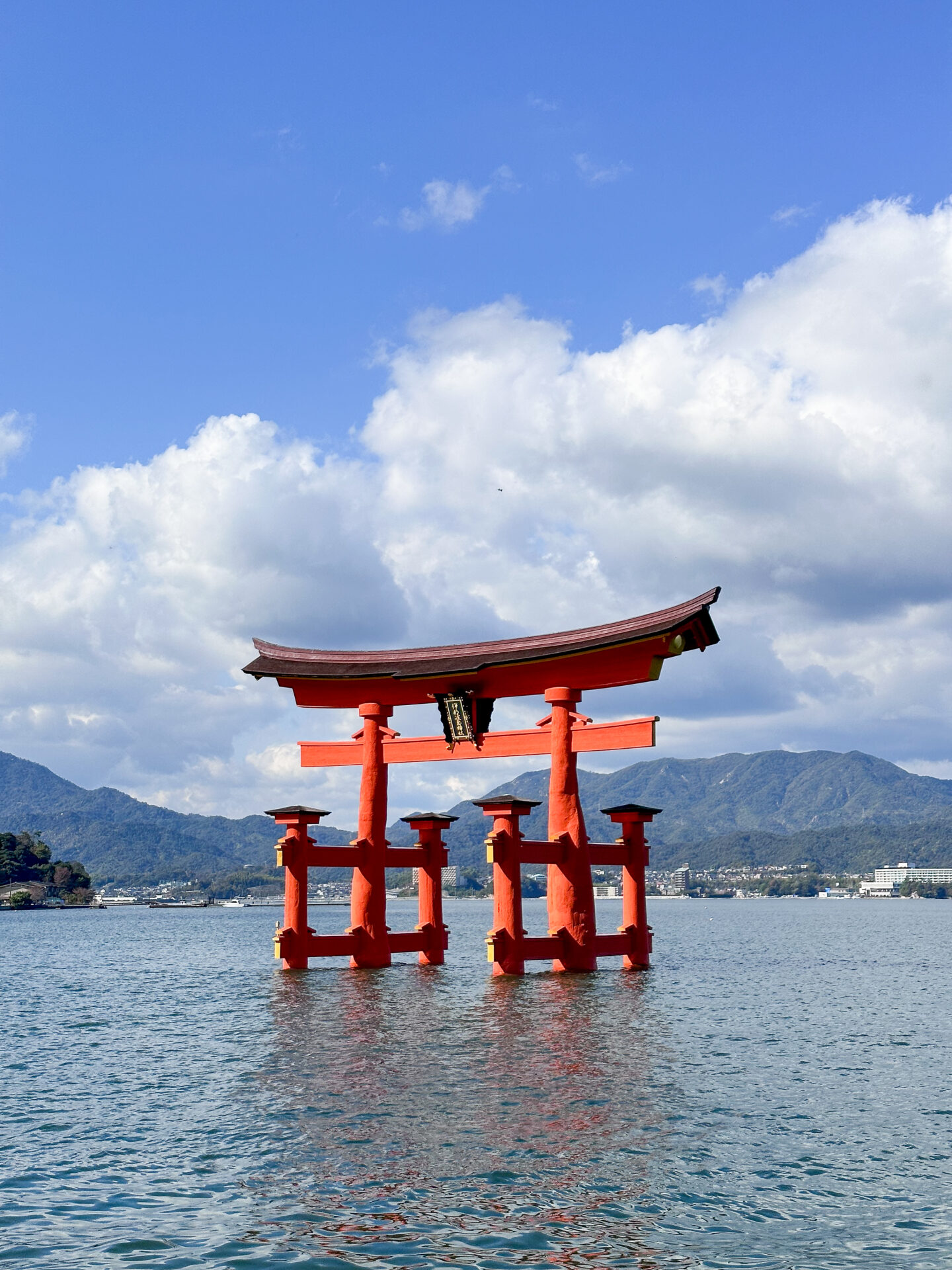
Avoid tourist traps
Solo travel in Japan is a great opportunity to immerse yourself in Japanese culture and local life. You have the complete freedom to do what you want and at your own pace.
One thing I noticed in Japan was the amount of tourist traps. These were usually destinations only popular thanks to TikTok and other social media platforms. As a solo traveller, you have the choice to completely avoid these and don’t need to worry about what someone else might want to do.
Consider going off the beaten track while on your visit to Japan. You can still visit the likes of Tokyo and Kyoto, but consider exploring some lesser-visited areas of the cities such as Yanaka Ginza or Uji . There are also plenty of amazing day trips from Tokyo and Osaka to lesser-visited destinations. I was gutted I didn’t get to explore more of these destinations.
My next trip to Japan will certainly be more focused on escaping the crowds and discovering hidden spots.
Consider group tours in Japan
If you’re nervous about solo travel in Japan, consider a group tour. Small group tours are an amazing way to explore a country if you’re too nervous to travel completely alone.
Related read: everything you need to know about group tours
There are several small group tour operators in Japan. Each of the tours includes a tour guide, accommodation, transport and some activities. Some of my favourite small group tour operators in Japan are G Adventures , Intro Travel and One Life Adventures . Intrepid are another fantastic option, and they tend to cater towards an older demographic.
If you want to visit Japan but are nervous about going alone, group trips could be the answer!

Buy an eSim
It’s a good idea to stay connected while in Japan. As a solo traveller, it’s good to have a way of contacting someone in case of an emergency. In Japan especially, I found myself using my phone more than ever. This was mainly due to using the Google Translate App, or quickly researching something while out and about.
SIM Cards in Japan aren’t quite as straightforward as in other countries. Tourists can only buy data plans and they are very expensive.
The best solution is to buy an eSim. It’s still expensive, but it removes the need to worry about a physical SIM.
Normally, I’d recommend using the trusty Airalo. For Japan, I suggest using Ubigi . Ubigi has a much better network in Japan compared to Airalo.
Summary: is Japan good for solo travel?
Yes, Japan is great for solo travellers. When it comes to safety and getting around, it doesn’t get much better than Japan. Not only is Japan one of the safest countries in the world, but it has a great infrastructure making it an easy country to navigate.

However, I don’t think Japan is the best destination for every first-time solo traveller. Japan can sometimes feel very isolating. You need to be confident in the busy cities, deal with cultural differences and overcome the language barrier all by yourself. You also need to be comfortable with your own company and happy to explore Japan by yourself.
I haven’t said that intending to discourage solo travel in Japan. I just want to be entirely honest based on my experience in Japan. It’s a completely different solo travel experience to the likes of Thailand, Mexico or Australia. Having said that, solo travel in Japan is an amazing way to push yourself out of your comfort zone and immerse yourself in the culture.
If you’re a confident solo traveller, then Japan is one of the best solo travel destinations in the world. With a low crime rate, fantastic public transportation and unique attractions steeped in history, it is an incredible destination.
Ultimately, only you can decide if Japan is the right solo travel destination for you. Put it this way, I’m glad I went to Japan alone. But I’m also glad it wasn’t my first solo trip. However you travel in Japan, it will no doubt be an unforgettable experience!

Related Posts
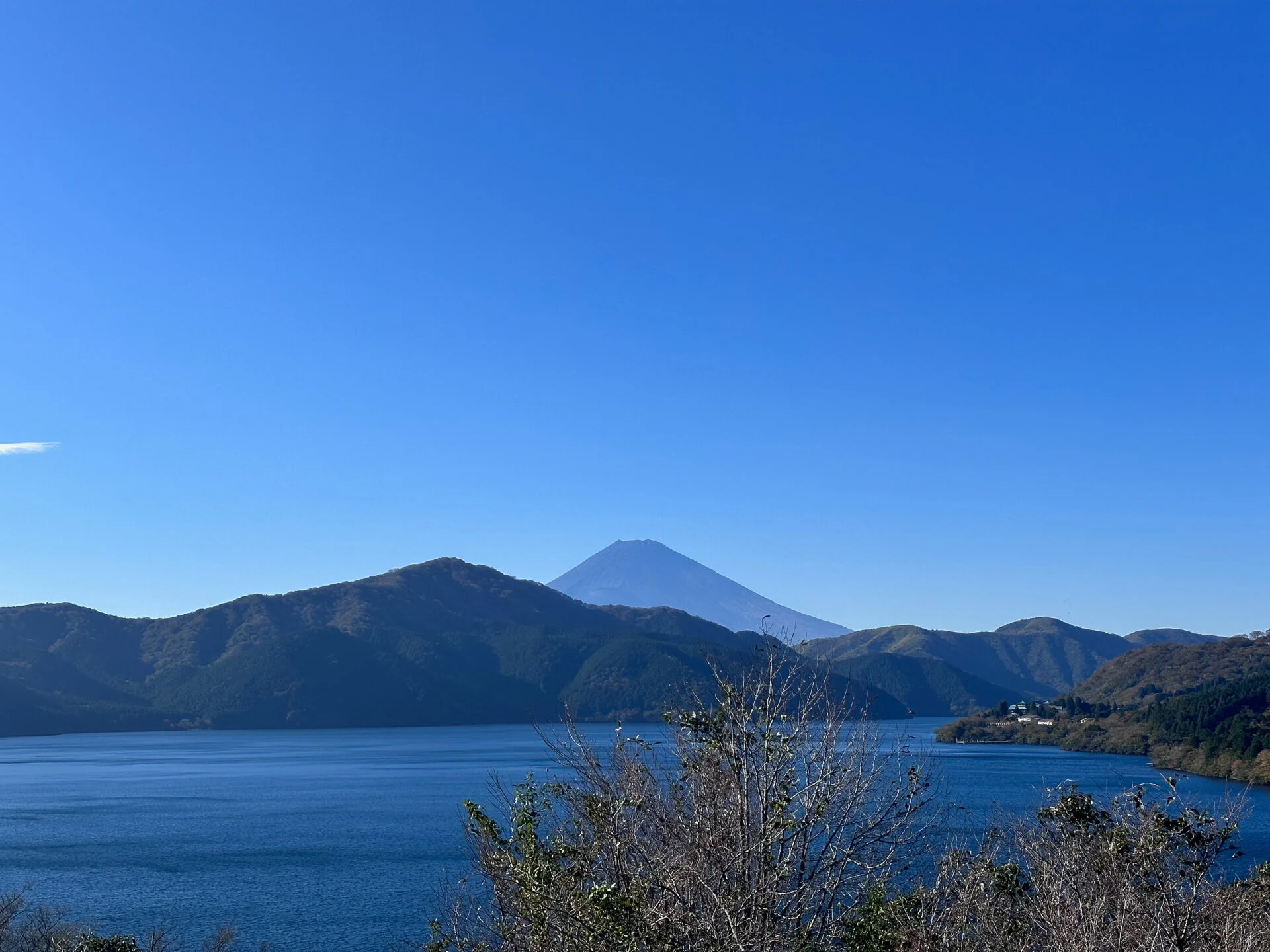
Is Hakone Worth Visiting? 10 Great Reasons to Convince You It Is

Harry Potter Studio Tour Tokyo: How to Visit and an Honest Review
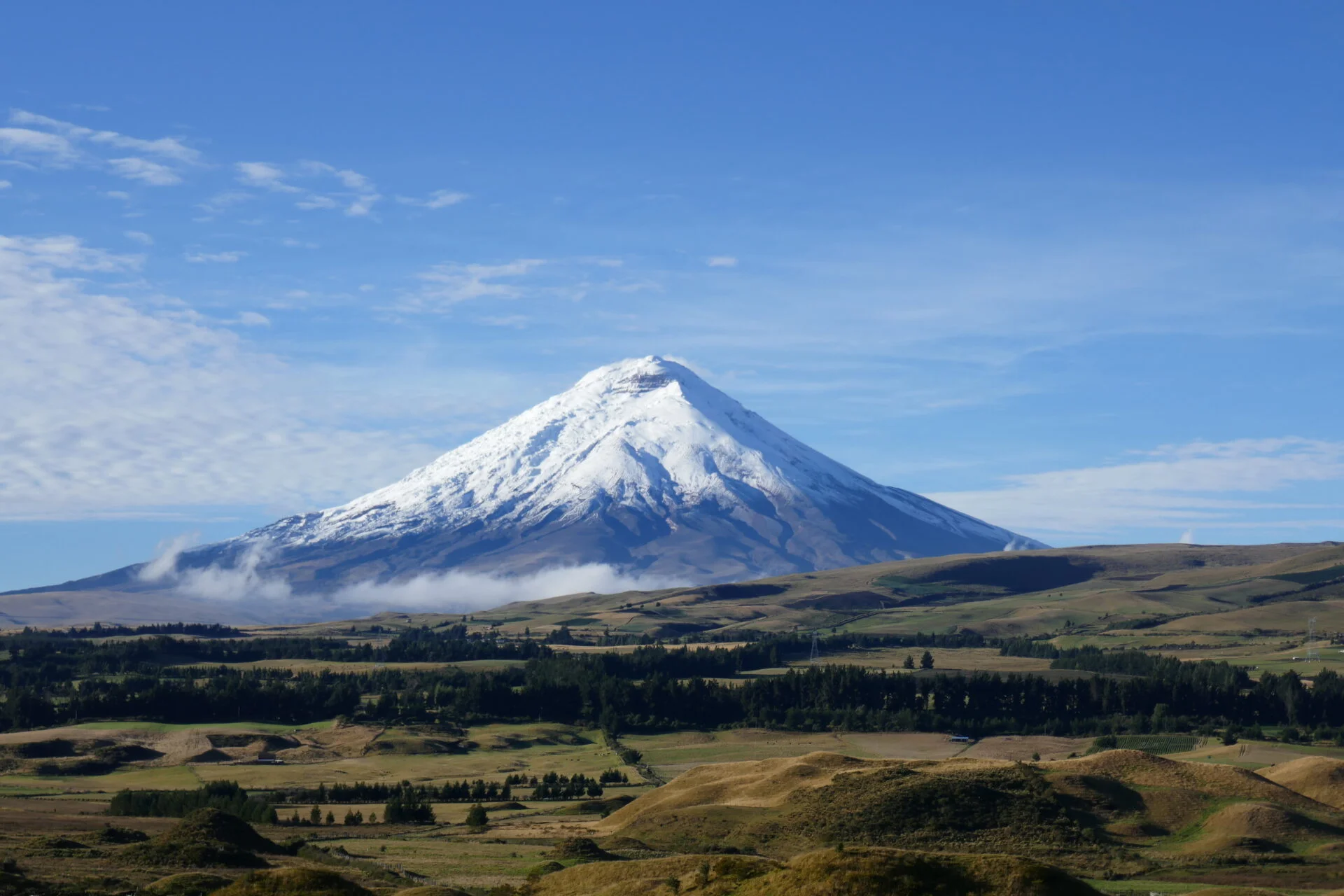
Is Ecuador Safe for Solo Female Travellers? A Guide to Solo Travel and Staying Safe

Ecuador: Backpacking Route and Itinerary
- Travel tips
Solo Travel in Japan: 17 Best Cities to Visit in Japan
Japan is one of the best countries to travel alone for the first time. As the 9th safest country in the world, Japan has many things to do. From metropolitan cities to rural villages and places off the beaten path, there is something for everyone.
I’ve been to Japan many times and honestly say it is one of my favourite countries. In this post, I put together a list of the best cities to visit in Japan for solo travellers who have never been to Japan before. I hope this list will inspire you to take your first solo trip to Japan.
Disclosure: This post may contain affiliate links. If you buy something through them, I will receive a small commission at no additional cost. Thank you for supporting this website. For more information, please read the disclosure for more info.
Solo travel to Japan: travel tips
Before taking your first solo trip to Japan, check out my post on everything you need to know before going to Japan . I included many travel information, including how to get around Japan and other travel tips.
Here are a few quick travel tips for travelling to Japan alone:
- Get an IC Card , a rechargeable smartcard that allows you to take public transportation, including trains, buses, subways, streetcars and ferries. You can use the same IC Card throughout your entire trip in Japan
- Instead of exchanging Japanese Yen (¥) at home, take cash from ATMs at convenience stores like Family Mart and 7-Eleven while you are in Japan
- Either buy a SIM card when you arrive or rent portable pocket wifi before your trip to Japan so you can stay connected at all times
- If you are travelling solo in Japan for a few weeks, consider buying a JR rail pass for 7, 14 or 21 days to save money on transportation and time
Japan solo travel: 17 best cities to visit in Japan alone
Wondering where to visit in Japan alone? I’ve travelled to Japan by myself many times, and I compiled a list of the best cities to visit in Japan for solo travellers who have never been to the country before. But the list is also useful for travellers who want inspiration on places they haven’t been to.
So here are my 17 best places to visit in Japan for solo travellers.
1. Tokyo: a must-visit city for a first solo trip to Japan
Tokyo is the perfect city to start your solo trip to Japan. As the capital city and the country’s biggest city, Tokyo has many neighbourhoods to explore, learn about Japanese culture, and experience city life in Japan.
And if it is your first time in Tokyo, don’t miss neighbourhoods such as Shinjuku, Harajuku, Shibuya, and Omotesando , where you see all the touristy sites. And if you want to get off the beaten path, visit Kichijoji and Shimokitazawa for a laidback vibe.
You can get a good feel of the city by spending about 5 days in Tokyo .
Best things to do in Tokyo
- Walk across the famous Shibuya Crossing , the world’s busiest intersection
- Visit many temples and shrines, including Asakusa, Gōtokuji Temple , and Nezu Shrine
- Shop at local boutique shops in Harajuku and Omotesando
- See a large-scale interactive light and art installation at teamLab Planets
- Visit modern art museums such as 21_21 Design Sight and Mori Art Museum

2. Hakone: traditional hot spring town
Hakone is a traditional Japanese onsen (hot spring) town in Kanagawa Prefecture. Most people will take a day trip to Hakone from Tokyo. Still, it is worth splurging and spending a night in one of the many traditional Japanese ryokans (traditional Japanese inns with tatami-matted rooms).
Besides experiencing a natural hot spring, tour Hakone where you can see a sulphuric volcano , cruise across a peaceful lake and hike around the rural countryside .
And if possible, visit Hakone during the off-season or weekdays to avoid the crowd. Hakone is one of the most popular places to visit in Japan.
Best things to do in Hakone
- Experience traditional onsen accommodation by staying overnight at a Japanese ryokan
- Enjoy the art installations at the Hakone Open-air Museum
- Take the Hakone Ropeway to see the sulphuric Owakudani Valley
- Hop on the relaxing Hakone Sightseeing Cruise for a trip across Lake Ashinoko
- Hike around Lake Ashinoko and look for Hakone Shrine and Hakone Jinja Heiwa-no-Torii

3. Sapporo: gateway to the island of Hokkaido
Sapporo was once a tiny city in northern Japan. But the city grew and became famous in 1972 because of the Winter Olympics in Sapporo. Today, Sapporo is the fifth-largest city in Japan and is known for its winter attractions, beer and cuisine .
Besides skiing and other winter sports , travellers visiting northern Japan can use Sapporo as a home base and explore other parts of Hokkaido , including many different ski resorts and scenic hotspots.
And you cannot leave Sapporo without trying the local cuisine , including hairy crab, ramen , desserts made with Hokkaido milk and Sapporo Beer .
Best things to do in Sapporo
- See large-scale ice and snow sculptures at Sapporo Snow Festivals in early February
- Take a guided tour and sample beers at the Sapporo Beer Museum
- Eat fresh Hokkaido seafood at Nijo Market and Curb Market
- Go skiing at Mount Teine or Sapporo Kokusai Ski Resort
- Visit Furano and Biei Blue Pond as a day trip

4. Nagano: a winter wonderland with snow monkeys
Nagano is one of Japan’s best cities to visit if you love winter sports ! The resorts outside Nagano have excellent conditions for skiing, snowboarding and other winter activities . Some of the best places for skiing include the slopes of Hakuba , one of the Winter Olympics locations in 1998.
Another highlight of Nagano is the numerous onsens (hot springs) around the region. Notably, the hot springs in Yamanouchi are very popular with their local “residents,” aka snow monkeys .
Best things to do in Nagano
- Ski or snowboard at one of the resorts just outside of Nagano City
- Visit a traditional Japanese onsen (hot spring) like Nozawa Onsen
- See snow monkeys bathe in local hot springs in Jigokudani Wild Monkey Park in Yamanouchi
- See traditional Japanese paintings at Nagano Prefectural Shinano Art Museum
- Take a day trip to see Matsumoto Castle , the oldest five-story six-floor castle in Japan
View this post on Instagram A post shared by 🏔𝐆𝐨 𝐍𝐀𝐆𝐀𝐍𝐎【長野県 観光 公式インスタグラム】 (@nagano_japan)
5. Takayama: explore the rural countryside
If you enjoy hiking and exploring the rural countryside, you might want to check out Takayama . The city is tucked away in the mountains in Gifu Prefecture and is the gateway to the Japanese Alps on the main island of Honshu .
Besides wandering the charming Old Town of Takayama, most visitors will visit Shirakawa-go , a UNESCO Heritage village with hundreds of thatched-roof houses . The picturesque town can be visited any time of the year but is especially beautiful during winter.
And if you are visiting Takayama during the warmer months, take a hiking trip in Kamikochi , which is in the Chubu Sangaku National Park .
Best things to do in Takayama
- Wander around the historic Sanmachi Suji District in Takayama’s Old Town
- Visit the picturesque Hida no Sato , a group of thatch-roof houses
- Take a day trip to Shirakawa-go , a UNESCO World Heritage Site, to see 100+ thatch-houses
- Attend Takayama Matsuri Festival on April 14/15 or October 9/10
- Hike Kamikochi and see alpine sceneries that are part of the Japanese Alps
View this post on Instagram A post shared by Shirakawago 白川郷 (@shirakawa_go)
6. Kyoto: temple hop around the old capital city
Kyoto was once the old capital of Japan and was home to several emperors. And as one of the bigger cities in Japan, Kyoto has many historical buildings and monuments including 1,600 temples!
But you don’t need to see all 1,600 temples to feel the city. You can spend 2 days in Kyoto and visit a few important temples, including Kinkakuji (Golden Pavilion) , Ginkakuji (Silver Pavilion) and Kiyomizudera Temple .
And don’t leave Kyoto without seeing the famous bamboo forest and walking through hundreds of orange torii gates . And for an added bonus, you can rent a kimono or yukata in Gion and walk around the area in traditional Japanese clothing.
Best things to do in Kyoto
- Admire historical temples like Kinkakuji (Golden Pavilion) , Ginkakuji (Silver Pavilion) and Kiyomizudera Temple
- See thousands of bamboo in Arahiyama Bamboo Grove
- Walkthrough hundreds of orange torii gates at Fushimi Inari Shrine
- See cherry blossom in full bloom (late March to early April) at Philosopher’s Path, Maruyama Park and Kamogawa River
- Rent a kimono or yukata in Gion and see if you can spot a geisha

7. Osaka: the third-largest city with a vibrant nightlife
As the third-largest city in Japan, Osaka is one of Japan’s top-visited cities. Osaka attracts millions of visitors yearly because of its abundance of history, vibrant nightlife , and unique local cuisine .
And the city is well situated in the centre of Honshu Island . Located in the Kansai Region , international travellers can fly directly into Kansai International Airport (KIX) and arrive in Osaka within an hour.
It is possible to see all the best sites in Osaka in 2 days while travelling in Japan alone. But if you want to stay longer, you can use Osaka as a home base for day trips to Nara, Kyoto, Himeji, and Koyasan.
Best things to do in Osaka
- See hundreds of cherry blossom trees in full bloom (late March to early April) at Osaka Castle
- Make a wish and pour water over the green moss Fudo Myo-o statue at Hozenji Temple
- See all the bright lights and signages, including the Glico Running Man in Dōtonbori
- Visit Shinsekai , an old district in Osaka with cheap eateries and entertainment
- Try a few Osaka food including takoyaki (octopus ball), okonomiyaki (savoury pancake with noodles and cabbage) and kushikatsu (deep-fried skewered food)

8. Nara: oldest Buddhist temples + friendly deers
Just outside of Kyoto and Osaka is a small quaint town called Nara . As it was the ancient capital city of Japan in 710, many Buddhist monasteries and temples were built in Nara. This is why Nara has some of Japan’s oldest and largest shrines and temples . And many of these are UNESCO World Heritage Sites .
But most people visit Nara because they want to see wild deer . While you rarely see deer in Old Nara City, most hang around Nara Park and other green areas on the temple grounds. And you can even buy crackers to feed the deer!
Most visitors take a day trip to Nara from Kyoto or Osaka . But if you are slow travelling through Japan, consider spending more than a day in this quaint town.
Best things to do in Nara
- Visit Tōdai-ji Temple , the world’s largest wooden building with a bronze Buddha statue
- Attend Omizutori (March 1 to 14), the oldest annual Buddhist event at Nigatsudo Hall
- Wander around Old Nara City and see local shops and residential homes
- Watch a live demonstration of the making of yomogi mochi at Nakatanidou
- Buy crackers and feed them to the friendly deers in Nara Park

9. Kobe: try the best beef in Japan
You may have heard of the world-famous Kobe beef , a type of Wagyu beef with tender and very juicy meat. It is from Tajima black cattle raised in Hyogo Prefecture , where Kobe is located.
Besides trying Kobe beef in Kobe, there are many things to eat and do in the busy port city. When you visit Kobe as a day trip from Osaka , wander around the culturally influenced districts and neighbourhoods , hike up the nearby mountains , and see panoramic views of Kobe .
And if you have more time in Kobe, explore Japan’s oldest hot spring town and try the famous “Kinsen golden hot spring,” where the spring water turns reddish-brown once the water touches the air.
Best things to do in Kobe
- Try a teppanyaki Kobe Beef lunch set at Steakland (cheaper at lunch)
- Visit several foreign residences in the historic Kitano-cho district
- Stroll around Kobe Harbour in the evening and see the tall and bright Kobe Port Tower
- Hike up Mount Rokko to see a panoramic view of Kobe
- Experience the famous “Kinsen golden hot spring” in Arima Onsen

10. Himeji: visit one of the top three most beautiful castles
And one of the highlights of Himeji has to be Himeji Castle . It is one of the top three most beautiful original castles in Japan. As a UNESCO World Heritage Site, it is Himeji’s biggest attraction!
Besides, see the “white heron castle,” there are also beautiful Japanese gardens , art museums and temples hidden away in the mountains .
Himeji City is a compact city and can be visited as a day trip from Osaka . The city is only 100km west of Osaka, and if you take the Shinkansen (bullet train), you can be in the quaint city in less than half an hour.
Best things to do in Himeji
- See a view of Himeji from the top level in Himeji Castle
- Visit the traditional Japanese gardens in Koko-en Garden
- Take the Shoshazan Ropeway up to Mount Shosha and wander around the 1,000-year-old temple complex called Engyō-ji Temple
- See a large European art collection at the Himeji City Museum of Art
- Try local Himeji food including menme udon (udon with raw egg) and conger eel with egg on rice

11. Naoshima: the modern contemporary Japanese art island
Yayoi Kusama. Tadao Ando. James Turrell. Walter De Maria . If these names mean anything to you, then you must visit Japan’s best art island, Naoshima .
The small island in Kagawa Prefecture became a contemporary art centre in the 80s when Japan wanted to revolutionize the art scene and create a world-class attraction.
Today, you will find a famous polka dot art installation on the island. Yayoi Kusama’s Yellow Pumpkin became the iconic symbol for Naoshima. Some people might even call it the Naoshima Pumpkin .
Moreover, the island is full of modern architecture designed by Tadao Ando , a Japanese architect known for his modern design and concrete architecture.
As contemporary art lovers, you do not want to miss all the museums and art installations on the small island in the Seto Inland Sea . You can easily see all the art exhibits and museums on Naoshima Island in one day .
Best things to do in Naoshima
- Take photos with the famous Yellow Pumpkin and the Red Pumpkin
- See contemporary art and installations by Claude Monet, James Turrell and Walter De Maria at Chichu Art Museum
- Admire Tadao Ando’s contemporary concrete building at Lee Ufan Musem
- See the permanent and temporary modern art collection at Benesse House Museum
- Visit Teshima , another (but smaller) contemporary art island

12. Kurashiki: a picturesque historic canal town
Kurashiki might be one of the best off-the-beaten-path cities in Japan . Known for its picturesque canal with weeping willow trees , distinctive local architecture style , and delicious local cuisine , Kurashiki has many things to do and is a city you should not miss!
Located in Okayama Prefecture , the charming little town was an important point along the distribution route for Japan’s most prized commodity, rice. Today, you will find many old rice warehouses converted into restaurants, cafes and local retail stores .
Even though Kurashiki is not as famous as other cities in Japan, it is worth visiting, especially if you enjoy the small-town charm and see a preserved historic town .
Best things to do in Kurashiki
- See a picturesque canal with weeping willow trees in Kurashiki Bikan Historical Quarter
- Hike up Tsuragatayama Hill and see an unobstructed view of Kurashiki
- Visit many temples in Kurashiki, including Achi Shrine , Kanryuji Temple , and Honeji Temple
- Take note of the traditional Kurahiski houses that have an austere white-wash wall with black and white latticework patterns
- Try a blue-coloured food on Kurashiki Demin Street

13. Onomichi: gateway to Japan’s best bikeway
Onomichi is a quaint port town known for its temples, cats and cycling . Many people may not know this small town in Hiroshima Prefecture , but if you are looking for off-the-beaten-track places in Japan, Onomich is one of the best places to visit in Japan.
While there are many things to do in Onomichi as a solo female traveller, you can comfortably see everything in a day or two.
But you should set aside two days in your itinerary and cycle Japan’s best bike route, Shimanami Kaido . The 60km bikeway connects six islands in the Seto Inland Sea where you can cycle from Onomichi to Imabari . It takes a full day to cycle to Imabari and another day back to Onomichi. But if you have limited time, you can still cycle Shimanami Kaido in one day .
Best things to do in Onomichi
- See 25 temples along Onomichi Temple Walk , including Tennei-ji Temple
- Take the Senko-ji Mountain Ropeway to the top of Senko-ji Park , where you can see a view of Onomichi and cherry blossoms in the spring
- Hike up Jodo-ji Mountain and see Onomichi from another angle
- Try a bowl of Onomichi ramen (soy sauce-flavoured soup stock with flat noodles) at Ramen Miyachi
- Rent a bike and bike along Japan’s best bikeway, Shimanami Kaido

14. Hiroshima: the “City of Peace”
Most travellers visit Hiroshima to see the monuments dedicated to Hiroshima’s legacy of surviving the atomic bomb during World War II. The Hiroshima Peace Memorial Park monuments commemorate those affected and remember peace.
Besides seeing all the monuments in the “City of Peace,” Hiroshima has many things to do, including a castle, art museums, and Japanese gardens . And you can comfortably see the best attractions in Hiroshima in 2 days .
And if you are a foodie, try Hiroshima’s local cuisine, which includes oysters, conger eel, ramen and okonomiyaki.
Best things to do in Hiroshima
- Visit WWII monuments in Hiroshima Peace Memorial Park , including Cenotaph for the A-bomb Victims , the Flame of Peace , the Children’s Peace Monument , and Atomic Bomb Dome .
- Admire contemporary Japanese artwork at the Hiroshima Museum of Art and Hiroshima Prefectural Art Museum
- See a panoramic view of Hiroshima at Hiroshima Orizuru Tower
- Visit different miniature gardens at Shukkeien Garden
- Try local Hiroshima cuisine like Hiroshima-style okonomiyaki , Hiroshima Tsukemen , oysters , and anago (eel)

15. Miyajima: best day trip from Hiroshima
If you are going to Hiroshima, you must take a day trip to Miyajima . The small island is easily accessible from Hiroshima, and you can see everything in one day.
The highlight of Miyajima Island has to be its Itsukushima Floating Torii Gate. This giant orange torii gate seems to be floating on the water near Itsukushima Shrine , a UNESCO World Heritage Site.
Besides seeing the floating giant torii gate during high tide, hike up Mount Misen or take the ropeway and see a panoramic view of the Seto Inland Sea and friendly wild deers roam around the island.
Most people will visit Miyajima and return to Hiroshima. But if you want to splurge, you can stay at one of the Ryokans on Miyajima and experience Japanese hot springs in a traditional hotel .
Best things to do in Miyajima
- Admire Itsukushima Floating Torii Gate during high tide (in the morning)
- Get up close to the giant orange torii gate during low tide (late afternoon)
- Wander around Itsukushima Shrine , Momijidani Park , Daishoin Temple
- Hike up Mount Misen and see a panoramic view of the Seto Inland Sea
- Try local culinary delights such as oysters , anago meshi (conger eel), fried fishcake and momiji manju (small cake shaped in Japanese maple leaf with different fillings).

16. Fukuoka: eat your way around the city
Fukuoka is the biggest city on Kyushu Island and the 7th biggest city in Japan. And while Fukuoka has many things to do , the best highlight has to be its culinary scene .
The city is known for its Hakata Ramen or Tonkotsu Ramen . You can get a creamy pork bone broth with thin ramen noodles anywhere in the city. And since Fukuoka is udon noodle’ s birthplace, you must try a bowl or two because it is oh-so-delicious!
Besides soup noodles, try other culinary delights such as motsunabe (hot pot with beef offal), mizutaki (hot pot with local jidori chicken), fresh squid sushi , mentaiko (spicy pollock roe), Hakata Amaou strawberries and wash it all down with local sake .
Most of all, try eating at one of the local open-air food stalls called yatai . There are over 150 yatai’s in Fukuoka (mostly along Nakasa River), where you can enjoy wholesome Japanese foods.
Best things to do in Fukuoka
- Try the Shiromaru Classic Hakata Ramen at Ippudo , a famous ramen restaurant in Fukuoka
- Sample other local Fukuoka delights like motsunabe , mizutaki and mentaiko
- Grab a seat at one of the yatai open-air food stalls and eat Japanese food with locals
- Visit local attractions such as Hakata Old Town , Maizuru Park , Fukuoka Asian Art Museum and Hakata Machiya Folk Museum .
- Hop on Nishitetsu Railway and spend a day in Dazaifu

17. Okinawa: a tropical paradise with white sand and crystal clear water
There are more than 150 islands in the East China Sea between Japan’s mainland and Taiwan at the south end of Japan. And one of the most famous islands is Okinawa .
Okinawa is the largest island in Okinawa Prefecture. While the island has many cultural sites, monuments, and unique Okinawan food , most visitors travel to Okinawa for its subtropical climate and beautiful white sand beaches with crystal blue water .
So enjoy all the water activities such as swimming, snorkelling, diving, surfing and seeing all the coral reefs in the area because Okinawa is unlike everywhere else in Japan. You’ll feel like you are in the Caribbean or the Mediterranean!
Best things to do in Okinawa
- Swim in the crystal blue water and play on the white sand beaches of Okinawa
- Participate in many water sports, including snorkelling and diving
- Take a scenic drive around the island of Okinawa
- See marine wildlife in the massive fish tank at Churaumi Aquarium , Japan’s largest aquarium
- Visit Shuri Castle , a royal palace from when Okinawa used to be the Ryukyu Kingdom

Want to travel like a minimalist? Learn how to pack a 7kg carry-on luggage by following my minimalist travel packing list
Solo travel Japan: places to visit in Japan on your own
I hope you find this list of Japanese cities useful for planning your first solo trip to Japan. These are some of the best cities in Japan and are perfect for solo female travellers.
So the big question is: which cities will you visit during your first solo Japan trip? Let a comment below. Or if you have other suggestions, leave that in the comment too!
Thank you for reading my Japan solo travel post
You might also like these other posts on solo travel in Japan:
Introduction to Japan
- Things I wish I knew before going to Japan
- 11 Off-the-beaten-path places in Japan
- Japanese Food Culture: 11 must-try food
- One month in Japan: from Tokyo to Hiroshima
Kanto region
- 5-day Tokyo itinerary for first-time visitors
- Where to stay in Tokyo for solo travellers
- Tokyo Food Guide: 42 best places to eat in Tokyo
Kansai region
- Kyoto 2-day itinerary
- Uji day trip from Kyoto
- Nara day trip from Kyoto or Osaka
- 2-day Osaka itinerary
- Where and What to Eat in Osaka, Japan
- Osaka to Kobe day trip: 1-day itinerary
- Best food in Kobe: Where and What to Eat
- Himeji day trip from Osaka
Chugoku region
- Naoshima Art Island: 1-day itinerary
- How to spend one day on Teshima Island
- 17 Best things to do in Kurashiki Japan
- 13 Top things to do in Onomichi Japan
- Shimanami Kaido: how to spend one day cycling Japan’s best bike route
- Hiroshima 2-day itinerary
- Day trip to Miyajima from Hiroshima
Kyushu region
- 10-day Kyushu Island itinerary
- 25 Best things to do in Fukuoka Japan
- Day trip to Dazaifu from Fukuoka
- Kumamoto City in one day
- Day trip to Mount Aso from Kumamoto
- 11 Top things to do in Kagoshima Japan
Like this post? Pin it on your Pinterest board!

queenie mak
Hi, my name is Queenie, and I've been a solo traveller for 20+ years and currently based in Hong Kong. Follow me on my adventures through Instagram and my blog!
Further Reading...

Nara Food Guide: Where and What to Eat in Nara Japan

Where to Stay in Kyoto for First Time Traveller: Best Areas and Hotel Reviews

Tokyo Food Guide: Where and What to Eat in Tokyo, Japan
Glad I chanced upon your article which got me interested in Naoshima, Kurashiki, Onomichi and Miyajima. I will be in Tokyo so any recommendation as to how best I should travel to cover all 4 places? I can spend between 5-8 days for this. Appreciate hearing back from you.
Cheers Carol
Hi Carol, those are amazing places! The train will probably be the best way to visit all of these cities. There is a Kansai-Hiroshima Area Pass (rail pass) that includes all of these cities but you’ll have to get from Tokyo to Osaka first. There is an online calculator to determine if you can really make use of a Japan railway pass – google “japan rail pass calculator”. It might be worthwhile to get a rail pass especially if you are travelling everyday. Anyway check out those options. Excited for your upcoming trip! 🙂
Leave a Reply Cancel Reply
Save my name, email, and website in this browser for the next time I comment.
Notify me of follow-up comments by email.
Notify me of new posts by email.
This site uses Akismet to reduce spam. Learn how your comment data is processed .
Trio Beach Hike From Sai Kung To Hebe Haven In Hong Kong
21 things to do in canggu bali indonesia for a solo traveller, ms travel solo.


- Meet The Team
Solo Travel in Japan: Tips and Recommendations
Updated on February 15, 2024

If you’re looking for a unique and exciting travel experience, solo travel in Japan could be just what you need.
Travelling alone in Japan is becoming increasingly popular, especially among younger generations.
Many locals travel alone or do things alone, creating a market aimed at singles.
Despite the language barrier and cultural differences, Japan is a relatively safe and easy country to navigate, making it an ideal destination for solo travellers.
Whether you stick to famous tourist spots or wander off the beaten track when visiting Japan, you’ll be fine.
With efficient public transportation, a wealth of accommodation options, and friendly locals, you’ll have everything you need to make the most of your trip.
So why not take the plunge and embark on a solo adventure in Japan?
Why Choose Japan for Solo Travel
Traveling alone in Japan is an enriching experience. Despite the language barrier and cultural differences, the country is renowned for its safety, efficient transportation, and accommodating locals. From modern cities to ancient temples, Japan offers diverse attractions. Key recommendations include exploring with the help of technology and apps, trying the unique accommodations like Ryokan and Capsule hotels, and savoring the culinary delights even if you’re dining solo. Always remember to get travel insurance for added peace of mind. Adam Payne – Japan Insider Secrets
One of Japan’s most significant advantages of solo travel is the country’s safety.
Japan has a very low crime rate, making it one of the safest countries in the world.

Nonetheless, renting Wi-Fi is a wise choice for consistent connectivity if venturing into less urbanized regions.
Getting Around in Japan
Public transportation is the way to go when getting around in Japan.
The public transportation system in Japan is well-developed, efficient, and reliable.

Public transportation is also cheaper than taking taxis or renting a car.
The train system in Japan is extensive, covering most of the country.
The Shinkansen, also known as the bullet train, is a fast and convenient way to travel between major cities.

These traditional Japanese inns offer a glimpse into Japanese culture and hospitality.
Ryokan typically have tatami-matted rooms communal baths, and serve Japanese-style meals.
Business hotels are a good choice if you’re looking for a budget-friendly option.
These hotels are typically near train stations and offer basic amenities like a bed, bathroom, and Wi-Fi.
They’re often small and compact but can be a good option if you’re looking for a place to sleep.
Finally, capsule hotels are a unique option found in most cities in Japan.
As the name suggests, these hotels offer small capsules for guests to sleep in.

Capsule hotels are typically gender-segregated and have shared bathrooms and showers.
They’re a good option if you’re looking for a cheap and unique experience, but they may not be suitable for claustrophobic travellers.
Experiencing Japanese Culture Alone
Japan is a country steeped in tradition and culture, and experiencing it alone can be exciting and overwhelming.
One of the best ways to experience Japanese culture alone is by visiting an onsen, a traditional Japanese hot spring.
Onsen are found nationwide and offer a relaxing and rejuvenating experience for solo travellers.
Be sure to research onsen etiquette before you go, as there are specific rules and customs that you should be aware of.

Day Trips and Tours
There are plenty of options available, from guided tours to self-guided excursions.
Here are some of the best day trips and tours to consider.
Self-Guided Day Trips
Plenty of self-guided day trip options are also available if you prefer to explore independently.
You can easily take public transportation to nearby cities or attractions and explore at your own pace.
Some popular self-guided day trips in Japan include:
- Nikko : This small town is located north of Tokyo and is known for its beautiful temples and shrines, including the famous Toshogu Shrine .
- Nara: This ancient capital of Japan is located near Kyoto and is home to many historic temples, shrines, and friendly deer roaming the streets.
- Kamakura: This coastal town is located south of Tokyo and is known for its many temples, shrines, and beautiful beaches.

Group Tours
A group or guided tour may be a way to meet other travellers and make new friends.
Many tour companies offer group tours catering to solo travellers, making meeting other people travelling alone easy.
No matter what type of day trip or tour you choose, research and book in advance to ensure availability.
Travel Insurance
When travelling solo to Japan, it is crucial to have travel insurance.
While Japan is a safe country, accidents and emergencies can still happen.
Travel insurance can provide peace of mind and financial protection in unexpected incidents.
Why You Need Travel Insurance
Medical care in Japan is expensive, and without travel insurance, you could face a hefty bill if you require medical attention.
Additionally, travel insurance can cover other unexpected expenses such as trip cancellations, lost or stolen luggage, and emergency evacuations.

What to Look for in Travel Insurance
When selecting travel insurance for your solo trip to Japan, there are a few key factors to consider:
- Medical coverage : Look for a policy that provides adequate medical coverage, including emergency medical expenses, hospitalization, and evacuation.
- Trip cancellation/interruption coverage : This type of coverage can reimburse you for non-refundable expenses if your trip is cancelled or interrupted due to unforeseen circumstances such as illness, injury, or natural disasters.
- Lost or stolen luggage coverage : This type of coverage can reimburse you for the value of your lost or stolen luggage and its contents.
- Emergency evacuation coverage : This type of coverage can provide financial assistance for emergency evacuations due to natural disasters, political unrest, or medical emergencies.

Wrapping Up
Solo travel in Japan is simple compared to most other places.
It is safe, even for solo female travellers, and you can wander anywhere, anytime alone, without issue.
Restaurants cater to lone customers; the only real issue is the Japanese language barrier.
And that can be overcome somewhat with the use of apps .
In major cities, this won’t be an issue.
For the more adventurous solo traveller who wants to go off the beaten path , take advantage of the many available apps.
Happy travels.
Adam has lived in Japan for over 20 years. Married with two daughters, he's fully immersed in Japanese life and has traveled extensively around the country. He works full time from home.

The Ultimate Solo Travel Guide To Japan: Explore Now!
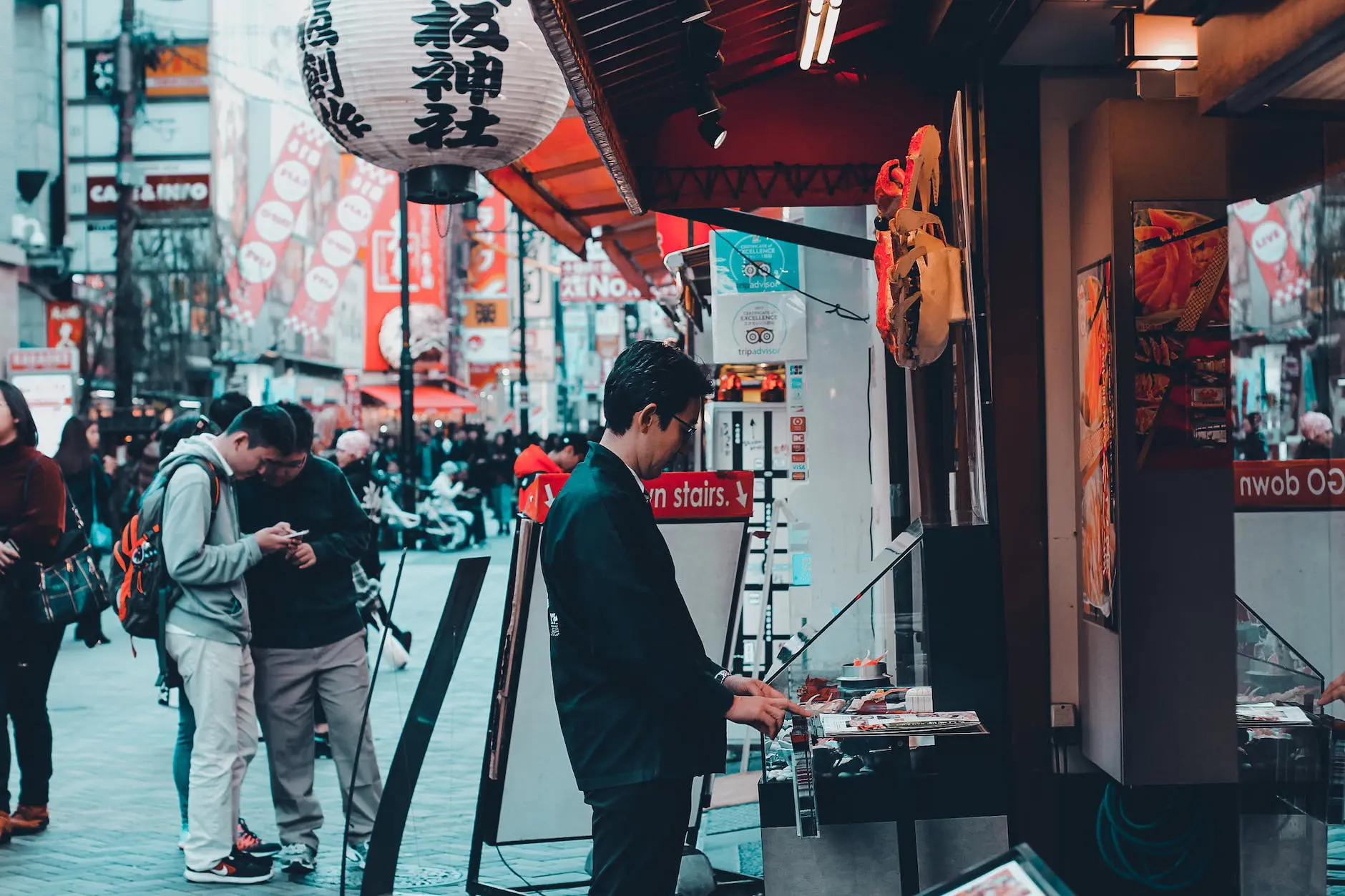
Table of Contents
Solo travel has become a transformative adventure for many, providing an opportunity to explore the world on your terms. Among the diverse destinations, Japan stands out as an enchanting realm for the solo traveler. The Land of the Rising Sun blends ancient tradition and cutting-edge innovation, making it an ideal canvas for self-discovery and exploration. Embarking on a Japan solo travel is a remarkable journey filled with cultural exploration, breathtaking landscapes, and unforgettable experiences.
Japan offers solo travelers an unparalleled voyage with its unique blend of traditional heritage and modern innovation. In this comprehensive guide, we’ll unravel the essence of Japan solo travel, covering essential tips, must-visit destinations, cultural insights, and much more.
Table of Content
Japan travel facts, is japan good for solo travel, best places to visit in japan.
- Where to stay in Japan as a solo traveler
How to get to Japan solo travel?
Best time to visit japan, japan travel itineraries, solo travel advice for japan, is japan solo travel safe, conclusion: japan solo travel.
Japan is often known for its bustling cities, but a lesser-known fact is that forests and mountains cover 70% of the country. There are over 100 active volcanoes, Mount Fuji being the highest at 3,776 feet. Japan boasts 25 UNESCO World Heritage Sites, with 20 being of cultural significance, such as Himeji Castle, and five being natural sites, like Shiretoko National Park.
The country is not limited to Honshu’s main island; it consists of nearly 7,000 islands, making it the fourth-largest archipelago globally. You can visit Ōkunoshima for its population of rabbits or head to Hokkaido for excellent skiing and fresh powder in winter.
Japan is an excellent destination for solo travel. The country is known for its safety, efficient public transportation, and well-developed infrastructure, making it easy for solo travelers to navigate and explore. Japan offers a rich cultural experience, diverse landscapes, and a mix of modern and traditional attractions that can be thoroughly enjoyed alone.
Additionally, Japanese people are generally friendly and helpful, which adds to the positive experience of solo travel in Japan. Whether you’re interested in exploring cities, hiking in nature, enjoying culinary delights, or immersing yourself in the unique culture, Japan has something to offer every solo traveler.

In addition, the Japan National Tourism Organization operates a 24-hour English-speaking helpline, which is especially beneficial for solo travelers. This helpline is an excellent resource for tourism information and assistance, offering valuable support throughout your journey in Japan.
Japan is a fantastic destination for solo travelers, offering a mix of bustling cities, serene temples, beautiful landscapes, and a rich cultural experience. Here are some of the best places to visit for a memorable solo trip to Japan:
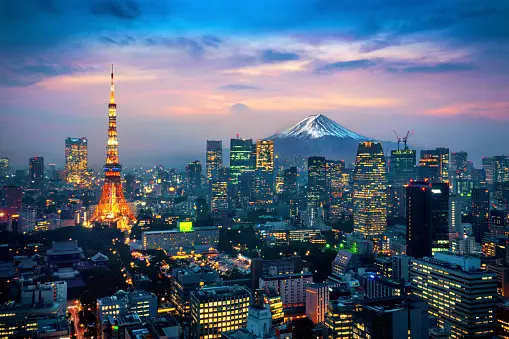
- Explore the diverse neighborhoods of Shibuya, Shinjuku, Akihabara, and Harajuku.
- Visit historic temples like Senso-ji and Meiji Shrine.
- Indulge in the city’s vibrant food scene and try sushi, ramen, and street snacks.
- Wander through iconic temples such as Kinkaku-ji (Golden Pavilion) and Fushimi Inari-taisha.
- Stroll through traditional streets in the Gion and Higashiyama districts.
- Experience a traditional tea ceremony and enjoy Kyoto’s refined cuisine.
- Sample Osaka’s famous street food at Dotonbori and try takoyaki and okonomiyaki.
- Visit Osaka Castle for a dose of history and great city views.
- Explore the bustling entertainment district of Namba.
Hiroshima :
- Explore the Peace Memorial Park and Museum to gain insights into the city’s historical background and commitment to promoting peace.
- Catch a ferry to Miyajima Island and marvel at the iconic “floating” torii gate of Itsukushima Shrine.
- Interact with friendly deer at Nara Park and visit Todai-ji Temple, home to a massive Buddha statue.
- Explore the charming streets and traditional buildings of Naramachi.
- Relax in hot springs (onsen) with stunning views of Mount Fuji.
- Take a scenic boat cruise on Lake Ashi and a ride on the Hakone Ropeway.
- Discover Kenrokuen Garden, one of Japan’s most beautiful traditional gardens.
- Visit the Nagamachi samurai district and explore the Higashi Chaya district for a glimpse of conventional geisha culture.
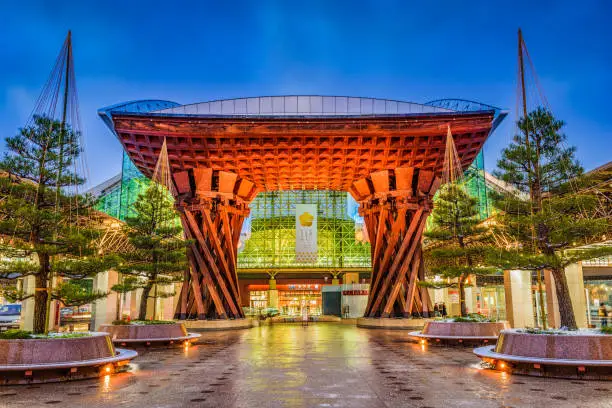
When going to Japan, solo travel To get around fast, take advantage of Japan’s efficient and vast public transit system, which includes trains and buses. Also, consider purchasing a Japan Rail Pass for convenient travel nationwide.
Where to stay in Japan as a solo traveler
What are the accommodation options like in Japan? There’s a wide variety to choose from when traveling solo. Whether you seek a small, unique city hotel, a modern skyscraper lodging, or a quaint countryside inn, Japan has it all. You can discover centuries-old traditional ryokans with tatami-mat floors, natural hot springs (onsen), and exquisite multi-course kaiseki meals, or opt for cutting-edge hotels in Tokyo.
As a solo adventurer, you enjoy more flexibility, but making reservations well in advance is advisable. Japanese accommodations tend to fill up quickly, especially in urban areas and during peak seasons. If you join a group tour like Flash Pack, you can avoid the hassle of arranging hotels and often share a room with a fellow solo traveler, reducing the single supplement cost. If you still prefer having your space, that option is also available.
Related article: Affordable Delicious Japanese Food-Best Budget Eats in Japan
Embarking on Japan solo travel typically starts with a flight. Several airlines, such as Japan’s ANA and Nippon Airways, offer direct flights from international locations like the US, Canada, and the UK to major cities like Osaka, Tokyo, and Nagoya on Honshu island.
Alternatively, traveling by ferry is another option to reach Japan by sea. The primary ferry routes connect China and Korea to Japanese ports in Osaka and nearby Kobe. Despite Japan being an island nation, an extensive European rail network ultimately led to Shanghai, China. You can catch a ferry from Shanghai to continue your journey to Japan.
The ideal timing for Japan solo travel depends on your preferences. Spring, from March to May, offers a stunning display of cherry blossoms (sakura) and attracts many travelers despite the unpredictable weather ranging from 4-18°C. Opting for a journey in October and November lets you experience Japan’s autumn colors (koyo), witnessing maple leaves ablaze in fiery red hues with temperatures between 10-21°C.
Summers, with temperatures usually ranging from 21-32°C and high humidity, are suitable for hiking at higher altitudes in the southern Kansai region of Honshu island, where lush green trees provide refreshing shade. On the other hand, winter brings cold temperatures, often dipping below zero, leading to snowfall and turning Japan into a popular skiing destination, especially on Hokkaido.
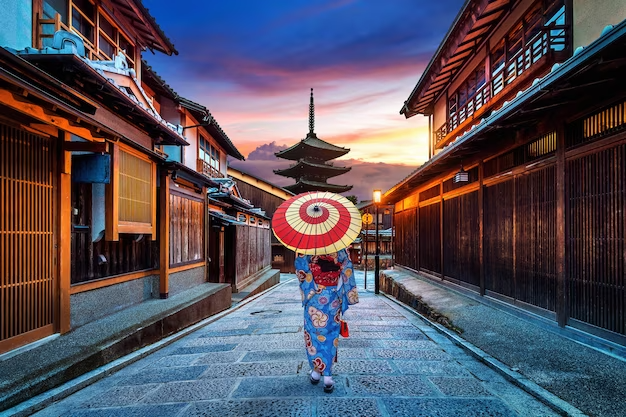
Japan is a beautiful and diverse country with a rich cultural heritage, modern cities, stunning natural landscapes, and delicious cuisine. Here’s a sample 10-day itinerary to give you an idea of what you can see and do in Japan:
Day 1-2: Tokyo
- Arrive in Tokyo, the bustling capital of Japan.
- Visit iconic sights like Tokyo Tower, Senso-ji Temple, and the Imperial Palace.
- Explore the districts of Shibuya, Shinjuku, and Akihabara.
- Try traditional sushi and ramen for dinner.
Day 3: Nikko
- Take a day trip to Nikko, a UNESCO World Heritage site renowned for its breathtaking temples and natural beauty.
- Visit Toshogu Shrine, a lavishly decorated shrine complex.
Day 4-5: Hakone
- Head to Hakone, famous for its hot springs and views of Mount Fuji.
- Relax in an onsen (hot spring) and enjoy the beautiful scenery.
- Visit the Hakone Open-Air Museum and Hakone Shrine.
Day 6-7: Kyoto
- Travel to Kyoto, a city rich in history and traditional culture.
- Visit Kinkaku-ji (Golden Pavilion), Fushimi Inari Shrine, and Arashiyama Bamboo Forest.
- Explore the historic Gion district and experience a traditional tea ceremony.
Day 8: Nara
- Take a day trip to Nara, home to friendly deer and beautiful temples.
- Visit Todai-ji Temple and Nara Park.
Day 9: Hiroshima
- Head to Hiroshima and tour the Peace Memorial Park and Museum to explore the city’s history.
- Take a ferry to Miyajima Island to see the famous “floating” Itsukushima Shrine.
Day 10: Osaka
- Explore Osaka, known for its modern architecture and vibrant nightlife.
- Visit Osaka Castle and try street food in Dotonbori.
- Depart from Osaka or extend your trip to explore more of Japan.
Remember to adapt this itinerary based on your interests, travel pace, and the time of year you visit. Japan has much more to offer, so feel free to modify this itinerary to suit your preferences and discover the unique experiences that appeal to you.
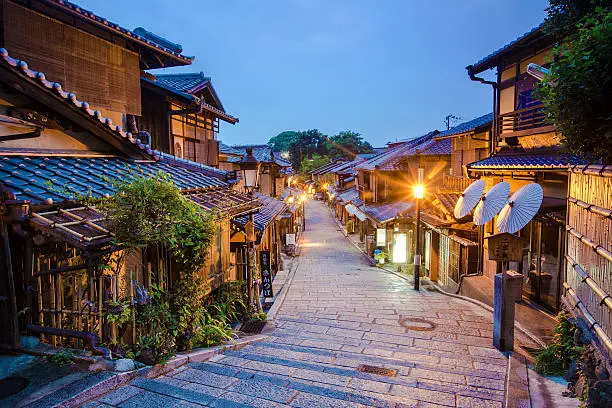
Japan is a haven for solo travelers searching for peace and reflection, surrounded by spiritual sites and calming nature trails. You’ll find beautiful traditional gardens in every city once the retreats for Japan’s historical figures.
When ready to escape the hustle and bustle, head to tranquil temples, forested mountains, or islands with charming rivers and castles. Japan offers enchanting waterfalls, vast flower-filled parks, and stunning alpine exploration routes. And take advantage of Japan’s beloved onsen hot springs, a peaceful experience often found in cozy Japanese inns.
You may interested in: Travel Essentials for Women: Packing Made Easy
Numerous travelers embark on solo journeys to Japan yearly, and most enjoy a trouble-free experience. Nevertheless, it’s wise to consult the Foreign and Commonwealth Office (UK), the Department of State Travel Advisories (US), or your local government’s guidelines for the most up-to-date advice before your trip. After arriving in Japan:
- Pay attention to local advice.
- Stay aware of your surroundings.
- Ensure you’re mindful of your belongings.
Japan solo travel is more appealing due to its remarkable safety track record and low crime rates. Traveling solo is normalized and well-supported, with provisions like women-only spaces in spas or train carriages. Consider joining a group of fellow solo travelers for added peace of mind.
In summary, Japan solo travel offers a distinctive journey blending tradition and innovation, providing a transformative experience. Discover the safety, efficiency, and warm hospitality that make exploring Japan alone a fulfilling adventure. The Land of the Rising Sun beckons with its rich culture, diverse landscapes, and a seamless blend of old and new. Whether delving into city life, immersing in nature, savoring local delicacies, or diving into the unique culture, Japan solo travel promises an unforgettable venture catering to all preferences. It’s an exceptional destination inviting solo travelers to uncover its unique tapestry of experiences and embark on a self-discovery odyssey.
Similar Posts
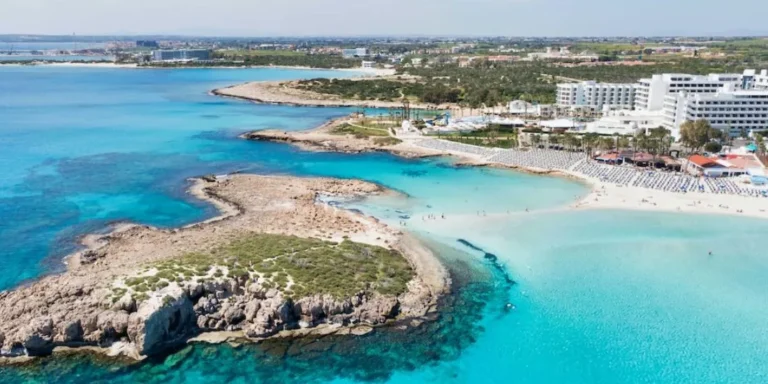
Cyprus Travel Tips: Your Guide to Exploring Cyprus
Explore all Cyprus offers through activities and sights that showcase culture, history, and natural splendor – find out “what there is to do in Cyprus” with this comprehensive guide! Welcome to Cyprus, an idyllic island…


Best Places to Visit in Bangkok for First Timers-Explore Now
Bangkok: A City of Contrasts Bangkok, often referred to as the “City of Angels,” is Thailand’s capital and largest city. Located in the central part of the country, it serves as Thailand’s political, economic, cultural,…

Singapore in Winter Travel Tips – Weather, Activities & More
In this comprehensive guide, we’ll delve into all the essential information you need to enjoy the winter season in the tropical paradise of Singapore in Winter. Discover how this vibrant city-state transforms during the cooler…
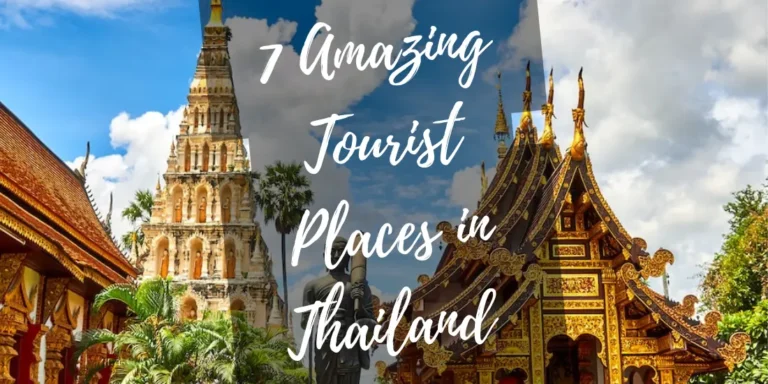
Thailand’s Unique Tourist Attractions: 7 Amazing Places
Thailand, often called the “Land of Smiles,” is a mesmerizing Southeast Asian paradise famous for its breathtaking scenery, abundant cultural legacy, and welcoming hospitality. While popular destinations like Bangkok, Phuket, and Chiang Mai draw millions…
One Comment
- Pingback: Mexico Travel Tips: Your Guide to a Memorable Trip
Leave a Reply Cancel reply
Your email address will not be published. Required fields are marked *
Save my name, email, and website in this browser for the next time I comment.
Solo Trip in Japan: Complete Guide to Itinerary, Attractions, Cost and More
快速導覽
How to start a person traveling to Japan for the first time?
How did you travel to japan alone for the first time.
There are many things in daily life that always experience the first time, such as traveling to Japan with friends for the first time, going to Tokyo for the first time, going to Kyoto for the first time, taking the JR train for the first time, and taking the Shinkansen for the first time Trains, learning to ski in Japan for the first time...
Then suddenly, for some reason, it became the first time to travel to Japan alone, and suddenly there was only one person to deal with all the issues such as air tickets, accommodation, itinerary planning and so on. At this time, you will unconsciously ask, is it safe to go to Japan alone? How should a person go to Japan to arrange accommodation, attractions, and itinerary planning? What should I pay attention to when traveling to Japan alone? Also, who else would choose to go to Japan alone?
Perhaps for you who will go to Japan alone for the first time, this trip may be a major test in your life. Because you need to face a language barrier environment alone, and you have to solve all the things that will happen during the entire trip alone.
Difficulty of traveling alone in Japan
However, according to my many travel experiences in Japan in the past, traveling alone in Japan is not as difficult as I imagined. As long as I can overcome the first time I go to Japan alone, I will learn how to arrange the second and third trips . Just like I have been to the top of Mount Fuji, Hokkaido, Tokyo, Kyoto, Fukuoka, Hiroshima, Kumamoto, Nagasaki, etc. in the past, basically only a small part of Japan has not been visited
At the same time, I also tried to live in Japan alone, deal with different problems in daily life in Japan alone, and so on. In fact, traveling alone to Japan is not a terrible thing, but something that you will fall in love with unconsciously.
As I said at the beginning, there is a first time for everything. So whether you are "the first time to travel to Japan" or "the first time to travel to Japan alone", as long as you have not been to Japan many times, today's article will sort out one for you Japan itinerary planning. First of all, it will start from the most basic itinerary planning, and then to accommodation arrangements, scenic spot selection, and then to Japanese culture, what needs to be paid attention to when traveling in Japan, etc., will share past experience with you.
I hope that after reading this article, you can plan a Japanese travel itinerary that belongs to you. Whether it's your first trip to Japan alone, or your first trip to Japan with your family or friends, you can complete the entire itinerary at the end and return home safely with good memories.
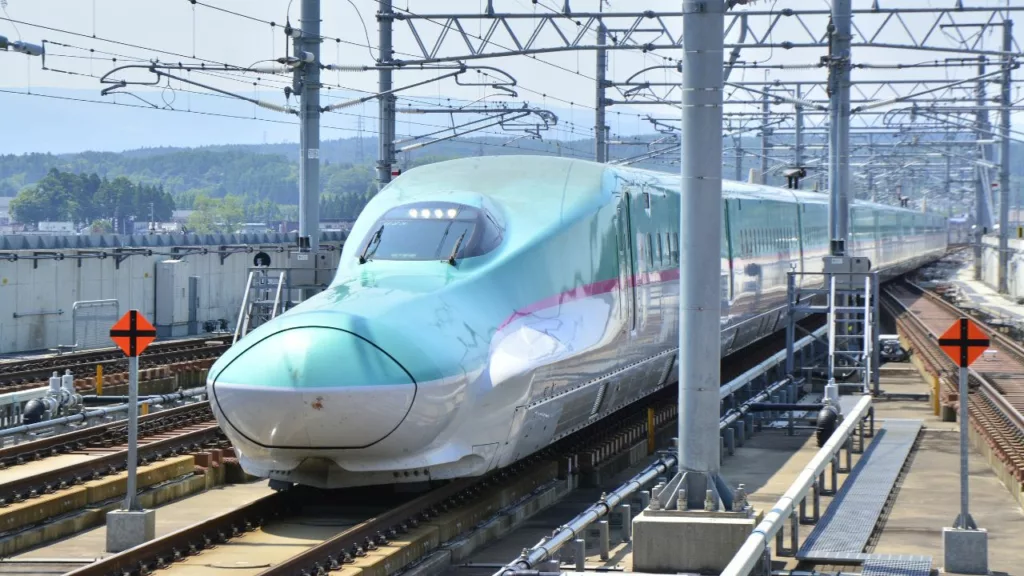
One ticket, unlimited travel throughout Japan! [Best Deal] JR Pass All Japan Rail Pass A must-have ticket for a long-distance trip to Japan!
Is it safe to travel in Japan?
People often ask: Is Japan a safe and tourist-friendly country?
This is a question that many people who plan to travel to Japan for the first time will ask. To put it simply, Japan is different from other countries. Japan is a country that attaches great importance to tourism, and crimes against overseas tourists are very rare. If some unavoidable natural disasters and accidents are excluded, Japan is a very safe country on the whole.
In addition, the Japanese are a nation that attaches great importance to laws and regulations and the feelings of others, so even if you lose your wallet, mobile phone, or a coin, you can find it back with the assistance of the police and station staff thing.
More in-depth, as long as you concentrate on activities in popular tourist attractions and shopping areas, and do not walk into some residential areas or private land, the chances of accidents are basically very low. At the same time, try to avoid going to some unknown restaurants, izakayas, and places suspected of being pornographic places and gambling places, so that you can minimize the chance of accidents.
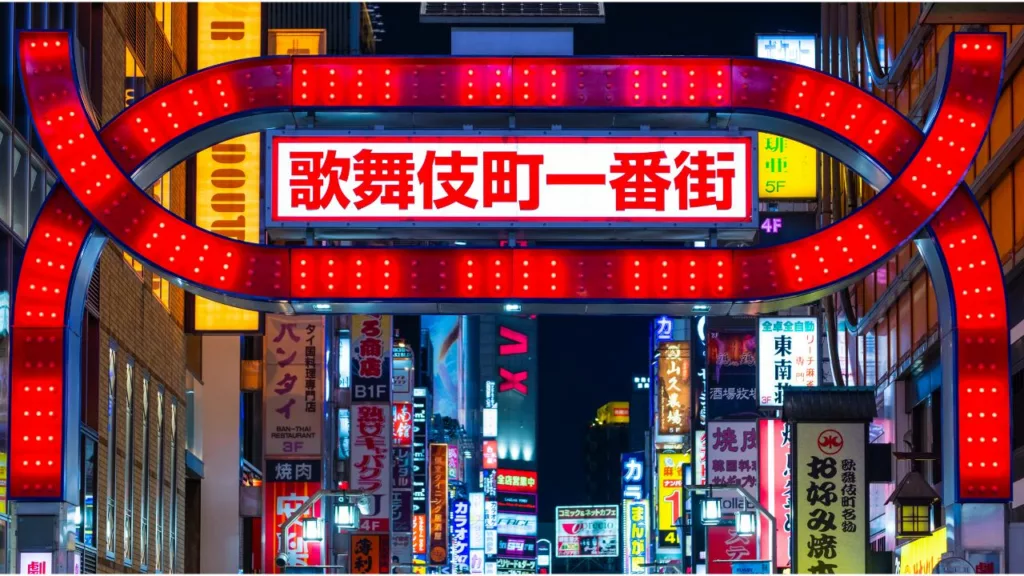
Is Japan suitable for traveling alone?
If you are traveling to Japan for the first time, and there is only one person, you don’t need to worry too much in just a few days in Japan.
Because Japan is a place with very developed railway construction, you will definitely find JR stations or local railway stations near almost all scenic spots. Therefore, there is no need to worry about transportation arrangements. Traveling to Japan by yourself can actually solve transportation planning easily.
In addition, in major cities in Japan such as Tokyo, Osaka, Kyoto, etc., there are also many accommodation plans and restaurants suitable for one person, and many of them are very cheap and good quality accommodation and restaurants. So even if there is only one person going to Japan, it is not like other countries where only double rooms and double packages can be booked.
Another point is that as long as your actions don't affect other people, basically the local Japanese don't care whether you come to Japan alone or in a group. As long as you follow their instructions, whether you are in a hot spring hotel, taking JR, or going to some high-end restaurants alone, they will serve you according to the usual standards.
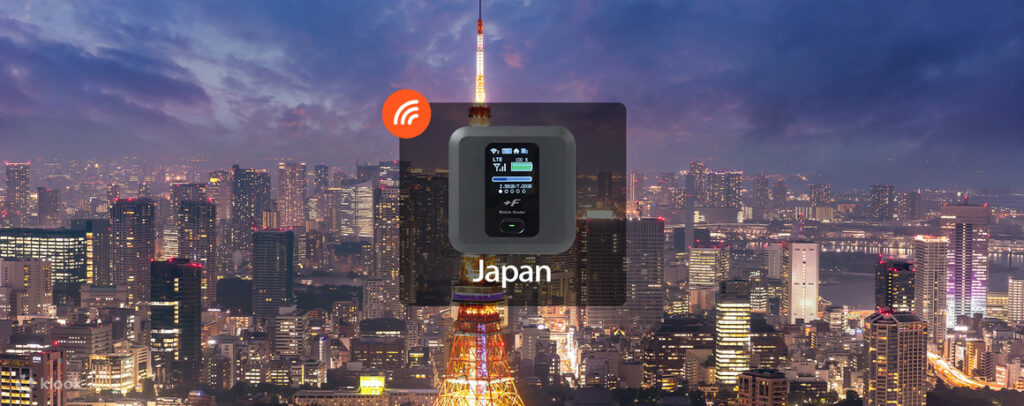
One device, shared by multiple people! [New] NTT Docomo Unlimited Mobile Data Sharer Service Plan Faster and more convenient to receive!
Can I travel to Japan without knowing Japanese?
The answer first: If you only go to some popular tourist spots, this is totally fine. However, if you want to go to some scenic spots suitable for in-depth travel, learning some basic Japanese is a necessary condition for setting off to these scenic spots.
If you are going to Japan with your friends
To put it simply, if you are traveling to Japan with your friends, and you only go to popular tourist attractions in Tokyo, Osaka, and Kyoto, there will be no problem even if you only speak English. Because many of the clerks who can work in tourist areas are people with certain English skills, there will be no problem in ordering food, checking out, or inquiring about scenic spots in simple English. And because you are going to Japan with a group of friends, even if there is an accident, they will help you, so if you can communicate in Japanese, it will be helpful for the itinerary, but it is not a necessary skill.
However, if you are traveling to Japan alone, or plan to go to places other than popular attractions and stay in accommodation other than major hotels, your Japanese ability will completely affect your itinerary experience.
If you go to Japan alone
For example, take the itinerary in Tokyo as an example. If you go to some independent small restaurants, izakayas, etc. in residential areas this time, basically you must understand the Japanese on the menu before you can order food. Or if you want to book some cultural experience activities, you need to have Japanese communication skills to participate.
More importantly, if you are going to Japan alone and plan to leave popular tourist areas such as Tokyo, Osaka, and Kyoto, whether you can speak Japanese will determine your chances of getting help. Because Japanese people in other regions may not be able to understand complex English sentences, especially when you miss the last JR train and need help when you are injured, Japanese will be the fastest language for you to get help.
Of course, if you are on an itinerary that mainly focuses on popular attractions, you can also say "すみません-Sumimasen", "これ- kore", "ありがとうございます- arigato gozaimasu", etc., which will be better than "Excuse Me / Sorry" , "This" and "Thank You" make it easier to get help from the store staff.
What attractions can you choose when you go to Japan for the first time?
It's the first time to travel to Japan, but after opening the map of Japan, I still don't know which places are worth visiting? In fact, the whole of Japan is mainly divided into two main parts, the city and the suburbs. You can decide which place to go according to your knowledge of Japan.
major cities in japan
If you are going to Japan with your friends this time, if you have never traveled to Japan, and if you don’t speak Japanese, Tokyo, Osaka, and Kyoto are all very suitable places for you to go.
Because these three places are very mature tourist areas, besides there are many scenic spots that allow you to arrange a itinerary for a week, and there are also people from different countries working in these areas, so even if you only speak English and Chinese The whole journey can be completed smoothly.
And between Tokyo, Osaka, and Kyoto, I will recommend you to go to Tokyo or Kyoto first, and save Osaka for the next time you come to Japan.
Because the attractions and characteristics of Osaka are actually similar to those of Tokyo, what can be experienced in Osaka can be experienced in Tokyo. However, what you experience in Tokyo may not necessarily be experienced in Osaka. A simple example is like sightseeing at a high-altitude observatory. Tokyo has Tokyo Skytree, Tokyo Tower, and Shibuya Sky, but Osaka only has Osaka Tsutenkaku and Umeda Sky Observatory, but they cannot compare with Tokyo Skytree in terms of height.
In addition, Tokyo and Kyoto represent both modern and traditional Japan. If you are going to Japan for the first time, you want to experience Japan’s big cities, anime, shopping, or Japan’s ancient capital, kimono wearing experience, tea ceremony experience, geisha performance, some traditional Japanese activities and so on.
To sum up, Tokyo and Kyoto are places with very complete tourism resources. Even if you don’t spend too much time researching the itinerary, basically you don’t have to worry about transportation, accommodation, attractions, etc. place to go and get bored.
Japanese regional cities
Of course, for you who will be going to Japan for the first time, you don’t necessarily have to go to places like Tokyo, Kyoto, and Osaka. If you have enough preparations before departure, in fact, Fukuoka, Hiroshima, Kumamoto, Nagoya, Shikoku, Hokkaido, etc., some places with natural attractions are worth your consideration. However, because the transportation facilities in these places are not as developed as Tokyo and Kyoto, there may only be one JR train passing by every hour.
In addition, because these places are not places that some overseas students would choose to go, sometimes it may be a little difficult to communicate in English. In addition, there are many places where the explanations are only in Japanese, which is not like the habit of providing Japanese, English, and Chinese multiple languages at the same time in Tokyo.
So for you who are going to Japan for the first time, if you still choose to go to these places, you need to have a certain level of Japanese ability, and have enough time to study each day's itinerary before departure, so that you can ensure that you are in the itinerary There will be no surprises along the way.
For those who travel to Japan for the first time, unless there are other people who have been to these places who can serve as tour guides and can quickly identify some important traffic and scenic spot information, it is best to have a certain level of Japanese ability, otherwise Should save it for the next time I visit Japan.
What are the attractions to choose when traveling to Japan alone?
If you have traveled to Japan several times, but this time it happens that only one person goes to Japan, and it is the first time to go by yourself, Tokyo, Kyoto, and Osaka are some places suitable for departure at any time. The shopping malls, restaurants, and different attractions are sure to be enough for you to arrange a long-distance trip. If you want to challenge yourself, you can also consider using the JR Shinkansen train to go to Tokyo and Kyoto at the same time to experience two completely different Japans.
In addition, in summer, Mount Fuji, Hokkaido, Hiroshima, and Fukuoka are some places where you can enjoy the natural scenery. Or in Hakone and Nikko in winter, there are many hot spring hotels you can go to. As long as you book the required tickets and accommodation in advance, it is basically as simple as planning a trip to Tokyo.
However, it is not recommended to go alone for some relatively high-risk activities, such as going skiing in winter alone, climbing a mountain in Japan with only one person, or going into some suburban areas alone, all of which must be avoided.
How to arrange accommodation when going to Japan alone?
If you choose to go to areas such as Tokyo, Kyoto, and Osaka, business hotels and youth hostels are some accommodation options worth considering. The characteristic is that the housing price is cheap, and the distance from the station is not very far. Even if you need to drag your suitcase, it is very convenient.
If you want to have enough private space, there are APA Hotel Both are great accommodation options. If you want to communicate more with other people, youth hostels will be a good accommodation solution, but not every city in Japan will definitely have this kind of accommodation option.
For example, I often Agoda The advantage of booking APA hotels in different areas above is that you can apply for free cancellation when you need to change your itinerary. In addition, you will also recommend other hotels, youth hostels, and even capsule hotels in the same area. When the APA hotel has no rooms available, I can immediately book other hotels instead of spending time calling each hotel to check availability.
However, you should pay more attention when you book some high-end hot spring hotels, because most of the hot spring hotel rooms are sold as double rooms, and the meals are mainly set meals for two people. In other words, no matter if you are alone, you still have to pay the cost of a double room before you can stay in those high-end hot spring hotel rooms.
Check Prices and Discount Offer: Book hotel accommodation in Japan
What should I pay attention to when traveling to Japan?
Since Japan is said to be a very safe country, why do we need to pay more attention during the tour?
The reason is simple, because the language and culture of each country are different, which may cause misunderstandings due to some cultural conflicts. Moreover, many people will overestimate their abilities during the trip, or lack of planning, and finally encounter some accidents that could have been avoided.
Therefore, whether you are going to Japan with friends or by yourself, you should pay attention to the following points when you go to Japan for the first time.
Knowing basic Japanese will enhance your travel experience
Since Japanese is the common language in Japan, if you want to get help from the shop staff quickly, the effect of asking questions in Japanese will be much better than English. In addition, making good use of translation software can help you break the language barrier, and the efficiency will be much better than simply using English to inquire with the clerk.
Avoid eating while walking in Japan
Japan is not a country that is used to shopping and eating at the same time, but is used to eating near restaurants and small shops before continuing to go shopping and shopping. If you're used to walking into different shops with your drink in hand, definitely avoid it when you're in Japan. Otherwise, you may need to pay before you can leave when the goods are wet.
Pay attention to the departure time of the last railway train
Regardless of whether you are traveling to any part of Japan, you must pay attention to the departure time of the last train on the railway. Because JR railways in different regions will have different last train times. For example, for JR trains in some remote areas, it is not impossible for the last train to leave at 18:00 in the afternoon.
Although the last JR train in Tokyo will end around 00:10 in the middle of the night, the distance between different stations in Tokyo is actually very far. If you don’t want to spend money to take a taxi, it will take a lot of time to walk there. So before you plan to arrange some night activities, it is better to check the departure time of the last bus of the day.
Avoid being alone on the street late at night
Although Japan is a country with very good law and order, it does not mean that there will be no crimes at all. Especially in some bar areas and nightlife-based areas late at night, if you are not familiar with Japanese culture, you must try to avoid going there late at night. This is the best way to ensure your own safety.
In addition, if you go to Japan alone, when you go to some remote places, try to stay in some main shopping streets after nightfall, so that even if you encounter an accident, you can get help immediately.
Avoid going into residential areas, private land, farmland
The Japanese attach great importance to private land, so even if you see a lot of sunflowers planted in some farmland, it is not recommended to go to touch or take pictures. Just like the Christmas tree in Biei, Hokkaido, you can't actually go in and take pictures, because the location of the Christmas tree is within the scope of private land.
Avoid going into some unknown restaurants
If you go to places where izakaya are concentrated in Tokyo, Osaka, and Kyoto, and you meet some people who entertain you warmly on the street, or tell you that you don’t need to spend time queuing up, hoping that you will go to some specific restaurants, then you must careful. Because those restaurants are likely to be some restaurants that charge high fees. Seats, ice cubes, drinking water, snacks, service fees, etc. will be calculated independently, and they will also give you a high bill.
So if you are traveling to Japan for the first time, or if you are only traveling to Japan alone, it is recommended that you go to some restaurants in department stores, which will be safer and more convenient.
Avoid taking pictures of other people's faces
The Japanese are not a very enthusiastic nation, so when taking pictures in Japan, you must avoid taking pictures of other people. And according to Japanese law, they have the right to refuse to let you take pictures, and they can also ask you to delete photos that include their appearance, which must be paid attention to.
don't force yourself to go to any itinerary
For you who are traveling to Japan for the first time, sometimes you will want to visit several different attractions in one day. But it is often easy to underestimate the travel time required in the middle and whether your physical strength can handle it.
In fact, Japan is a country that is suitable for visiting again and again. Whether you go to a certain scenic spot today or next year, there will still be no big difference in this scenic spot. So when you really have no way to go to a certain scenic spot, it is actually the most appropriate choice to give up decisively.
cheap dining options
Although prices in Japan are not cheap, there are also delicious and cheap bentos sold in convenience stores and supermarkets. For example, there are many branches in Tokyo Kitchen Origin , provides a lot of bento options around ¥500, which is cheaper than lunch and dinner in many restaurants.
In addition, some beef rice restaurants, ramen restaurants, Chinese cuisine restaurants, etc., are all places where you can eat for less than 1,000 yen. If you don't have a lot of travel budget, restaurants like Matsuya, Otoya, Hidakaya, etc. will be your best restaurant choices during your travels in Japan.
Tickets and internet devices required in Japan
If you have never traveled to Japan, you can go first klook.com Book the required Internet devices, tickets, and then depart for Japan. The feature is that it can save the time of queuing up to buy tickets, and sometimes you can get additional discounts, which are basically cheaper than buying tickets on the spot.
and klook.com Basically, it contains most of the packages you need to use during your travel in Japan, from theme park tickets, JR train passes, to different one-day tour guide groups. As long as you plan your itinerary, you can start immediately with these packages.
Japan is a country suitable for traveling in any season and at any time. No matter whether you are going to Japan for the first time or whether you are going to Japan alone, you will always find a way that suits you best to experience different aspects of Japan. local culture.
If you are planning your next trip to Japan, you must check out more travel information articles on this website. Maybe you can get a new experience in this Japan travel itinerary!
More Japanese fun tips
communication, transportation
How to Use Suica Card with Apple Pay on iPhone? Low-cost method to call to Japan by Skype: Step-by-Step Guide Japan Internet SIM Card Recommendation "Which phone card is the best among plans with unlimited data and unlimited speed? Which Side Should You Stand? Rules in Escalator in Japan Best Japan Travel Apps: Public Transport App, Rail Route App , Weather Forecast App and More
Shopping Advice, Offers
Where to Buy Japanese Sake? Complete Guide to Buy Sake in Japan Best Sake for Beginners: Complete Guide to Pick the Best Sake for Yourself
Itinerary suggestion
Itinerary suggestions for visiting Japan for the first time and traveling alone 5 Cat Islands in Japan: Meeting Cats in Tokyo, Shikoku and Fukuoka
More Japan Travel Information: Tokyo | Kyoto | Hokkaido | Climbing Mt.Fuji | Hakone | Lake Kawaguchi Tips for Traveling in Japan | Japan Hotel Deals | Klook Latest Promo Code
Ryu_C@RakuRakuJP
RakuRaku, which is 楽々 in Japanese. This site is committed to providing the most authentic travel information in Japan, bringing you a different Japan travel experience!
60 Things to Do in Tokyo: Complete Guide for Beginners in Tokyo
Shinjuku gyoen national garden: review, garden map and more, more different travel information, 5 cat islands in japan: meeting cats in tokyo, shikoku and fukuoka, best sim for japan: complete review on esim, unlimited data sim for japan, 7 steps to add suica card into apple wallet, low-cost method to call to japan by skype: step-by-step guide , which side should you stand rules in escalator in japan, where to buy japanese sake complete guide to buy sake in japan, best sake for beginners: complete guide to pick the best sake for yourself, 7 apps for traveling in japan: get this weather/transportation/map apps before you go.
RakuRakuJP , is a website dedicated to sharing articles about in-depth travel experiences in Japan.
I believe that before you travel to Japan every time, you will hope to get the most comprehensive travel information, and then be able to successfully complete the entire travel itinerary.
And our goal is to gather all practical itinerary information, discounted accommodation, and tickets, so that you can plan the entire Japan travel itinerary in the most convenient way.
useful link
- About RakuRakuJP
- RakuRakuJP All Articles
- Privacy Policy
- Website Terms of Use
- Agoda booking offers
- Klook Booking Offer
Editor's Picks
Latest useful travel articles.
©2017- 2024 RakuRakuJP. All Right Reserved.
- Contact us to advertise
Solo Travel to Japan: An Adventure in Self-Discovery
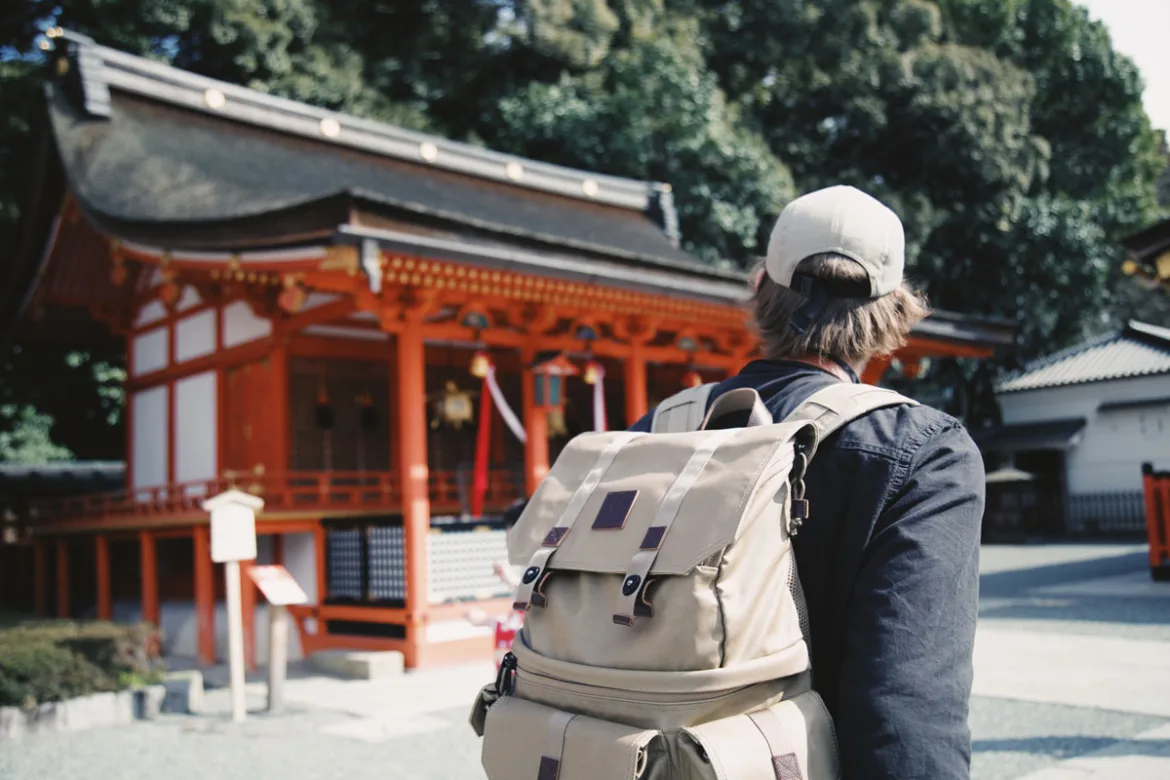
Table of Contents
- Discover the Fascinating World of Sumo Wrestling in Japan November 24, 2021
- Sushi and sashimi – the Japanese way February 26, 2023
- Mastering Washoku: Unlocking the Secrets of Japanese Cuisine November 4, 2021
- The Secrets of Japan’s Traditional Spa Treatments December 29, 2022
- Yanaka: Nostalgic Streets and Rich Culture August 24, 2022
- The Ultimate Family Guide to Exploring Tokyo with Kids July 21, 2022
Solo travel in Japan is an experience like no other. It’s a chance to grow and learn in ways you never thought possible. When you’re on your own, you’re forced to rely on your own judgment and decision-making skills. It can be scary at first, but it’s also incredibly empowering. You get to create your own itinerary and explore the country at your own pace, without worrying about anyone else’s needs or wants.
But solo travel in Japan isn’t just about independence and freedom. It’s also a chance to immerse yourself in the country’s rich culture. Japan has a unique and fascinating culture, from the traditional temples and shrines to the modern and vibrant pop culture. By interacting with locals, trying new foods, and participating in cultural events and festivals, you get a deeper understanding and appreciation for the country and its people. And who knows, you might even make a few lifelong friends along the way! Solo travel in Japan is an opportunity to broaden your horizons and gain a new perspective on the world, all while having the adventure of a lifetime.
Freedom and Flexibility
One of the best things about solo travel in Japan is the freedom and flexibility it offers. When you’re on your own, you get to set your own schedule and do whatever you want, whenever you want. You’re not tied down to anyone else’s agenda, so you can take your time and really soak in everything that Japan has to offer. Maybe you want to spend an entire day exploring Tokyo’s bustling streets , or perhaps you’d rather escape to a quiet mountain town and relax in a traditional hot spring. Whatever your preferences, solo travel in Japan allows you the time and space to make your own choices and create your own unique experience.
In addition to the freedom of choosing your own itinerary, solo travel in Japan also allows for flexibility in the event that your plans change. Maybe you stumble upon a hidden gem that you didn’t know about before, or perhaps the weather doesn’t cooperate with your original plans. Whatever the reason, when you’re traveling alone, you’re able to adjust your plans on the fly without worrying about inconveniencing anyone else. This kind of flexibility can be a lifesaver, especially in a country like Japan where there’s always something new and exciting to discover around every corner.

Personal Growth
Solo traveling in Japan can be a wonderful opportunity to challenge yourself and step out of your comfort zone. Traveling to a new place can be intimidating, especially when you’re on your own, but it can also be incredibly rewarding. Being in a new environment forces you to adapt and problem-solve, which can be great for building confidence and independence. When you’re traveling alone, you’re also more likely to meet new people and have experiences that you might not have had otherwise. This kind of personal growth can be invaluable and can help you feel more confident and capable in other areas of your life.
One of the best things about solo traveling in Japan is the chance to push yourself in ways you might not have thought possible. Whether it’s navigating the subway system, trying new foods, or communicating in a new language, every new experience can be an opportunity to learn and grow. And the best part is that you get to do it all on your own terms, without anyone else’s expectations or judgment. By stepping out of your comfort zone, you may surprise yourself with how much you’re capable of, and come away from your trip with a newfound sense of confidence and self-assurance.
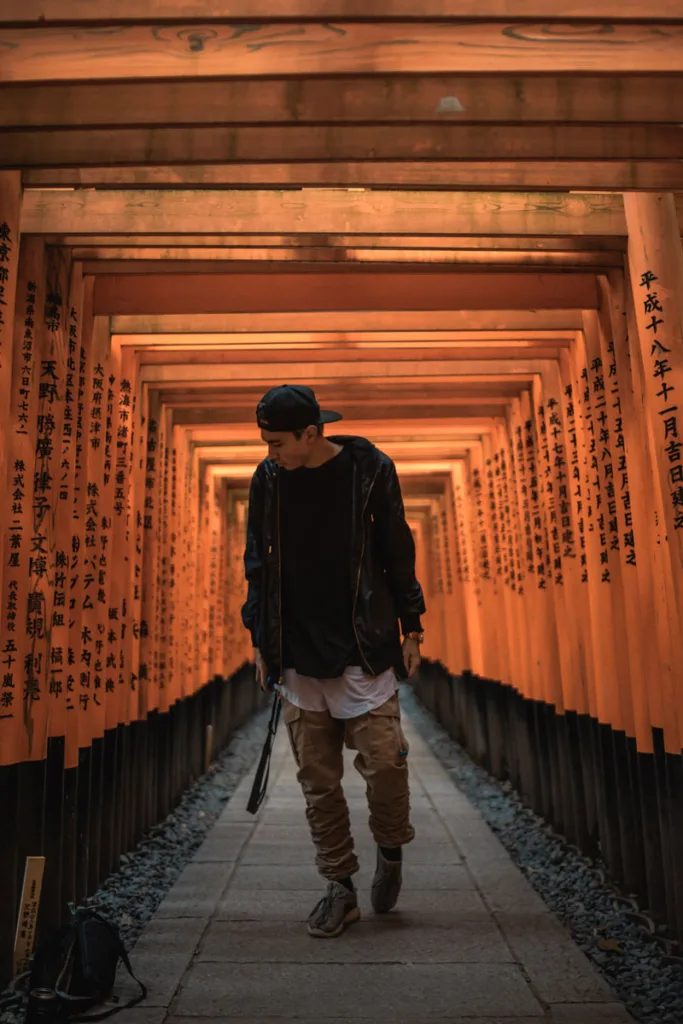
Cultural Immersion
One of the biggest advantages of solo traveling in Japan is the opportunity for cultural immersion. When you’re traveling alone, you have more time and flexibility to explore local neighborhoods and engage with the people and customs of the region. You might find yourself chatting with locals at a street market, practicing your Japanese with a friendly shopkeeper, or sharing a meal with a new friend you met at a hostel. These experiences allow you to gain insight into the daily lives of Japanese people and appreciate the nuances of their culture that might otherwise go unnoticed.
Another way to immerse yourself in local culture is through food. Japan has a rich and diverse culinary scene, with regional specialties and unique ingredients that are worth exploring. When you’re on your own, you can be more adventurous with your food choices and try things that you might not have considered before. Whether it’s slurping down a bowl of ramen at a hole-in-the-wall noodle shop or sampling street food at a festival, there’s always something new and delicious to discover.
Finally, solo traveling in Japan is a great way to participate in cultural events and festivals. From traditional festivals like cherry blossom viewing and the Bon Festival to modern pop culture events like anime conventions and music festivals, Japan has something for everyone. By immersing yourself in these cultural celebrations, you can gain a deeper appreciation for Japan’s unique traditions and learn more about the country’s history and customs. And who knows, you might even make some new friends along the way!
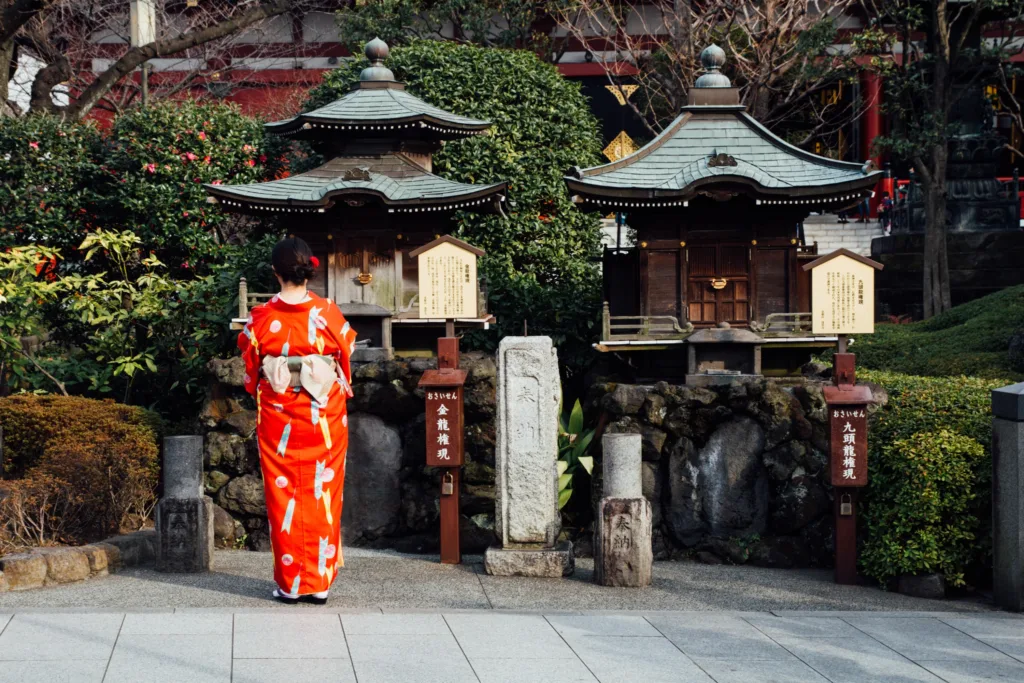
However, when traveling alone, it’s important to prioritize your safety.
Tips for staying safe while solo traveling in Japan
Research your destination.
Researching your destination before traveling solo to Japan is crucial for ensuring a safe and enjoyable trip. Not only does it give you an idea of what to expect, but it also allows you to familiarize yourself with the local customs and laws. It’s important to be aware of cultural differences and etiquette, such as taking off your shoes when entering someone’s home or refraining from speaking loudly on public transportation. Additionally, it’s a good idea to research the specific areas and neighborhoods you plan on visiting to ensure that they are safe and suitable for solo travelers. With a little bit of preparation and research, you can feel more confident and prepared for your trip, and have a more fulfilling experience in Japan.
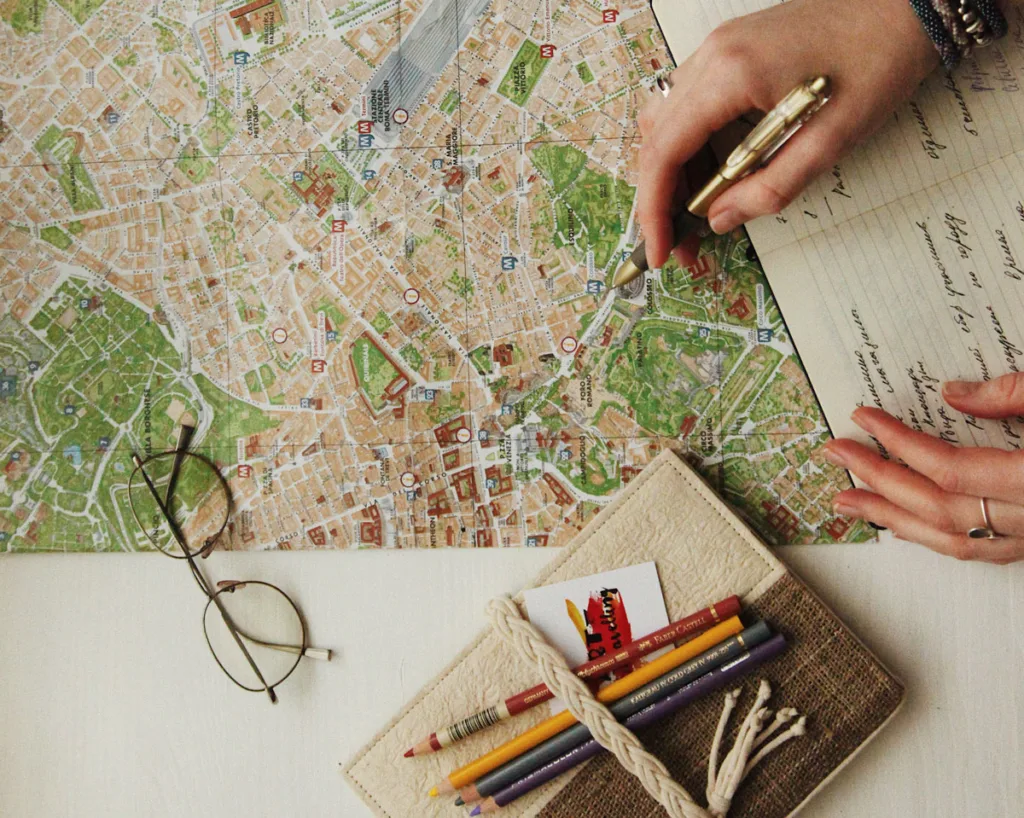
Stay Connected
Staying connected while traveling solo in Japan is important for both safety and peace of mind. By letting family and friends back home know your itinerary and plans, you can ensure that someone knows where you are and can reach out to you in case of an emergency. Additionally, staying connected allows you to share your experiences and stay connected with loved ones even while on the other side of the world. To stay connected in Japan, consider getting a local SIM card or renting a pocket Wi-Fi device. This will allow you to have access to data and stay connected to the internet while on the go, making it easier to navigate and stay in touch with others. With the right tools and communication, you can feel more connected and secure while traveling alone in Japan.

Trust Your Instincts
When traveling solo in Japan, it’s important to trust your instincts and pay attention to your surroundings. If something doesn’t feel right, it’s better to be cautious and remove yourself from the situation. This could mean avoiding a certain area or changing your plans for the day. It’s also a good idea to be aware of potential risks or dangers in the area you are visiting. For example, if you are in a crowded area, be mindful of pickpockets and keep your belongings close to you. By staying aware and listening to your instincts, you can avoid potentially dangerous situations and have a safe and enjoyable trip to Japan.

Popular destinations and activities that are well-suited for solo travelers
Temples and shrines.
Japan is home to numerous temples and shrines, each with its unique history and architecture. Visiting these sites can offer a glimpse into Japan’s rich cultural heritage and provide a peaceful escape from the hustle and bustle of the city.
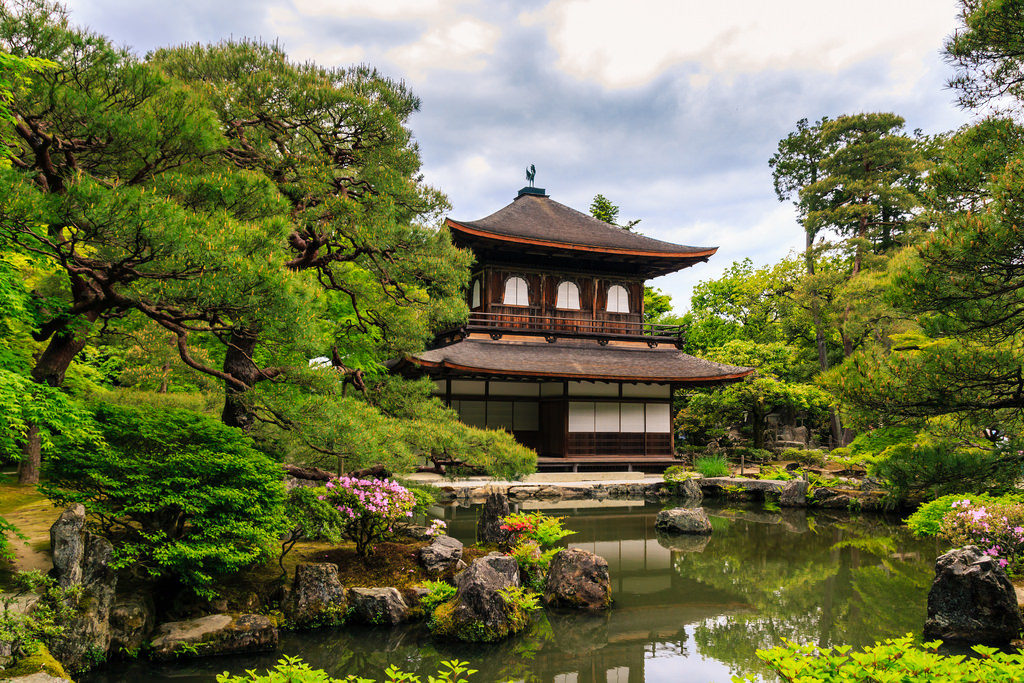
Local Cuisine
Japan is famous for its food, from sushi and ramen to street food and snacks. Trying local cuisine can be an adventure in itself, and solo travelers can enjoy the flexibility of trying new foods without worrying about pleasing anyone else.
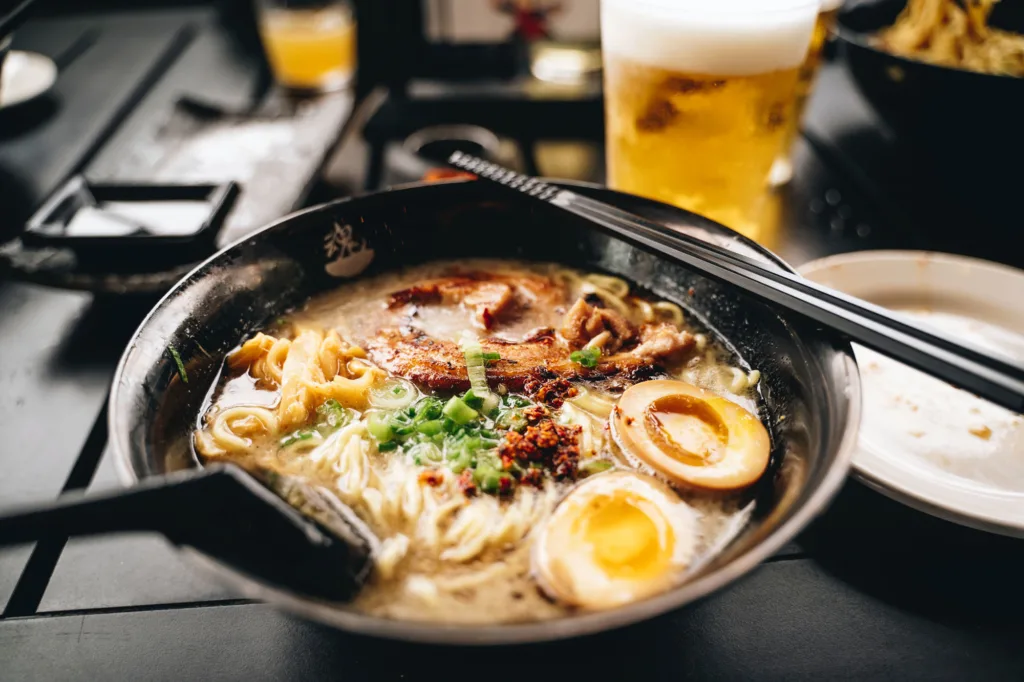
Cultural Festivals
Japan is home to many colorful and exciting cultural festivals throughout the year, including cherry blossom festivals, summer festivals, and New Year’s celebrations. These festivals offer a unique opportunity to experience Japanese culture and mingle with locals.
In conclusion, solo traveling to Japan can be a fulfilling and rewarding experience. With careful planning and an open mind, solo travelers can explore Japan’s rich culture and history, make new friends, and create unforgettable memories.
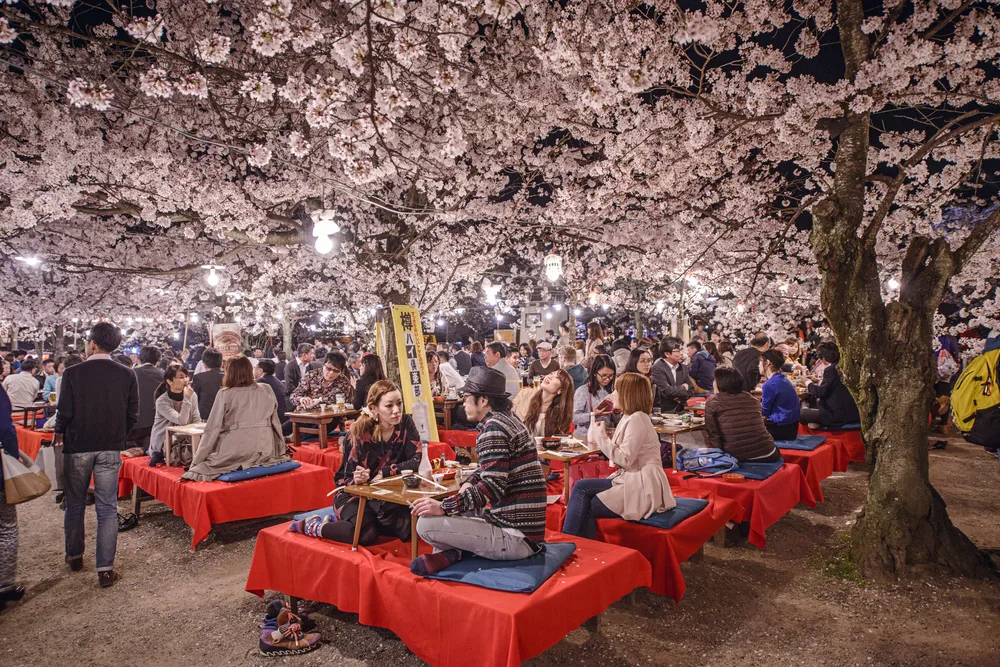
Book recommendations for those interested in solo traveling to Japan:
- “ Lonely Planet Japan ” by Lonely Planet: This guidebook is an excellent resource for solo travelers. It provides comprehensive information on Japan’s history, culture, and top attractions, as well as practical advice on transportation, accommodations, and budgeting.
- “ Tokyo on Foot: Travels in the City’s Most Colorful Neighborhoods ” by Florent Chavouet: This illustrated book provides a unique perspective on Tokyo, with charming drawings and anecdotes of the city’s streets and neighborhoods. It’s a great way to get inspired for your solo trip to Japan.
- “ Zen and Japanese Culture ” by Daisetz Teitaro Suzuki: This book is an excellent introduction to Japanese culture and philosophy, providing insights into Zen Buddhism and its influence on Japanese art, literature, and everyday life. It’s a great way to gain a deeper understanding of the culture you’ll be experiencing on your solo trip.
- “ The Art of Travel ” by Alain de Botton: This book is a philosophical exploration of the pleasures and frustrations of traveling. It offers insights into how to appreciate the beauty of your surroundings, even when things don’t go as planned. It’s an excellent read for anyone embarking on a solo trip to Japan or anywhere else in the world.
- “ Vagabonding: An Uncommon Guide to the Art of Long-Term World Travel ” by Rolf Potts: This book provides practical advice on how to plan and execute a long-term solo trip. It covers topics such as budgeting, packing, and making the most of your time on the road.

Discover the Magic of Solo Travel in Japan
If you’re considering solo travel, Japan is an excellent destination to explore on your own. With its unique culture, delicious cuisine, and stunning natural scenery, Japan offers a wealth of experiences for travelers of all interests. Solo travel in Japan provides the freedom to explore at your own pace, immerse yourself in local culture, and challenge yourself to step out of your comfort zone. It’s an opportunity to grow as a person, build confidence, and create unforgettable memories. So, if you’re ready for an adventure and a chance to discover all that Japan has to offer, consider solo travel to this amazing country . You won’t regret it!
Japanese Tea: Your Key to a Long and Healthy Life
The ultimate family guide to exploring tokyo with kids, you may also like, 25 irresistible gifts for the japan lover, immerse yourself in japan’s zen retreat, kyoto in 2 days: a perfect itinerary, the ultimate guide to exploring naoshima island, japan’s..., the blissful retreat: 10 unique and luxurious ryokans..., discover the magic: 10 dreamy honeymoon experiences in..., izakaya – the heart of japanese nightlife and..., sushi and sashimi – the japanese way, nara in 24 hours: the ultimate one-day itinerary, top 10 unique experiences in osaka, leave a comment cancel reply.
Save my name, email, and website in this browser for the next time I comment.
cassiethehag
Solo Travel in Japan tips + best places to go alone in Japan
If you’re looking for tips on solo travel in Japan? Great, because this post has you covered.
Please note that this blog post most likely contains affiliate links to products or services I use and love! If you click on the links, it means I get a little extra pocket money at no additional cost to you. This is what keeps my website ticking over – thank you!
Not only did I spend one month travelling in Japan alone (and have been a solo female traveller for over 5 years!) but I’ve also invited other Japanese experts to share their thoughts on the best places to travel alone in Japan.
Whether you’re looking for hidden gems or the best way around major tourist sights in Japan solo, we’ll recommend awesome things to do that will guarantee a memorable solo trip.
Table of Contents
Is Japan good for solo travellers?
Pros of solo travel to Japan:
- Safety: this is the main reason Japan tends to end up in so many ‘solo travel destination’ lists, I swear. Is it deserving of that title? Honestly… I think there are easier places to solo travel! However, it’s completely accurate that you’ll feel safe here as a solo female traveller.
- Ease of getting around: the train and bus system is pretty easy to navigate, especially in Tokyo and on bullet trains. That said, I used to live in London, so I was used to using the metro… it might feel challenging if you’re not used to it!
- Easy to stay connected: Most hostels had great WiFi, as did many major stores and most transport!
- Variety of activities – whether you’re into city sights, stunning beaches, historic temples, mountain hiking, or gentle nature, Japan has everything.
- Hostels are (usually) pretty good quality in Japan, with many including capsule beds with your own shelf, curtain, light, and plugs tucked inside. Read my post on surviving hostels as an introvert if you’re still nervous!
- Japan is introvert-friendly! Locals won’t be fussed by seeing people eating alone, since that’s a common practice! So that’s good news if you want to try all the tasty treats but feel self-conscious.
- Vegan options: On that note, if you’re a vegan traveller , you won’t bother your mates when you want to eat in all the amazing vegetarian Buddhist restaurants!

Cons of solo travel to Japan:
- Loneliness: I found it harder to meet people in Japan than in any other place I’ve visited. This is likely since ‘backpacker-style’ travellers are over the sea in Southeast Asia! Also, as it’s such an introverted society, I often found it INCREDIBLY hard to find someone to help me if I needed help. The country is known for being very polite, but not friendly, per se. (And no judgment from me, it was probably particularly tricky as I’m an introvert too!)
- Cost: Solo travel can be expensive , so for budget travellers, Japan won’t be as friendly for your wallet as other destinations such as Southeast Asia or The Balkans. Private rooms, taxis, and many tours are unfortunately more expensive for solo travellers, and I felt the sting much more in Japan than I have in other destinations.
- Some tours and traditional accommodations don’t accept solo travellers. I stayed at a Minshuku during a hike along the Kumano Kodo trail, but I wasn’t able to find a budget-friendly way to stay in a Ryokan during my trip.

Tips for solo female travel in Japan
Solo travelling to Japan is a bold choice for first-time travellers, speaking from my own experience! So I’d recommend it for more experienced travellers (whether or not it’s your first solo destination).
On the one hand, it’s very very safe, and the public transportation is great. I always felt safe as a female travelling alone in Japan. On the other hand, there’s less of a solo travel scene than in other countries I’ve been to, so it’s harder to meet people – whether you’re looking to socialise or just need some friendly advice.
- Learn a little about local customs if you want to blend in. For example, it’s not polite to eat on public transport.
- You don’t need to speak Japanese (especially in Tokyo and Kyoto) but that doesn’t mean it’s easy in small towns. I found not speaking the language harder in Japan than in other places I’ve visited. I recommend having Google Translate handy, and learning the words for basic phrases like Thank You, Excuse Me, and Your Cat/Dog is very cute is always appreciated by locals.
- If you want to meet people, staying in hostels is the easiest option. Or if you’re staying in a hotel, you can still often join tours aimed at backpackers, or head for a drink in a hostel bar where people are usually looking to socialise.
- Don’t be afraid to venture outside of Tokyo, Kyoto, and the main hotspots and discover some epic Japan hidden gems ! Although travelling outside of the norms can be more intimidating if you’re a first-time solo traveller (like I was during my Japan trip!), my favourite places to visit solo in Japan were all off the main route!

Best places for solo travel in Japan
Looking for a solo travel destination in the countryside of Japan? Then Hokkaido, especially its eastern part, is a perfect place to go if you want to immerse yourself in untouched nature by yourself.
My favourite spot is Shiretoko, which is just a 1.5-hour drive away from Memanbetsu Airport. The Shiretoko Peninsula, mostly covered by a national park, offers several outdoor activities that can be enjoyed solo in every season; five-lake hiking, snowshoeing to a waterfall and ocean cliffs, natural hot springs, and many more.
It’s best to visit during the summertime (June to September) with a rental car, but totally doable to travel by public transportation as well. Just check the timetable beforehand and plan your connections well. Things don’t run too often in the countryside!
For accommodation, I recommend Yuhi no Ataruie – a modern, cozy hostel with a hot spring, a spacious shared kitchen, and a breathtaking sunset view. Shiretoko is also known for its fresh seafood, so make sure to enjoy the delicious local food!
by Yuuka from My Eastern Hokkaido

No solo trip to Japan would be complete without the almighty Tokyo, especially if this is your only time visiting Japan. And if you don’t have long to explore, you can still see the iconic suburbs of Harajuku, Shibuya, and Shinjuku in one day in Tokyo .
Kamakura is a fab day trip, and well worth adding to your solo Japan trip itinerary even if you just have 3 or 4 days in Tokyo . If you don’t have long in Japan, it’s a nice and easy way to see a different side of the country without being much trouble to get to from the capital.
Travelling to Tokyo alone can be a wild ride, but that’s part of the fun! And despite the massive scale of the city, it’s one of the capitals I’ve felt safest in.

Nestled in Japan’s beautiful mountains, Hakone is the perfect destination for solo travellers looking to explore a different side of this incredible country. The Hakone area is known for its relaxing Onsen (hot springs), unspoiled nature and breathtaking views of the iconic Mount Fuji which looms over the area.
Hakone is full of exciting things to see and do. From the volcanic valley of Owakudani to the Pirate Ship Cruise across Lake Ashi, Hakone is a great spot to escape the chaos of the cities and experience traditional countryside life. The area is well-connected and easy to get around, making it a great destination for solo travellers.
Most visitors to Hakone follow the famous Hakone Loop which includes the Owakudani Valley, the Hakone Shrine and the Sightseeing Lake Cruise. If spending longer than one day in Hakone, consider exploring further afield and taking on the Mount Kintoki hike or visiting the Mishima Skywalk.
Hakone can be done as a day trip from Tokyo by taking the Odakyu Romance Car from Shinjuku Station. Hakone is also the perfect spot to slow down for a few days and immerse yourself in traditional Japanese life. Consider purchasing the Hakone Free Pass to save money. This includes transport to and from Hakone as well as transport between Hakone’s main attractions.
One of the best hostels in Hakone is Guesthouse Azito. The hostel has private and spacious capsules as well as a social bar area.
by Emily from Journey by Backpack

Naoshima (the art Island)
Located in the Seto Inland Sea between the main island of Honshu and Shikoku, Naoshima is a small island known for its art museums, outdoor sculptures, and friendly vibe. Naoshima’s small size and friendly locals make it a perfect destination for solo travellers. I was able to get around by public bus and electric bicycle.
While it’s possible to do Naoshima on a day trip from Okayama, an overnight stay provides more time. To reach the island, take a bus from Okayama station to Uno Port, then take the ferry across to Miyanoura, which runs approximately once an hour. I booked a hotel that was walkable to the Miyanoura ferry port, so I didn’t have to walk far with my bags. There are also tons of luggage lockers by the port.
Naoshima has become very popular in recent years, due to its two large pumpkin sculptures by Japanese contemporary artist Yayoi Kusama. So it’s wise to book ahead for the Chichu Art Museum and Art House Project. Both have James Turrell art installations that play with light in unexpected ways. For me, Turrell’s work was a highlight of visiting Naoshima!
There are only a handful of restaurants on the island and they get crowded during meal time. I recommend Naoshima YADO FOOD, a sweet pub restaurant run by a local couple that serves spicy chicken or tofu curry with the best carrots I’ve ever eaten. YADO FOOD is also right near the I Love You bathhouse, an artsy version of a traditional onsen, so you can soak before or after your meal.
by Lindsey from Queer Adventurers

As a first-time ever solo traveller, I admittedly found solo travel in Kyoto quite tricky. But that’s likely just because I wasn’t used to eating alone yet, and the vegan spots I was eating in were way more foreign couple-dominated than other places I went to in Japan, which had other solo diners.
That said, Kyoto is a once-in-a-lifetime destination for so many people, so it shouldn’t be skipped. It’s safe and packed with many of the country’s most photographed destinations, and truth be told, it’s every bit as picturesque as you expect it to be. Many of the key attractions are easy to navigate on foot, and a fun way to meet other travellers here is to take a walking or bicycle tour of the city.
Don’t miss Kiyozimu-dera Temple, Gion, the Fushimi Inari Shrine (I highly recommend hiking to the top of the shrine – this was my favourite part of the city and a great way to avoid the crowds gathering around the front of the temple), and the golden Kinkakuji Temple. The Bamboo Forest is also worthy of a visit but go early if you want to avoid the masses.
If you’re a fan of quiet walks and want to connect to Kyoto’s history, I highly recommend template spotting walking along the Philosoper’s Path. Walking from Kiyomizu-dera, Maruyama Park, and then crossing through Gion before walking along the canal side path felt very peaceful, and Ginkakuju Temple at the end of the route took my breath away.

Travelling to Osaka is a must for solo travellers due to its rich culture, lively nightlife, and renowned food centres. Getting to Osaka is relatively simple via a train from Tokyo or Kyoto, and you can also fly in by landing in the nearby Kansai airport.
When choosing a place to stay, you will want to consider proximity to public transportation as it’s the best transportation method for travelling across the city. I decided to stay near the Osaka station because, as a first-time visitor to Osaka , I wanted to be close to a main public transport hub.
However, for solo travellers looking to make the most of their nightlife excursions, I would recommend staying near Dotonbori because it’s such a fun neighbourhood to be in and has great public transportation. Dontonbori is an energetic entertainment area known for its flashy neon signs, giant shop signs, and tasty restaurants. It’s also relatively busy and well-lit, which I prefer for travelling alone or with a small group.
You can easily spend your night in this district by collecting toys from various Gachapon machines as I did and eating to your heart’s content at the multiple restaurants that line the street and canal. The most notable dishes here are Takoyaki, Okonomiyaki, and jiggly cheesecakes.
Osaka Is also an excellent spot for those who appreciate the historical significance of Osaka in Japan’s history and want to learn more about its rich culture. During the day, make it a goal to visit the beautiful Osaka Castle to learn more about Osaka’s history. There is a small entrance fee of roughly 600 yen and an additional 200 yen if you want to explore the castle garden.
by Yesenia from The Sisters Who Voyage

If you’re a fan of majestic castles, tranquil temples, or military history, then Himeji is the place to go.
Himeji is located in the Hyogo prefecture between the cities of Osaka and Hiroshima, and it is easily accessed by both the Shinkansen (bullet train) and the Rapid Lines. While Himeji holds a population of around half a million people, it has a small-town vibe, with little crowds and a more peaceful atmosphere. This makes it the perfect Japan solo travel destination.
I spent an entire year jumping around cities in Japan by myself, and one of my favourite and most frequent day trips was Himeji. This was due to its two most spectacular sights: Himeji Castle and Mount Shosha.
Himeji Castle was built in the 16th century and is considered one of the most beautiful castles in all of Japan. Mount Shosha is an idyllic temple complex outside of Himeji’s main city centre. Located at the top of a mountain, it is accessible through a small, 30-minute hike or by ropeway.
I was never concerned for my safety while solo travelling in Himeji, even when I was hiking on my own. With its friendly locals, serene streets, and low crime statistics, Himeji is a very welcoming and safe destination. It’s also an easy trip to make, as there’s not much you need to book in advance (unless you plan to stay the night!).
by Mia from Walk a While with Me

If you’re travelling to Japan alone, there are so many great things to do in Fukuoka for solo travellers. I really enjoyed visiting Fukuoka as it felt less tourism-dominated than other Japanese cities I visited, and more like a genuine working city. I felt very comfortable solo dining here and the hostels were super affordable.
I recommend walking around the city to see the Canal City Shopping Centre and its free anime water show and Tocho-ji Temple, which has a 5-tier read pagoda and 10 10-metre high wooden Buddha Statue.
I also enjoyed taking a tube to Fukuoka Tower (a 234m high tower with an observation deck at 134m) and Seaside Momochi. However, my favourite spot was walking around the Hakata Castle ruins (dating back to 1601) in Maizuru Park.
If you don’t have long in Kyushu but want to discover more of its magic natural attractions, I recommend this Kyushu travel itinerary . It’s the route I took as a solo traveller, and it took me through Beppu’s multicoloured hot springs and two active volcanoes – Aso and Kagoshima.

Okinawa is the perfect destination for solo travellers to Japan. This tropical island is located about 400 miles south of mainland Japan and is most easily accessible via Naha International Airport.
There are plenty of reasons to visit Okinawa , including visiting historical sites, trying the local cuisine, and watching cultural performances. But the best reason to visit is for its beaches! The island of Okinawa has some of the most beautiful beaches that I have ever seen. In addition, there are plenty of snorkelling and scuba diving opportunities on the island. I recommend checking out Cape Maeda on the west coast of the island due to the diversity of marine life there.
Unfortunately, getting around Okinawa is tricky due to a lack of public transportation. I recommend that travellers rent a car to fully be able to explore the island. There are so many small villages around the island that are worth visiting that are only accessible with a private car.
by Andy from Explore with Finesse

Zamimi Island
Zamami Island is an excellent beach and adventure destination, perfect for families and solo travellers. The island is a perfect day trip from Okinawa, as it is located 50 minutes by high-speed boat, and provides world-class beaches, water activities and hiking.
One of the most enjoyable things to do while on a day trip to Zamami is to partake in the many water activities, such as snorkelling the blue calm waters or kayaking around the little island. Two of the most popular beaches are within walking distance from the main port, making it very accessible for solo travellers.
If water activities are not your forte, you can easily hike around the island or rent a scooter to view some breathtaking viewpoints. My recommendation would be to hike to the Takatsukiyama Observation deck, as it’s within walking distance of all the popular spots on the island.
I’d encourage travellers to book high-speed boat tickets online (1-2 months in advance) as they tend to sell out, especially during peak season. Alternatively, there is a slower ferry (2 hours) that services the island, but it is more suitable for those intending to stay longer.
by Deirdre from Build & Board Travel

Experiences for solo travellers in Japan
See the snow monkeys in jigokudani.
In as little as an hour you can get the train from Nagano to the Snow Monkey Park, Jigokydani Yean Koen. The train station is in a small village called Yudanaka. Since the train from Nagano to Yudanaka is a private line you cannot use your Japan Rail Pass for this journey. However, the private train company sells a Snow Monkey Pass which is valid for two days. It gives you unlimited use of trains and buses between Nagano and Yudanaka plus entry to the Snow Monkey Park.
Seeing the monkeys bathing in the onsen (hot spring) is what people come for. You are most likely to see this during the colder months. Since Yudanaka is in the mountains it remains cold for longer than lower areas. I visited in April and enjoyed the cherry blossom in Kyoto whilst it was still cold enough in Yudanaka for the monkeys to use the onsen. However, the monkeys are in the area year-round so this is also an interesting destination in summer.
Although you can visit the snow monkeys on a day trip , I recommend staying overnight in one of the many traditional hotels in Yudanaka called Ryokans. You can sleep on a futon in a tatami room and enjoy a Japanese breakfast. Another reason to stay overnight is because Yudanaka is a historic onsen town. Anyone spending the night can borrow a key to the local hot springs dotted around town. Most ryokans will lend you a yukata (bathrobe) and getas (slippers) to walk from one onsen to the next through the narrow streets of the old town. Having lived and travelled extensively in Japan this is the most authentic onsen experience I have had.
by Kristin from ScotlandLessExplored

Universal Studios Japan
Why do I suggest that Universal Studios Japan is the perfect place for a solo traveller in Japan? Single rider lines that’s why! USJ is one of the busiest theme parks in the world and the queues can be immense. Yes, you can jump them by paying for an Express Pass, but, Osaka’s Universal Studios also has 10 rides with the potential for a single-rider queue and, unless it’s a very busy day in the park, using one means you’ll queue for about half the time you’d spend in the normal queue – sometimes less; I walked straight onto both Jaws and Spiderman one rainy Sunday afternoon.
The one thing being solo won’t help you with is entry to the newest area, Super Nintendo World, as you need a special timed entry ticket to this ( see more on those here ) but, once you do get in there – the Mario Kart ride does have a single rider line for you to hop right on. And the other benefit of being solo here is that there’s no one there to see how badly you score on the VR part of the ride!
You need to book Universal Studios tickets in advance, Studio Passes and Express Passes go on sale two months before the entry date. If you do decide to buy an Express Pass, you’ll need to snap those up fast as they do sell out.
USJ is a short train ride away from central Osaka, so you don’t need to stay by the park. It’s an easy commute – I stayed at the Hen na Hotel Namba where you get checked in by robot dinosaurs. Rooms here are perfect for one – you can even book ones with a tiny robot companion.
by Helen from Japlanease.

Disneyland Japan
The best thing about visiting Tokyo Disneyland solo – no one saw that the Beauty and the Beast ride made me cry! The downside, there’s no one to chat with as you stand in the, potentially extremely long, queues, so I suggest adding enough to your budget to pay for the line-skipping Premier Access passes, particularly for Beauty and the Beast at Disneyland and Soaring: Fantastic Flight at Tokyo DisneySea the rides with the two longest queues in the park.
It might seem strange going to Disney as a solo adult, but forget that in Tokyo. There are so many Japanese adults there with friends or partners, you don’t feel odd walking around as a grown-up without kids, and you certainly don’t feel out of place as a solo one. Plus, because the majority of the park guests are Japanese, when you do meet another tourist, especially another solo one, chances are you’ll strike up a chat.
The staff will happily take your photo for character interactions, and, pleasing your stomach means you can avoid the busiest times for meals – by waiting a little bit later, I managed to snag a solo seat for the adorable Baymax-shaped curry with no forward planning. And, if your feet start to hurt, which they will, and you decide you’re done for the day, you can head home knowing everyone is happy! Fewer blisters, few arguments – why wouldn’t you go on your own?
There are two Tokyo Disney parks, Tokyo Disneyland and Tokyo DisneySea , and you’ll need to buy tickets for both in advance. The parks are a 40-60 minute train ride from Central Tokyo, or, if you’re not watching your budget, at least ten hotels surround the resort.
by Helen from Differentville

More experiences for solo travellers in Japan:
- Solo hiking the Kumano Kodo – an ancient pilgrimage trail that winds through mountain forests, across rivers, and past hidden shrines.
- Take part in a food tour or cooking class: – although solo dining is normal in Japan, that doesn’t mean it never gets lonely. But there’s an easy way to enjoy the amazing Japanese cuisine with others – join a cooking class or food tour!
- If there’s somewhere on your wishlist that you feel too intimidated to do alone, I advise looking for a tour that will allow you to go as a group. Ask your hostel for budget-friendly suggestions or check out GetYourGuide if you like to plan in advance.

Saving money as a solo traveller in Japan
If you’re truly on a budget, don’t get the JR rail pass. Seriously. Use a mix of bullet trains (so you get the experience!), night buses, and regular trains. I got the night bus from Tokyo to Kyoto and felt very safe! I recommend staying in each place for longer to get a real feel for it so you’re not spending as much on transportation, as that’s a huge part of a budget.
If you’re on a mid-range budget, then the 7, 14, or 21-day JR rail pass is likely right for you, as it’s certainly cheaper than buying all the train tickets separately and you’ll have the freedom to go wherever you want.
For flights, use Skyscanner or WayAway to find the cheapest flights for the month you want to travel.
Hostels are the way to go for budget solo travel in Japan, though if you’re on a mid-range budget you can switch things up with private rooms and get a Ryokan once or twice. Search for cheap accommodation on either Hostelworld (for hostels) or Booking.com (for a mix of everything).
If you’re a long-term traveller who’s happy to solo travel, you could also check out sitting opportunities (I’ve now had free accommodation on four continents with TrustedHousesitters ) or do a WorkAway (I volunteered at an animal sanctuary in New Zealand and it was the best experience ever).
Click to join Trustedhousesitters – free homestays in exchange for pet care . Use code CASSIE25 to get 25% off TrustedHousesitters memberships
Food-wise cut costs by cooking in your hostel or by picking up a packed lunch from a convenience store. This way, you’ll just be paying out for a big meal at dinner.
And, of course, take advantage of free activities (everything I did in my first day in Tokyo was free)
Is solo travel in Japan safe?
Yeah, I definitely felt safe solo travelling in Japan. As with any country, stay cautious walking around at night and trust your gut if anything feels off.
The only time I felt uneasy was the few times I got lost in the winding streets of Kyoto or smaller towns. Looking back, I wish I’d bought a Japan e-sim card or pocket WiFi so I’d always have had access to the internet. But hey, you live and you learn, and six years into solo travel, I’m still getting sim cards these days!
But, other than that, I honestly felt safe everywhere I went… even hiking alone in the mountains!
If there’s anything I missed, feel free to drop me a comment. Safe travels, and I hope you have a fantastic trip to Japan!

Share this:
Hi, I'm Cassie, and I've been solo travelling the globe since May 2018. In this time, I've backpacked around Southeast Asia, Japan and The Balkans, alongside living in New Zealand and Australia. Current location? Mexico
What to read next

Solo Travel in Kyoto and my Search to find Magic in Japan + itinerary

One Day in Tokyo! Shibuya Harajuku Shinjuku

11 fun things to do in Fukuoka – Kyushu, Japan
14 comments.
p.s. This was your first big trip!? I know people that lived in Japan for years that didn’t make it to all these spots. It just shows you are a great travel planner! ❤
Lol that is amaaaazing! “Inu ga kawaii desu ne!?” I can see why that would get some smiles.
You are so right! Japan was my first ever solo trip (and big holiday in general) and although I tried to learn a little Japanese before hand, I didn’t get much further than hello/thank you/your dog is very cute. The latter definitely put a smile on a few people’s faces and I learn this phrase everywhere I go now. 😉
Thank you Holly, I hope you have a fantastic trip to Japan!
I hope you have a fantastic summer trip to Japan, and that my Japan blogs can still be helpful to you! 🙂
In my first few months of solo travelling I skipped this step (I was trying to be super budget…) but it ended up being so much harder! I find solo travelling with a local sim card so much easier now.
Ohh perfect, I’ve lots of Japan posts that I hope can come in handy for you! I’m sure you and your partner will have a fantastic trip. x
thank you Marga! I hope my Japan posts can help you plan your trip. There are so many amazing and unique things to see and do, solo or otherwise 🙂
Honestly, if you speak a little Japanese you will find it so, so different. Each time I travelled in Japan I had people be incredibly kind (inviting me to their homes or to eat with them…) They were always a little freaked out that a white girl could speak to them, but then wouldn’t stop chatting!
I hope you can learn a teeny bit then try again. 😀
I’ve solo travelled all over the world so I love your post! But actually planning my honeymoon to Japan so I’ll adapt these great tips a little bit. Can’t wait to visit again!
I haven’t experienced solo travel yet, but Japan is on mine & my partners travel bucket list! Saving this for hopefully 2025!
Thanks for these tips. We’re planning on going to Japan over the Summer, it might not be solo, but this list is also super helpful for families with a teen who want to visit Japan.
Your idea of getting a SIM card or pocket wifi are great ones, especially for solo travelers.
It’s SO helpful that you included both pros and cons of solo travel in Japan! So good to know about getting around the city safely, making sure to save this for my trip to Japan! Thanks!
Join the discussion Cancel reply
This site uses Akismet to reduce spam. Learn how your comment data is processed .
- Active Adventures
- Beach Escapes
- Bucket-List
- Escape The Crowds
- For First-Timers
- Group Bookings
- Wildlife Trips
- Winter Getaways
- Safari Adventures
- Ambassador Adventures
Trip duration

New and trending
- Our Newest Adventures
- Bestselling Adventures
- Iconic Flash Pack Experiences
- Coming Soon
- Meet Your Travel Experts
- Meet your Pack Leaders
- Don’t be a tourist. Be a Flashpacker.
- The Flash Pack Foundation
How it works
- Payments, deposits & instalments
- Travel Extras
- About Solo Travel
- Careers at Flash Pack
- Partner as a Travel Agent
- Trip terms and conditions
- Safety with Flash Pack
- Flash Pack’s privacy policy
Latest deals
- Your latest travel offers
- Your last chance to book
Insider trips
Sorry no insider trips are available right now, check back soon.
- Feed your inspiration with all the latest stories from our content hub.
Relationships
- Career Tips
Top stories

Friendship Tips

Travel Tips

- See all articles
Favourite Trips
Destinations
Destination Guides
- The ultimate solo travel guide to Japan: Everything you need to know
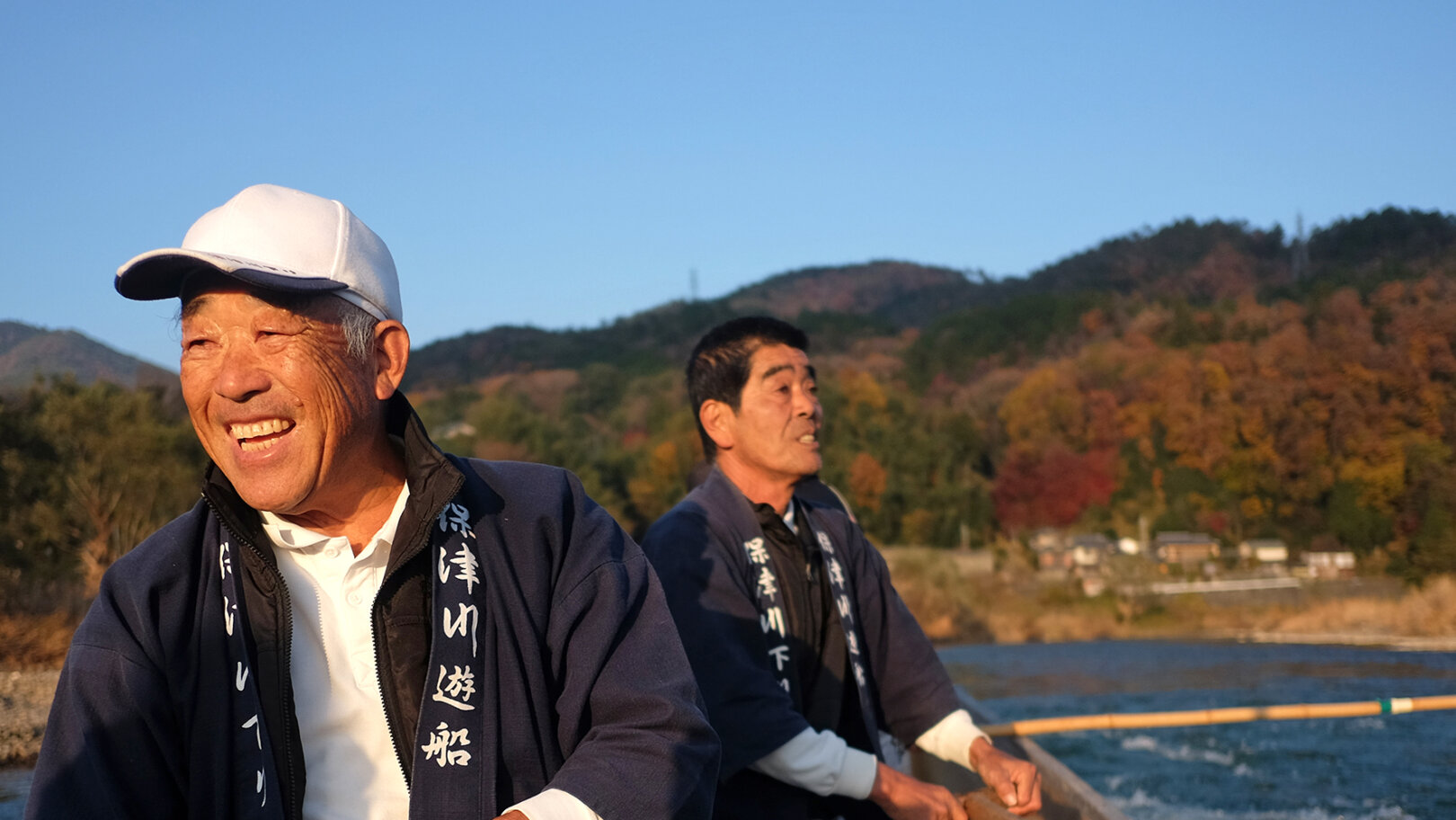
Anna Brech 22nd Oct 2022 10 min read
With its glorious tapestry of remote mountain temples and thriving cityscapes, Japan hits the sweet spot on many a travel bucket list. From rich cultural traditions to dazzling cuisine (give us a fiery miso ramen, any day), this is a country that was made to surprise your senses, making a solo trip to Japan a great option for anyone looking to try travelling alone. Even the travel-weary can’t fail to be charmed by Japan’s fusion of beautiful landscapes and hi-tech hubs that buzz with colour and energy.
Indeed, spending time solo is pretty well ingrained and normalised in Japan. Counterside tables for one are part of the furniture in any restaurant or cafe. But language barriers and cultural nuances can, at times, be hard to navigate entirely alone, so joining a group tour with other like-minded solo travellers, like on Flash Pack ’s Japan: Another World itinerary , can give you that balance of self-sufficient solitude, while taking the hassle out of planning and ensuring those all important bucket list moments are all carefully curated for you. Here’s everything you need to know about group solo travel to Japan .
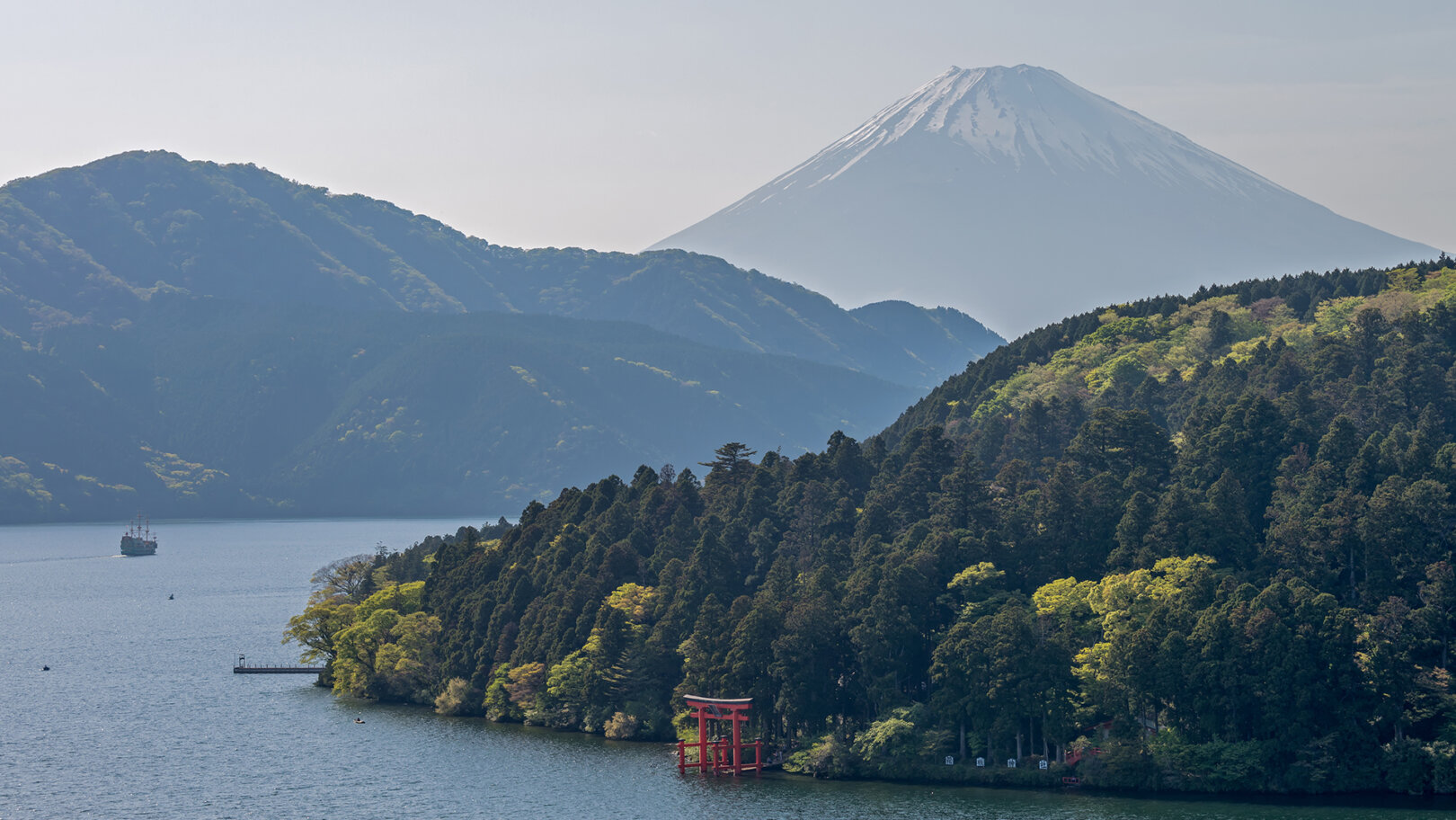
Japan travel facts
While its cities often take the spotlight, 70% of Japan is made up of forest and mountains. There’s over 100 active volcanoes, with its tallest mountain, Mount Fuji, peaking at 3,776 feet. Throughout this island nation, there are also 25 Unesco World Heritage Sites – 20 of which are cultural (like Himeji Castle) and five are natural (like Shiretoko National Park). It’s not all just happening on the main island of Honshu, either; Japan has nearly 7,000 islands to hop around, making it the fourth-largest archipelago in the world. Choose the small island of Ōkunoshima for its population of rabbits (yes, really), or Hokkaido for fresh powder and off-piste skiing in winter.
Is Japan good for solo travel?
Solo travel in Japan is safe and it’s easy to get around thanks to the country’s excellent transport links. It’s also a place where being alone is celebrated. In some countries, you may feel out of place if you go out to eat or drink solo, but not in Japan. It’s so normalised that it’s incorporated into the language: the term ohitorisama (which roughly translates as “party for one”) refers to people living and doing things alone, often reverently so.
Meanwhile, the Japan National Tourism Organisation operates a 24-hour English-speaking helpline that is particularly helpful for solo travellers, providing a great resource of tourism information and help. Want to ease yourself into the experience? Take a look at Flash Pack’s Japan trip for solo travellers , offering 12 days of adventure in the company of a small group of like-minded people.
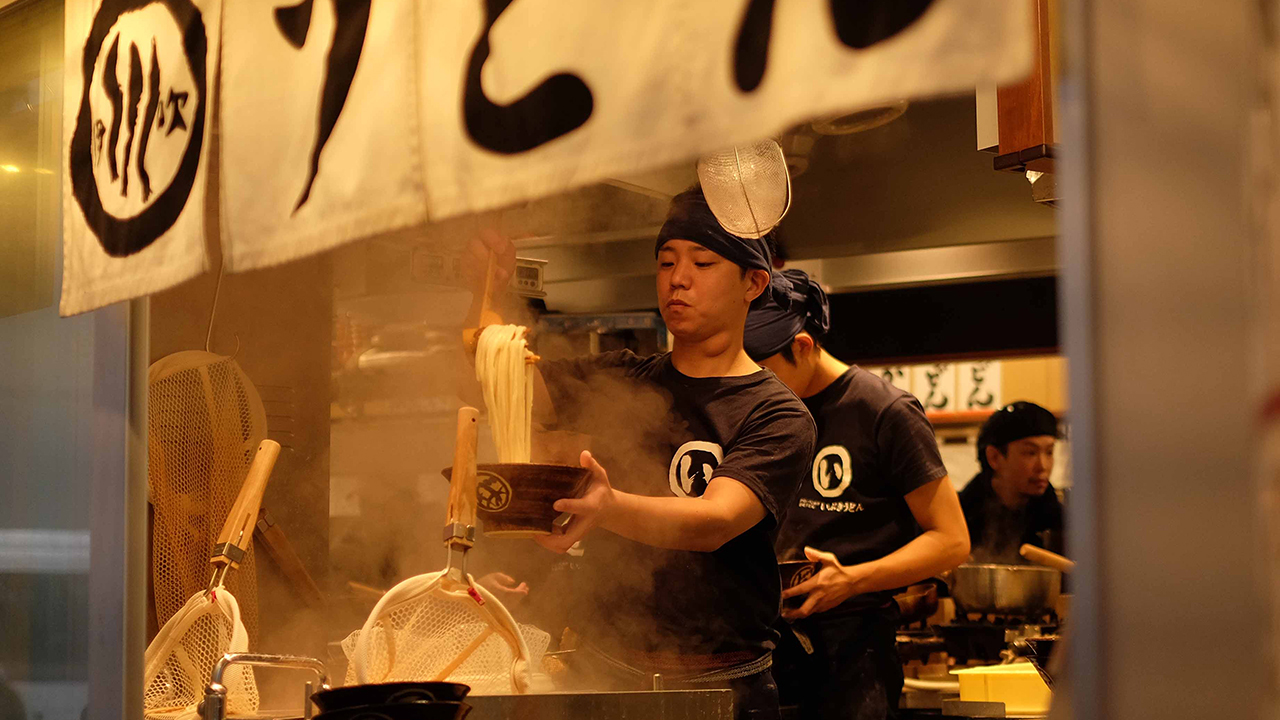
Best places to visit in Japan
Head to one of Japan’s tachinomi (standing bars) to try out kushikatsu (bamboo skewers of deep-fried meat and vegetables), along with delicious edamame and draft beer or sake. Other great street food to try includes okonomiyaki (savoury pancakes filled with grilled squid or pork) and takoyaki (fried octopus-stuffed dumplings). You’re likely to eat your body weight in kitsune udon (Japan’s beloved noodle broth), but for something a little different, try a kappo restaurant – for high-end, multi-course dining, without the formality of its kaiseki cousin.
On a solo holiday to Japan , outdoor pursuits, such as hiking along the Old Hakone Highway, or forest bathing in the bamboo trails of Arashiyama, allow a chance to unwind and appreciate Japan’s spectacular natural landscapes. Onsen hot springs, especially those that are found in remote mountain settings, are a delight. On the other end of the scale, you have the cities: who could resist the neon-bright lights of Osaka by night, or the cafes and ateliers of Tokyo’s arty Nakameguro district?
Finally, Japan is steeped in culture, and its ancient sights are not to be missed: make a beeline for the Great Torii floating shrine on the scenic island of Miyajima, along with the iconic red gates of Fushimi Inari shrine. Kyoto – Japan’s cultural capital – is a treasure trove of photogenic temples and lantern-lit streets.
Where to stay as a solo traveller in Japan
What are the hotels like in Japan? There’s a huge range to choose from on a solo holiday. Whether you’re looking for a boutique city retreat, a futuristic skyscraper or a rustic countryside guesthouse, this is a place that has it all. You’ll find everything from centuries-old rural ryokans with tatami-matt floors, onsite onsen and multi-course kaiseki meals to high-tech hotels in Tokyo. As a solo traveller, you’ll have more flexibility than most, but it’s still worth booking well in advance. Japanese hotels book up fast, especially in the cities and during peak seasons. On a group tour with Flash Pack, you bypass any hotel hassle and typically share a room with another like-minded solo traveller, thereby serving the single supplement. Still want a room of your own? That’s no problem, too.
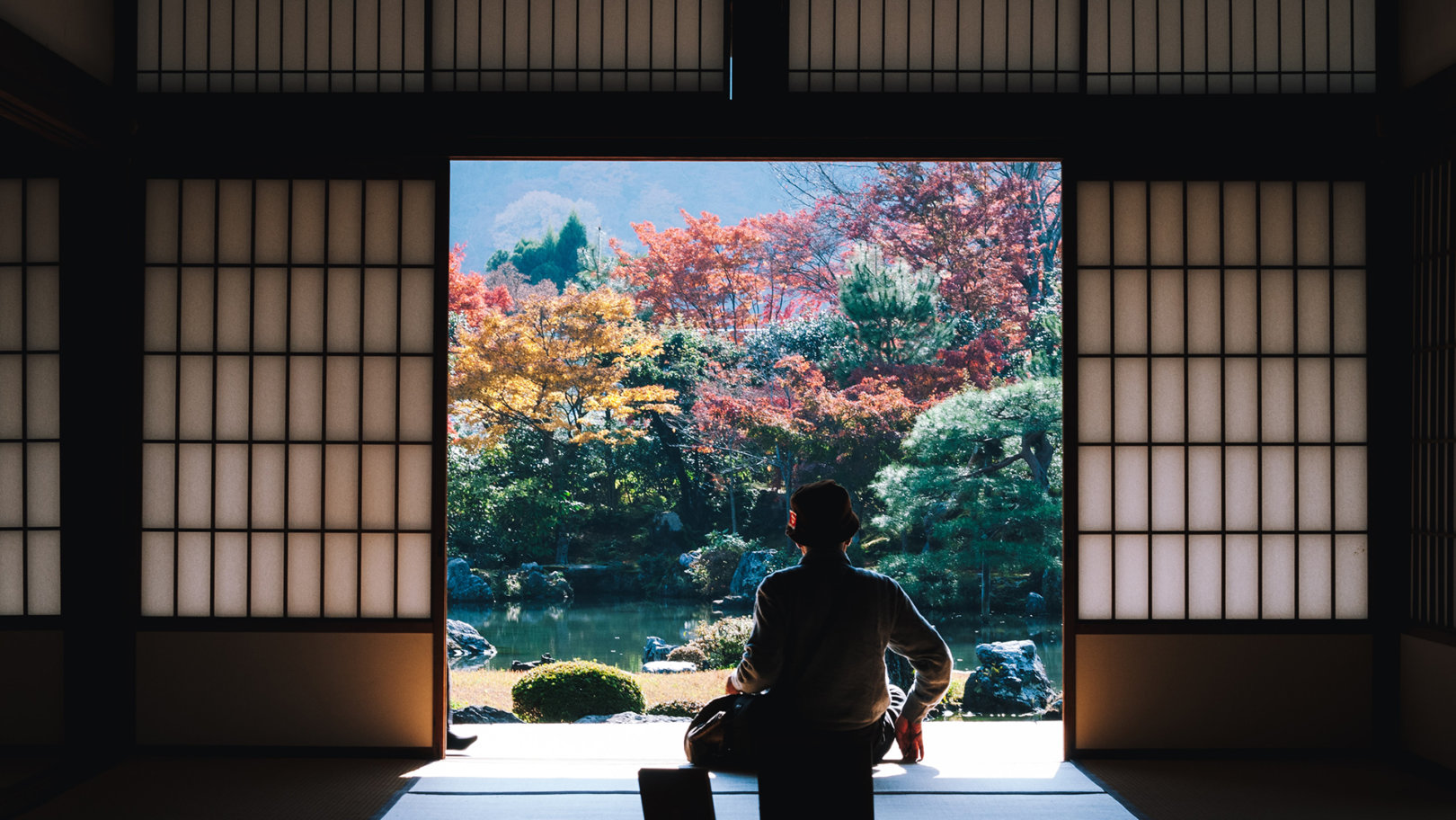
How to get to Japan
The simplest way to kick off your Japan solo travel experience is by flying. A number of airlines (including Japan’s ANA and Nippon Airways) fly nonstop from destinations, including the US, Canada and the UK to Osaka, Tokyo and Nagoya, all on Honshu island.
Another option is by ferry with Japan being accessible by sea. The main routes go from China and Korea, docking up in Osaka and nearby Kobe. Japan is an island country, but there’s a series of rails running from Europe that can eventually lead to Shanghai in China, where it’s possible to catch a ferry onwards.
How to get around Japan
Super-fast shinkansen (bullet trains) are the most popular means of getting around Japan, as well as arguably being the best. Indeed, the rail system is fast, efficient, reliable and one of the cheaper modes of transport. If you’re planning to travel for a month or so by yourself, it’s a good idea to purchase a Japan Rail Pass . These are exclusively available to tourists and offer great discounts on long-distance Japan Rail train journeys for one-, two- or three-week periods.
Japan also has a network of long-distance buses that connect the islands of Honshu, Shikoku and Kyushu. Another option is renting a car, which gives a bit more access to some of the national parks and nature-based attractions. Or ferries and domestic flights are easy to book. One of the biggest benefits of travelling with Flash Pack is that all internal travel is covered and planned ahead of time for you, whisking you from A to B without the hassle of organising transfers yourself.
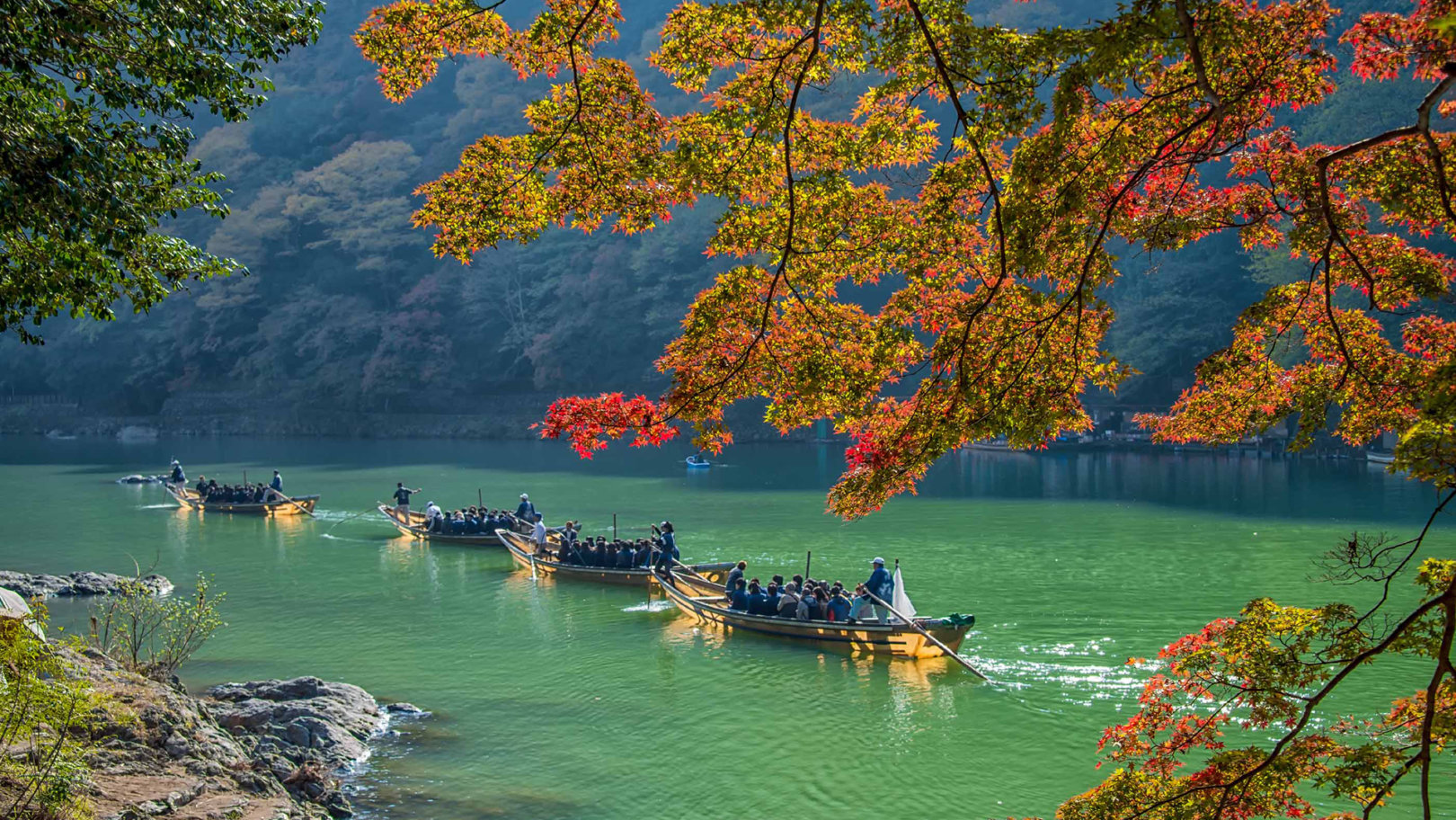
Best time to visit Japan
This really depends on what you’re looking for on a solo trip to Japan . Spring (March to May) is a beautiful time for seeing the famous sakura (cherry blossoms) and is peak time for travellers, though the weather is notoriously unpredictable, ranging from 4-18°C. Travelling during October and November is a great time to witness Japan’s koyo (autumn colours), with maple leaves turning fiery red and temperatures between 10-21°C.
Summers are hot and humid (usually 21-32°C) and can be a better time for hiking at higher altitudes in the southern region of Kansai on Honshu island, while being shaded under canopies of leafy green trees. Winter, meanwhile, is cold, coming in at sometimes sub-zero temperatures, with snow settling and Japan becoming a skiing destination – especially on Hokkaido.
Japan travel itineraries
Between the ancient Buddhist temples and futuristic cities, the mountainous hiking ranges and wistful winding rivers, there’s a lot that can be seen and experienced in Japan. Flash Pack’s Another World trip takes care of everything. Culture, cuisine and adventurous activities are all packed into the 12-day itinerary, with space for socialising and solitude between the unique activities. Land in Osaka to check out Japan’s foodie city (home to Wagyu beef) before learning about the history of Hiroshima and visiting a floating shrine on the little island of Miyajima. From here, there’ll be a temple stay and onsen bathing in Kyoto with a tea ceremony and geisha-led dinner, plus a ramen masterclass, sumo wrestling, sake, sushi and more throughout the rest of the days.
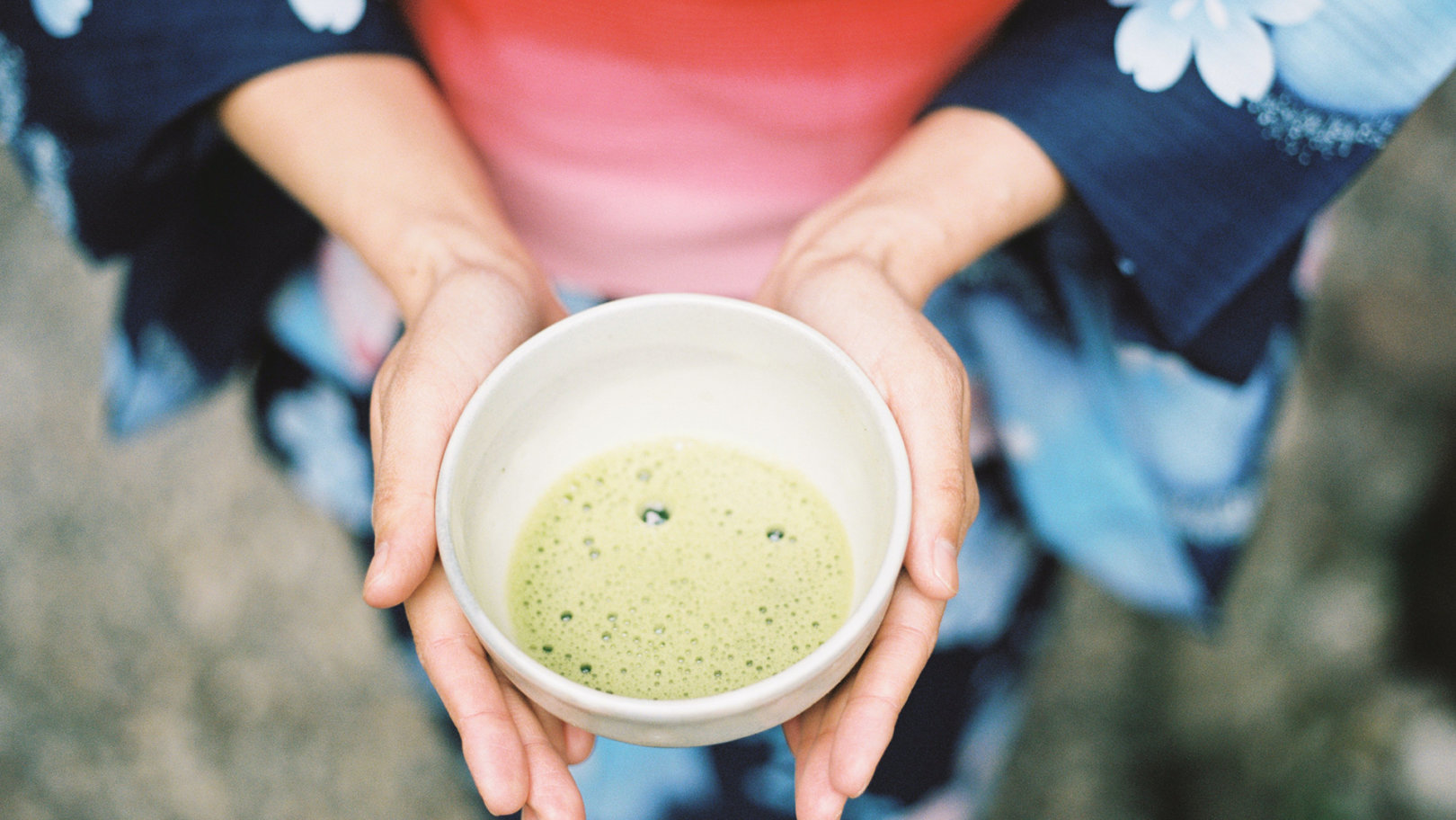
What to pack for solo travel in Japan
In short, it’s best to pack light for solo travel in Japan . Hopping on and off high-speed trains – which often have limited luggage storage – means a backpack or lightweight soft-shell wheeled suitcase is best. Inside, pack clothing to cover all climatic bases: lots of light layers, cotton tees, long-sleeved tops, light jackets and thin jumpers. Japan is still a cash-based economy in some places, so it’s good to have some Japanese yen handy, along with an extra credit card.
Solo travel advice for Japan
Japan, with its vast array of spiritual sites and serene nature trails, is the perfect place to regroup and reflect as a solo traveller. In almost every city you’ll find traditional landscaped gardens once used by Japan’s lords and leaders as a prime location for dwelling and dreaming.
Away from the hubbub, make a beeline for remote temples, forest-trailed mountains or islands peppered with picturesque rivers and castles. Ethereal waterfalls, vast flower-filled parks and striking alpine routes are also yours to explore. And, of course, Japan has a long tradition of onsen hot-spring bathing that is the very definition of solitude, often connected to classic Japanese ryokan (inns).
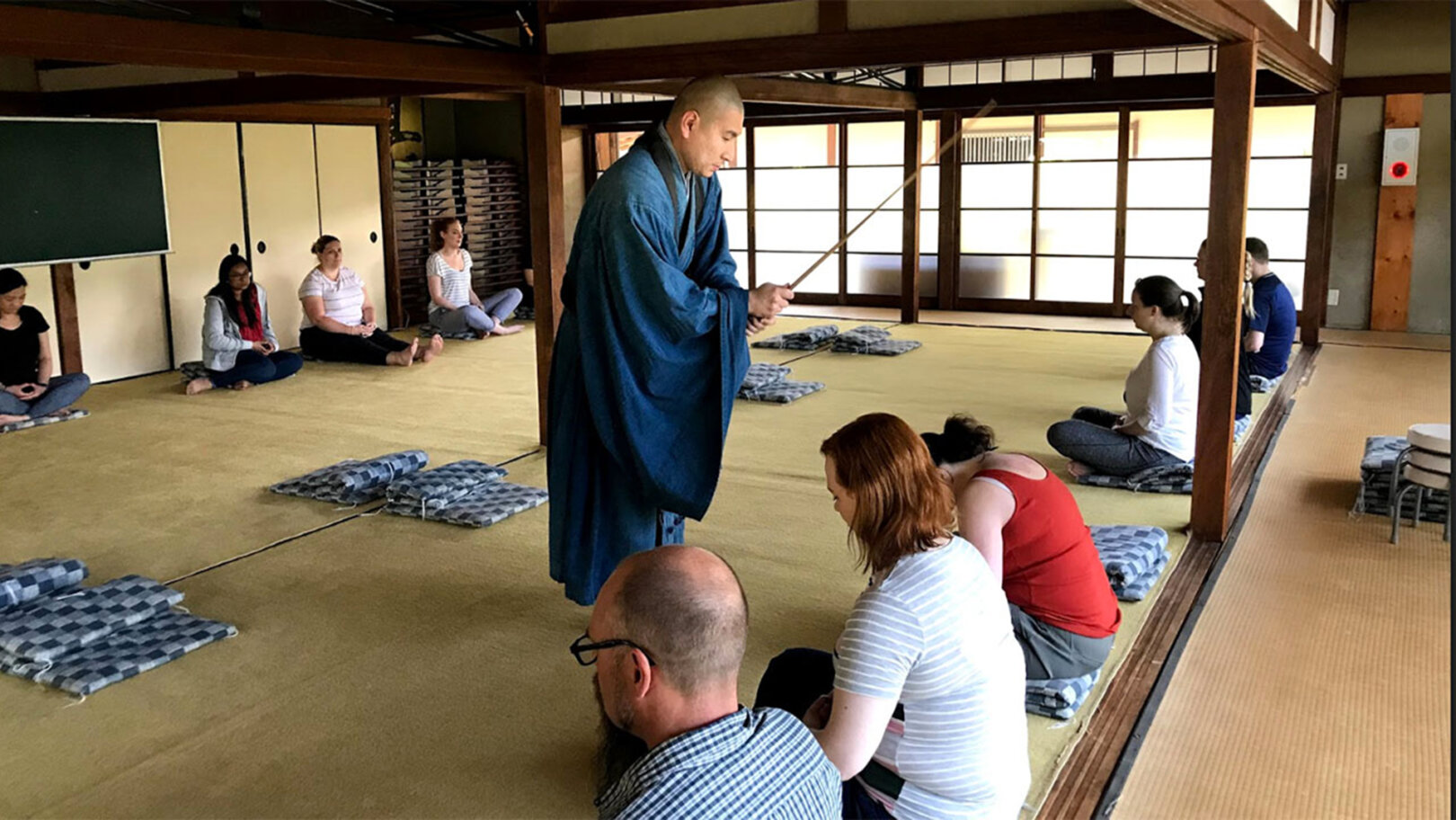
Is it safe to travel solo in Japan?
Thousands of visitors experience solo travel to Japan every year and most trips are trouble-free. However, do check out the Foreign and Commonwealth Office (UK), the Department of State Travel Advisories (US) or your country’s local government guidelines for the latest advice before travelling. Once there, follow local advice and be aware of your surroundings and belongings at all times.
Solo travel in Japan is all the more enticing thanks to its excellent safety record and low crime rates. Travelling solo is particularly normalised and catered for, including women-only spaces in spas or train carriages. For extra peace of mind, it’s always worth considering travelling with a group of other solo travellers.
Ready for your next adventure? Try group solo travel to Japan with Flash Pack – designed exclusively for people in their 30s and 40s, seeking the independence of solo travel within the safety of a group.
A cool 98% of Flashpackers arrive solo to join our group adventures . So, you’ll be in good company – whether a first time solo traveller or a seasoned pro looking for like-minded new friends.
Images: Flash Pack
The best places to go in April: Our top travel picks for a solo holiday
By Nina Zietman
FLASH PACK STORIES
Your latest travel inspiration

The magic of work friendships: Lauren and Emma
These two forged a deep workplace connection – despite living 3,000 miles apart.
The Flash Pack team 17th April 2024 10 min read
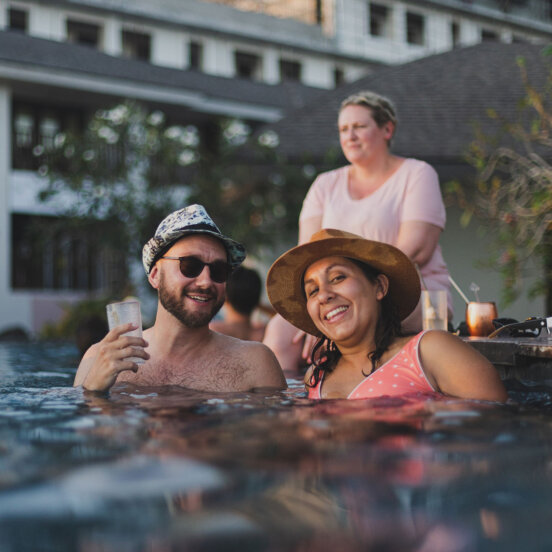
Find your people: why friendship could be key to better mental health
Strong, loyal friendships are a source of lifetime happiness and health – and they become more important as we age. Here’s why.
Anna Brech 4th April 2024 10 min read
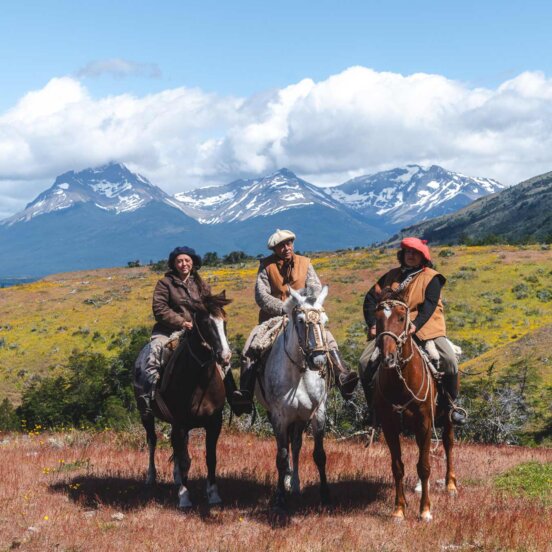
The ultimate solo travel guide to Chile: Everything you need to know
Want to travel solo in Chile? Discover everything about heading to Chile as a solo traveller including top destinations and safety tips.
Amy Swales 4th April 2024 10 min read
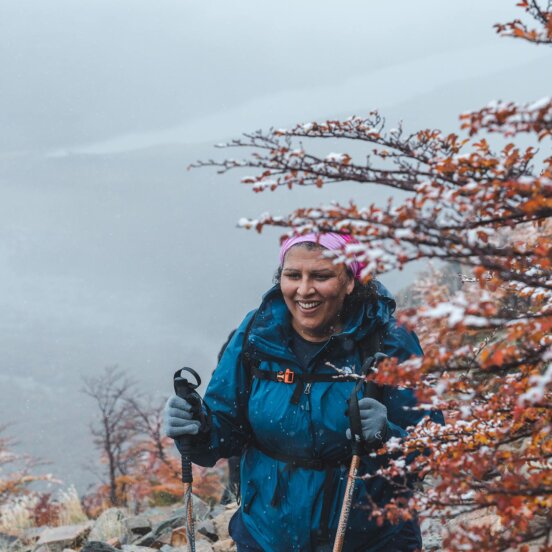
Solo hiking: Everything you need to know
Let loose in the wild outdoors, in a group or solo, with these top tips for hiking abroad.
Charley Ross 3rd April 2024 10 min read
Subscribe to our newsletter
Sign up to our newsletter.
Hear about our new adventures before anyone else
Hear about our new adventures before anyone else.
Be the first to hear about exclusive Flash Pack offers.
Access exciting competitions.
Receive weekly inspiration and travel stories from solos just like you.
You are browsing our US website.
Please choose your current location below:
You are browsing our UK website.

- Hit enter to search

My Ultimate 10-day Itinerary for Your Solo trip to Japan
- February 13, 2021
- Japan , solo , travel , wanderer , wanderlust
It’s no secret that Japan is a breathtakingly beautiful country and one that must be on your travel list . A country that appeals to all of your senses and leaves a lasting impression on your mind. From the dazzling lights to beautiful and serene Zen temples and shrines, Japan has a lot to offer on its plate.
But when a country has so many beautiful experiences, there arises a problem—the problem of plenty. As a solo female traveller, none of us has the luxury to spend forever in the beautiful island country. So how do we plan the trip within a stipulated time so that we can include all the experiences? Isn’t that a million-dollar question? So here I am, trying to plan a 10-day solo itinerary to Japan for you.
To be honest, I have taken on an extremely difficult job. Ten days is almost impossible to explore Japan. In fact, ten days is not nearly enough to explore a single city. But alas, we do not have the luxury to spend forever here. So, let me tell you how to plan your perfect 10-day solo travel itinerary to Japan.
Day 1: Reaching Tokyo
Tokyo absolutely should be the first place on your Japan itinerary. It is not only because Tokyo happens to be the capital city of the country but also because it is the perfect melting pot of the old and the new.
You will definitely be jet-lagged on your first day after a long trip. Pop in a jet lag pill if things get really bad for you. But even otherwise, I would recommend that you take it lightly on the first day. If you are landing at midday, check into your capsule hotel (I can’t recommend this enough) and then freshen up and leave to explore Shibuya.
My favourite part of Tokyo – Shibuya
Walk leisurely along the world-famous Shibuya crossing and spend some time just taking in the essence of modern Japan. With its bright lights, huge electronic posters, and a throng of people around, Shibuya is often compared to New York’s Time Square. Also, if you love the movie Lost in Translation, you will immediately love it. The best thing to do is to see people literally pouring in from all directions!
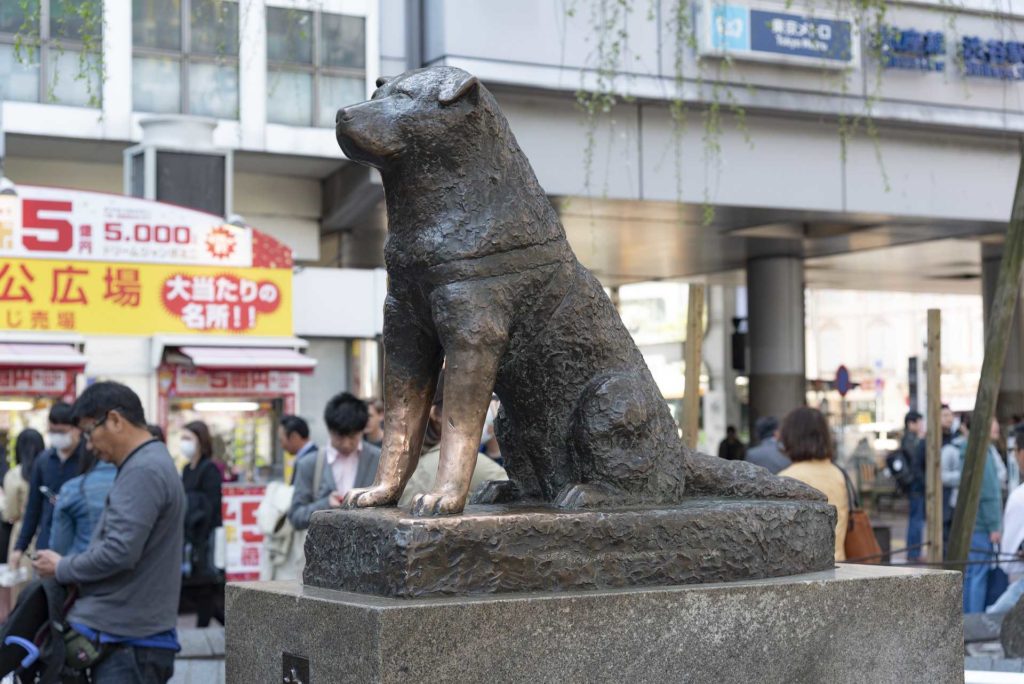
But that is not all there is to Shibuya. Before you get to the crossing, stop to see the statue of the most-faithful dog that ever was: Hachiko. If you are visiting Tokyo at the beginning of March, you can also see people honouring Hachiko on March 8. Plenty of dog owners come with their adorable dogs to pay their respect. It gives you the perfect opportunity to see and pet some dogs. Have food at some of the best ramen places in Shibuya for dinner. Opt for the Tonkatsu broth, and it will soothe you and prepare you for the arduous journey ahead in our Japan itinerary. Or you can queue up at Genki Sushi, where sushi comes to you on a conveyor belt.
The options for delicious food are too many in Tokyo. So why don’t you go through the list of 15 must-visit restaurants in Tokyo and learn more?
Start the morning bright and early at the Meiji-Jingu shrine in Shibuya for that peace and quiet. The Shinto shrine is dedicated to deified Emporer Meiji and his consort Empress Shoken. Also, walk around the adjoining Yogogi park and prepare yourself for the roller coaster day ahead!
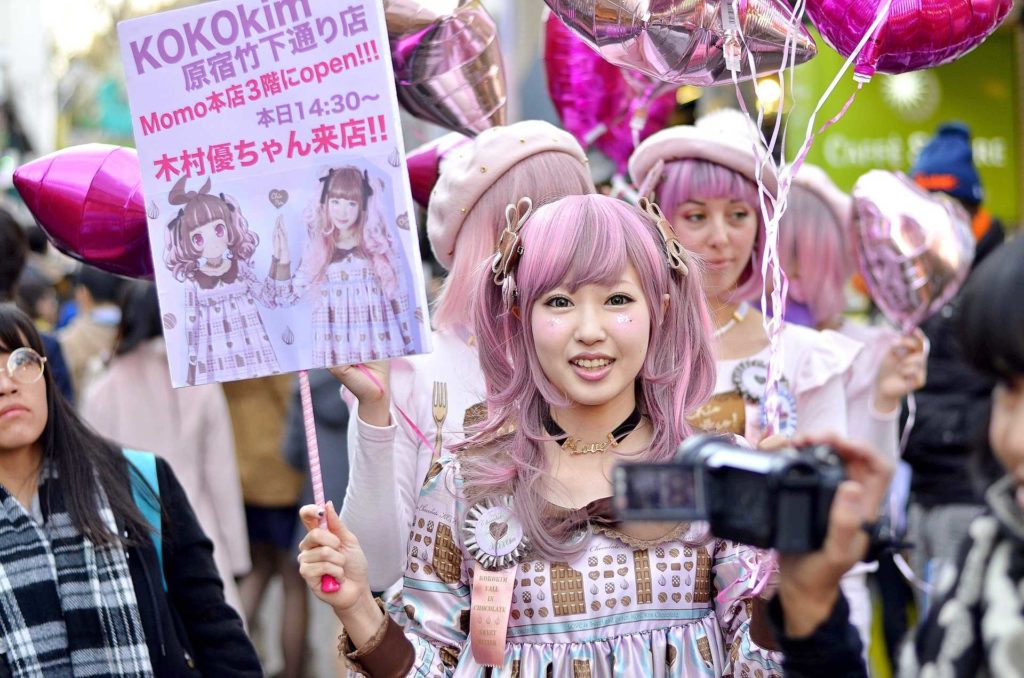
Next, let’s head to Harajuku, Tokyo’s most fun district. If you are a fan of anime, do visit this place on a Sunday when you find girls dressed in anime costumes on the streets. If not, don’t be disappointed. Harajuku still has plenty to offer. Walk along the famous shopping street of Takeshita Dori. Though everything you see will catch your attention, restrain yourself. You still have a long way to go in the country, and there’s no need for extra luggage at the beginning of the trip. But even if you are not shopping, be sure to try out the famous street food crepe. Next on our Japan itinerary, we have Shinjuku. It’s the trio that completes the trip.
Shinjuku is again lively, bright, loud, and crazy. Take in all the essence of modern Japan here. You can either visit the Robot restaurant or, even better, try out the experience at Omoide Yokocho, commonly known as Piss Alley. It is a lot like Spanish tapas bars where you get good alcohol and small portions of food.
After you have eaten, end the day with a grand view of the beautiful city from the 45th floor of the Tokyo Metropolitan government building.
Walk up, and let’s begin. You have walked a lot the day before. Your legs are a little tired. You might also have a little too much sake to drink at the Piss Alley. So, let’s start with a good breakfast of eggs. Visit the Tsukiji Fish Market to try out tamagoyaki at Yamachou and Marutake. The piping hot, sweet, and savoury dish melts in your mouth and provides the perfect beginning to your day.
After this, take a train and get off at Aomi station and exit from the north end, and be prepared for a visual treat that is beyond your wildest imagination. A magical mix of colour, light, and sound teamLab Borderless is the world’s first digital museum where art is confined to a room but is rather seamless. It uses 500 computers and 470 projectors to create an indescribable experience. Also, this the coolest place to click all your pictures to upload on Instagram.
After the experience here, spend some time with yourself at Ueno park in Tokyo. I would always recommend travelling to Japan during the cherry blossom season. The country turns a shade more beautiful during the season of sakura. If you do travel, then Ueno Park should be on your Japan itinerary as this is ultimately the best spot in Tokyo for hanami . End the day with a trip to Tokyo SkyTree, which is the tallest tower not only in Japan but the entire world.
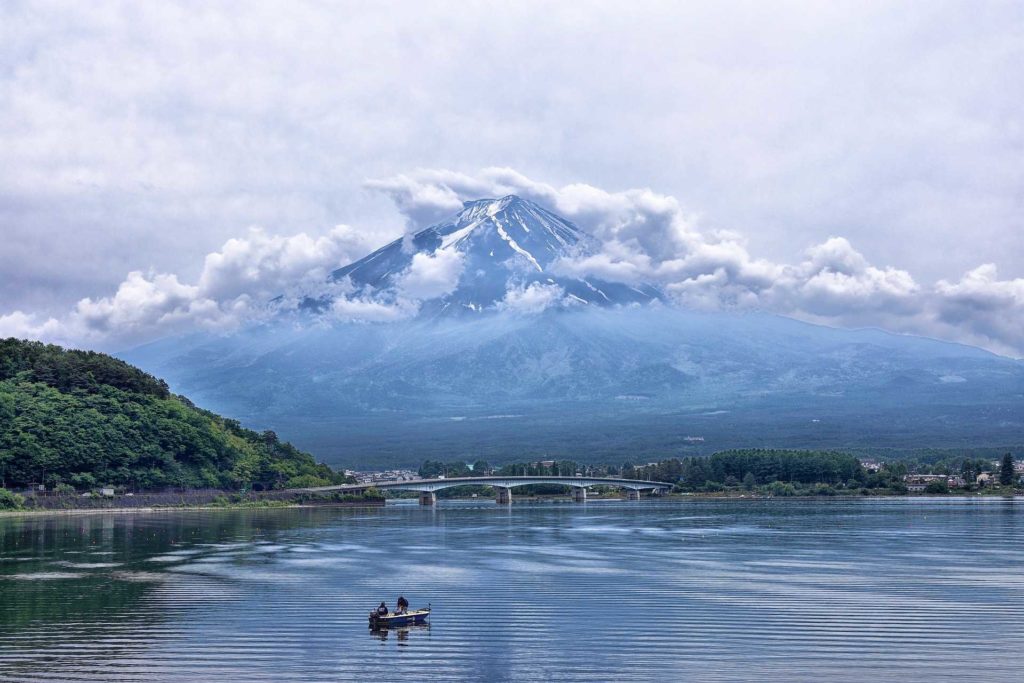
Seeing the beautiful Mount Fuji should definitely be on your Japan itinerary. The majestic view of the mountain is second to none and is bound to make you feel humble. So, after we have seen the hustles and bustles of the capital, let’s take a day trip to Hakone. But I have a tip here. You might travel all the way to Mount Fuji only to see it behind a mesh of clouds and be disappointed. So, check the weather forecast before travelling and even if you see that the morning is a bit cloudy, scrap plans for Hakone and instead include a day trip to Nikko or Kamakura to your Japan itinerary.
Day 5: Kyoto is the next stop
It’s time to bid Tokyo goodbye for now because it’s time to see the rest of the beautiful country. But before you board your first bullet train in Japan, do remember to get your Japan Rail Pass . It will make travelling so much easier and reasonable in a foreign country. And now time to travel to Kyoto where we will spend the next couple of days.
Try and take an early morning bullet train from Tokyo so that you can reach Kyoto by 10.30 am and enjoy the full day in the beautiful city. Check into your place of stay (a ryokan is definitely recommended here), freshen up, and prepare for the day. While Tokyo is lights, glitz, glamour, Kyoto is where you get to experience the essence of old Japan the difference in scenery is soothing.
Explore the bamboo forest
Take a bus to the Saga-Arashiyama station, where your first stop is the Tenryu-Ji Shrine and the beautiful Zen garden accompanying the shrine. A beautiful collection of flora awaits you here, most of which you will not find outside Japan. Once you leave the garden, you will come across the Arashiyama Bamboo Forest, and walking through the forest is a once-in-a-lifetime experience. It takes around 15 minutes to walk around the entire grove, so walk at a slow pace and take it all in. Also, the pictures come out really well here.
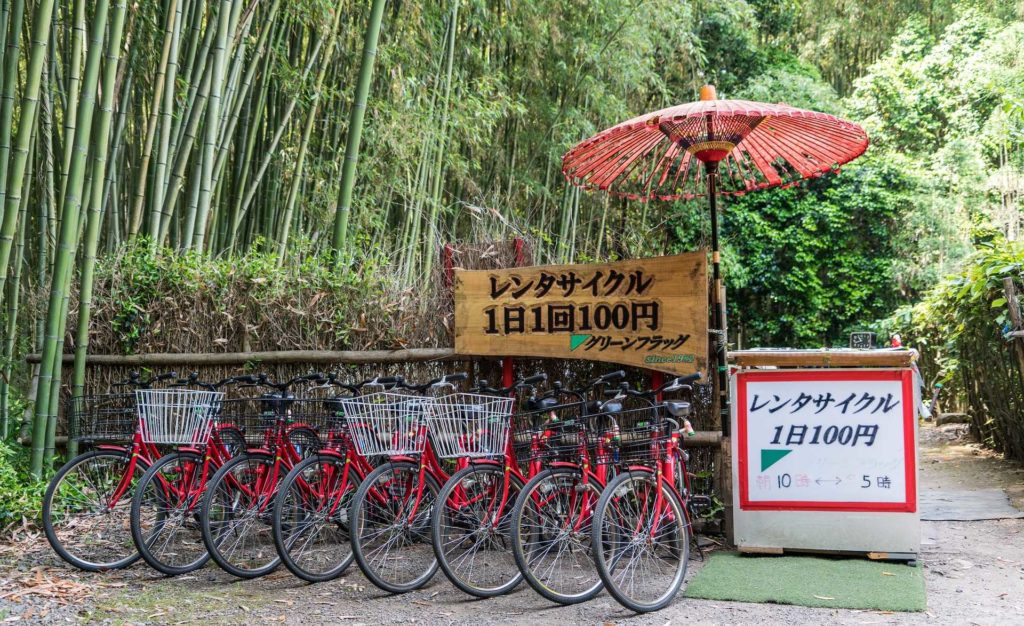
After you roam around the bamboo groves, it’s time to meet some cute little monkeys at the monkey park. It is a 20-minute climb to the top, and I often wondered if it was worth it. But trust me, even if the journey seems arduous at first, it is beautiful when you reach there. The park houses about 100 snow monkeys, and the view from this place is spectacular. You can also feed the monkeys here for a very small amount, and they will pose for you!
After monkeys, it’s time to witness the golden hour at Kinkakuji or the golden pavilion. With two of three storeys made of gold, Kinkakuji, looks radiant and the best part is the reflection on the moat that the shrine stands on. The best time to visit Kinkakuji is definitely sunset when the slating sun rays fall on the pavilion, making it look like it’s on fire. Then drag your weary self to the ryokan to enjoy some of the best Japanese hospitality.
Get up early in the morning because the first thing today on the Japan itinerary is the Fushi Inari shrine. It is best to go early so that you can get the best click at the vermilion coloured gates that is so well known. Interestingly, each torii gate at the shrine is a donation. The trek up the hills is beautiful early morning.
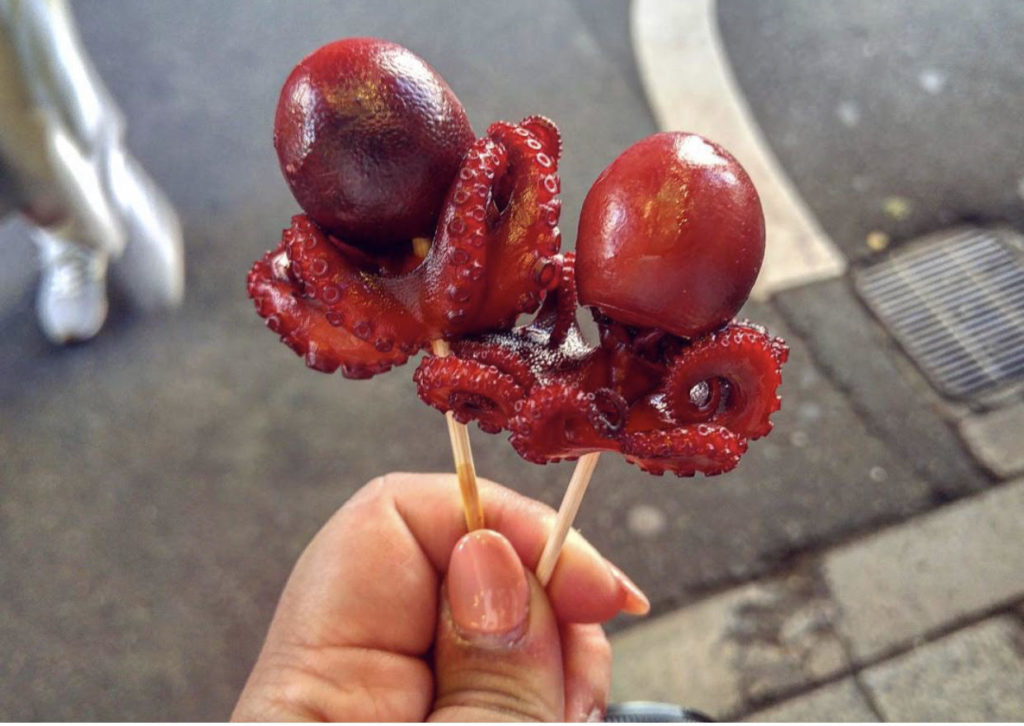
Now that you have worked up an appetite let’s get acquainted with some of the most delicious food Kyoto has to offer. Stroll along with Nishiki Ichiba Market, known as Kyoto’s kitchen, and for very good reasons. This is the best place to get out of your comfort zone and try out new food. I assure you won’t be disappointed. You should definitely have the tako tamago, a specialty of Kyoto, which is a candied octopus with a quail egg stuffed in its head. Yum…
The next part on your Japan itinerary is something that I know you have been waiting for in Kyoto. Yes, I know. Spotting a geisha. The best chance of spotting one is on a walk in the Gion district, though the chances aren’t too high. But in case you spot one, remember to be courteous. Don’t follow them or stuff your camera into their faces. If you want to feel like a geisha, you can dress up in silky kimonos and paint your face, and have your picture taken.
After this, visit the Higashiyama district, Kyoto’s best-preserved heritage area. With numerous temples, shrines, gardens, and tea houses, this takes you back in time. End your Kyoto trip with a walk along Philosopher’s path, which if you are visiting during sakura season takes the beauty to another level.
Bidding adieu to the beautiful city of Kyoto, next on our Japan itinerary is a day trip to Nara. Just an hour from Kyoto, Nara is known for its deer park, where over 1000 deer roam freely. During the sakura season, this place is a must-visit as pink and white petals of the cherry blossoms wafting through the air and land on the ground turning the park into a shade of light pink.
After spending time with the adorable creatures, do visit the Todai-Ji temple, which dates back to 752 AD. This is a UNESCO site and is known for its 15metres tall bronze Buddha statue. A visit to Nara is incomplete without trying the city’s famous snack- mochi, which is a warm sticky cake with red bean paste inside.
A trip to Osaka
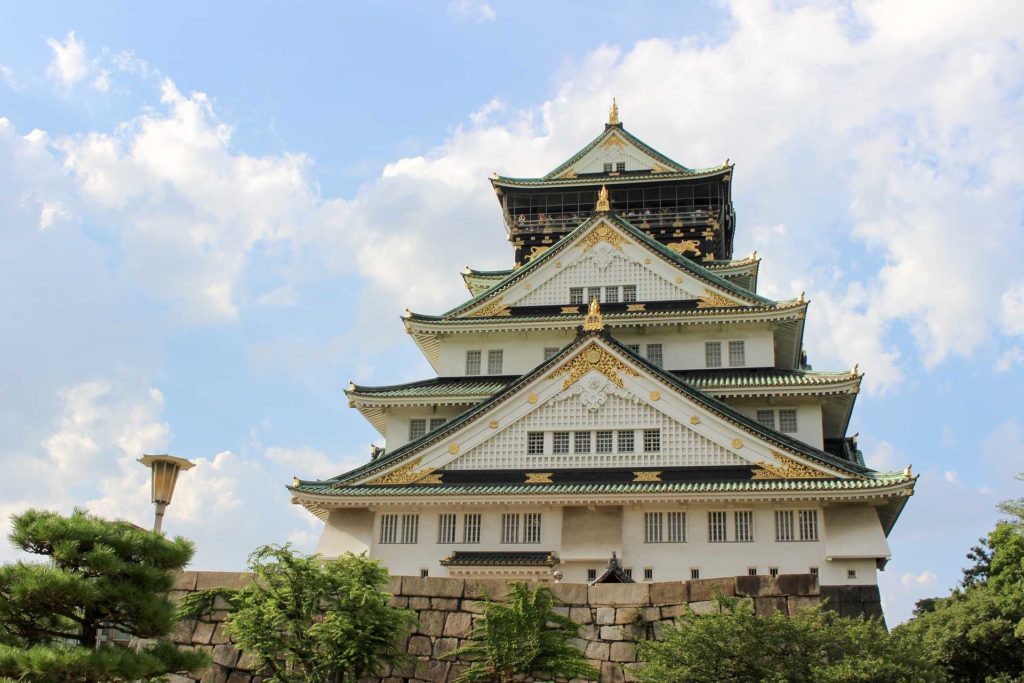
After exploring Nara, it’s time to head over to Osaka. Try and squeeze in a visit to the Osaka castle if you are here during the sakura season.
The best way to take in the essence of the beautiful castle that was built by Hideyoshi Toyotomi is by taking the Gozabune. It is a luxury boat that takes you along the inner moat surrounding the castle, and you can enjoy the castle while relaxing on the boat. After visiting a piece of Japanese history, it’s time to jazz up your night.
Next on your Japanese itinerary is a trip to Shinkensai. This is a place where the past meets the present. The nostalgic post-war atmosphere hangs heavy in this area. It has a very vintage Paris or New York feel to it, and that’s what makes this so special. The best part? The Tsutenkaku Tower here resembles Paris’ Eiffel Tower and the view of the city from it. End your day with some delectable kushikatsu, which is skewered and battered, deep-fried food that can range from chicken to vegetables and even desserts!
According to your Japan itinerary, today is ‘fall in love with Osaka’ kinda day. Start the day with a visit to Universal Studios. It is always crowded so be sure to book tickets way before your visit.

Wake up the inner child in you and allow it to go crazy. From Jurrasic Park to Spiderman to Jaws to Harry Potter, this is one place where you can experience it all. You will definitely be exhausted after this, so let us reserve the rest of our trip strolling around Dotonbori and experiencing the best that Osaka has to offer: food.
Dotonbori is known for the huge neon advertisements, glitz, the giant crab with movable limbs, and the famous Glico sign. Dotonbori is a shopping paradise, and I am sure many a thing with catch your eye here. But the best thing about Osaka, if you ask me, is the food. Osaka is the food capital of Japan, and rightly so. From the okonomiyakis to the udons and the takoyaki it will leave a lasting impression on your palette. If you want to explore Osaka more, there are plenty of other things you can do .
This day is a little jam-packed on your Japan itinerary. But I promise you it will be well worth it. Today we will cover not one but two places in a day. Miyajima and Hiroshima. Travelling will take a little time but fret not because it is all covered by your JR Pass.

I would recommend visiting Miyajima first. Once you reach the station, head straight to the torii gate but not before meeting some extremely friendly deer. During the high tide, the torii gate looks like it is floating and is a beautiful sight to behold. After you have seen this, head out to explore the city a little more, but this time on a ropeway before taking a trip to Hiroshima on a ferry.
We all know how War War II ravaged Japan. And Hiroshima is the symbol of what war and strife can destroy in the world. But today, the city is an ambassador of peace while it still remembers its gory past. The peace museum houses remnants of the nuclear bomb blast like pieces of clothing from people who died that day. It is sure to bring a tear to your eye.
But Hiroshima is so much more than just a bomb site. Do visit the Hiroshima castle, where you can catch Samurai performances outside the castle walls. It is now time to head back to Osaka or Kyoto, whatever works out better for you. Tomorrow on the last day of the trip, you will travel back to Tokyo again.
Back to Tokyo again. Feels strange right? With the trip almost over, it feels like the last day during a vacation before the school reopened. But such is life. So, let’s not waste time and see that our last day in this beautiful country is enjoyed to the fullest. And for that, we will spend a leisurely day at the Akihabara district. This area is famous for its manga and anime stores, so if you are a fan, you are in luck. Check out huge electronic stores, spend hours at a gaming arcade and eat at a themed cafe in the area. This is indeed the perfect day before boarding the flight the next day.
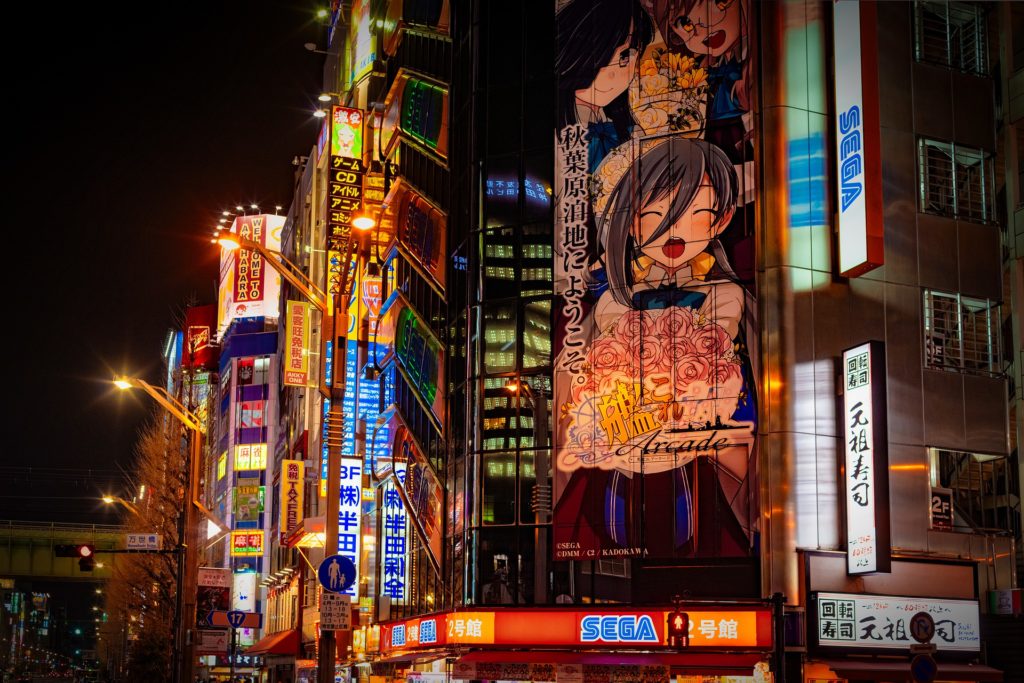
I can tell you that the itinerary of your Japan trip that I have chalked out for you is quite hectic and involves a lot of walking. But what can you do if there are so many sights to behold in the beautiful country? So even though it might have been hectic, I am sure you will at no point feel exhausted. Instead, you’d be excited for more. And when the time comes after ten days to say sayonara to Japan, I assure you, your heart will be heavy.
An introverted blogger who is looking to make unforgettable solo travel memories with one short life.
Related Posts
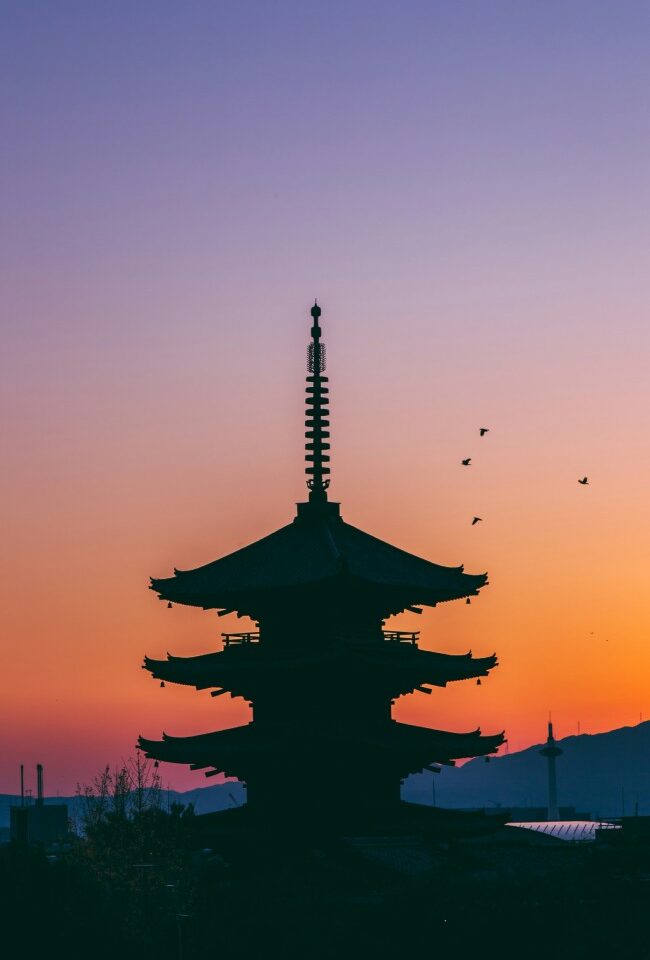
Best Temples and Shrines You Must Visit on Your Solo Trip to Kyoto
- by Swagachi
- April 13, 2024
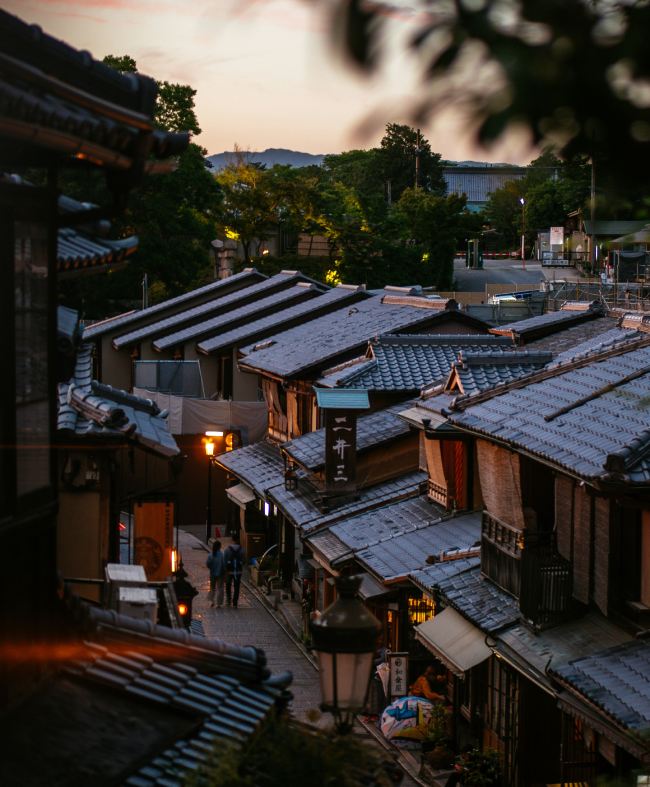
5 Activities You Cannot Miss on Your 2-Day Stay in Kyoto
- April 9, 2024
Leave a Reply Cancel Reply
Save my name, email, and website in this browser for the next time I comment.
Submit comment
Copy short link
- The Solo Travellers Guide To...
The Solo Traveller’s Guide to Japan

Contributor
Welcome to another world – and another whirl. Neon-drenched cities and ancient wooden temples; whizzing bullet trains and serene tea ceremonies; geishas, samurai and majestic Mount Fuji rising cinematically into the clouds. Japan is full of evocative moments. Once you experience the country’s thrilling urban centres, scenic rolling countryside and rich culture, you’re sure to fall in love. Who needs a travel partner when you’ve got a destination this enticing all to yourself?
What’s the vibe.
This is one of the easiest countries to navigate as a solo traveller. There is an excellent train network to make your trip efficient and affordable, and plenty of hotels specialising in single rooms. Most restaurants are set up well for solo diners, as are attractions. What’s more, Japan is safe and friendly, so you won’t feel intimidated on your explorations.
A Japan solo trip overview
You can pack Japan’s top two must-sees – Tokyo and Kyoto – into a week, but it’ll be rushed and you’ll miss out on some of the magical moments that come with slower exploration. Two weeks is better, and three ideal, as you’ll be able to add in day trips from Tokyo, plus a couple of days each in second city Osaka and poignant Hiroshima. You should also have time for some of Japan’s more notable islands, such as art-packed Naoshima, as well as Mount Fuji. There’s no bad time of year to visit Japan, but spring (for cherry blossom) and autumn (for leaf turn) are two of the most popular.
Where to stay in Japan as a solo traveller
Japan is famous for its ryokans – traditional inns with woven tatami mat floors, sliding shoji doors and futon mattresses. Ryokans are best experienced in the countryside, where they might also come with onsen (hot springs) and half-board meals with elaborate multi-course menus. In cities, accommodation tends to be more modern, from budget business hotel chains to elaborate international five-star brands. Solo travellers love the popular, inexpensive capsule hotels, where self-contained pods sleep just one.

What to do in Japan as a solo traveller
Even with three weeks you’ll have to make a careful edit of what you’d like to see and do in Japan. There is more here than could fill years of exploration. Don’t miss these amazing moments….
Sing karaoke in Tokyo
From the glitzy shops of Shibuya to the flashy arcades of Akihabara, Tokyo majors in modernity. Immerse yourself in the jungle of neon high-rises in the city’s west, ending the day in nightlife district Kabukicho for a beer-soaked izakaya (pub) dinner and late-night karaoke.
See the temples of Kyoto
While you’ll find beautiful temples and shrines throughout Japan, ancient capital Kyoto is the country’s cultural epicentre – there are more than 2,000 to discover there. Tick off Unesco-listed Kiyomizu-dera and other highlights, then take a reflective moment at a tea ceremony.
Join TRIPS by Culture Trip’s small-group adventure Japan Rising: From Neon Lights to Rural Ryokans , and get an insider insight into Kyoto.

Marvel at Mount Fuji
Japan’s world-famous peak can be seen from as far away as Tokyo on clear days – but there’s no substitute for getting up close. In summer months you can scale it on an overnight climb, should you feel up to the challenge (you’ll need to be very fit). All year round, and especially in winter when cloud cover tends to be minimal, consider taking in Fuji-san from the lakes near its base, including Kawaguchiko.

Eating and drinking in Japan
There will be many dishes you might recognise – sushi, ramen, tempura – but unlike catch-all Japanese restaurants at home, here you’ll find each dish served up at its own specialist establishment. Most causal spots, including kaiten (conveyor-belt) sushi-ya , have counter seating with bar-style stools, so eating solo is rarely intimidating.
There are plenty more dishes to try throughout Japan, and you’ll find each destination has its own specialty. For example, Osaka is well-known for kushiage fried skewers and Hokkaido for crab.
If you are on a tight budget or are especially uncomfortable dining alone, Japanese conbini (convenience stores) and depachika (department-store food halls) nationwide serve high-quality dishes to take away.
Take a look through our carefully prepared lists of food and drink in Japan .

Getting around Japan solo
Japan’s rail network is comprehensive, and in the few areas where it does not operate, coach connections provide a well-oiled alternative. So while you could hire a car, it’s almost entirely pointless, at least for a first-time visitor.
Buy yourself a Japan Rail Pass before you depart, to be redeemed in person at a train station when you arrive in Japan. The pass covers most of the country’s major rail lines and will let you enjoy unlimited travel for the period indicated, potentially saving you hundred of pounds.
Stay safe, stay happy
Japan is a safe country, and most visits will be incident-free. Do keep in mind that the country is prone to earthquakes – even very small ones – and has previously experienced tsunamis. When you arrive in a new destination it’s good practice to familiarise yourself with the local procedures and community meeting points, just so you are prepared in the unlikely event of an emergency.
Cultural need-to-knows
While things are changing, Japan is still largely a cash-based society, especially outside of the cities. Come armed with a couple of different bank cards as some ATMs can reject foreign cards without clear reason. Tipping is not common practice in Japan and in some cases can even lead to offence.
Solo travel doesn’t have to be a lonesome affair – and in linguistically immersive places like Japan, you’ll be glad of some company. Join Culture Trip’s 12-day small-group adventure in Japan , taking in highlights including Osaka’s traditional backstreets, Tokyo’s high rises and Kyoto’s shinto shrines.
Since you are here, we would like to share our vision for the future of travel - and the direction Culture Trip is moving in.
Culture Trip launched in 2011 with a simple yet passionate mission: to inspire people to go beyond their boundaries and experience what makes a place, its people and its culture special and meaningful — and this is still in our DNA today. We are proud that, for more than a decade, millions like you have trusted our award-winning recommendations by people who deeply understand what makes certain places and communities so special.
Increasingly we believe the world needs more meaningful, real-life connections between curious travellers keen to explore the world in a more responsible way. That is why we have intensively curated a collection of premium small-group trips as an invitation to meet and connect with new, like-minded people for once-in-a-lifetime experiences in three categories: Culture Trips, Rail Trips and Private Trips. Our Trips are suitable for both solo travelers, couples and friends who want to explore the world together.
Culture Trips are deeply immersive 5 to 16 days itineraries, that combine authentic local experiences, exciting activities and 4-5* accommodation to look forward to at the end of each day. Our Rail Trips are our most planet-friendly itineraries that invite you to take the scenic route, relax whilst getting under the skin of a destination. Our Private Trips are fully tailored itineraries, curated by our Travel Experts specifically for you, your friends or your family.
We know that many of you worry about the environmental impact of travel and are looking for ways of expanding horizons in ways that do minimal harm - and may even bring benefits. We are committed to go as far as possible in curating our trips with care for the planet. That is why all of our trips are flightless in destination, fully carbon offset - and we have ambitious plans to be net zero in the very near future.

Film & TV
The best japanese movies to watch on the bullet train.

Guides & Tips
Top tips for travelling in japan.

The Best Solo Trips to Take in Your 30s

How modern art revitalised the city of Towada, Japan

How Much Does a Trip to Japan Cost?

How to Experience Off-the-Beaten-Track Japan by Bullet Train

Tomamu: a secret skiing spot in the heart of Hokkaido

Rediscover Japan with its Borders Fully Open

The Ultimate Guide to Getting around Japan

Introducing Culture Trip's Rail Trips

The Best Rail Trips to Book this Year

See & Do
The best places to visit with culture trip this autumn, culture trip spring sale, save up to $1,100 on our unique small-group trips limited spots..

- Post ID: 1002190275
- Sponsored? No
- View Payload

Reflect on nature and forge your own path: A solo traveler’s guide to discovering Japan
There’s an emerging culture in Japan surrounding the term “ohitorisama,” which roughly translates to “one person” or “party of one.” The culture celebrates the joy of spending time alone indulging in hobbies, enjoying a meal, or traveling solo. Maybe that’s why Japan for Solo Travelers: Tokyo, Mt. Fuji & Kyoto tour ranks number one on our list of top solo trips .
Japan offers countless opportunities for solo travelers to immerse themselves in the local culture, bask in the majesty of natural wonders, and savor the cuisine. “I made the decision to have my first international trip by myself to Japan, and it was the absolute best decision that I made!” said traveler Rebekah after returning from our Japan: Kyoto, the Japanese Alps & Tokyo . “I absolutely recommend this trip to anyone who wants to visit Japan.” If you’re ready to travel solo, we think going guided on one of our Japan tours is an excellent choice.

Explore our Asia tours

4 out of 5 stars
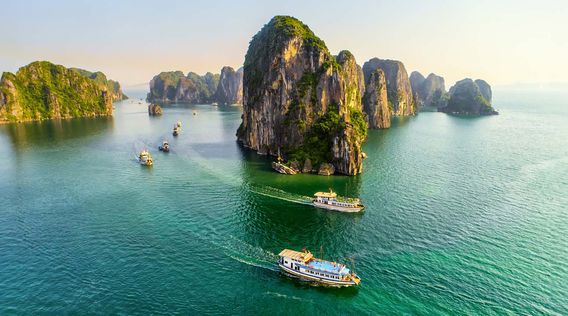
4.6 out of 5 stars

4.8 out of 5 stars

4.3 out of 5 stars

More travel inspiration

Your browser is out of date! It looks like you are using an old version of Internet Explorer. For the best experience on the web, please update your browser.
Update now!
Travelling Alone in Japan
Travelling alone can be both liberating and scary. Travelling to a completely different area of the world, by yourself and with no ideas on costings or safety is a sure fire way to end up in danger or spending a fortune.
Creating a well-thought-out itinerary for when you arrive limits the element of surprise spending. However, doing research on the areas you are visiting before you travel is ideal for a safe trip. Especially if you’re a female travelling alone in Japan.
Safe Solo Travel in Japan
Safety first when travelling solo in Japan is key. Although the country has a relatively low crime rate compared to other areas of the world, it doesn’t mean solo travellers are immune to thieves or other crime.
Walking long dark streets at night is still considered dangerous, unfortunately more for solo female travellers. The gauge is normally, if you wouldn’t do it in your home country, you shouldn’t do this whilst travelling Japan solo. Always be aware of what’s happening around you and trust your instincts, if it feels unsafe then don’t do it.
Luggage and cash are normally all that solo travellers in Japan will have with them. Using a coin locker to keep your luggage safe whilst travelling from one area to another is common in Japan for lots of travellers. With overcrowded trains and public transport, it’s wise to store luggage in-between accommodation changes if you’re returning to the area with your locker.
There are also delivery services for solo travellers in Japan. These services will deliver your luggage to your next location, so you can travel fr eely on public transport without having to return to the same destination, like the coin lockers. This delivery service is known as Takuhaibin and will collect your luggage for a small fee and deliver it to your next location.
Accommodation whilst Solo Travelling in Japan
Solo travellers often book shared accommodation whilst travelling in Japan alone. This means they’re able to meet new people easily. Most solo travellers in hostel type accommodation will be of the same mindset, meeting new people will be part of the charm of Japan. It’s also a cost-effective way to stay in Japan for longer periods of time than booking a solo room in a hotel.
Hostels are usually between 2,000 – 4,500 YEN per night. (£13-£29, $17-$40) Accurate exchange rate as of Dec 2021.
Japanese Phrases for Solo Travellers
Learning some Japanese phrases before you set off on your solo travels is the best way to ensure you can question locals regarding transport or food. It’s also recommended for safety purposes.
Speaking to Japanese locals in English can work, as many of the Japanese population are taught English as a second language. However, be careful to speak clearly and slowly to ensure locals understand when you are using English on your solo travels.
Certain phrases are beneficial to learn in Japanese, especially those surrounding public transport. Words such as ticket, train, bus and taxi are the most common to learn for solo travellers in Japan.
- Bus – バス( Besu)
- Ticket – チケット(Chiketto)
- Train – 列車 (Ressha)
- Help – ヘルプ (Herupu)
- Hello – こんにちは (Kon’nichiwa)
- Goodbye – さようなら(Sayōnara)
Meeting New People Whilst Solo Travelling In Japan
As previously mentioned, booking to stay in a hostel or other shared accommodation is an easy way to make friends whilst travelling in Japan. You may even be lucky enough to meet people who have travelled to Japan before, a seasoned solo traveller is helpful in many ways.
Booking onto local tours or group activities is another way to make friends and meet people in Japan. Local tours regarding history or culture often have English translators, so you can go along to these tours and meet other English-speaking tourists. Hostels or hotels will typically help to book these tours if you haven’t booked online before your trip.
Solo Female Travel In Japan
Solo travel in Japan can be tricky if you’re not careful. However, travelling solo as a woman around Japan entails risks slightly greater than their other male traveller counterparts. Here are some tips to help women solo travellers in Japan feel safe:
- Stay vigilant on public transport
- Don’t travel alone in secluded areas
- Learn phrases in Japanese such as ‘Help’ if you need assistance
- Make sure you never leave drinks with a stranger or unattended
In many countries, drink spiking is a crime that is occurring all too regularly. Even with Japan’s low crime rate, female solo travellers should be vigilant of this. If you are worried someone has spiked your drink, immediately inform the bar staff or workers.
Scams Whilst Solo Travelling
Nightclub scam.
There are certain areas of Japan that are seen as nightclub and nightlife spots for locals and tourists alike. Solo travellers in Japan may visit these areas, such as Kabukicho in Tokyo, as many Western countries have a large nightlife culture. This is usually where nightclub scams take place and can leave you in a very unsafe situation.
Nightclub scams come in the form of street touts. Street touts target solo travellers in Japan with promises of meeting new people and having a great time, drunk solo travellers are a prime target even more so.
The trick of the nightclub scams is to invite you into a club, where you will be showered with drinks and attention from locals and workers. Solo travellers are likely to run up a large bill in these establishments, especially if already intoxicated. The touts then turn nasty and will continue to do so, until the bill is paid.
‘Drop & Swap’ Scam
The drop and swap scam targets solo travellers using public transport such as taxis. This scam involves solo travellers paying for taxi’s with cash, yet receiving change that isn’t correct. Most solo travellers in Japan will know the currency well before setting foot in the country, however, this is where the scam comes into play.
Taxi drivers will drop travellers change, after showing the traveller the correct amount they should receive. The driver will then pick up the change, however the amount is altered with a swift hand movement. The traveller will now receive less change than is entitled too, as it looks similar to the correct amount.
Restaurant Scam
Similar to the nightclub scam, this particular scam involves hospitality and solo travellers, who are easy to target. This is not seen as a scam by others, however it usually only happens to travellers, so it’s something to be on the lookout for.
The first part of this ‘scam’ is that restaurants often add another charge on the bill called ‘table charges’. Most restaurants do this as a way of charging solo travellers for the space in the restaurant in which they are using. As this is not prevalent in most Western countries, travellers in Japan often feel tricked by this tactic.
Whilst dining in a Japanese restaurant , a waiter will typically come to take your order. Whilst diners are waiting for their orders, a small snack is presented to the table. Although travellers never request this extra dish, many of them assume it is free. This is not often the case, and additional charges are added at the end of the meal.
Transport in Japan
Trains in japan.
There are many ways to get around Japan , including trains, buses, subways and taxis. Lots of solo travellers use trains or the subway to get around the country. The Japanese rail system is known for its reliability and has an average of 1-minute delays per year. However, it’s wise to avoid travelling on the trains during rush hour as it can get very busy. Rush hour in Japan is 8am-9am and 5pm-7pm.
If you’re a solo traveller who’s planning on staying in one area for a couple of weeks, getting a Japanese rail pass would be beneficial. The Japanese rail passes offer unlimited rides in the time period of the ticket, costing around 29,650 Yen (£202, $268).
Accurate exchange rate as of Dec 2021.
Buses in Japan
Buses run frequently in Japan and tickets can be purchased at terminals around the city you’re in. Tickets can also be purchased in convenience stores, which solo travellers find easier when booking in advance.
Japanese bus passes are great options for low budget travelling, with overnight buses being available for lots of tourists. Solo travellers in Japan often find bus travel as a good alternative to train travel, as night buses are safe and don’t limit your daytime activity time. A Japanese 3-day bus pass typically costs 10,200 YEN (£67, $88).
Solo travelling in Japan is very popular, and you will not be on your own whilst solo travelling. Make sure you book onto tours, visit museums and eat local cuisine to really feel the culture. Check out our guide on where to go in Japan if you’re planning to visit soon. If you’re wanting to make a more permanent move, why not look at becoming an ALT with Interac.
Top Teach Abroad Providers: Safety
“ Safety is one of the most important factors we ask reviewers to rate; almost every program on Go Overseas (even those that aren’t in the teach abroad category) is rated on safety. In particular, we want to know how teachers felt about the safety of their school and the local community.”
Sign up to get the latest updates from Interac directly to your inbox
Deals of the Week European Long Weekends Up to 50% OFF
Japan Tours for Solo / Single Travelers
Filters applied, 250+ japan tours for singles / solo travelers with 3,651 reviews.
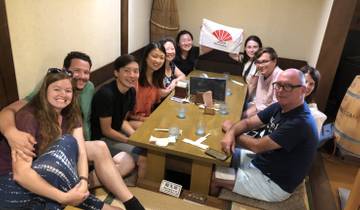
- In-depth Cultural
Stunning Japan with Shirakawa-go (private 3 star hotel rooms)
An enjoyable tour. Mixture of all age groups and a manageable size. Covered the main sightseeing things and encountered many Japanese experiences along the way. My expectations were met.
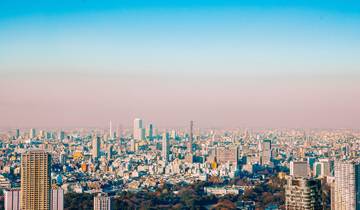
- Food & Culinary
- Christmas & New Year
Japan Real Food Adventure
Amazing tour! Our tour guide was amazing and a phenomenal host for her country.

9D Splendid Japan with Nagoya (private 3 star hotel rooms)
We had a great experience with Stunning Tours Japan - Nice comfortable hotels, good food, everything was organized perfectly, our guide Henry was fantastic! Highly recommended!!!
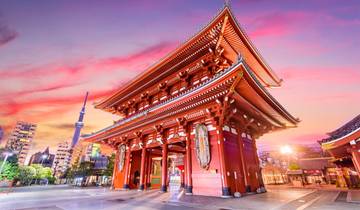
Essential Japan
I was a solo traveller and was exclusively focused on the must-see sights of Southern Japan. Europamundo offered the exact states and locations for me. They also offered the flexibility to join or leave the tour depending on individual travel plans. The tour was operationally excellent. The guide was the best tour guide I have ever had. The hotels were centrally located or had transfer services. Wonderful trip.

Japan Express
It as good having the flexibility to either take Tsunao's suggestions or go your own way. Tokyo, Nikko and Kyoto are all great places to explore and Tsunao's knowledge was invaluable. The venues chosen for group meals were varied and interesting. It was unfortunate that we struck heavy rain in Nikko which meant we were unable to do some of the suggested activities. Highlights there were the Kanmangafuchi Abyss, Ryuzu and Kenyon waterfalls and the Yasukawachu shrines and temple. Kyoto has so many highlights with it's long history especially in the era in which it was Japan's capital. The seasonal highlight was a fireworks display in a town outside the city. My personal favorites were the Fushimi Inari Shrine together with the climb up through the 10000 gates, Nijo Castle and the 2 large temples just north of Kyoto station.
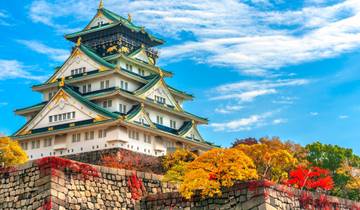
- Train & Rail
Japan Express: Osaka to Tokyo
Excellent tour with G Adventures, and had the best tour guide (Ayako Ueda). I’ve been on several tours in different countries & continents and would say this is the best by far - great itinerary & excellent tour guide!
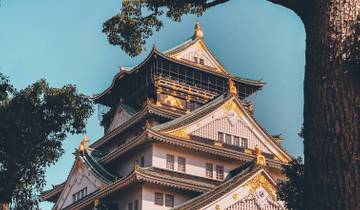
Epic 13-Day Japan Budget Tour: Odyssey Across the Land of the Rising Sun
The guide was very nice, he does walk fast though. There is a LOT of walking. The only shoes you will need are either a good pair of trainers or dare I say I even almost wished I bought my hiking boots a couple of times. I like the fact he acknowledges some people will have different interests for things to do outside of included activities and different food budgets. Price is quite fair for the inclusions although yes you are paying a premium for the group tour, remember that, I found the price fairer than some other international companies I've used in the past who I won't name. You end up doing things you might not have thought of as well Dragon trip attracts a good crowd. There's a good mix of free time and included activities. I recommend you book some optional activities available in Kyoto in particular in advance though. It is in hostels so prepare for that unless you want your own room, which I suggest if possible. There was only one hostel I really was not a fan of at all (Kyoto), the rest of the accommodation was fantastic. The arcade was fun, bike riding was good. I liked the ninja/samurai tour. I think just the itinerary needs to be a bit clearer and giving everyone just an extra $10 on the pasmo card would have made a world of difference or just tell us to buy our own card once in osaka. Also might want to look into: Apparently the jr price has gone up recently and might outweigh booking jr trips separately. Book some extra days maybe in tokyo for yourself at the end if you can otherwise book a flight after 6.30pm on the last day since you may as well use jr to get back to tokyo. I kind of stuffed up my own planning with that one.
- 5% deposit on some dates Some departure dates offer you the chance to book this tour with a lower deposit.

Japan One Life Adventures - 10 Days
There's a lot to do in Japan, and to be able to see so much in such short time was really amazing. Be prepared to walk A LOT. And I do mean A lot. I averaged about 14km a day during this trip. And I would say be prepared to be tired. But it was really worth it. Special mention goes to our tour guide Hayley. She had to take care of a group of 20 people and she did this without any problems. It's true, you sometimes feel like a child on a schooltrip, but you have to be very strict if you are using public transportation in Japan (very crowded). She took good care of us. Hayley would for example send a message in the groupchat prior to the next stop we had to exit of the train. She gave lots of recommendations for how we could spend our free time and she was very friendly and approachable. My highlights were the sushi making class and just strolling around in Kyoto. I can't speak for the Kendo class as I skipped it because the weather in Kyoto was so nice and we wanted to go and explore the area a bit more.

Discover Japan
The tour guide was very friendly. The activities were very age-friendly.

- Coach / Bus
Wonders of Japan End Osaka
We are a family of four from Alaska. We are married with kids age 13 and 15. Ken (he prefers to be called Rei) our tour guide was very knowledgable on the history and culture of Japan. He was entertaining and took special care to guide and talk with our kids and answer their questions. He even gave my son a t-shirt for his birthday, as we celebrated his birthday during the tour. Rei was fluent in both Spanish and English and was very well versed at giving tours in both languages. He was very fair and impartial to both Spanish and English speakers. We had Paulo for one day when Rei was off duty and we highly preferred Rei and were grateful he led most of the tour. Rei will give his opinions about the culture and country when asked which we found very helpful and enlightening, as we wanted to know more than the politically correct or canned tour jargon. We appreciated his candid remarks. We were nervous going into the tour, as we chose it based solely on the on-line reviews and descriptions. We are use to 4-5 star accommodations. I am happy to report that the hotels and food and bus accommodations exceeded our expectations. The only drawback of the tour is that they were not able to accomodate anything outside of the already-planned itinerary. We wanted to extend a night to go to the monastery and that was not possible, as they said it was too close to the end of the trip (6 days before the end). We also booked the hotel fora night before the tour and asked if we could reschedule the shuttle from the airport for earlier. But they said that if we booked our own hotel, even the same one, that the shuttle service was not provided. So while the tour itself was wonderful, changes or add-ons to the itinerary is very limiting. That and our communication with the company before hand was not with one consistent person so we had to ask many people the same questions, as tour receptionists were always different.
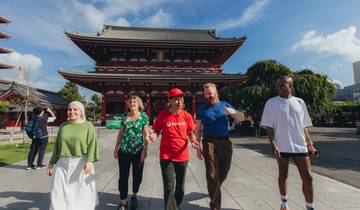
Premium Highlights of Japan

Splendours of Japan (9 Days)
The tour was excellent as was our tour director
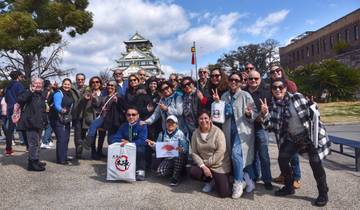
8D Splendid Japan with Nagoya(private 3 star hotel rooms)
Excellent tour! Really had a great time. our guide has been so kind and treated us as her family. She was phenomenal in every way and truly went above and beyond as a guide. She was so knowledgeable, sweet, and accommodating! I felt as if I got the full Japan experience and was tremendously pleased with everything. I recommend Stunning Tours in every way!
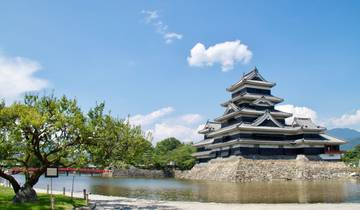
Back Roads of Japan
The booking process was direct and simple. All my queries were responded to promptly and there were no problems with the site or the tour company.
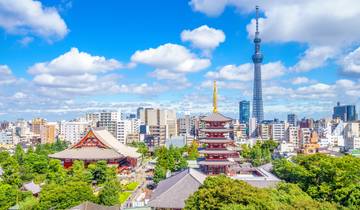
All Inclusive Japan Classics- 9 days
Amazing mix of sights and activities. The tour guide was very accommodating and knowledgeable.
What people love about Japan Solo Tours
It was a very nice trip, with little, insignificant hiccup with accommodation in Osaka, which was resolved quite quickly. Yoyo, our guide, was funny and very patient with all of us. Definitely will recommend the tour to first time visitors to Japan.
June 2023. Take this tour and you won't regret !
Exceeded expectations Highly recommend Inspiring Vacations. Everything was great and our tour guide was excellent. Henry was a good tour guide.
More Tours in Japan for Singles and Solo Travellers
- Southern Japan tours (279)
- Central Japan tours (272)
- Kansai tours (15)
- Northern Japan tours (12)
- Kanto tours (5)
- Honshu tours (270)
- Shikoku tours (8)
- Hokkaido tours (7)
- Mount Fuji tours (11)
- Seniors tours (134)
- Young Adults tours (20)
- Japan Travel Guide | All You Need to Know
- 2 Week (14 Days) Japan Travel Itineraries & Cost 2024/2025
- 1 Week (7 Day) Japan Travel Itineraries 2024/2025
- Best 3 Week (21 Days) Japan Travel Itineraries 2024/2025
- Discover the Best Japan Vacation Packages 2024/2025
- What is the best time to visit Japan in 2024/2025?
- Weather in Japan in 2024/2025
Travel Styles
- Budget (31)
- Luxury (51)
- Singles and Solo (313)
- For Couples (143)
- Young Adults (20)
- Seniors (133)
Nomadic Matt's Travel Site
Travel Better, Cheaper, Longer
The Perfect 7-Day Japan Itinerary for First-Time Visitors

Japan captured my heart from the moment I firs visited. The delicious food, the rich culture, breathtaking landscapes, vibrant history, and the very friendly and polite people – it all blew my mind.
But Japan often feels impenetrable, especially to first-time visitors. While I think Japan deserves a minimum of 10 days, I get that some people might only have a week, so I wanted to write this, my ideal seven-day itinerary for Japan for a first-time visitor.
With only a week, there’s not much you can see unless you really rush it. And I don’t think you should do that.
So this itinerary only focuses on Tokyo and Kyoto (the most popular destinations) as well as some day trips from each. If you wanted to rush things a little, you could add in Osaka (more on that at the end).
(Note: If you purchased a Japan Rail Pass , activate it on arrival. That way, you can take advantage of the free JR trains throughout the city.)
Table of Contents
Japan Itinerary Day 1: Tokyo
Japan itinerary day 2: tokyo, japan itinerary day 3: tokyo, japan itinerary day 4: kyoto, japan itinerary day 5: kyoto, japan itinerary day 6: nara, japan itinerary day 7: tokyo, an alternative itinerary.

Tsukiji and Toyosu Fish Markets Cure your jet lag with some food! In 2018, Tokyo’s main fish market moved to Toyosu. It is now twice the size of Tsukiji (the old one), making it the largest such market in the world. Here you can eat fresh sushi for breakfast, just a few feet from where it was hauled in from the sea, while marveling at the chaotic atmosphere.
You can still head to the old market in Tsukiji to eat, shop, and wander as well. I like it a lot, because there are more food options! Food and drink tours of the Tsukiji Outer Market are available for around 15,000 JPY.
Toyosu Fish Market is open Monday-Saturday 5am-5pm, though most shops don’t open until 7am. Admission is free, but you have to pick up a visitor’s pass when you enter. Tsukiji Fish Market’s hours vary by shop (usually 5am-2pm). Admission is free.
teamLab Planets This digital art installation is a multi-sensory and immersive experience in which you become part of the artwork, walking barefoot through the four exhibition spaces and gardens as you interact with the installations’ elements in unique ways. It’s really fun! TeamLab is generally sells out in advance, so I recommend getting your tickets online ahead of time .
Take a walking tour Walking tours are a great way to get the lay of the land while connecting with a local guide. I always go on one or two when I arrive somewhere. Tokyo Localized offers many free tours, including a classic overview and ones of both the famed Harajuku and Shinjuku neighborhoods. Its Imperial Palace tour would be the most convenient one after teamLab.
The Imperial Palace Formerly Edo Castle, the Imperial Palace was built in the 15th century, and some of the walls and moats from that time are still in use to this day. When the emperor moved from Kyoto to Tokyo in 1869, he took Edo for his new palace and renamed it. While you can’t go inside, it is surrounded by beautiful grounds, a moat, and a park worth wandering through. You can also see the changing-of-the-guard ceremony (though it’s relatively low-key and unassuming). Admission to the grounds is free.
Shinjuku Gyoen National Garden This park is over 144 acres and home to some 20,000 trees. Most of the original park was destroyed in World War II but was rebuilt and reopened in 1949. During spring, it is one of the best places to see cherry blossoms. My favorite area is the landscape garden, which has several ponds with bridges and islands. It’s a peaceful oasis away from the urban hustle and bustle.
Depending on how you feel relative to your jetlag, you could fit a few more activities before you end your day. Check out this post for suggestions .

- Senso-ji – This is Tokyo’s most popular and famous temple. Beautifully painted, it sits in a scenic spot near a pagoda and the lovely Kaminari Gate. There’s a huge statue of Kannon, the goddess of mercy, inside the main hall. It’s very busy during the day, so maybe check out the grounds in the evening.
- Asakusa Shrine – This nearby Shinto shrine is much more peaceful, with fewer visitors, but with people praying, meditating, or performing traditional rituals. It was built during the Edo period (1603–1868) and survived the air raids of World War II.
Afterward, head to Ueno Park . Spanning over 133 acres, Ueno Park was established in 1873 on land formerly owned by a 17th-century Buddhist temple. It gets super busy in cherry blossom season, as there are over a thousand trees here. Throughout, you’ll find various stalls and vendors selling snacks, drinks, and souvenirs. On weekends, there are usually cultural events or festivals showcasing traditional arts, music, and dance. Four of Tokyo’s main museums are here:
- Tokyo National Museum – Established in 1872 on the north end, this massive building is the oldest and largest art museum in Japan. It houses one of the world’s largest collections of art and artifacts from Asia, particularly Japan.
- Tokyo Metropolitan Art Museum – This museum showcases rotating exhibitions of contemporary and traditional Japanese art.
- National Museum of Nature and Science – This museum features a wide range of permanent and temporary exhibitions covering natural science and history.
- Tosho-gu Shrine – This beautiful 17th-century Shinto shrine has carved gold doors and other ornate carvings. It’s worth seeing up close!
Afterward, walk down to Akihabara to explore the video game parlors, arcades, and anime shops. This very buzzy area is ground zero for all things electronic, and it’s fun to play many of the games. This is where you’ll find the famous maid cafés, where servers dress up as maids and serve you food and drinks. These range from big touristy ones to holes-in-the-wall (the girls on the street are promoting the latter, which are a lot more culturally fun). They aren’t cheap, though, as you have to buy drink packages and pay a fee, but they’re kitschy and fun.
In the evening, visit Shinjuku and then drink in Golden Gai . In Shinjuku, you’ll find a plethora of cool bars, bright lights, and tiny hole-in-the-wall eateries. Be sure to wander down Memory Lane (aka Piss Alley) for tiny izakaya joints and bars. Afterward, head over to Golden Gai, a warren of narrow alleyways with a bit of a red-light-district feel, flanked by diminutive backstreet bars. It’s quite touristy but also a lot of fun. I’ve had some wild nights here!
With Arigato Tours , you’ll learn about the neighborhood while stopping to sample Japanese classics like sushi, yakitori, and ramen. The 23,900 JPY cost includes a drink and dishes at four stops.

Kamakura Here you can see a 13-meter (43-foot) bronze statue of Buddha that was built in 1252. It was initially constructed within Kotoku-in Temple, but that has since been washed away by several storms, so it now sits in the open air. Admission to enter the temple grounds is 300 JPY, while it’s 20 JPY to go inside the statue. The journey there — around an hour — is free with a Japan Rail Pass .
Tokyo Disneyland I’m a sucker for Disney. You’ll find many of the same classic rides from Disney World here, like Splash Mountain, Big Thunder Mountain, The Haunted Mansion, and everyone’s favorite teacup ride, The Mad Tea Party. But there are several unique attractions as well, like Pooh’s Hunny Hunt and Journey to the Center of the Earth.
Ticket prices vary depending on the day and time, but full-day admission begins at 7,900 JPY for adults and 4,400-6,200 JPY for children. It’s best to book in advance .
Mount Fuji Mount Fuji is located an hour outside of Tokyo. An active stratovolcano (which last erupted in 1708) and covered in snow for almost half of the year, it stands an impressive 3,776 meters (12,389 feet) and provides one of the most iconic views in the country. One of the Three Holy Mountains of Japan, Mount Fuji is both a Special Place of Scenic Beauty and a UNESCO Cultural Site. In the summer, the mountain is open to hikers, who take 5-12 hours to reach the summit (traditionally, they depart at night to arrive at the top for the sunrise).
If you don’t want to hike, you can simply visit on a day trip. There are buses that can take you partway up, where you’ll be offered sweeping vistas of the surrounding area. Guided day tours from the city cost around 12,000 JPY.

Wander the Bamboo Forest For a relaxing break, head to Arashiyama and let the dense and towering stands of bamboo envelop you. Located near the famous Tenryu-ji temple, it’s one of the most beautiful places in the entire country. It’s not that big, but there are some hidden areas to explore. Just make sure to arrive early if you want to enjoy it without the crowds (it fills up fast after sunrise).
While there, I would also recommend visiting the Okochi Sanso Garden, which (along with the home) belonged to the famous Japanese actor Denjir? ?k?chi (1898–1962). It’s not free (it’s 1,000 JPY), but it’s really nice and has some wonderful views.
Visit the Golden Pavilion Originally built in the late 14th century as a retirement villa for the shogun (military governor), this iconic structure was later converted into a Zen Buddhist temple. The present-day edifice dates only to the 1950s, however, when a monk attempting to kill himself burned the historic original to the ground. The rebuilt temple is covered in brilliant gold leaf, symbolizing purity and enlightenment. Each of the three stories exhibits a different architectural style. Completing the scene are the serene reflecting pool and traditional Japanese gardens that contain lush foliage, manicured trees, and scenic walking paths.
1 Kinkakuji-cho, Kita-ku, Kyoto-shi, Kyoto, +81 075-461-0013, shokoku-ji.jp. Open daily 9am-5pm. Admission is 500 JPY.
Admire Ryoan-ji Temple This is my favorite temple in Kyoto. Originally established in 1450 as a residence for a high-ranking samurai, it was soon converted into a Zen temple and is now a UNESCO World Heritage Site, with a mausoleum that houses the remains of seven emperors. Its traditional rock and sand garden is considered one of the best in the country. There’s also a teahouse where you can experience the traditional Japanese tea ceremony ( chanoyu ) as you overlook the Kyoyochi reflecting pool.
There are other temples in the area to check out as well:
- Daitoku-ji Temple – This massive complex dating back to 1315 covers almost 60 acres. It contains several dozen temples and is a good place to see a variety of Zen gardens and architectural styles. It’s also deeply linked to the Japanese tea ceremony, as several of the country’s most noteworthy masters studied here.
- Toji Temple – This is home to Japan’s tallest pagoda (five stories high). Founded in 796, just after Kyoto became the capital, it was one of only three Buddhist temples allowed in the city.
Go on a sake brewery tour Kyoto has a sake (rice wine) brewing tradition going back 400 years and is known for some of the best in the world, due to using the area’s pure natural spring water in the brewing process. Arigato Tours offers an excellent three-hour tour of Fushimi (the brewing district) for 23,320 JPY, including stops at several breweries, a guided tour of the Gekkeikan Okura Sake Museum, and tastings.

See the Fushimi Inari Shrine This mountainside Shinto shrine, dating back to 711, is dedicated to Inari, the god of rice and prosperity. It’s known for its thousands of vibrant orange torii gates that form a network of trails leading up Mount Inari. You can hike the trails on your own while enjoying panoramic views of Kyoto below or join a guided hiking tour , on which you’ll get off the paved paths and into hidden bamboo groves. Get here as early as possible to avoid the crowds.
68 Fukakusa Yabunouchicho, +81756417331, inari.jp. Open 24/7. Admission is free.
Walk around Higashiyama Spend an afternoon walking along the narrow streets of one of the oldest and best preserved districts on your own or on a walking tour . The traditional machiya buildings (traditional wooden townhouses) are filled with small shops selling local specialties and handicrafts, as well as restaurants and teahouses. It’s a popular area in which to participate in a tea ceremony . Another nice place to stroll in this neighborhood is the Philosopher’s Path, which follows a cherry-tree-lined canal that’s beautiful and meditative even when the blossoms aren’t in season.
Visit Kiyomizu-dera One of a number of UNESCO sites in ancient Kyoto, Kiyomizu-dera (meaning “pure water temple”) is located in the foothills of Mount Otowa in the eastern part of the city. It’s one of the most famous temples in all of Japan. It was established in 778, but most of the existing buildings date to the 17th century. There’s not a single nail used in the construction, which becomes all the more impressive once you see how large the temple is, which is best known for its wooden terrace that juts out over the hillside. The temple’s name comes from the nearby waterfall whose waters (from which you can still drink today) are said to have wish-granting and healing powers.
1 Chome-294 Kiyomizu, +81 75-551-1234, kiyomizudera.or.jp. Open daily 6am-6pm. Admission is 400 JPY.
Explore Shorin-ji Temple This small temple dates back to the 16th century. What makes it worth visiting is its meditation classes. You’ll get to tour the temple and then be instructed in zazen , the Japanese style of meditation. It’s a very unique experience and something that I think will add a lot of depth and nuance to your visit (especially if you’ve seen a lot of temples). Just make sure to dress comfortably.
15 Chome-795 Honmachi, +81 75-561-4311, shourin-ji.org. Open daily 10am-4pm. Admission is 800 JPY.
Wander the Nishiki Market Nishiki Ichiba is now one of the biggest indoor markets in town. Known as “Kyoto’s Kitchen” and spanning over five blocks, it is full of vendors selling traditional dishes from the region, classic Kyoto souvenirs, and really just about anything else. There are over a hundred stalls here, many of which have been in the same family for generations. Opening hours depend on the shop but are typically from 9am to 6pm.
To dive deeper into Japanese food culture, you can take a food tour of the market . It’s the best way to learn about all the food you’ll see, as well as the market’s history.
Explore Gion Gion, the historic geisha district, is renowned as being one of the most iconic and atmospheric areas of town. It’s known for its traditional wooden machiya houses, narrow alleyways, cobblestone streets, and preservation of geisha (known locally as geiko) culture. Lining the main street are ochayas (teahouses where geishas entertain), small shops, and many restaurants, ranging from upscale kaiseki restaurants serving traditional Kyoto cuisine to casual eateries.
To really learn more about this amazing party of town and its past, take a walking tour of Gion . You’ll learn a ton and get a lot of context. They cost around 1,800 JPY.
At night, go to the Pontocho Row , a narrow street lined with restaurants, hole-in-the-wall bars, and jazz clubs. It’s one of the more lively areas in Kyoto.

Nara was the capital of Japan in the eighth century, so there are lots of buildings and temples here that are upwards of a thousand years old (which is rare in Japan, due to the prevalence of fires and earthquakes, as well as World War II). Some things to do:
- Frolic with deer – The real draw in Nara are the deer. Since the 17th century, those in and around the city have been considered sacred. You can buy crackers to feed them or just watch them stroll around carefree.
- See the Buddha – Don’t miss a visit to Todai-ji, the world’s largest wooden building, home to a 16-meter (52-foot) Buddha statue. It was built in 738 and is now a UNESCO World Heritage Site.
- Take a walking tour – This guided half-day walking tour for 11,500 JPY includes all of Nara’s highlights as well as a traditional lunch.

Ryogoku Kokugikan, Japan’s most famous sumo wrestling arena, hosts tournaments three times each year, in January, May, and September. Tickets sell out quickly, so book online in advance. Prices vary but start around 3,200 JPY for arena seats. You can book a ticket online here (you’ll be accompanied by a guide too, so you can learn more about the tradition as it unfolds before your eyes).
To learn more about the sport in in the off-season, book a tour of a sumo stable .

So, if you want to add another city to this itinerary you can follow this breakdown:
- Days 1 & 2: Tokyo
- Days 3 & 4: Kyoto
- Day 5: Nara
- Days 6 & 7: Osaka
Tokyo, Kyoto, and Nara are all covered above. As for Osaka, some of my favorite things to see and do:
Take a food tour Known as “the Kitchen of Japan,” Osaka boasts a diverse culinary scene. Mouthwatering sushi and sashimi, Kobe beef and Japanese BBQ, and flavorful ramen can all be found here in abundance. Plus, there are local specialties like okonomiyaki (a savory pancake with egg and vegetables) and kushikatsu (kebab skewers). You can take a food tour for around 13,000 JPY, a ramen and gyoza cooking class for 9,500 JPY, or just wander and eat.
Osaka Castle One of the most famous landmarks in the country, the castle was originally built in the late 16th century by Toyotomi Hideyoshi and played a pivotal role in the unification of Japan during the Sengoku period (1467-1615). Over the centuries, it has been destroyed and rebuilt multiple times due to wars, fires, and natural disasters. The current version dates to 1931. The castle is situated amid sprawling grounds and surrounded by a moat. It’s also home to a small but insightful museum and an observation deck that offers some picturesque urban views.
Dotonbori This is arguably Osaka’s most iconic district, known for its vibrant nightlife (bars, clubs, theaters, and music venues), colorful signage, and delicious food. It’s best seen at night due to the plethora of huge neon lights and signs lining both the canal and streets, which have become symbols of Osaka’s nightlife. A guided walking tour that includes Dotonbori as well adjacent neighborhoods is 6,500 JPY.
Shitennoji Temple This temple is one of the oldest Buddhist temples in Japan, founded in 593. The architecture is a blend of traditional Japanese and East Asian styles, featuring impressive pagodas, gates, and shrines set amid serene gardens. Stroll through the tranquil grounds, admire the beautiful architecture, and learn about the temple’s historical and cultural significance at the museum. The temple is 300 JPY to enter, the garden is 300 JPY, and the museum is 500 JPY.
Japan is one of my favorite countries. While it’s relatively small, it offers an amazing array of things to see and do (as well as some of the best food in the world). With seven days, you can easily see a good number of the main highlights and get a taste for the incredible history and culture. It will be a busy week, but this itinerary ensures you’ll still have some time to slow down, relax, and take in the local pace of life.
Just make sure you get a Japan Rail Pass before you go. While it’s not as cheap as it used to be, it will likely save you time and money!
Book Your Trip to Japan: Logistical Tips and Tricks
Book Your Flight Find a cheap flight by using Skyscanner . They are my two favorite search engines, because they search websites and airlines around the globe, so you always know no stone is being left unturned!
Book Your Accommodation You can book your hostel with Hostelworld as they have the most comprehensive inventory so they are best for booking a hostel. If you want to stay in a hotel or guesthouse in Japan, use Booking.com as it consistently returns the cheapest rates for guesthouses and hotels.
Don’t Forget Travel Insurance Travel insurance will protect you against illness, injury, theft, and cancelations. It’s comprehensive protection in case anything goes wrong. I never go on a trip without it, as I’ve had to use it many times in the past. My favorite companies that offer the best service and value are:
- Safety Wing (best for everyone)
- Insure My Trip (for those over 70)
- Medjet (for additional evacuation coverage)
Looking for the Best Companies to Save Money With? Check out my resource page for the best companies to use when you travel! I list all the ones I use to save money when I travel — and I think they will help you too!
Be sure to check out the Japan Rail Pass if you’ll be traveling around the country. It comes in 7-, 14-, and 21-day passes and can save you a ton of money!
Looking for More Travel Tips for Japan? Check out my in-depth Japan travel guide for more ways to save money, information on costs, tips on what to see and do, suggested itineraries and reading and packing lists, and much, much more!
Got a comment on this article? Join the conversation on Facebook , Instagram , or Twitter and share your thoughts!
Disclosure: Please note that some of the links above may be affiliate links, and at no additional cost to you, I earn a commission if you make a purchase. I recommend only products and companies I use and the income goes to keeping the site community supported and ad free.
Related Posts

Get my best stuff sent straight to you!
Pin it on pinterest.
- Today's news
- Reviews and deals
- Climate change
- 2024 election
- Fall allergies
- Health news
- Mental health
- Sexual health
- Family health
- So mini ways
- Unapologetically
- Buying guides
Entertainment
- How to Watch
- My watchlist
- Stock market
- Biden economy
- Personal finance
- Stocks: most active
- Stocks: gainers
- Stocks: losers
- Trending tickers
- World indices
- US Treasury bonds
- Top mutual funds
- Highest open interest
- Highest implied volatility
- Currency converter
- Basic materials
- Communication services
- Consumer cyclical
- Consumer defensive
- Financial services
- Industrials
- Real estate
- Mutual funds
- Credit cards
- Credit card rates
- Balance transfer credit cards
- Business credit cards
- Cash back credit cards
- Rewards credit cards
- Travel credit cards
- Checking accounts
- Online checking accounts
- High-yield savings accounts
- Money market accounts
- Personal loans
- Student loans
- Car insurance
- Home buying
- Options pit
- Investment ideas
- Research reports
- Fantasy football
- Pro Pick 'Em
- College Pick 'Em
- Fantasy baseball
- Fantasy hockey
- Fantasy basketball
- Download the app
- Daily fantasy
- Scores and schedules
- GameChannel
- World Baseball Classic
- Premier League
- CONCACAF League
- Champions League
- Motorsports
- Horse racing
- Newsletters
New on Yahoo

- CA Privacy Notice
The 10 best countries for solo travel – and top tips for travelling alone
While travelling with friends, family or a partner can be a great way to spend quality time with loved ones, embracing alone time can open the door to a wealth of new cultures and experiences .
Solo holidays can range from short-haul city breaks to bucket-list backpacking adventures and active excursions closer to home.
But where to start? Holidays for a party of one are more popular than ever in 2024, though inconsistent pricing and solo supplements can be discouraging for those new to lone adventuring.
And, while solo travellers may end up paying more for holidays thanks to single occupancy rates, the freedom of choice without the burden of compromise is thrown in for free.
From dining with the locals in Vietnam to guided tours of the Golden Circle in Iceland , there are myriad destinations well-suited to travellers looking to go it alone.
Here are some top countries for solo travel, plus tips to plan and execute a successful trip of self-discovery.
Read more on solo travel :
The solo holiday destinations in the UK for a singles getaway
The best US cities for solo female travellers you might not have considered
Why Greek island-hopping is a gentle way to ease back into adventures
Best for: Singles city breaks
What better way to kick start a solo adventure than with a long weekend in a city that embraces the essence of hygge (a feeling of comfort and contentment)? Alfresco summers meet cosy winters in Denmark and, while Scandinavian prices can be eye-wateringly expensive, it’s not impossible to pull off a city break on a budget.
Eastern capital Copenhagen is consistent in its happy atmosphere, low crime rate and world-renowned cuisine. From budget hot dog stands laden with pickled condiments to the tasting menu at three Michelin-starred restaurant Geranium, gourmet food joints pepper the candle-lit streets. Experience “faellesspisning” or communal eating – affordable bites in the charming company of strangers – if you’re a solo traveller looking to socialise.
Make your money go even further by joining in with laid-back Scandi culture and renting a bike, staying in buzzing hostels such as the central Danhostel and purchasing a Copenhagen Card to get money off attractions, including a boat tour of the city’s canals.
Free activities such as walking along waterfront neighbourhood Nyhavn and catching a summer sunset from the opera house are also facilitated by an efficient ‘S-tog’ train network and buses.
And there’s more to Denmark than its effortlessly stylish capital. Visit Odense for a Hans Christian Anderson literary experience fans of The Little Mermaid will love, and take in the multitude of architecture in the old Viking fishing village-turned-second city, Aarhus, for an insight into to Danish history.
Best for: Solo island hopping
Thailand is a welcoming haven for single party animals or beach bums travelling the well-trodden backpacking trail through southeast Asia .
A solo slice of Thai comes with an affordable price tag once you’re there. Trains, buses, long-tail boats and tuk-tuks transport travellers to the street food of lively night markets and cooking schools well versed in pad Thai and gaeng daeng for just a few pounds, while there are plentiful cheap and cheerful hostels to stay in, helping solo travellers meet new people and save in accommodation costs.
Culture-stacked cities like Bangkok meet jungle-clad interiors in a fusion of thrilling nightlife, rejuvenating yoga ashrams and authentic Buddhist temples.
Island hopping across isolated archipelagos is also often a staple of a tourist’s Thailand itinerary. With 1,430 islands to choose from, including Phuket and the Phi Phi on the emerald waters of the Andaman Sea, try Koh Samui for safe, sociable hostels including The Rock Samui and catch the ferry to Koh Phangan to experience festival-style nights at a bucket-list full moon party.
Best for: Personal safety
Find peace of mind travelling alone in clean, safe cities as you experience first-hand the Japanese culture of kindness and respect. Crime and harassment are rare and the efficient train network even features women-only carriages .
Master of hi-tech and hub of creative fashion, Tokyo is the ideal place to start your first solo trip to Japan, but its glitzy tapestry of skyscrapers and all-night karaoke isn’t the only bit you should experience.
Venture to Kyoto via the revolutionary bullet trains to regroup in the ethereal landscapes surrounding Mount Fuji. In spring, the city is awash with pink as the cherry blossoms bloom and rural temple tours tempt visitors into serene Japanese gardens to experience customary tea ceremonies. Ski slopes in Hokkaidō are also great for snowsports enthuiasts.
While not the cheapest destination for holidaymakers on this list, travellers can save on expenses by picking up food from Japan’s extensive variety of vending machines, 100-yen stores and Japanese Rail passes . Capsule hotels like the Nine Hours chain and traditional ryokan rooms with hot springs offer classic Japanese zen in rural areas and the city at affordable prices.
What's more, eating alone is celebrated as the norm at casual restaurants familiar with seating tables for one, while language difficulties are usually met with polite patience.
Best for: Short-haul travel
Swerve language barriers and long stints in the air with a holiday to visit our Irish neighbours. The Emerald Isle has forged a reputation as a home from home for British travellers, whether they get there by hopping on a ferry or a flight.
Crumbling castles, rambling countryside and live music await; from Dublin to Cork and Limerick, cosmopolitan cities sit side by side with verdant landscapes blessed with an abundance of walking and cycling routes that are fun to explore as a lone ranger.
Dublin houses more cultural wonders than the famous Guinness Storehouse – nurse a proper pint in traditional old-stone Dublin pub away from tourist favourite, Temple Bar, and discover why the Irish capital is the Unesco city of literature.
Eslewhere, solo day trips can include the beauty of the Cliffs of Moher and the busy shops of Graton Street. The best way to get around is by car, and hiring your own is advisable for road trips to more remote areas such as Galway and the Aran Islands.
Best for: Social travellers
A favourite with backpackers, Vietnam’s well-established tourist route takes the hassle out of planning for solo travellers eager to buddy up along the way.
Hue’s imperial citadel, capital Hanoi’s French colonial villas, wartime relics including the Cu Chi tunnels, blissful beaches on Phu Quoc Island and rainbow lanterns at Hoi An’s monthly full moon festival all make Vietnam a compelling destination.
Solo tourists can hop on the back of a motorbike with a local for a tour of the chaotic Ho Chi Minh City , or cruise to the limestone islands of Unesco-listed Ha Long Bay on targeted excursions for like-minded travellers.
In this wallet-friendly southeast Asian country, easy-to-navigate transport networks, overnight buses that take you down the otherworldly coast, and a sociable, hostel-heavy accommodation scene with bargain price tags add up to a destination that’s ideal for lone travellers keen to make friends.
Best for: Self-discovery
Canada , famed for its friendly people with a knack for warm hospitality, is the ideal place for a lone globetrotter to switch off and get back to nature.
Th world's second biggest country balances cosmopolitan cities with unspoilt, remote wilderness. You’ll be greeted with trendy bars in Toronto and the urban oasis of Stanley Park in waterfront Vancouver , while road trips across the North American giant take you through expansive landscapes, mountain peaks and dazzlingly blue lakes.
A treasure trove of outdoorsy activities can be enjoyed year-round, from skiing and snowboarding in Whistler to kayaking, ice hockey and hiking amid the enchanting glacial lakes and grizzly bears of Banff National Park and the vast Rocky Mountains.
Best for: Off-grid adventures
Iceland is guaranteed to squash any feelings of boredom with its extensive menu of outdoor activities, from snowmobiling to horse riding and hikes in the rugged volcanic landscape.
Aptly nicknamed the “Land of Ice and Fire”, Iceland is a playground for nature enthusiasts to go off-grid solo. Black sand beaches, waterfalls, sapphire glaciers and the geysers of the Golden Circle ring road are all natural thrills in this largely safe and friendly country.
Think whale watching during the midnight sun, hunting the colourful waltz of the Northern Lights and the famous milky waters of the Blue Lagoon spa on a solo city break to the capital, Reykjavik .
Best for: Female solo travellers
In the heart of Europe, Slovenia’s small size and charming spirit make it a hit with female solo travellers.
A fairly priced public transport network facilitates travel between cities and English is widely spoken, enabling easier exploration of Slovenia’s beautiful scenery.
Leafy Ljubljana , the capital, is a tangle of terracotta riverside cafes, markets and family-owned restaurants offering sheep cheeses, struklji rolls and orange wines.
But Slovenia’s crowning jewel is its famous lakes fringed with traditional, pretty villages. Lake Bled, for example, is home to medieval castles, wild swimming opportunities and traditional plenta boat rides.
New Zealand
Best for: hiking holidays.
There’s nowhere like New Zealand for a hiking holiday off the beaten path, and it’s ideal for solo adrenaline seekers, thanks to its peaceful and safe reputation.
The English-speaking Pacific paradise offers working holiday opportunities for those looking to secure a travel visa, plus bucket-list activities such as helicopter rides, whale watching and bungee jumping fill a prolonged stopover.
From the home of hobbits in Rotorua to cruising to the waterfalls of Milford Sounds by boat and exploring the Maori culture of vibrant Christchurch, New Zealand is well worth the ultra-long journey.
In between days spent amid its film-worthy natural landscapes, head to Auckland to climb Mount Eden and the Sky Tower for panoramic city views, or visit the fine wine regions of Waiheke Island, known for their Sauvignon Blancs.
Best for: Culture and cuisine
An unspoiled country closed to tourists until 1974, Bhutan is a surprisingly popular destination for a solo holiday.
With a confection of cultural wonders in lush green valleys, fortresses and traditional villages, the Himalayan country appeals to single travellers lusting to step back in time.
Find Bhutanese-style red-roofed houses in the quiet capital of Thimphu, yak herding in Laya and the cliff-hugging Tiger’s Nest Monastery at home in harmonious Paro – not forgetting delicious momo dumplings.
The landlocked nation is ideal for trekking after the 403km long Trans Bhutan Trail reopened in 2022; the mountain kingdom can be explored on private tours with a local guide.
Bhutan’s Buddhist culture has a focus on sustainability that permeates all levels of life, particularly in strict tourism regulations. Factor the country’s steep tourism tax , designed to deter budget travellers and preserve Bhutan’s heritage, into your trip costs –now $800 (£627) for a traveller staying eight days.
Top 10 tips for solo travellers
Do your research: take your time to plan ahead before leaving for a solo trip
Be safety conscious: don’t share your specific location online while you’re still there, be aware of your surroundings and stay connected with people at home about your travel plans
Be flexible: spontaneous plans are sometimes the best kind and things going “wrong” often lead to the most memorable experiences
Try something new: whether local cuisines or a new activity, push yourself out of your comfort zone to get the most out of travelling solo
Stay in a hostel: this can be the best way to meet new and likeminded people for social butterflies
Learn to love your own company: there’s a freedom to alone time
Practice local phrases: a “please” and “thank you” in the local language go a long way
Utilise public transport: don’t blow your budget on Ubers and taxis if you don’t have to
Bring back-up: printed documents, portable chargers, emergency cash and travel insurance are solo travel essentials
Don’t overpack: don’t fall at the first hurdle by bringing your entire wardrobe
Read more of our best Copenhagen hotel reviews
Recommended Stories
Chase sapphire preferred review: a standout travel card with impressive perks.
The Sapphire Preferred's benefits make it easy for many cardholders to offset the cost of the affordable annual fee.
Ford Mustang Experience Center will soon be Pony Car HQ for owners
Ford's Mustang Experience Center will soon welcomes all Mustang owners, while the Mustang GT3's Champion Spirit Livery honors past Mustang racers.
Twitch streamer Kai Cenat says he's a victim of revenge porn. How technology makes the practice easier than ever — and harder to prosecute.
During a livestream this week, 22-year-old Kai Cenat claimed a woman he met in 2023 leaked naked photos and videos taken without his consent to extort money from him.
Olivia Munn is going through medically induced menopause after breast cancer treatment. Here's what that means.
Medication to keep the actress's cancer from recurring has put her temporarily in menopause.
Bill Belichick joining 'The Pat McAfee Show' as 2024 NFL Draft analyst
Bill Belichick won't be alone on draft night.
Ramp raises another $150 million co-led by Khosla and Founders Fund at a $7.65B valuation
Spend management startup Ramp has raised another $150 million at a post-money valuation of $7.65 billion, the company confirmed to TechCrunch today. New investor Khosla Ventures and existing backer Founders Fund co-led the raise, which also included participation from new backers Sequoia Capital, Greylock and 8VC. Other existing investors Thrive Capital, General Catalyst, Sands Capital, D1 Capital, Lux Capital, Iconiq Capital, Definition Capital, Contrary Capital also put money into the latest round.
The best wrist braces for carpal tunnel of 2024, according to hand specialist and health experts
Say goodbye to carpal tunnel flare-ups with these expert and tester-approved carpal tunnel braces
Save your floors! These genius 'As Seen On TV' furniture leg protectors are down to about $1 a pop
‘No more polishing my hardwood floors,' said one of nearly 17,000 five-star fans.
'Feminine and beautiful': This No. 1 bestselling sundress has dropped to $34 — that's nearly 45% off
The forgiving wrap style makes it a winner for 7,000 five-star reviewers: 'Light and flirty, but also very flattering and conservative.'
Bethenny Frankel says this $13 Neutrogena drugstore buy is her 'favorite foundation, period'
Why spend a ton of money on designer makeup when this affordable formula works just as well?
Champions League: Real Madrid dashes Man City's double treble dreams in shootout; Bayern Munich tops Arsenal
The Champions League semifinals are set.
This $15 Bluetooth transmitter almost makes my husband's '99 Toyota Camry feel like it's from the 21st century
It streams music, takes calls and more — and it's become a road trip must-have.
Bank of America CEO: The Federal Reserve is winning the war on inflation
Bank of America CEO Brian Moynihan weighs in on the fight against inflation and another solid quarter of consumer spending.
Mastering finance essentials with Mercury's VP of finance, Dan Kang, at TechCrunch Early Stage
TechCrunch Early Stage is gearing up for another insightful event on April 25, and one roundtable session promises to be particularly illuminating for early-stage founders. Titled "Finance Fundamentals Before Your First Finance Hire: A Founder’s Guide to Navigating Early Financial Decisions," this roundtable will offer invaluable insights into navigating the financial complexities that often accompany the early stages of startup ventures. With years of experience in building and scaling fintech companies, Kang brings a wealth of knowledge to the table.
Tech earnings season is coming, and AI is top of mind
Big Tech earnings are coming up, and Wall Street wants to know how companies are making money on their massive AI investments.
Senate dismisses articles of impeachment against Homeland Security Secretary Mayorkas: What happened
The U.S. Senate quickly ended the impeachment trial brought by House Republicans against the country’s top border official.
Amazon says a whopping 140 third-party stores in four countries use its Just Walk Out tech
Amazon published a blog post on Wednesday providing an update about its Just Walk Out technology, which it reportedly pulled from its Fresh grocery stores earlier this month. While extolling Just Walk Out’s virtues as a sales pitch to potential retail partners, the article lists a startlingly minuscule number of businesses using the tech.
Toyota Prius recalled for rear doors that could pop open
Toyota recalls 2023 and 2024 Prius models for rear doors that could open unexpectedly. It covers more than 200,000 cars worldwide.
X’s AI bot is so dumb it can’t tell the difference between a bad game and vandalism
After misinterpreting user posts about Klay Thompson's poor shooting during an NBA game, X's AI bot Grok created a fictitious story on the social media platform's trending section.
AirChat, the buzzy new social app, could be great -- or, it could succumb to the same fate as Clubhouse
The app is like a combination of Twitter and Clubhouse. Built by AngelList founder Naval Ravikant and former Tinder exec Brian Norgard, Airchat takes a refreshingly intimate approach to social media. There are people I’ve known online for years, and only after following each other on AirChat did I realize I’d never heard their actual voices.
- Japan Tourism
- Japan Hotels
- Japan Bed and Breakfast
- Japan Vacation Rentals
- Flights to Japan
- Japan Restaurants
- Things to Do in Japan
- Japan Travel Forum
- Japan Photos
- All Japan Hotels
- Japan Hotel Deals
- Last Minute Hotels in Japan
- Things to Do
- Restaurants
- Vacation Rentals
- Travel Stories
- Rental Cars
- Add a Place
- Travel Forum
- Travelers' Choice
- Help Center
Better exchange rate but higher prices while there? - Japan Forum
- Asia
- Japan
Better exchange rate but higher prices while there?
- United States Forums
- Europe Forums
- Canada Forums
- Asia Forums
- Central America Forums
- Africa Forums
- Caribbean Forums
- Mexico Forums
- South Pacific Forums
- South America Forums
- Middle East Forums
- Honeymoons and Romance
- Business Travel
- Train Travel
- Traveling With Disabilities
- Tripadvisor Support
- Solo Travel
- Bargain Travel
- Timeshares / Vacation Rentals
- Asia forums
- Japan forum

13 replies to this topic

Some nonresident posters know what's going on in Japan very well on this forum. Actually, many experts are nonresidents.
You are right. As a visitor I’m finding things inexpensive. Hotels for me are extremely reasonable but I booked them months in advance to secure a good rate.
So yes prices are higher sccording to an actual local
I expect when I finish travelling this spring season to find my home grocery bill to have increased substantially, especially for items imported from the USA (not so much for countries like Australia),
But, for visitors that do not see the local inflation and restaurant prices increasing 10%, they can still look very cheap.
Just as an edit, the JPY/USD rate at the beginning of 2022 was 110 and it's now 154. The 10% inflation is a fraction of the improved spending power for the US$. Aus and NZ the movements are about the same.
- Where to on Bullet train? 7:35 pm
- How long does Japan Tourist eVisa take to process? 7:23 pm
- Team Labs Borderless Online Ticket Purchase Issue 7:19 pm
- Better exchange rate but higher prices while there? 6:55 pm
- Hotel in Tokyo 6:22 pm
- Nankai Namba Station to Namba Oriental Hotel 6:19 pm
- First time itinerary opinion needed 5:06 pm
- Beppu a trip report 5:03 pm
- Mount Fuji Visibility & Hitachi Park Live Cameras 3:36 pm
- Arrive early evening, day after golden Week. 3:16 pm
- Osaka in May, What is spring like then? 2:40 pm
- Transportation Options from Haneda Airport to Hyatt Yokohama 2:27 pm
- Question about night time illuminations 2:13 pm
- Is the robot restaurant gone? 2:05 pm
- 'semi double' rooms 5 replies
- Pocket WiFi Rental Experience? 315 replies
- kyoto-takayama JR or Lmtd express??? 6 replies
- Best Japan travel guide book? 29 replies
- Best/cheapest time of year to visit?? 3 replies
- Radiation danger in Tokyo? 37 replies
- Best Skiing in Japan? And When? 3 replies
- Japan in 10 days 3 replies
- How far is Nara from Kyoto 8 replies
- how to get to Hokkaido from Tokyo? confused..pls HELP. 5 replies
- 2024 public holiday chart in East Asian countries
- Where can I find more onsen in Japan?
- Driving Information
- Catholic mass in English and other languages
- How can we access tourist attraction from cruise port?
- Pocket WiFi Rental Experience?
- Halal Information
- Tokyo trip report here
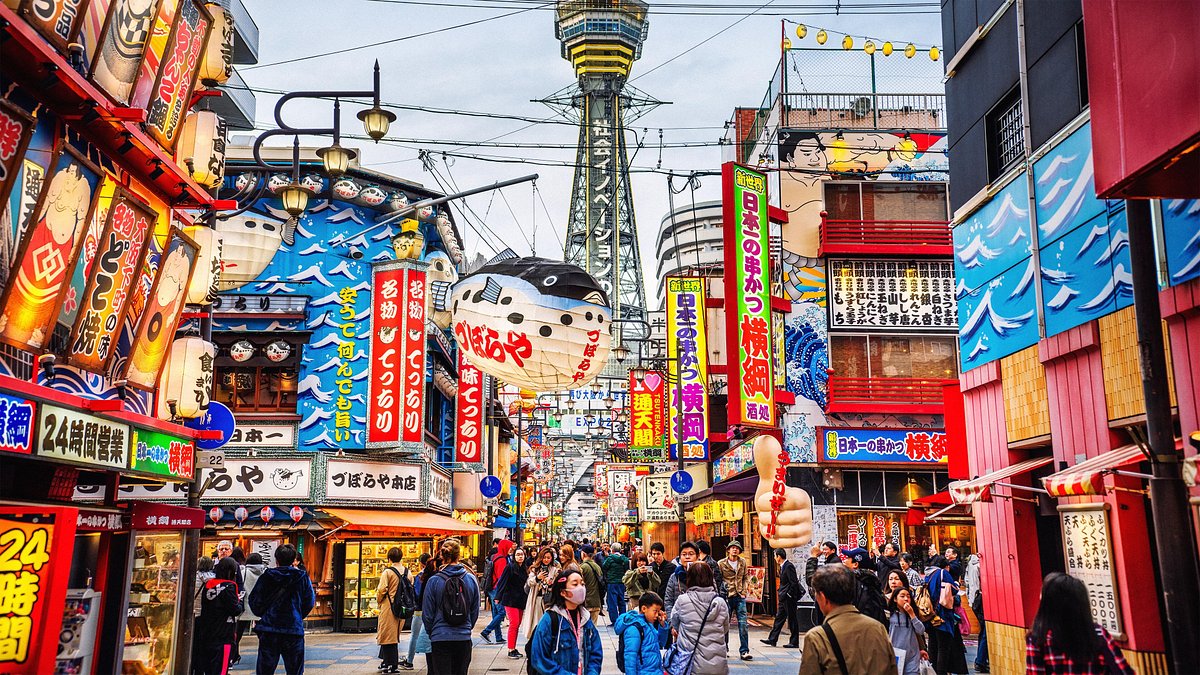

Travel Off Path
These Are The Top 10 Safest Destinations For Solo Travel According To New Study
Posted: March 13, 2024 | Last updated: March 13, 2024
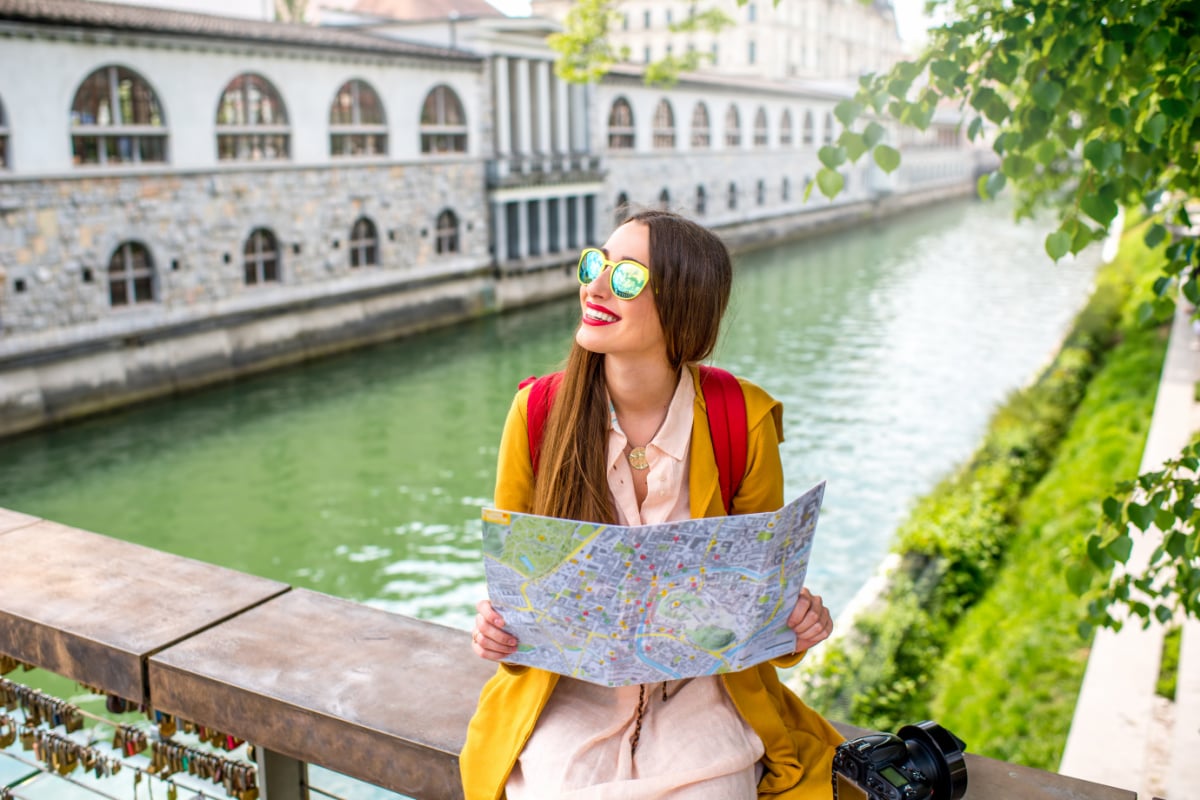
- 10. Naples, Florida
- 9. Reykjavik, Iceland
- 8. Santa Barbara, California
- 7. Prague, Czech Republic
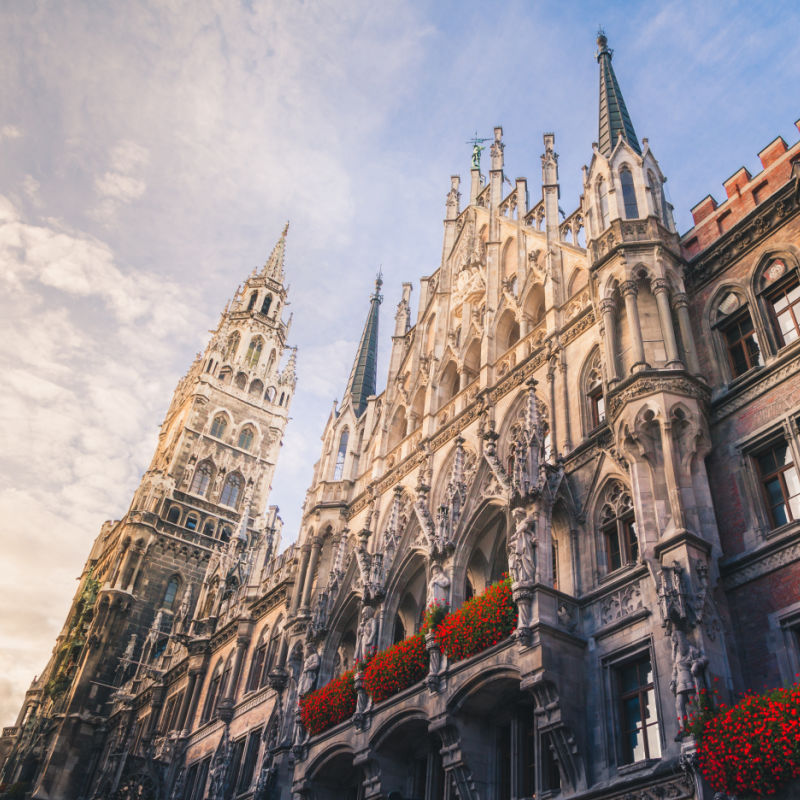
6. Munich, Germany

5. Queenstown, New Zealand
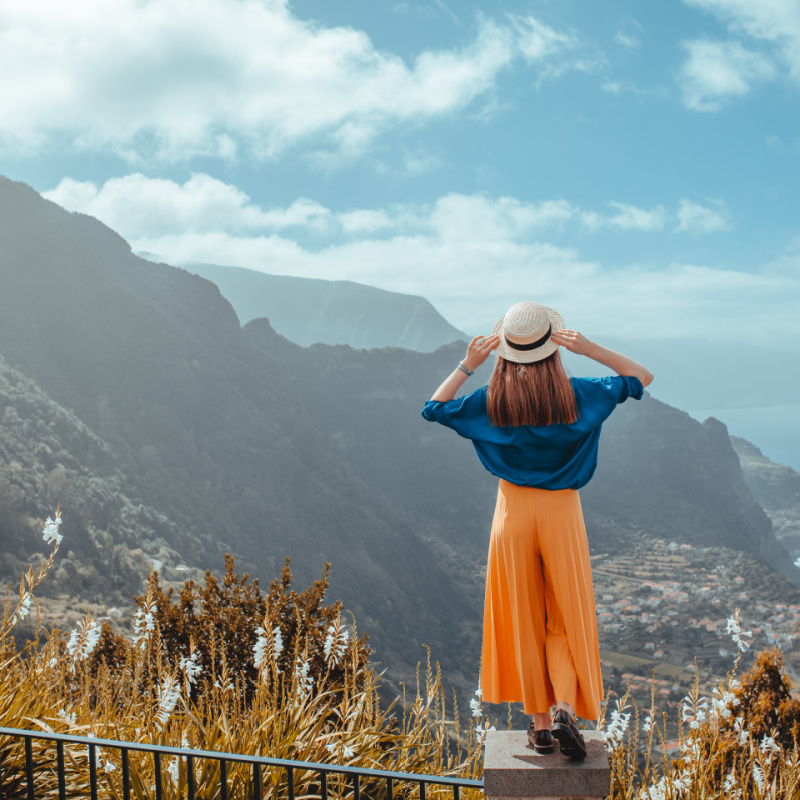
4. Madeira, Portugal
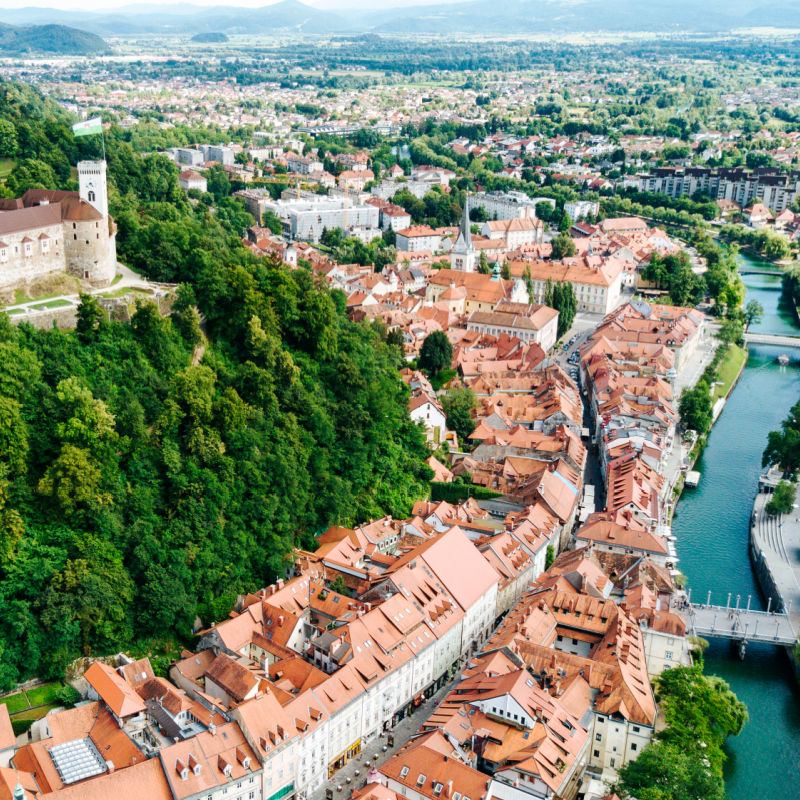
3. Ljubljana, Slovenia
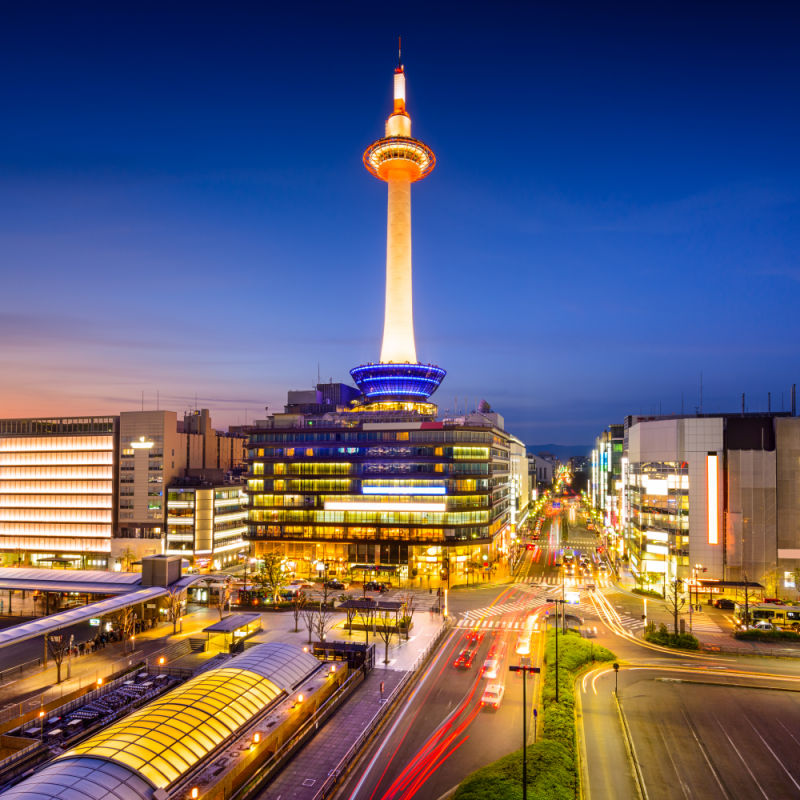
2. Kyoto, Japan
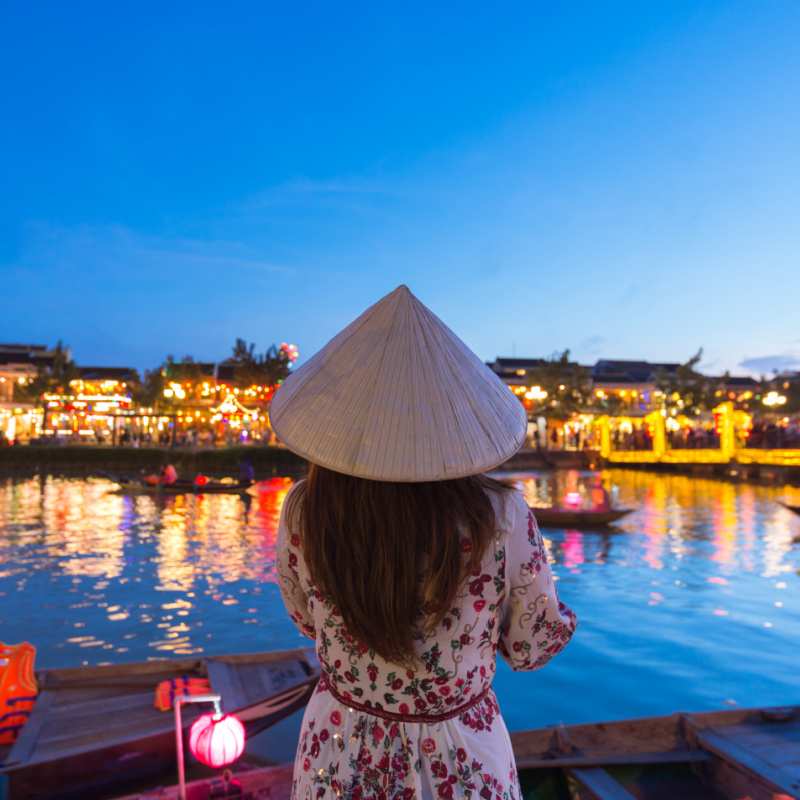
1. Hoi An, Vietnam

More for You
20 facts you might not know about 'John Wick'
Marjorie Taylor Greene Challenged by Democrat to Visit Holocaust Museum
Satellite detects six fire centers at Dzhankoi airfield after overnight explosions
Taco Bell Receives Massive Pushback on New Unpopular Menu Change
OJ Simpson has been cremated, estate attorney in Las Vegas says. No public memorial is planned
The 43 Best Shows to Stream on Netflix Right Now
29 Ridiculous Lies That Hollywood Has Managed to Mainstream
Gavin Newsom Has a California Parent Problem
Avengers: A Classic Marvel Villain Just Put an End to an MCU Villain
Nike's high-cut body suit for Team USA highlights the weird differences between men's and women's Olympic outfits
Philippines and US Troops to Sink Ship, Retake Islands in Drills
Ask Dr James: Why does my nose not stop running?
Sweden's parliament passes a law to make it easier for young people to legally change their gender
Donte DiVincenzo ineligible for MIP despite 81 games played
Study: Hunters Die After Consuming CWD-Infected Venison
The Food City Anthony Bourdain Considered One Of His All-Time Favorites
Baltimore Bridge Collapse Aftermath Revealed in Satellite Image
Panned M. Night Shyamalan Sequel Becomes Netflix Hit Five Years Later
Browns officially release new helmet featuring RB Nick Chubb
Jujutsu Kaisen: The Legacy Of Gojo Satoru, Explained

IMAGES
VIDEO
COMMENTS
Compared to lots of other Asian countries, Japan is super easy to travel in and great for people who are new to travelling alone. Don't get too confident yet though because there are tons and tons and tons of mistakes I made when I was in Japan solo, and I've been travelling alone since 2015. Japan is unique.
Solo Travel in Japan. In past decades, most solo traveler in Japan used to be the ubiquitous salarymen (office workers) on business trips. These days, however, many locals, especially the younger generations, are increasingly traveling alone or doing things by themselves, creating a unique market aimed at singles.
ULTIMATE Guide to Solo Travel in Japan | Destinations & Tips for 2023. Japan is the DREAM for many curious travelers. Manga, anime, sushi, cherry blossoms, Nintendo, Toyota, hot spring pools, Buddhist temples; the thought of these lit a fire in me! But with no one willing to tag along for the ride, I had to start planning a Japan solo travel trip.
1) Be Prepared…You Won't Be Able to Read Anything. As you solo travel Japan, you'll quickly see that there is a distinct lack of English signage. 'It's cool I'll just follow the signs'… said no one in Japan. Ever. Well, unless of course, you can actually read Japanese.
Keep the volume down in public. While you will most likely see women putting on a full face of makeup or someone drinking a cold one, in Japan it's inappropriate to have a conversation in certain public places — in particular on public transportation. This is where 'wa' will come in for you as a solo traveler.
Solo Travel Safety. Japan is safe according to the Global Peace Index, which ranked Japan as the ninth most peaceful country in the world based on violent crime, safety and security, and other peace factors. You may even notice Japanese people saving seats at restaurants by placing their wallets on the table.
Tips for Traveling Solo in Japan. Have cash. Everything I had read said that Japan is a cash society. I found that many places take credit cards including the hostels and ryokans where I stayed, 7-Elevens that are everywhere and many restaurants. While I used my credit card a lot, having cash was an imperative.
Japan is safe for solo travel . When it comes to the safest countries for solo travel, it doesn't get much better than Japan. According to the Global Peace Index, Japan is the 9 th safest country in the world.. Serious crimes and petty crimes are infrequent occurrences in Japan.
1. Tokyo: a must-visit city for a first solo trip to Japan. Tokyo is the perfect city to start your solo trip to Japan. As the capital city and the country's biggest city, Tokyo has many neighbourhoods to explore, learn about Japanese culture, and experience city life in Japan.
Solo travel in Japan is simple compared to most other places. It is safe, even for solo female travellers, and you can wander anywhere, anytime alone, without issue. Restaurants cater to lone customers; the only real issue is the Japanese language barrier.
Embarking on a Japan solo travel is a remarkable journey filled with cultural exploration, breathtaking landscapes, and unforgettable experiences. Japan offers solo travelers an unparalleled voyage with its unique blend of traditional heritage and modern innovation. In this comprehensive guide, we'll unravel the essence of Japan solo travel ...
Of course, for you who will be going to Japan for the first time, you don't necessarily have to go to places like Tokyo, Kyoto, and Osaka. If you have enough preparations before departure, in fact, Fukuoka, Hiroshima, Kumamoto, Nagoya, Shikoku, Hokkaido, etc., some places with natural attractions are worth your consideration.
With careful planning and an open mind, solo travelers can explore Japan's rich culture and history, make new friends, and create unforgettable memories. Book recommendations for those interested in solo traveling to Japan: "Lonely Planet Japan" by Lonely Planet: This guidebook is an excellent resource for solo travelers. It provides ...
Hakone. Nestled in Japan's beautiful mountains, Hakone is the perfect destination for solo travellers looking to explore a different side of this incredible country. The Hakone area is known for its relaxing Onsen (hot springs), unspoiled nature and breathtaking views of the iconic Mount Fuji which looms over the area.
Solo travel to Japan is a harmonious blend of cultural immersion, refinement, and memorable experiences. Whether you are a female solo traveler or not, Japan offers a wide range of luxury options, from affordable indulgences to premium experiences in SAFE environment. Embrace the safety, hospitality, and charm of Japan while exploring this ...
Try group solo travel to Japan with Flash Pack - designed exclusively for people in their 30s and 40s, seeking the independence of solo travel within the safety of a group. A cool 98% of Flashpackers arrive solo to join our group adventures. So, you'll be in good company - whether a first time solo traveller or a seasoned pro looking for ...
Safety Tips. Japan has one of the lowest crime rates in the world, and rates have been decreasing overall for decades. It is consistently ranked highly as a country friendly and safe to travelers. Those on a solo trip can enjoy travel with freedom as theft, scams, and other crimes are very rare.
8. Ensure That a Japan Railways Pass Is Cost Effective Before Buying One. For many years, the passes sold by the Japan Railways (JR) group are among the best deals in the global travel industry. Particularly attractive for traveling alone in Japan because they perfectly complement solo traveling itinerary flexibility.
Day 1: Reaching Tokyo. Tokyo absolutely should be the first place on your Japan itinerary. It is not only because Tokyo happens to be the capital city of the country but also because it is the perfect melting pot of the old and the new. You will definitely be jet-lagged on your first day after a long trip.
A Japan solo trip overview. You can pack Japan's top two must-sees - Tokyo and Kyoto - into a week, but it'll be rushed and you'll miss out on some of the magical moments that come with slower exploration. Two weeks is better, and three ideal, as you'll be able to add in day trips from Tokyo, plus a couple of days each in second ...
Reflect on nature and forge your own path: A solo traveler's guide to discovering Japan. Sep 21, 2023 by The Go Ahead Tours Team. There's an emerging culture in Japan surrounding the term "ohitorisama," which roughly translates to "one person" or "party of one.". The culture celebrates the joy of spending time alone indulging in ...
Solo travellers in Japan often find bus travel as a good alternative to train travel, as night buses are safe and don't limit your daytime activity time. A Japanese 3-day bus pass typically costs 10,200 YEN (£67, $88). Accurate exchange rate as of Dec 2021. Solo travelling in Japan is very popular, and you will not be on your own whilst solo ...
8D Splendid Japan with Nagoya (private 3 star hotel rooms) 4.5 (17 reviews) Our group had different people and different races, and I was the only solo traveller. I had no issues as a solo traveller because our group was amazing and Our tour guide checked in often to make sure I was having a good time. I had a blast!
That way, you can take advantage of the free JR trains throughout the city.) Table of Contents. Japan Itinerary Day 1: Tokyo. Japan Itinerary Day 2: Tokyo. Japan Itinerary Day 3: Tokyo. Japan Itinerary Day 4: Kyoto. Japan Itinerary Day 5: Kyoto. Japan Itinerary Day 6: Nara. Japan Itinerary Day 7: Tokyo.
4. Bring fun socks. "Bare feet in Japan is a big no-no. Travelers should expect to remove their shoes often in Japan and should always have socks on when they do so. The removal of shoes might ...
Best for: Personal safety. Find peace of mind travelling alone in clean, safe cities as you experience first-hand the Japanese culture of kindness and respect. Crime and harassment are rare and ...
43,185 posts. 305 reviews. 416 helpful votes. 11. Re: Better exchange rate but higher prices while there? Apr 17, 2024, 5:05 PM. Although I don't live in Japan any longer, I visit 2-3 times every year. I just came back from another trip 10 days ago. I also have many family members in Japan as well.
With a unique blend of ancient traditions and modern technology, Japan offers a fascinating and diverse travel experience. Definitely head to Tokyo, the bustling capital famous for its neon-lit ...
Story by Krystal Smith. • 15m. 1 / 18. 14 Safe Destinations for First-Time Solo Female Travelers ©Provided by Stapler Confessions. Picking a travel location as a first-time solo female traveler ...
Watch this space - the lesser-known European nation of Slovenia is almost certain to become a trending solo travel destination in 2024. The country recently reported that a record-breaking 6 ...